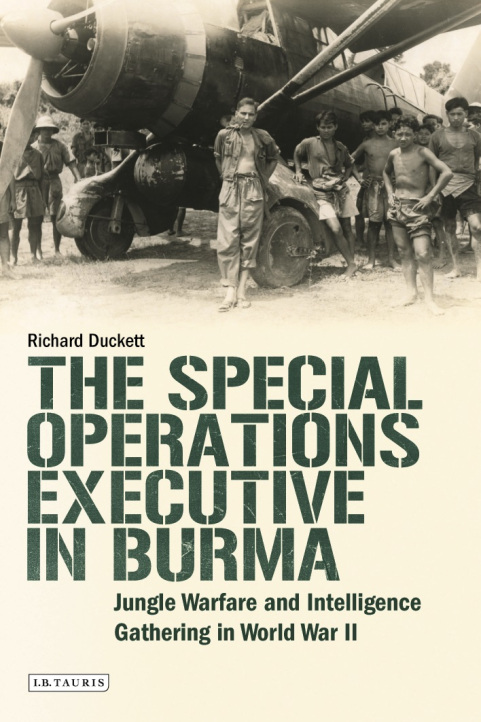
Help keep the website going!
If you think the content is worth it, help cover the costs of the website? Thanks!
£1.00
If you like what you see on my website consider buying my book HERE
Roll of Honour
On-going project: I am aiming to provide a brief biography of as many of the men who served with SOE in Burma as I can. They are listed in alphabetical order by surname; a picture and any useful links have been added for further information. If you want to know more about what these men did in Burma, why not purchase my book from Bloomsbury?
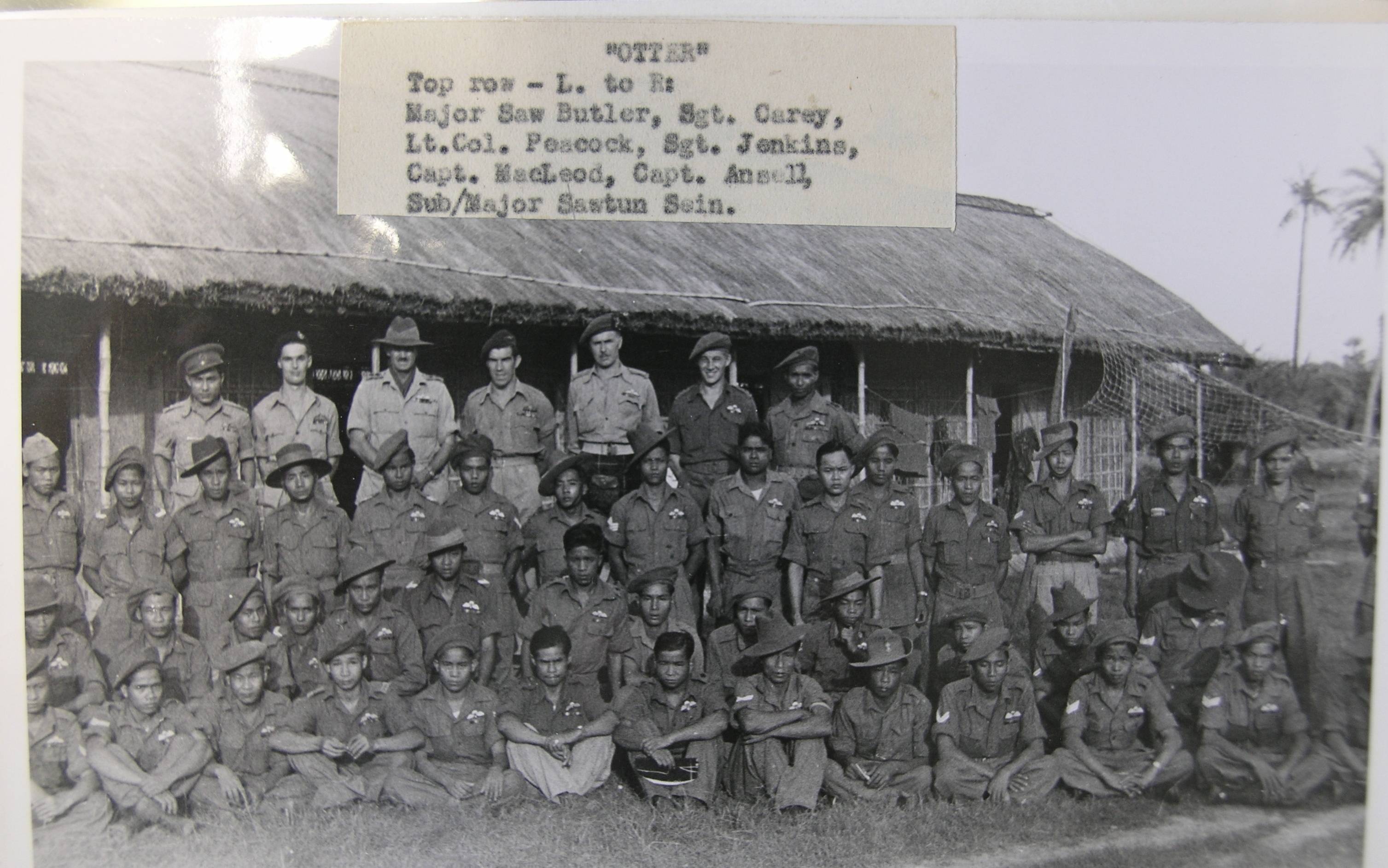
Some personnel of Operation Character, team Otter. Photograph TNA HS 7/107
Major Ian Edward Abbey: Born 29 July 1920 in Windsor, Major Abbey joined SOE in February 1944. According to his personnel file, Abbey trained at the Bush Warfare School in Maymyo from August 1941 until January 1942, and then served in China. In 1945, he led an operation in southern Burma codenamed Antelope.
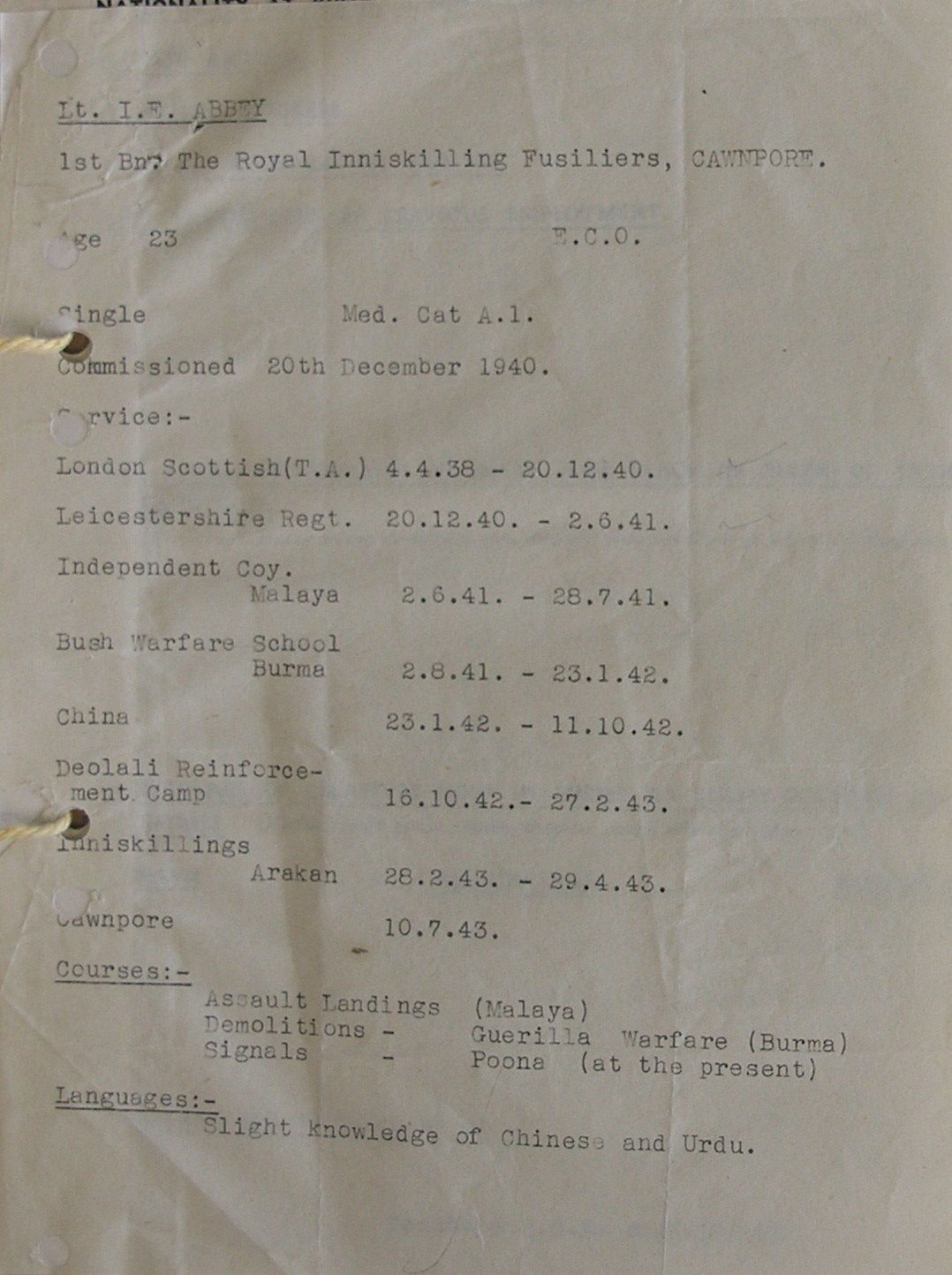
In 1944, Lieutenant Abbey was kicking his heels in Meerut:
‘This officer is young and keen, but at the same time exceedingly “browned off”. He has never had a real job since he joined the Unit. Being energetic he feels the boredom of having no real work more than other officers. He is strong willed and at times outspoken. I recommend that he be given promotion [to Captain] w.e.f. 1st September 1944.’
Personnel file: HS 9/3/6
Signalman Agnal Anan: Born in Manipur, Assam, in 1914, Agnal Anan is recorded as speaking Burmese, Hindustani, English, Tiddim Chin, Haka Chin and Kachin. He was in the Burifs from 1934 before being transferred to Burma Signals where he was a second class W/T operator. Recruited by SOE in October 1942, it seemed Agnal Anan had the skills SOE was looking for, including knowledge of the India-Burma border.
Upon recruitment, he was sent to ME 9 at Meerut for SOE signals training before being sent to the Chin Hills as ‘Station 4’. He was reported AWOL from 27 July 1943 to 11 October 1943, for which he was charged and fined Rs50. It is not clear for what, but Agnal Anan was hospitalised from 12 March. By 20 May 1944, he was on a course of parachute instruction at Chaklala.
On 23 August 1944, he was parachuted into Burma as part of Operation Spiers, leaving the field just 18 days later. Added to his record is the following comment: ‘Anan […] is not an operator at all. Is quite hopeless’.
Aik Hein: Aik Hein was recruited by Force 136 on 1 June 1944. He was a Shan Palaung born in 1913, from the village of Taungbangywa in the Lashio district. He was a tea planter. Apart from his height of 5’3″, and the details of a couple of distinguishing marks, there are no further details on his record. It is most likely that he was recruited for Operation Dilwyn.

Captain William Frank Harding Ansell: Born in Devoran, Cornwall, on 13 June 1923, Captain Ansell’s parent unit was 2 Burif. He was parachuted into Burma on 24 February 1945 as 2i/c to Major Poles on Operation Character, team Ferret. He left the field on 22 October 1945.
After the war, Dr. Ansell (PhD 1960) was a zoologist who wrote several books and specialised in mammals of southern Africa. He was Provincial Game Officer in Northern Rhodesia from 1960, and has five creatures named after him, for example the Ansell’s Mole-Rat.
Personnel file: HS 9/40/6
Ansell was granted an emergency commission in August 1943

Brigadier John Anstey: Born in 1907, Anstey completed OTC at Clifton College from 1921 to 1925. He served briefly as a Sub Lieutenant in the RNVR before joining Imperial Tobacco in 1927. Imperial Tobacco released him for war service, serving first in the Somerset Light Infantry, and then SOE from November 1942. Two years later he was working as Colin Mackenzie’s second in command (2i/c) for Force 136. Mackenzie recommended him for a CBE (Commander of the British Empire) for his work in the Far East:

Personnel file: HS 9/41/5

Original Picture Credit via ‘Legion‘, Canada’s Military History Magazine
Captain Jean Paul Archambault: a French Canadian from Montreal, Archambault was born 13 November 1908. He worked for the Postal Service from 1928, enlisting in the Canadian Army from the Postal Corps in 1942. Recruited by SOE for operations in France, Archambault was trained during 1944. Several of his instructors’ reports survive in his personnel file (PF), giving rather a bleak appraisal of his leadership skills and recommending him as a W/T man.
In April 1944, Archambault was parachuted into France to prepare for D-Day in the Saone-et-Loire region. Here, ‘due to his own initiative and leadership’ the Germans were unable to use the St. Rembert railway due to over 40 acts of sabotage and guerrilla attacks on German forces. For this, Archambault was awarded the MC.
After Christmas leave in Canada, Archambault was shipped out to the Far East where he arrived in February 1945. He parachuted into Burma in April 1945, joining Lt.Col. Peacock’s Otter team of Operation Character. On 19 May, Archambault died of wounds sustained while preparing demolitions two days earlier.
Personnel file: HS 9/49/1
For more on Canadians in SOE, see
‘Legion‘ – Canada’s Military Military History Magazine (2 parts, second here)

Poppy photo from Flower Meaning
Aung Ba:

Aung Chit: One of the most incomplete records, Aung Chit’s card has just his name and that he was deployed on 3 December 1944, by parachute, as Lion.
Lion was one of the first three teams to be sent into the Arakan region as part of Operation Billet, Manual. These teams were wholly indigenous in composition, dropped with a W/T to communicate with Calcutta. The idea was that they would see if it was safe for British personnel to follow them, and provide a reception at an arranged DZ.
Aung Din, alias Hla Gyaw: Aung Din was guided through the lines to the British in India by V Force specifically to join SOE. He is recorded as having been recruited on 15 July 1944 as a guide and interpreter. Along with Aung Myint, Aung Din was one of the first overland exploratory Billet operations sent into the Arakan region on 10 September 1944. His instructions were to proceed to Banwa and ‘obtain information about TUN GYAW and to ascertain whether it is safe for AUNG MYINT to go forward.’ Aung Din returned on 25 September and reported ‘good news’.
On 9 October, Aung Din went back, this time with Than Shwe and Tin Nyunt who were to take a W/T set behind the lines. This was the point of the operation, for SOE to get a W/T set behind the lines in Arakan. Three days in, on 12 October, the team reached their hideout and Aung Din went forward ‘to make arrangements for the onward journey’, but instead, Aung Din turned out to be a ‘bad hat’. Instead of continuing with the operation, he ‘indulged in the pleasures of the bottle, the opium pipe and the bed.’
Aung Din ended up being taken back to India by V Force at the end of October, where he sat out the rest of the war: ‘Aung Din will not be used in any capacity.’
Havildar Aung Hla Bya: A Sgaw Karen from the Bassein region, Aung Hla Bya was born in February 1918 and had joined the Burma Military Police (BMP) in 1940. He joined SOE in January 1943. After going through filter course at Eastern Warfare School (India) EWS(I), Aung Hla Bya was sent for signals instruction at ME9, Meerut. Jungle training was next, at ‘RISSUM camp’; this is the first time I have seen this camp name on any record.
From Rissum, Aung Hla Bya joined the team preparing for Operation Corton, completing ‘collective training’ at ME25 in Ceylon. From 1 February until 23 April 1944, Aung Hla Bya was part of Operation Corton 1. In November he was trained to jump out of aircraft at Jessore, which he then did operationally, twice. These two operations were Rendezvous and Ramrose/Rhino.
Major James reported: Aung Hla Bya ‘Is a first class W/T operator. A tireless worker and completely unworried by enemy action. I recommend his promotion to Jemadar.’
Whether that promotion was granted or not is not recorded here.
Aung Myint, alias Htoon Aung Gyaw: Recruited at Banwa for agent purposes in July 1944, Aung Myint is recorded as being Arakanese but not much else. He was sent back into the Arakan on foot in September 1944 with Aung Din, Than Shwe and Tin Myint. The intention was to see if Aung Myint could get to Rangoon and establish contact with the Thakins of the AFO, in particular Thakin Soe. He was successful, and returned with eight Thakins and intelligence from Rangoon in February 1945.
Aung Ngwe: Aung Ngwe was one of the agents parachuted into the Arakan on 3 December 1944 as part of Operation Billet, team Lion. The team, consisting of Tun Gyaw, Aung Chit, Lin Chan (Liu Chang Tsai) and Yau Ching were received by Hound. There is no further information about this agent on his file.
Aung Soe: An Arakanese who was deployed as part of the Mouse team. In a post operation report, where his name is spelt ‘Ong Zo’, he was described thus:
‘Appeared to be a slightly sleepy, lazy individual, but this was in part due to being overshadowed by YA YONG [Ye Aung] who was always first off the mark. He is a countryman, and his interest is in the land, he may well be a bit of a philosopher. When he was given a job to do he did it well.
His loyalty to ‘Mouse’ was never in doubt and for the future, with a grant of land, for he is very poor, he will almost certainly be a stable citizen.’
See blog post HERE.

Aung Zan: Not a lot recorded for Aung Zan, but nice to have a photo. A Shan Burman recorded as 4’11” tall from the village of Htemathi, near Monywa. Force 136 recruited Aung Zan, a cultivator, on 1 June 1944. He was apparently 20 years old.
Aura Yung: A Kachin who is recorded as having joined SOE on 1 October 1943, aged 20. He was from the Hting Nukawng village in Myitkyina District.
Ba Aye: A Burman born in Maymyo in 1921, Ba Aye was recruited to SOE on 10 October 1944. He deployed to Burma as part of Operation Character, Mongoose area on 26 March 1945, serving under Major Lucas. Lucas described Ba Aye as ‘Rather easy going, well disciplined, but without drive or initiative.’
Personnel file: HS 9/67/2
Major Ba Chit: Born on 11 March 1901 in Bassein, Ba Chit first came into contact with SOE during the retreat of 1942. Ba Chit retreated to Fort Hertz with Captain Thompson, and is mentioned in the latter’s book, Desperate Journey.
Ba Chit served with the North Kachin Levies during 1943 and 1944, and was then recruited by SIS in December 1944 (and promoted to Major). SOE / Force 136 urgently needed more Karen speaking officers, so Ba Chit was parachuted into team Hyena of Operation Character on 9 April 1945. ‘He originally came into the field as an ISLD agent with no military training whatsoever but soon picked up the ethics of guerilla [sic] warfare’ attacking Papun with Mongoose on 28 April.
In Ba Chit we have an example of SIS and SOE working together in the field in the latter stages of the war in Burma.
Personnel File: HS 9/308/3

Photo credit: The Soldier’s Burden
Lieutenant Ba Gyaw: Ba Gyaw was a Sgaw Karen, born sometime in 1908. He had served in the Burma Rifles for 17 years by the time war with Japan began. He was a Subedar in the Burif company led by Captain Arthur Thompson (see entry below).
After fighting a rear guard action along the Toungoo to Mawchi Road which stalled the Japanese advance into northern Burma, Ba Gyaw trekked up to Fort Hertz with Captain Thompson. He left his wife and new born baby behind in southern Burma.
Ba Gyaw was flown out to India from Fort Hertz in August 1942. He was then sent to train Burmese personnel before being sent on various courses preparatory to his being sent on operations in Burma. On 18 February 1943, Ba Gyaw was parachuted into the Karen Hills on Operation Harlington, in order to make contact with Major Seagrim. This he successfully did, but repeated attempts to get a W/T set to the Harlington team failed until eventually, in late 1943, Captains Nimmo and McCrindle were successfully parachuted into Burma.
The Harlington team was compromised, and Ba Gyaw was one of the Karen arrested with Major Seagrim and taken to Rangoon. Ba Gyaw was executed by the Japanese in September 1944.
At the end of ‘Desperate Journey’ (see Thompson entry below), Thompson wrote:
‘Little Subedar Ba Gyaw [is] also dead; captured, and then beheaded by the Japanese after parachuting into Burma. So Ba Gyaw was not to see his young wife again, nor his first born, nor was he to march by the side of his comrade, Kan Choke, in the Victory Parade, which was his heart’s desire. Instead he was awarded a posthumous Burma Gallantry Medal; a small tribute to a great little fighter.’

There is no HS 9 file for Ba Gyaw.

Poppy photo from Flower Meaning
Naik Ba Khaing: Ba Khaing was a Karen born in 1914. He served in the 2 Burma Rifles, being promoted to Naik during the retreat in 1942. He was recruited by Captain Wilson in the Chin Hills in July 1943 to be a W/T operator.
Ba Khaing completed parachute training at Chaklala and W/T training in Ceylon before being parachuted into Burma on Operation Heavy on 1 November 1944.
He was reported as a ‘Very steady type of man. A good operator. Very obedient and trustworthy.’ He was recommended for promotion to Havildar.
Ba Kin: Ba Kin was born around 1920. He was Burmese and worked as a cultivator in the Upper Chindwin area. This was where he was recruited by Major Peacock in February 1944.
P Force was withdrawn from the Chindwin area in May 1944. Ba Kin completed parachute training in September and jungle training by November 1944. He was deployed on Operation Character as part of Hyena team on 20 February 1945, remaining in the field until 20 October.
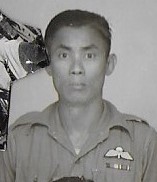
Ba Khine: Ba Khine was a Burman from the Upper Chindwin area, born around 1908. He was recruited by Major Peacock during P Force patrols in December 1943. He completed parachute and demolitions training before deploying on Operation Character, originally as part of Major Poles’ Ferret Special Group, in February 1945.
Ba Kyaw Gley: A Burman from the Upper Chindwin area of Burma, Ba Kyaw Gley joined SOE on 5 January 1944, aged 18. He served with P Force on operations in the Chindwin area.
Ba Pe: A Shan born about 1914, Ba Pe was a cultivator from the Upper Chindwin area. He was recruited by Major Peacock during P Force patrols in January 1944. Ba Pe completed parachute and demolitions training before deploying on Operation Antelope with team Nutshell in the Kawkareik area of southern Burma in March 1945.
Major Abbey ‘handed him over to Captain HALL’ so Ba Pe was then with Tiger. Captain Hall reported that he was ‘very useful’ even if ‘Inclined to be lazy’.
Ba Saw: Ba Saw is recorded as an ‘educated Arakanese’ who had been working for the Ministry of Information in Delhi before joining Force 136 on 9 November 1944. He went to ME25 in Ceylon for training before going operational. He was part of the Mouse team, parachuted into Burma on 25 January 1945. See blog post HERE.

Ba Thaung: Recruited on 1 June 1944, Ba Thaung was a Burman from Inlay Village in Myitkyina District. Between July and November 1944, he completed a filter course at Eastern Warfare School, India, known as EWS(I), parachute training at Chaklala and ‘Collective Training’ at ME25 in Ceylon.
Ba Thaung was parachuted into Burma on two operations. The first was Rendezvous from 25 November 1945 until 14 January 1945; the second was Burglar as part of team Hippo from 25 January to the 1 May 1945. He was paid off in the field on 12 May.
Ba Thein: A Burman cultivator from Malu Village, Ba Thein was recruited by P Force on 5 January 1944. No training is recorded, but Ba Thein went on to be deployed by parachute on Operation Character as part of team Ferret, commanded by Major Poles.
Ba Thien (probably mis-spelt ‘Thein’): A Shan-Burman cultivator from Auktaung Village in Mawlaik District, Ba Thien completed parachute instruction in India and then proceeded to Ceylon for paramilitary training between August and December 1944. Most probably recruited by Peacock during P Force patrols as Mawlaik is in the Upper Chindwin area. Would have deployed with Ba Pe (above).
On 20 March 1945, he was parachuted into southern Burma as part of Operation Nutshell, team Antelope. He was transferred to team Tiger on 1 May, remaining in the field until 5 October.
Major Abbey reported that he was ‘Above the average intelligence, hardworking and cheerful.’
Naik Ba Thet: Born in 1920 in Yamethin. A Burman, Ba Thet completed parachute, paramilitary and jungle training in 1945, and then deployed on Operation Character on 24 March 1945. He served with Walrus under the command of Major Campbell until 22 October 1945. Campbell described him as ‘A very willing man, cheerful and over conscientious.’

Naik Ba Tun: Ba Tun was a Burman cultivator born in 1917. He was recruited by P Force in December 1943. After serving under Peacock on patrols in the Chindwin area, Ba Tun completed parachute and demolitions instruction in India and Ceylon respectively. He was then parachuted into Burma with Major Poles on Operation Character, team Ferret.
Major Poles described Ba Tun as ‘An extremely staunch and dependable NCO. Brave and reliable.’
Jemadar Badri Prashad Pradhan: A Gurkha who joined the army on 29 September 1935, aged 18. He was serving with 4 Burif in 1937, promoted Naik in October 1942 and Havildar on 1 June 1944. This is all there is on Havildar Badri Prashad.
Later in the same file, however, there is a training card for one Jemadar Badri Prashasad, Army Number 51831. This is the same Army Number as on the Havildar’s papers.
This time, the date of birth is recorded as November 1920. It also reveals that Badri Prashad had served as a Bandsman in 10/20 Burifs and been a ‘Havildar Clerk’. He was recruited by the head of Burma Country Section, Ritchie Gardiner, on 1 March 1944 to be employed as an agent for P Force. By 8 March, he was on his way to the Chindwin.
After Chindwin operations were concluded, Badri Prashad completed training at Chaklala (India) and ME25 (Ceylon) before deployment on Operation Character as part of the Hyena group. His officer commanding was Major Turrall, who recommended him for the Military Medal:
We ‘depended upon his sense of duty’.
Badri Prashad seems to have been an essential part of the Hyena team. He was awarded the Military Cross, Gazetted November 1946:
London Gazette (see bottom left).
Captain Roland Clinton Bacon: born 28 March 1904 in Amherst, Canada, Bacon joined the Political Warfare branch of SOE in India. He was serving with Indian Field Broadcasting Units (IFBU), when he died of wounds in Monywa hospital in Burma on 13 March 1945. The IFBU was attached to 4 Corps with the aim of lowering the morale of the Japanese by distribution of leaflets and setting up speakers close to the frontline to try and talk the Japanese into surrendering. Koreans were used to communicate in Japanese through the speakers; Bacon was ‘quite good at coping with the Koreans, who [were] a handful and then some.’ He was also described as ‘Very much a Canadian & a missionary, tends to be hearty at all times & does not take kindly to the more British forms of discipline.’
Personnel file: HS 9/70/6

Poppy photo from Flower Meaning
Jemadar Bala Gam: A Kachin, Bala Gam joined the army at 16. His record reveals that he completed a Physical Training course in 1930, junior and senior section leadership courses in 1937, and a fieldcraft course in 1938. He served in the rebellion on 1930-32 and the 1942 Burma campaign. What he did with SOE is missing.

Photo courtesy of Emily Barnard, Granddaughter
Major Jack Barnard: Jack Barnard was an Anglo-Burman, born in Magaung on 5 May 1910. Before the war he worked for Steel Brothers in the forestry business for thirteen years. He wrote about his exploits in Burma during 1942 in his book The Hump, published in 1960.

After serving with SOE’s Oriental Mission and then escaping from Burma over the mountains into China, Barnard joined the OSS. He was dropped in to Burma in early 1943 with, amongst others, Major Patrick Maddox and John Beamish. Their objective was to blow up the railway in central Burma in support of a coming offensive, but things didn’t go quite to plan and two of the team were shot and the rest had to escape back to Allied lines in northern Burma. Barnard was awarded the MC for his part in this operation.
Barnard then served with the North Kachin Levies before rejoining SOE, who deployed him on Operation Spiers in 1944. According to Major Broadbent’s file, Barnard may have joined SIS after Operation Spiers.
Personnel file: HS 9/91/1

Major Robert James Barron: born 5 September 1917 in London, Barron joined SOE at the end of August 1943. Before the war, he had been a travelling salesman for a rubber company in London while serving in the TA’s 1st Battalion London Scottish from 1935. Before being granted an emergency commission on 28 November 1942, Barron served with No.5 Independent Company, No.1 Special Service Battalion, and No.2 Commando. He took part in the raid on Nazaire, Operation Chariot, whilst serving with the latter.
He was initially picked up by SOE to be an instructor, but was posted operational to the Far East in November 1944. After training in Ceylon, Barron parachuted into Burma on 24 March 1945 to serve with Hyena group of Operation Character. At the end of April, Barron was wounded in the right thigh and cheek, and was evacuated to hospital. Making a full recovery, he returned to the field on 17 July, remaining on ops until November.
A summation of Barron from STS 33 in November 1943:
‘This man is very silent. It is, therefore, difficult to sum him up. He seems, however, intelligent, shrewd and thoughtful. He is keen, worked hard and accurately. He gave the impression of being a good type of officer, sound and trustworthy. His personality is quiet and solid, but likeable. He would inspire confidence.’
Personnel file: HS 9/96/2
Barron was MiD for his work in Burma, and made an MBE in 1998.

Major Eric Battersby: originally went to Burma in 1935 as a 19yr old police cadet. He joined SOE in 1944, during home leave in the UK. Returning to Burma, Battersby was put in charge of Operation Billet. The mission was split into three parts; Manual in the Arakan, Grain in central Burma and Nation in lower Burma. This was one of SOE Burma’s largest operations, and possibly its most controversial. Its aim was to get the nationalist Burmese on the British side,if not actively assisting the war effort then neutral, in order to assist General Slim’s offensive to reclaim Rangoon.
Personnel file: HS 9/103/8
For his (lengthy) post-operational report see HS 7/105
Bauk Naw: Born in 1925, Bauk Naw was a Kachin from the Lashio area. He was recruited in the field on 16 September 1944 and sent for training in India (parachute and paramilitary) which was completed by January 1945. On 20 February he was deployed on Operation Heavy, team Wolf, remaining in the field until 16 October 1945. The last two months were, interestingly, spent in the Spiers area. Spiers had been withdrawn in September 1944.
Major Pennell described Bauk Naw as ‘Trustworthy’ and ‘Good on patrol.’
Havildar Bawm Ting: Born in 1911, Bawm Ting was a Kachin who joined the Burma Rifles on 8 January 1933, serving with 2 Burif. Apart from weapons training, he is also recorded as having completed a butchery course.
Bawm Ting was promoted to Lance Naik 23/6/37, Naik 8/6/39 and Havildar 1/1/42. He remained in Burma after the first campaign and was recruited in the field by SOE on 1 January 1944. He worked on Operation Dilwyn until being exfiltrated to India on 20 June the same year. Bawm Ting returned to Burma on Dilwyn as part of team Monkey, 28 November 1944 to 2 March 1945. On 6 April he was deployed on his third operation as part of Heavy, team Wolf.
Described as ‘Excellent, trustworthy and reliable.’

Captain John Michael Beamish: An Anglo-Burman, John Beamish’s British father came from Fleet, Hampshire (like Eric Battersby, above). Beamish completed three operations into Burma, the first with the American Office of Strategic Services in early 1943, and two more with SOE. His first SOE operation was codenamed Spiers, in the Kokang area of eastern Burma. His second operation in the Northern Shan States was codenamed Dilwyn, on which he was deployed in January 1945. He was recommended for the Military Cross, which was gazetted on 7 November 1946.
Personnel File: HS 9/108/4
Military Cross: London Gazette
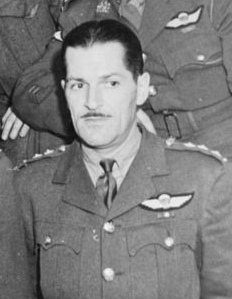
Original Picture Credit via ‘Legion‘, Canada’s Military History Magazine
Major Joseph Henri Benoit: Benoit was a French Canadian who completed three operations in three countries with SOE. He was born in Montreal on 14 July 1906, worked on the tramways, and was married with four children. Curiously, one of his instructors wrote that he was a ‘hardworking, competent bourgeois father of 4 children’. Other reports provide a mixed description of his competencies, with one asserting that he only ‘thinks in terms of promotion and decorations’ and that he possessed ‘no natural leadership’ ability.
Parachuted into France before D-Day, Benoit was 2i/c of the Silversmith circuit, where he was responsible for leading attacks on German supply dumps and V1 installations. He was awarded an MBE for his efforts between 23 May and 8 November 1944.
After leave in Canada, Benoit’s next operation was in Burma where he was part of Operation Nation’s team Weasel. With the capture of Rangoon, he returned from the field during May 1945 and then deployed to Malaya on Operation Tideway Green.
Personnel file: HS 9/129/2
For more on Canadians in SOE, see
‘Legion‘ – Canada’s Military Military History Magazine (2 parts, second here)
________________________________________________________________
Captain Deryck Kenneth Binks: born in Birmingham on 21 June 1918, Binks attended King Edward’s School before going on to be an electrical engineering apprentice from June 1936 until July 1939. He joined the Royal Signals in the same month as leaving his apprenticeship, serving in the ranks until May 1940 with 18 Division when he went to OCTU. He received his emergency commission on 21 December 1940.
After commissioning, he served with 47 Division until May 1941, then with 1st Heavy Aircraft Regiment until June 1943. After a short spell with 55 Division in the sumer of 1943, he joined SOE. On 25 October he sailed for Bombay aboard the SS Strathmore. Once in India he was posted to Meerut and B Company signals at ME9.
On 17 March 1944,he was wounded at MS 109 on the Imphal-Tiddim Road, and was in and out of various hospitals until 10 June. He had received a gunshot wound to the head which affected his right ear, and inflicted a coroidal tear to his right eye. He was briefly attached to HQ 33 Corps with the IFBUs, before returning to B Company Signals where he was officer commanding for five months or so. It was felt that he was not quite up to being a company commander, so he was posted as second in command to C Company signals based in Ceylon. He was described as ‘excellent’ in this new posting.
HS 9/153/7
______________________________________________________________________________

Major Alexander Mather Boal: Born 13 September 1918. Trainee architect from 1936-39, joining 1/5 West Yorks Regt. in 1939. Service in Iceland building camps before SOE training. In command of STS 45 by December 1943. In March 1945 he was parachuted in to Burma where he served on Operation Character, team Walrus. Major Boal was awarded the Military Cross:

Personnel file: HS 9/169/8
Captain Frederick William Thompson Bodeker: born 25 April 1895 (not 29 March 1920; this was the date of his marriage) in Moulmein, Burma, Bodeker worked for the Burma Forestry Service before the war. He was loaned to SOE by the Civil Affairs Service (Burma) – known as CAS(B) – from October 1943. He served in the Political Warfare section of SOE with the Indian Field Broadcasting Units (IFBU), commanded by Lt.Col. Steer. Steer described Bodeker as someone whose knowledge of Burma was ‘more complete than that of any other person from Burma that I have met.’ He fought to keep him in the IFBUs in 1944 when the CAS(B) wanted him back. It took the intervention of Air Marshal Joubert to keep him, and Bodeker was then promoted to Captain and put in charge of a unit of the IFBU. In this capacity, he went back to Burma in late 1944 until being finally released to the CAS(B) in the middle of March 1945. Bodeker was awarded a civilian MBE for his work during the war.
Personnel file: HS 9/171/4
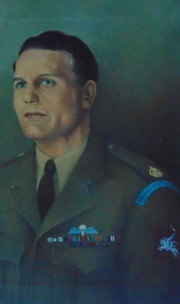
Portrait of Major Bourne, courtesy of his daughter, Belinda Bourne
Major Harold Edward Bourne: Born in Aldershot on 19 December 1909, Bourne joined the army at 18 years of age, serving with the Coldstream Guards. He was in the Sudan in 1932, Egypt in 1933, and was with the BEF in France from 1939 to 3 June 1940. Employed by SOE from 21 September 1943, Bourne was recruited to be an instructor. This is what one of his reports said:

In 1944, Captain Bourne went to the Far East as a Jedburgh. He served on Operation Character from March 1945 for which he was awarded the MC:

The Karen affectionately called him ‘Pa Ma Dai’ which translates as ‘Mr Tentmaker’, because wherever they went, Major Bourne asked them to make bamboo shelters for the troops.
Personnel File: HS 9/191/7
![Captain John Bowen [changed name to Bowen 1947] in 1943 or 1944](https://soeinburma.files.wordpress.com/2019/07/captain-john-bowen-changed-name-to-bowen-1947-in-1943-or-1944.jpg)
![Major John Gebhard [changed name to Bowen 1947] HMT Johan De Witt 15-10-45](https://soeinburma.files.wordpress.com/2019/07/major-john-gebhard-changed-name-to-bowen-1947-hmt-johan-de-witt-15-10-45.jpg)
Major John Leslie Bowen, formerly Gebhard
The following biography was provided by Captain Bowen’s sons, Jeremy, Peter and Robin, as were the photos above. It is reproduced as provided:
Born 1915 in Natal, South Africa where his father Dr Norman Gebhard was running a whale oil business. His parents divorced and he returned to UK in 1923 with his mother Florence nee Bowen and his sister. He grew up in Edgbaston, Birmingham. After preparatory school in Malvern and public school at Bromsgrove he had 2 years in Paris working as a sub-editor of the Continental Daily Mail. He went up to St John’s College, Cambridge in 1936 reading Part I Economics and Part II Law. In 1938 after graduation he joined Parson Lee and Co, a firm of solicitors in London, as an articled clerk.
His military life might never have happened but for him passing his HAC and Army medicals despite being deaf in one ear [legacy of polio as a small boy] and pretty poor eyesight. He served in the Royal Warwickshire Regiment with the BEF in France before evacuation from Cherbourg to Weymouth in 1940. He transferred to the 5/16th Punjab Regiment in 1942, serving in the 2nd Arakan campaign and in Imphal before joining V Force. His 2 years in V Force, part of SOE, is recorded in “Undercover in the Jungle”, a memoir he wrote shortly after the war. Nearly 30 years later I found the manuscript in a cupboard in his London flat which was published by William Kimber in 1978. He also wrote 3 novels, one about a young officer in the Indian Army during WW2, which remain unpublished.
He married Elaine Winbolt Lewis in 1941 with whom he had 3 sons born after the war. Whilst he served in India and Burma for 3 ½ years his wife served in the Wrens, becoming a 3rd Officer. He changed his surname from Gebhard to his mother’s maiden name in 1947, and qualified as a solicitor eventually becoming a legal civil servant in Customs and Excise, where he was awarded an OBE. In 1970 he transferred to the MOD, serving as Legal Advisor to the Joint Services Liaison Organisation , retiring in 1977. He retired to Dorset, where he and Elaine had a happy retirement. He died of natural causes aged 86 in 2002. His memorial service was attended by Flight Lt Peter Arkell, an RAF Lysander pilot, who crashed when landing at his jungle headquarters in the Karen hills in 1944 and also his old friend Lt Col Gretton Foster DSO, MC, who served with him in V Force.
Being V Force attached to SOE, Major Bowen has no PF in the National Archives.
Major Noel Ernest Boyt: born on Boxing Day 1901, Boyt was working for Steel Brothers in Burma when war came. In the book Flight By Elephant he is described as ‘wiry, capable, pipe-smoking’ and ‘amusingly gung-ho’. This book picks up the story of Boyt’s escape to India from Sumprabum in northern Burma. Before this, Boyt had been recruited by SOE. As part of the original Oriental Mission he had been in action along the Mawchi Road, helping organise Captain Arthur Thompson’s fighting retreat (see entry for Thompson below). He was awarded the MC in November 1942 for his exploits during the first Burma campaign.
His file reveals that by April 1943, Boyt’s previously described ‘Gung-ho’ predilections were causing ‘some anxiety’ because he was ‘no great performer in an office’. He apparently wanted to be part of Operation Harlington, which would have taken him back into the field where he had fought during the retreat. It was suggested, instead, that he take up a Liaison Officer role, which would get him on to the front line as he ‘would be located with the forward military formations.’
He did indeed take on the role of LO, and later was assigned as GSO II liaising between 10th USAAF and SOE operations in Northern Burma from August 1944. His report for this period of service states ‘This officer’s character and charm of personality are too well known to need further comment.’ He was awarded and MBE for his work in this posting.
Boyt subsequently became LO with the British 4 Corps during 1945. With the war in Burma almost over, Boyt was transferred to the Civil Affairs Service. He was finally able to get leave to the UK in October 1945, which was extended into November so he could collect his MC from the palace.
Personnel file: HS 9/196/7
Squadron Leader Arthur Vivian Breen: Breen was born in Hankow on 20 April 1916. His father was British and his mother Chinese. Breen was working in Paris when the war started, later escaping over the Pyrenees to reach Gibraltar in 1943. He originally joined the RAF to fly, but ended up training as an air gunner and W/T operator. Most reports in his PF speak of his intelligence and ability to ‘read’ people. Recruited into SOE, Breen was parachuted into France in July 1944 where operated in the Nancy area for which he was awarded the MBE. He joined Operation Character in February 1945 as a sub area commander for group Otter team White. His W/T operator was Sgt. Ron Chatten (see below). Breen was in the jungle until September 1945 and was awarded the Military Cross.
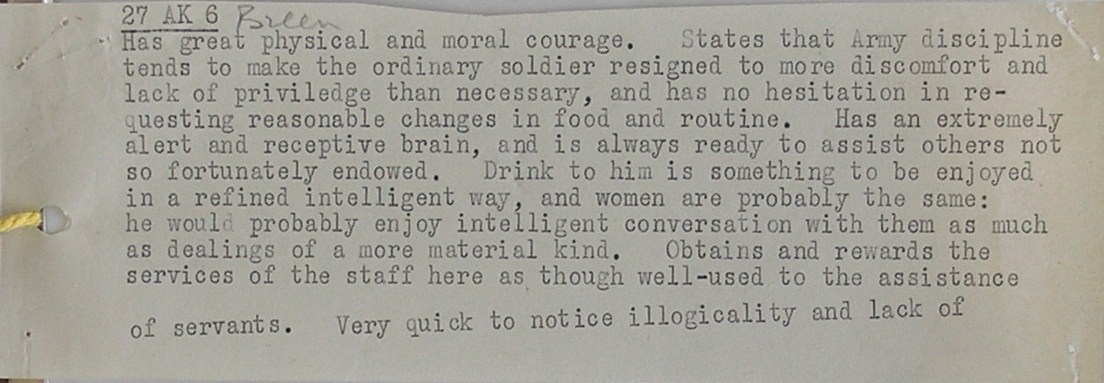
Personnel file: HS 9/204/9
2015 Obituary for Breen’s wife, also an SOE agent: Michele de Ducla
Capt. John Ernest Briant: Born 29 November 1923 in India, Briant was granted an emergency commission into the 8 Gurkha Rifles in May 1943. After serving with the Chin Levies in northern Burma, Briant was recruited into SOE in December 1944. In 1945, Briant was deployed on operations in southern Burma, codenamed Nutshell team Antelope,although there is a reference to him being with Rabbit, which was part of Operation Nation.
On 1 August 1945, Briant was shot dead by the Japanese who had surrounded a hut where he and his guide, Tun Yung, were hiding. Tun Yung (or Yon) was captured and tortured, after which it is alleged that the Japanese bayoneted and buried him alive. It was believed that Capt. Briant had been betrayed; the suspect was caught and handed over to 63 Infantry Brigade of 17 Division for investigation.
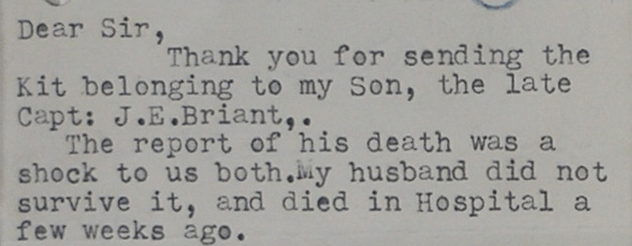
 RIP
RIP
Poppy photo from Flower Meaning
Personnel file: HS 9/207/2

Photo courtesy of Captain Bridges’ son, Nigel
Captain David Bridges: born Edinburgh, 20 June 1919, Bridges served in 91 Heavy Anti Aircraft (HAA) Regiment, Royal Artillery, a Territoria unit, from 1 March 1938 until 4 August 1941. From August 1941 to February 1942, he served with 153 City of London HAA Regiment, after which he was shipped to India. Out east, he continued to served inn HAA until the end of 1943 (7th Rajput HAA, Indian Army).
In the new year, Bridges served with V Force and was at the siege of Kohima. After the war moved into Burma, Bridges, ‘along with practically every other “V” Force officer’ volunteered for further action with Force 136. After some hurried parachute training, ‘jumping off high equipment’ and one static line jump from a Dakota, a few days leave was allowed before emplaning ‘very well equipped’ bound for the Karen Hills. Inn his unpublished diary, Bridges described exiting the Dakota:
‘I braced my outstretched arms against the metal frame of the door, body back curving forward to my right foot touching the lip of the aircraft floor. In front there is a furious din and a hurricane draught from the engine’s slipstream. I try to look straight in front but my eyes stray to the blurred ground below. Height is about 500 feet. There is a movement from the dispatcher and I briefly catch his sympathetic eye. He knows that I know he will be back in the comfort of the landing field mess in a few hours’ time enjoying a late breakfast.’
Bridges joined Operation Character, serving under lt.Col.Peacock in the Otter area from May to August 1945. He was awarded the MC for his service.

There is no SOE Personnel file for Captain Bridges.
Imperial War Museum (private papers)

Sergeant Ronald Brierley: Brierley was born on 31 July 1921 in Oldham, Lancashire. When war came, he worked in insurance; when SOE found him in 1943, he was serving with 147 Regiment, Royal Armoured Corps. SOE often found their W/T operators in armoured units because of their knowledge of radio procedure.
Brierley was trained as a Jedburgh, and completed two operations in France as part of team Daniel and team Gregory. He won the Croix de Guerre for his work with Gregory. Once his operations in France were complete, Brierley volunteered to go to the Far East looking for more excitement.
In March 1945, Brierley parachuted into Burma as part of the Nation operation. His team was Reindeer, and was under the command of Major Dave Britton. After Major Britton was killed in action, Brierley took a leading role; unusually, this means that the post operational report for Reindeer was written by an NCO rather than an officer. Brierley seems to have enjoyed his time in Burma, despite his difficult task of working with Burmese Nationalist forces. Of his three Jedburgh missions, Brierley’s opinion was that he had caused more ‘damage and mayhem’ in Burma. In his recommendation for the award of an MM, it says:
‘He has taken part in many ambushes and personally led offensive patrols. A man of strong character and cheerful disposition, he has been an example to all ranks.’

Image: ‘The interior of a Burmese hut. A red-headed and bearded Sergeant Brierley studies a map with one of the Burmese Reindeer Force members. Other members of the Burmese team look on.’
IWM sound archive: Ronald Brierley and IWM Private Papers
Personnel file: HS 9/210/1
W/T training was carried out at Dunbar in Scotland: more from Brierley HERE

Captain David John Charles Britton: born 13 August 1912 in Hurst, Berkshire, and educated at the Queen Elizabeth Grammar School, Dorset. Captain Britton was married with two children, Peter and Michael. Britton joined SOE in November 1943; his parent regiment was the Royal Artillery. Before leaving for the Far East in December 1944, Britton had served in France on the Albert circuit.
After training in Ceylon, Britton was deployed in Burma as part of Operation Nation, in charge of team Reindeer. Britton was KIA 3 June 1945:

He was awarded the MC for his work with Reindeer:

Personnel file: HS 9/212/3

Poppy photo from Flower Meaning
Major Stanley Broadbent: born 14 September 1918, in Manchester, Broadbent was commissioned 28 May 1942. He was serving with 10/6 Rajputana Rifles. After two personnel for Operation Spiers were injured, Broadbent was approached by SOE, joining in November 1943, to fill the gap. He was therefore released from the RAF Air Landing School at Chaklala, where he was training Gurkhas. Broadbent had applied for a commission in the RAF, and his secondment to SOE was not to prejudice this.
Broadbent was part of the Spiers team during 1944, serving under Munro-Faure (below). This operation did not achieve its aims, as it became embroiled in territorial intrigue with the Chinese. The dispute was over the Kokang area in eastern Burma, a dispute dating back through the decades of British colonisation in Burma.
After Spiers was withdrawn from the field in late September 1944, Broadbent didn’t join the RAF as originally planned; he joined ISLD, the Secret Intelligence Service, from 12 December 1944.
Personnel file: HS 9/212/6

Captain Basil Brown: born 1 October 1918 in London, Brown was serving in 261/66 anti-tank regiment, Royal Artillery when he was recruited by SOE for Jedburgh operations. He had been serving since June 1938. His Jedburgh report noted that ‘has great confidence in himself’ but that his ‘chief weakness is his susceptibility to environment’.
After training, it appears that Brown was to be part of Jed team Raymond, but for some reason he didn’t go. He left the Francs he had been issued with on ‘Mrs. Buck’s (F.A.N.Y.) desk’ but they were later unaccounted for. After investigation, Brown got a ‘severe reprimand’, and then shipped out to the Far East.
Brown parachuted into Burma south of Toungoo on 20 March 1945. He was captured and tortured by men of the Indian National Army, but refused to give them any information about the location of other Force 136 personnel. He later escaped to Allied lines.
Brown served in Burma as part of Operation Nation, team Weasel. According to Carew, the team leader, Brown was a ‘renegade fella, wild character’ (see Keggie Carew, Dadland, p.199).
London Gazette MBE
Personnel File: HS 9/218/3
More information provided by Brown’s daughter on Special Forces RoH

Sergeant Kenneth John Wylde Brown: born 6 December 1923 in Birmingham, like many NCOs recruited by SOE, Brown was originally in the Royal Tank Regiment. He joined SOE in 1943, and was deployed in France as W/T operator for Jedburgh team Paul from 18 August 1944, for which he was awarded the Croix de Guerre.
After France, Brown was sent to the Far East where he was deployed on Operation Dilwyn, team Cheetah from 25 January 1945 with Majors Hood and Rubinstein. From 27 April he was again operational with Major Rubinstein as part of Operation Nation, team Chimp. For his work in Burma he was MiD.
Personnel file: HS 9/221/2

Captain Frank Frederick Buchanan: an Anglo-Burman born in Rangoon 26 January 1923, Buchanan’s Anglo-Burman father worked for the Burma Reconstruction Department in Simla during the war. He was able to help his son join SOE in 1944 after he was evacuated from the Myitkyina area earlier that year.
Originally employed as a Burmese language instructor, Buchanan went into the field in May 1945 to join the Otter group of Operation Character. It is from a photo with other Otter officers and men that the photo above was clipped.
Buchanan appears to have died on 16 November 1945, but is not on the CWCG website.
Personnel file: HS 9/231/2

Captain Jack Maurice Bulman: Bulman was born in Folkestone on 8 September 1910. He attended the Duke of York’s Royal Military School from 1921 to 1929, going straight into the King’s Own Yorkshire Light Infantry (KOYLI) in August 1929. He served in the UK until 1933, then India and Burma until 1939. Bulman was in France from 27 September 1939 until 14 March 1940. He was discharged at the rank of Warrant Officer, and in the same month – July 1940 – received an Emergency Commission into the King’s Royal Rifle Corps.
SOE picked him up in the Middle East, and he was trained in Palestine and operational in Albania before being posted to India in October 1944. Bulman parachuted into Burma with Lt.Col. Crosby on 27 January 1945 as part of Operation Dilwyn. He recorded on his SOE record that he was 2i/c for intelligence and levy raising.
Personnel file: HS 9/235/1
For his SOE ops in Albania, see Rod Bailey‘s ‘The Wildest Province‘.
Major John Edmund Burke: Born 25 October 1915 in Bath, Somerset. Major Burke joined the army on 8 March 1930, and was granted an emergency commission in 1942. His parent unit was the Essex Regiment. Burke married in 1941, had a son in 1942, and joined SOE in June 1943. Before going to the Far East, Burke was operational in Yugoslavia for six months.
After serving in on Operation Ramrose, team Fox, in Burma, Major Burke died 17 May 1945 in his accommodation in Ceylon. Captain Swamy of the Indian Army Medical Corps stated that Major Burke had died of heart failure, while on his inquest documents it asks:
‘Would the disease from which Major Burke died have been aggravated by operational conditions.
Answer. Possibly.’
On another document ‘Fatty Degeneration Heart’ is given as cause of death. He was buried the next day in the Military cemetery in Colombo.
Personnel file: HS 9/238/3


Major Rainald Hugo Burne: born 27 September 1888, Burne was educated at the Royal Naval College and served in the navy on HMS Britannia between 1903 to 1910. He appears to have been sent to the Pacific, visiting Australia and New Zealand. From 1911 to 1914 he was in Burma working in the teak industry.
During the Great War, Burne served in France, Iraq, Palestine and Egypt with the Indian Army, returning to Burma from 1919 to 1937. He retired from the Indian Army Reserve of Officers in 1934 with the rank of Major and the MC and a MiD.
Back in Britain, Burne worked for Foucar & Co. Ltd, joining the Army again in September 1939 as a Staff Captain. He was picked up by SOE in September 1940 and sent out as part of the Oriental Mission in November 1941 to work in Burma. He helped organise left behind parties and the Chin Levies before requesting return to Britain in April 1942. He evidently thought that he could be more use at home. By 1943, his file indicates that he was probably going to go back to Burma, as he was ‘known to Colonel (General?) Wingate now operating in Burma.’ There is no indication that he did go back in his file. Not to be confused with Major C Burne dropped to Character/Mongoose on 9 April.
Personnel file: HS 9/239/4

Captain David Caddy: Caddy was born in Scarborough on 3 October 1917. He attended Charterhouse School and Cambridge before becoming a doctor. He worked in Lambeth Hospital until January 1942, and then gained a commission into the Royal Army Medical Corps. He served with 6 Airborne Division until injured and medically down graded in late 1943. His medical category reinstated in 1944, Caddy served with 224 para field Ambulance until posted to India in late 1944, arriving on 5 December. He was MO at ME 89 from 6 February 1945, and later that year he parachuted into Burma to join Operation Heavy, team Wolf. The exact dates of his time in Burma are not consistent on his file.
Personnel file: HS 9/252/7
Sergeant Thomas Frederick Cain: Cain was born on the Isle of Man on 18 January 1924, according to his file. In fact, he lied about his age, and his real date of birth was 18 September 1924. This means that he was just nineteen when he parachuted into France as part of Jedburgh team Scion in the Ardeche area. He was took part in the liberation of Lyon, and was awarded the Croix de Guerre.
Cain was serving in the Royal Armoured Corps when SOE recruited him. He had no oversea experience until he was sent to Algiers preparatory to helping to liberate France. Once he had finished in France, Cain volunteered for operations in the Far East. In April 1945, he was parachuted into the Kawkareik area of southern Burma, near the Thai border. He was awarded the Military Medal (MM) for ‘consistent devotion to duty, initiative and personal courage of a high order’.
Personnel file: HS 9/254/3
Lieutenant Calvin Ogh: Calvin Ogh was a Karen who was recruited from retirement into SOE on 1 June 1944. Born on 18 November 1896, Calvin Ogh, the ‘military pensioner’ served in Egypt in 1919, Taiping 1922-24, the Malabar Rebellion 1922 and in the Burma Rebellion in 1932. In 1941 he joined 12 Battalion Burma Rifles, and retreated to India with his unit.
He is recorded as having been in hospital during January 1945, but later he parachuted into Burma with Captain Vivian to join Flight Lieutenant Breen on Operation Character, Otter White area.
Captain Dumont wrote that he ‘undertook the whole of the administrative and ‘Q’ side of our operation, and was invaluable in dealing with the rather difficult Karens in our area.’
According to this website, Calvin Ogh was a Lt.Col. by 1947.
Personnel file: HS 9/256/6
Emergency Commission: London Gazette

Captain Alexander Cameron: born 12 August 1901 in Glasgow, Cameron was married with three children by the time he joined SOE in 1944. Joining the Royal Artillery with an Emergency Commission in June 1940, Cameron saw service on the south coast as part of coastal defences up to August 1941, and was then posted to the Orkney Islands until October 1943. From Orkney he again went south to Falmouth before embarking for India in February 1944. When recruited to SOE in October 1944, he joined the Political Warfare section of Force 136, and was eventually posted to No.2 FPU, taking part in the Burma campaign from February to July 1945. The FPU was a Forward Propaganda Unit, also known as IFBU (Indian Field Broadcasting Unit).
Personnel file: HS 9/257/3

Major Alexander Campbell: Campbell served on Operation Character, team Walrus, station Skunk. After the war, he worked as a journalist for the Daily Mail. Along with Lt.Col. Tulloch (OC of Walrus area), he was implicated in a plot to arm the Karen to fight the Government of the Union of Burma.
TRIBUTE TO ALEX CAMPBELL
‘We announce with regret the death of Alex Campbell, at the age of 81, who had lived in Andorra since 1971. His distinguished war service in the Spanish Civil War and in the Second World War with the S.O.E. in France and with Force 136 in Burma where he became a great friend of the Karen nation, earned him an O.B.E., M.C. and bar, Croix de Guerre with Palme. He was born in France, of a Scottish father and a French mother and educated in England. After the war he became a foreign correspondent for the Daily Mail, covering the partition of India and the foundation of Israel. Later he took up rubber planting and administration in Malaysia. Our sympathies go to his widow Noelle and their daughter Sarah in Andorra, to their son Patrick and his other son by a previous marriage in England.’

Lt.Col Tom Carew: Team Camel (December 1944 – February 1945) and Team Weasel (March 1945 – May 1945). Both parachute drops into Burma were part of the Billet operation overseen by Major Eric Battersby. Camel was part of Billet/Manual (Arakan) and Weasel was part of Billet/Nation (lower Burma). I have kept this brief because you ought to read the book below.
Personnel file: HS 9/268/5
Book by his daughter, Keggie Carew, ‘Dadland’ (Highly recommended) @keggieC
Sergeant G.W. Carroll: Carroll attended an English public school and joined the Royal East Kents in 1931. He was stationed in Burma between 1932 and 1936. He was discharged as time expired in India, and re-enlisted in the Canadian Army in September 1939. In November 1944, he was approved for service with SOE, so he transferred from 9 Company of 2 Battalion, 1 CBRD.
Sgt. Carroll was W/T operator for Walrus, area Red, Operation Character.
He has no PF, but is mentioned in Harry Verlander’s ‘My War in SOE‘

Sgts Carver (bottom) & Pearson on Operation Character: Photo credit Sgt. Pearson’s son Andrew
Sergeant Eric Carver: born 22 January 1920 inn Ripley, Derbyshire, Carver’s MI5 ‘Trace’ has him recorded as a ‘Fish Frier’ in civilian life. From 9 November 1940, he served with the Auxiliary Units, the secret left behind teams that would harass the Germans should they have invaded the British Isles.
In April 1943, he was picked up by SOE to work on the Massingham Mission in Algiers. He left for Massingham on 10 May 1943. His brief PF does not reveal any details of his SOE service between 1943 and 1945, when Carver was deployed on Operation Character, team Otter in Burma:
‘This NCO who parachuted into the central Karen area in February 1945 has shown consistent devotion to duty, and initiative and qualities of leadership of a high order. When his B.O. [British Officer] was wounded in action, Sgt. Carver covered his withdrawal with a Bren gun and for about two months was performing with complete efficiency duties normally carried out by an Officer. He initiated several demolition charges and on all occasions his cheerfulness and unflagging energy were an inspiration to all ranks. I recommend him strongly for an award of the Military Medal.’
Personnel file: HS 9/275/6
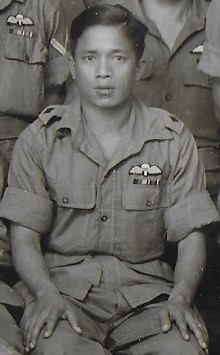
Jemadar Chang Hring Anan: Chang Hring Anan, also spelt ‘Chang Ring’ and ‘Chanuring’ on his file was a Kuki from the Manipur area. He was born in 1922, and joined SOE at Imphal just short of his 21st birthday in September 1943. Before SOE, he had been a clerk for V Force.
During training in 1944 it was recorded that ‘Although of a different race he got on well with the Chins’ and that he was ‘Jungly and tough physically’. On 22 February 1945 he was parachuted into Burma on Operation Character, team Otter.
Jemadar Chang Sau: Chang Sau was Kachin, born in 1922. He served with 1 Battalion the Burma Rifles and must have remained in Burma for he was recruited in the field by SOE on 1 June 1943. Extracted to India on 20 June 1944 after working with Dilwyn, he completed paramilitary and parachute courses before going back to Burma with Shan Lone as part of Operation Dilwyn on 28 December 1944. Extracted from the field on 26 April, Chang Sau was back in Burma on Operation Character by VE Day (8/5/45) where he remained until 18 October 1945. Shan Lone described him: ‘Intelligent. Good Man.’
Chang Shen: Chang Shen was one of a group of Chinese agents supplied by the Kuomintang in 1943. He is recorded as having completed a thirteen month Special Service Training course in China before being flown to Calcutta for SOE to filter. He spoke six languages: Mandarin, Cantonese, Foochow, English, Burmese and Hindustani.
On 27 October 1944, Chang Shen was dropped over Burma for an operation codenamed Wakering in the Pegu area, but his parachute failed to open.

Poppy photo from Flower Meaning
Major Frederick Vivien Charlesworth: Charlesworth was born in Buenos Aires on 22 February 1911. On 6 June 1941 he received an Emergency Commission in to the Royal Artillery, and by April 1942 he was serving with V Force in the Chin Hills. From 1944 he was attached to SOE, initially required for Operation Hainton (later Heavy). In March 1945 he was deployed on Operation Character to serve with Tulloch’s Walrus group. He was not killed in action, despite a document in his file appearing to show he did – an archiva error!
Sergeant Charlesworth: Parachuted into work with Lt.Col. Peacock’s Otter group on 28 March 1945, Charlesworth belonged to Z Force. He was KIA when the Japanese attacked his outpost which was located on a spur leading up from the Mawchi – Toungoo Road.
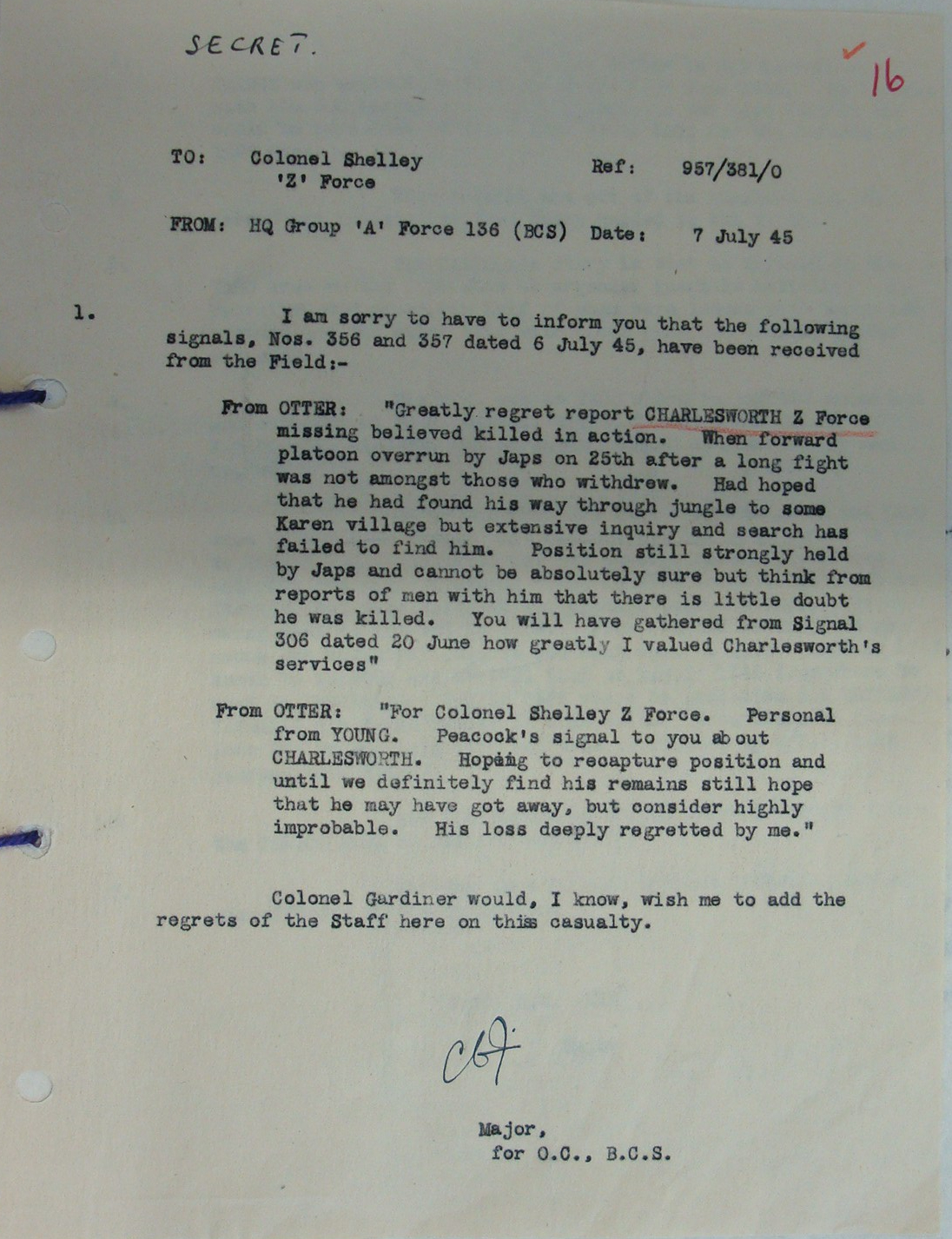
Personnel file: HS 9/299/1

Major Chasse, from his PF
Major Pierre Edouard Chasse: a French Canadian born 4 November 1920, Chasse joined the Canadian Army in 1939. By the time he joined SOE in March 1944, he was aged 23, which might account for the description of him as a ‘rather young Canadian with a very good opinion of himself.’ Later in that same report, it was opined that he ‘does not show any outstanding qualities.’
On 13 June 1944, Chasse parachuted into France as a Representative of the Allied High Command with the task of ascertaining the situation with the Maquis in the Rhone Valley. In his citation for an MBE, it states that operations in that area under his command accounted for nearly 10,000 German killed and captured. He left France in September and immediately volunteered for the Far East.
Chasse parachuted into Burma on 24 April 1945, with Sgt. Cornick (who he had served with in France) and Major Clowes. Their Jed team was part of Operation Nation and codenamed Dog. Their area of operations was the Irrawaddy Delta region, tasked with coordinating the Anti-Fascist Organisation and the Burma National Army. Politically, just as in France, Chasse had a difficult job.
There are no details of Burma ops in his personnel file, HS 9/301/4.
For more on Canadians in SOE, see
‘Legion‘ – Canada’s Military Military History Magazine (2 parts, second here)
Sergeant Ronald Eric Chatten: Born 11 November 1922 near Wymondham in Norfolk. Chatten was working in the timber trade until he and a mate decided to join the army because he was ‘fed up with work’. He passed out as a wireless driver operator in the Royal Armoured Corps.
Responding to a notice calling for volunteers, Chatten joined SOE as a Jedburgh. He parachuted into the Montpellier region of France in 1944 with Captain Sell from London and a Free French officer, Lt Soual as Jed. Team Chrysler. On exiting the plane, he hit his head on the hatch and landed unconscious. Chatten was awarded the Croix de Guerre for his work in France.
In his IWM interview, Chatten says he was given no choice but to go out to Burma. He jumped from a Dakota into Burma in March 1945, joining team Otter of Operation Character. He walked into Mawchi to tell the Japanese about the end of the war, and was kindly received. The Japanese were apparently happy the war was over. Chatten was MID for his work in Burma.
Personnel file: HS 9/302/3
Chen Pan Fee: Employed as a cook for the Spiers operation, Chan Pan Fee’s record is brief. He went overland to Kokang as part of Spiers 6 on 14 May 1944 and returned 10 September 1944. Upon return to India, he worked in the mess for a short time but was paid off as he was ‘Too expensive to keep’.
Chen Yuan Chuan: Part of the group of Chinese agents sent by Nationalist China in September 1943, Chen Yuan Chuan was a W/T operator. Born in 1921, he was described during training as ‘[A]lert and intelligent’, and later by Major Manford as ‘a bit of a smart Alec’.
Chen Yuan Chuan was Chang Shen’s W/T operator for Operation Wakering in the Pegu area of Burma. Chan Yuan Chuan also died, as his parachute also failed.

Poppy photo from Flower Meaning
Cheng Kai: Described as Cantonese and born on 10 October 1917, Cheng Kai has an interesting record. Cheng Kai worked for the R.I.I – Resources Investigation Institute – a Nationalist intelligence organisation (thanks to @Chinaww2 for clarification) Between August and November 1943, he was part of a British reconnaissance of Kengtung area, where he made quite an impression as an ‘invaluable’ member of the party. Consequently, he was selected for SOE’s Hainton operation to the same area in the Southern Shan States in 1944. Operation Hainton developed into Operation Heavy, and Cheng Kai came under the command of Major Pennell.
It appears that Cheng Kai and Major Pennell fell out. On 4 March 1945, Cheng Kai left the operation, and walked out to India where he arrived seven months later. Pennell gave Cheng Kai no letter of introduction nor means to travel; he arrived in India pretty browned off. Major Pennell’s actions were described as ‘entirely wrong’ and explained by his lack of experience of working with Chinese personnel. A written note says ‘Everything, therefore, be done to build up his morale before he is paid off.’ Major Pennell, apparently, did not report anything about the tension between the two men.
Also worthy of note: OSS Det.101 gave significant help to Cheng Kai in his extraction to India.
Paul Cheung (also Chung): An almost empty record card, Paul Cheung was recruited as an accountant and interpreter for Operation Spiers, a mission to the Kokang area of Burma. He was in the field between 5 February 1944 and 24 July 1944.
An addition to the record reveals that Paul Cheung was in all likeliness a spy for the Chinese Nationalists. Signals plans had to be changed when it was discovered that Paul Cheung was in contact with Col. Wang, officer commanding 2 Battalion, 26 Regiment of 9 Division. There was ‘no doubt’ that Paul Cheung was responsible as he worked the office where all coding was done.
Dr. Chia Pee Chyo: Born in Sumatra on 18 January 1918, Chia Pee Chyo studied at the University of Hong Kong, graduating in 1941. In September 1942, he left Hong Kong for ‘Free China’ where he arrived in October 1944. He had no military training, and was taken on by SOE to be a doctor on Operation Spiers. He was in the field from 14 April 1944 until leaving Kokang on 10 September 1944. While in Kokang, he was threatened by Col. Wei Wen Kang, who put pressure on him to stop working for the British.
Jemadar Chin Pau: Chin Pau was deployed on Operation Label, team Rat on 22 January 1945 near Indaing, Burma. The team were compromised, the British officers killed, so Chin Pau led the 16 survivors back to British lines by 28 March 1945.
Rifleman Chin Za Tun: Chin Za Tun was deployed on Operation Label, team Rat on 22 January 1945 near Indaing, Burma. He was one of the 16 survivors led back to safety by Jemadar Chin Pau.
Chit Htoo: A Shan Burman cultivator, Chit Htoo was recruited in Mawlaik District in 1944. Between August and December he completed parachute instruction at Chaklala and paramilitary training at Horana, Ceylon. Chit Htoo was then deployed on Operation Nutshell, team Antelope under Major Abbey from 20 March to 5 October 1945. Major Abbey wrote: ‘An ordinary individual and nothing outstanding about him.’
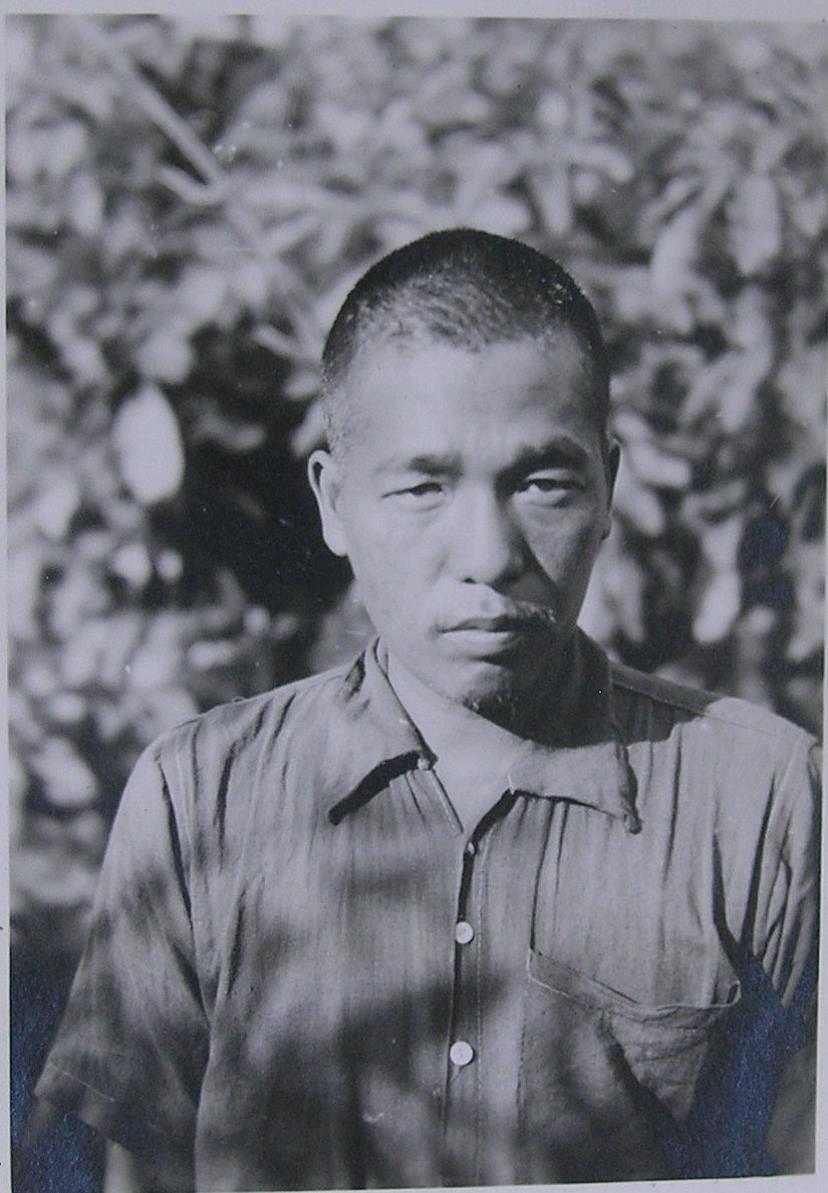
Chit Tok: A Shan Kadu cultivator from Myitkyina District, Chit Tok was recruited by SOE on 1 June 1944, aged 35 years old. He was just 4’11”. With no proper training card, his record is a bit thin (despite a photo), but it is likely that he was recruited for Operation Dilwyn.
Captain Laurence Walter Clark: Born 16 May 1914 in Maidstone, Kent, Captain Clark was a Cambridge graduate with an MA in Economics. He wrote for the Economist in 1938-9, joined the Army on the outbreak of war and received an Emergency Commission in 1940 with 8 Battalion the Buffs. He went on to serve with the Dogras in Waziristan 1942-4 before working for Intelligence on a ‘Jap conspiracy against India’ which was ‘connected with JIFS in 11th Army Group’. In August 1944, he joined SOE, as he wanted an operational role.
Clark parachuted into Burma on 26 March 1945. He was part of Operation Character, team Mongoose, firstly as 2i/c area Blue, then leading area White. On his exfiltration report, it is recorded that he was ‘extremely hardworking’ but ‘Very difficult as a ‘second-in-command. He is best suited to run his own show.’
Personnel file: HS 9/320/5

Major John Ernest Clowes: born 7 November 1908, was the first son of Major Ernest Clowes, DSO, who served with the Life Guards in the second Anglo-Boer War and the Great War. His younger brother, Colonel Sir Henry Clowes served in the Scots Guards. The family home was Bradley Hall, Derbyshire, which wass for sale in 2019.
Educated at Eton, Clowes had started an agricultural degree at Oxford, which was unfinished, presumably due to the war. Commissioned in the Derbyshire Yeomanry in 1932, Clowes was a Major by 1939, joining SOE in August 1943. He served with Force 133 in Greece from May to December 1944 after training in Palestine. He then volunteered for operations in the Far East, parachuting into Burma as part of Operation Nation, team Dog from 24 April to 11 July 1945.
Personnel file: HS 9/328/7
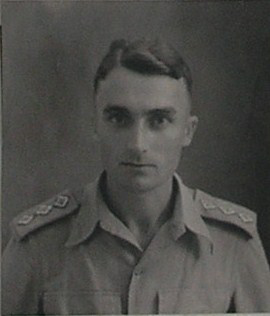
Major Arthur Thomas Cockle: born 26 January 1914 in Worthing, Sussex, Cockle attended Worthing’s High School for Boys and went on to be an accountant. Between 1933 and 1939 he was in the City of London Yeomanry T.A, presumably while working in the city. He went out to Burma to work as an accountant in May 1939, where he joined the Burma Auxiliary Force (BAF), and was attached to the King’s Own Yorkshire Light Infantry (KOYLI). He was commissioned in the Army of Burma Reserve of Officers (ABRO) in April 1941 and went on to train in heavy and light anti-aircraft in Singapore as part of the BAF. By August 1942, after fighting in the first Burma campaign, he was promoted to acting Major.
After retreating to India, Cockle was part of India’s AA defences, in both a Heavy and Light AA role. He only joined SOE in January 1945, a previous application having been turned down as he was considered too valuable in his AA postings. He was so determined to go operational that he turned down a senior posting within the artillery. On 24 March 1945, he parachuted into Burma as part of Operation Character, team Walrus. With Major Denning and Sgt. N.A. Smith, they were responsible for Red area. He remained in the field until 31 October 1945. For his work in Burma he was awarded the MC.
Personnel file: HS 9/331/4
I contacted Cockle’s school Alumni, and they have added him to their Second World War page HERE

Sergeant Peter McLeod Colvin: Sergeant Colvin never made it to Burma, but he is registered as Killed in Action (KIA) on the strength of Burma Section, Force 136.
Born in Watford on 27 April 1923, Colvin joined SOE in 1943. He had been serving as a Lance Corporal in 112 Royal Armoured Corps (Sherwood Foresters). In July 1944, Colvin parachuted into the Cotes du Nord region of France where he was MID and awarded the Croix de Guerre for his work with the French Resistance. His citation for the CdG reads that he parachuted:
‘sans en uniforme, dans une region infestee d’ennemis‘ (which my school French translates as ‘without uniform into a region infested with enemy’) where he showed ‘courage exemplaires‘
After France, Colvin was shipped out preparatory to a second operation in Europe, but when it was cancelled, he volunteered to go to the Far East. Days short of his 22nd birthday, Colvin, along with Captains G. Marchant and P. Vickery took off from Jessore to be parachuted into Burma as team Hart on Operation Nation. Their aircraft exploded after just becoming airborne, killing all on board.

Poppy photo from Flower Meaning
Personnel file: HS 9/338/5
Naik Cong Mong: A Chin, Cong Mong was born in 1917, and was recruited to SOE from V Force. Previous to V Force he had served with the Burma Signals. Cong Mong completed parachute training at Jessore and then deployed into Burma to Operation Character’s team Hyena from 6 May to 13 November 1945.

Captain Arthur William Richard Coomber: born 15 January 1921, in Portsmouth, Coomber attended the Bedford School until July 1940. He was studying Classics at Trinity, Cambridge, when he was commissioned in to the Royal Armoured Corps. He saw service with the 23rd Hussars in Tunisia in 1943 before joining SOE.
After training and then instructing, Coomber was deployed in France as part of Jed team Simon in the La Rochelle area. He then volunteered for further operations in the Far East, leaving the UK for India in January 1945. Coomber was dropped into Burma on 2 May 1945 and served on Operation Character/Walrus.
London Gazette: Commission
London Gazette: MiD
Personnel file: HS 9/345/8

Captain Raymond Michael Cooper: born 3 May 1920 in Derbyshire, Cooper studied modrn languages at St. John’s College, Oxford. He was fluent in French and Spanish. Receiving an Emergency Commission in the Royal Artillery in February 1941, he was posted to 69 Light Anti-Aircraft Regiment, and was posted to India with his regiment in March 1942.
He volunteered for the Chindits in November 1943, and served throughout Operation Thursday with 1 Battalion Lancashire Fusiliers. He then returned to the Artillery at his own request. He is then recorded as joining Force 136 on 22 February 1945, with whom he went back into Burma with No.2 Forward Propaganda Unit. His job was to broadcast ‘general tactical propaganda to enemy.’ By July 1945, with repatriation immanent, he was writing letters enquiring about how he might find employment with the ‘Foreign Service’ after the war.
Personnel file: HS 9/349/2
Love letters between Cooper and his future wife have been transcribed and published HERE. The letters start in early 1945 and there are snippets of his time with the IFBU in Burma.
Major Samuel Alexander Cope: Major Cope was born in Stone, Staffordshire on 22 August 1914. Apprenticed into the Worshipful Company of Haberdashers, Cope sailed for Rangoon in 1936 where he worked for the Bombay Burma Trading Company in forestry. He joined the Burma Rifles and served with 9 Burif from February 1941. He was recruited by SOE on 9 October 1943 and deployed on two operations: Spiers and Heavy.
Personnel file: HS 9/350/5
For more on 9 Burif, see see Steve Rothwell’s ‘The Burma Campaign’

Sergeant Edward Alfred Cornick: born 25 May 1923, Cornick, like many SOE W/T sergeants, was recruited from the Royal Armoured Corps. He served in France from 28 June to September 1944 with Jedburgh team Willys, though there is also reference in his file to Jed team Simon (see p.129 HERE). He was awarded the Crox de Guerre for his work and his file contains two recommendations for an award for his work with French resistance, one by Major Chasse. He then volunteered to go to the Far East, parachuting into Burma inn April 1945 as part of Operation Nation, team Dog, with Majors Clowes and Chasse. For his work in Burma:

Personnel file: HS 9/354/6
Sergeant Cottingham: served on Operation Character, Otter area, from 1 May 1945.

Photo courtesy of Major Cox’s son, Andrew Cox
Major John Howard Cox: Major Cox was born in Thandiani, North India, on 21 May 1919. He lived in India for seven years before schooling at St. Georges, Harpenden in the county of Hertfordshire, from 1928-37.
At the outbreak of war in 1939, Major Cox was one year into his under graduate studies at Oxford, where he attended Wadham College learning French and German. Cox was given an emergency commission into the Royal Artillery in November 1940.
After joining SOE, Cox parachuted into France on 7 August 1944 as part of Jed team Ivor. He was awarded the Croix de Guerre for his work in France, as well as Mentioned in Dispatches (MiD).
Cox returned to the UK from France on 22 September and left for India on 3 November. By December 1944 he was behind the lines in the Arakan region of Burma with Major Tom Carew and Sergeant Sharpe as team Camel. After the successful completion of this operation, for which he was awarded the Military Cross (MC), Cox was again parachuted behind the lines into Burma to work with Burmese nationalists, this time as team Pig with Sergeant Tack and Major Reid. Taken prisoner by Indian National Army troops, Cox, Reid and Tack managed to escape, and were on the run for about three days before joining up with SOE colleagues.
Training reports before becoming operational described Cox as ‘a very sound and reliable officer in every way’. It was also reported that he needed ‘more punch’ to bring out his latent leadership skills!

Personnel file: HS 9/367/6

Photo courtesy of Edmund Craster, Captain Craster’s son
Captain Oswin Edmund Craster: Captain Craster was born in Oxford on 28 June 1916. After schooling at Stowe in Buckinghamshire, Craster went to Oxford where he studied History. While at Oxford (1934-7), he was in the Officer Training Corps. He was then employed as an archaeologist for HM Official Works, specialising in ancient monuments. In 1937, he was digging at Maiden Castle in Dorset.
In April 1939, Craster joined the T.A., and he was commissioned. His unit was 5 Battalion Oxford & Bucks. Light Infantry. He joined SOE in November 1943 and was trained as a Jedburgh for operations with the French Resistance. He went on operations as part of Team Stanley on 31 August, returning on 20 September. After a brief spell back with his parent unit, Craster left for India on 9 February 1945. He was dropped into Burma as part of Operation Nation, team Zebra, for which he was MID.
There are lots of weekly reports on his progress in training in his personnel file. Opinion was that he would make a good second in command, and regarding weapons training, he was a ‘Good shot’ but ‘Rather clumsy in manipulation.’
Personnel File: HS 9/369/6
IWM Interview: Craster

Critchley, presumably in Zambia sometime between 1952 and 1972. Picture credit: see Special Forces Roll of Honour
Lt.Col. Ronald Ashton Critchley: Born on 8 October 1905 in Edinburgh, Critchley was schooled at Wellington College in Berkshire. Critchley was commissioned into the Royal Armoured Corps (RAC, 13/18 Hussars) on 25 September 1925. In Duncan McNab’s Mission 101, Critchley is described as ‘an imposing figure at 6 feet 6 inches who had ended up in intelligence after unsuccessfully trying to fold himself into a tank.’
His ‘SOE Record of Service’ details the following in his ‘Knowledge of Foreign Countries Section’:
Egypt – 1929-31
India 1931-38
Yugoslavia 1939 for two months
Egypt, Abyssinia, Sudan and Kenya 1939-1942
India 1942-45
Burma 1944-45
In 1939, Critchley worked for MI(R) in Yugoslavia; MI(R) was one of the three components that went on to form SOE in the summer of 1940. Mission 101 in Abyssinia was Critchley’s first job with SOE ‘proper’ where he won the MC before working for SOE in Cairo and then in India from August 1942 to January 1943. This latter role was ‘organising post-occupational guerrilla warfare on the north-east frontier’ – in other words in Assam with the embryonic V Force. He then went on to join the Chindits.
Critchley was parachuted into Burma in February 1945 as part of Operation Character. He was in charge of the Mongoose area, the most southern part of the operation. His area came under intense pressure from the Japanese in May and June after Rangoon had been recaptured by the allies. For his work in Burma, Critchley was awarded the DSO.
After the war, Critchley worked in conservation in what was Northern Rhodesia, now Zambia. He then moved to Australia where he died in 1999.
Personnel file: HS 9/373/8
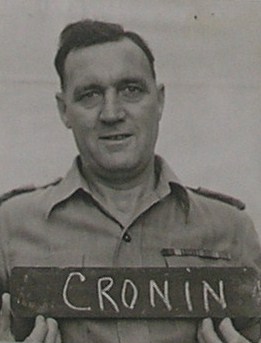
Captain William John Cronin: Born 26 February 1900, Cronin joined the army in 1915. He served in the UK and Ireland until 1919 when he was posted to Burma. He remained in Burma until 1942, when he retreated to India. Before being commissioned on 1 September 1941, Cronin had risen through the ranks to RSM.
Employed by Force 136 for his extensive knowledge of Burma in 1944, Cronin ended up as camp commandant for SOE’s tactical HQ in Rangoon from about 27 May 1945.
Personnel File: HS 9/375/2

Getting married in October 1944
Colonel Michael George Marsh Crosby: Born on the island of Jersey on 4 October 1911, MGM Crosby had a remarkable career in the British armed forces. In civilian life, Crosby had been a tutor and, according to his SOE record of service, ‘Latterly – Political Secretary – and Conservative Agent’. In ‘Hobbies and other Interests he declared ‘Motoring’, of which more later.
Crosby served in the ranks from 1939 and was Commando trained at Lochailort before going to Norway where he served with No.4 Independent Company. He returned from Norway as acting Sergeant, but received an emergency commission into the Gordon Highlanders in November 1940. He completed a junior leaders and intelligence officer course before joining SOE in August 1941 where he was employed as an instructor at STS 25. In 1943, he was described as ‘An excellent officer in every respect.’ Later, he was sent to North Africa, where he became operational and was dropped in Southern France as part of Jedburgh team Graham in August 1944.
Crosby then left for India, and after a short spell of jungle training in Ceylon, was dropped on Operation Dilwyn on 27 January 1945 as area commander. He remained in the jungle until September. He was MID and awarded the MC for his command of Dilwyn.
After the war, Crosby trained the new Burma Army, preaching to students that ‘an army should be non-political.’ It got to the point in 1948 where he knew he should take his family to safety, and he left Burma ‘with many regrets.’ While on a month’s attachment to the French Army, Crosby got recalled to the UK – his next destination was the Korean War.
After Korea, it was Crosby who organised the first Army Driving Championships.
Personnel File: HS 9/375/6
Crosby’s book:
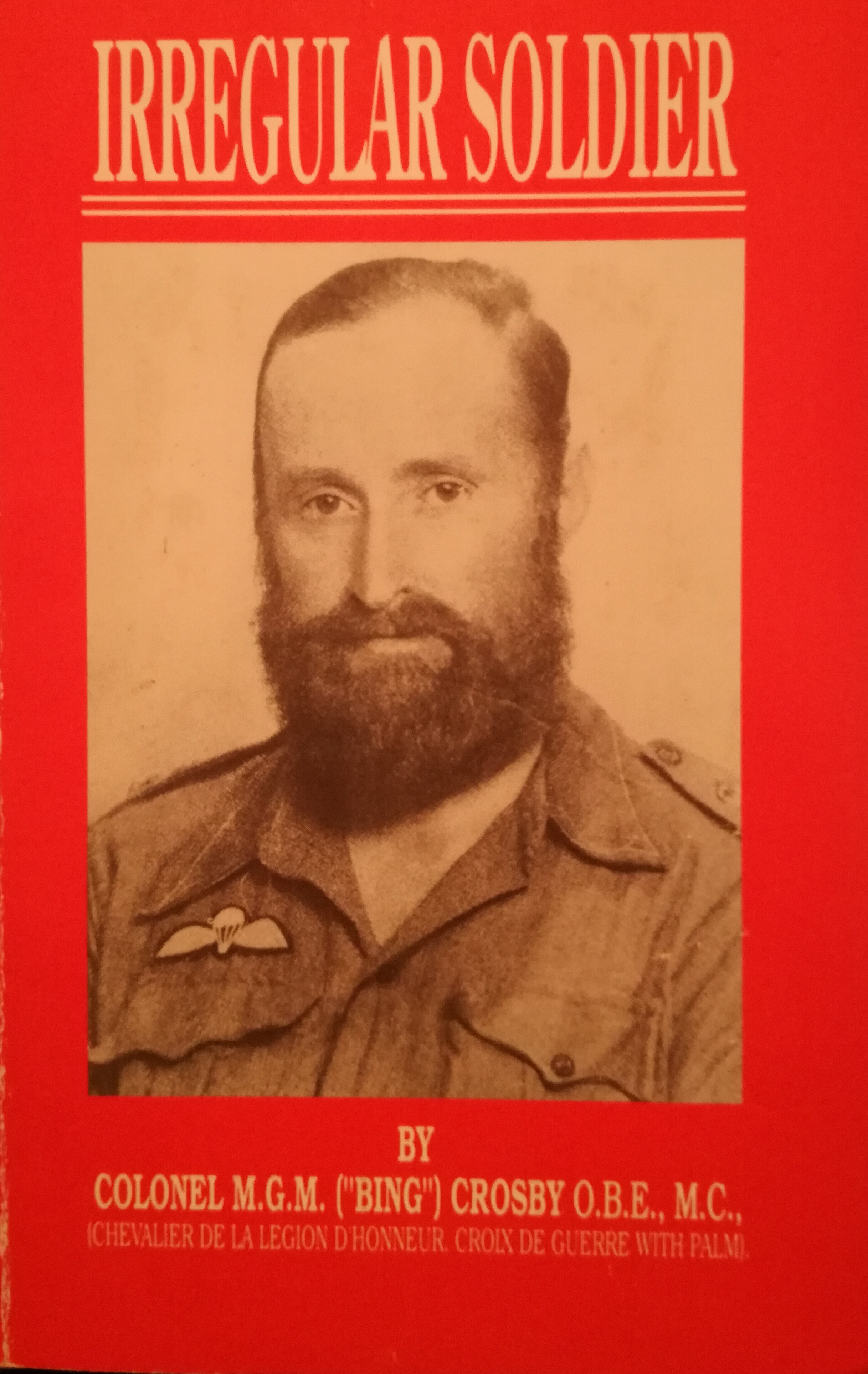

Col. Mount Stephen Cumming: Cumming was born in Dufftown, Scotland, on 20 April 1911. He attended OTC as a junior and a senior between 1924 – 1933. He studied Classics and Law at Cambridge before going to work in China for the firm Butterfield & Swire. While in China, he was part of the Hong Kong Defence Force 1934-37.
In 1939, Cumming was granted an emergency commission into 75 Field Regt., Royal Artillery. In early 1941 he was recruited by SOE for work in the Far East, reporting for duty as a Lieutenant in Singapore on 15 April 1941. He was trained at STS 101 and then posted to Burma in November. Cumming trekked out of Burma following the Japanese invasion, arriving in India in July 1942.
Cumming was well regarded:

He was GII Operations and Liaison for Group A of Force 136, then GSO I and, from August 1945, Commander Group A, Force 136. From December 1945, he was Commander, Force 136. For most of the war then, he oversaw SOE operations into Burma, Malaya and Siam as officer in charge of Group A. He was awarded an MBE for his work with SOE.
Personnel file: HS 9/381/2
Signalman Dal Bahadur Chettri: Chettri was born in 1920 to a Gurkha father and and a Kachin mother. His father had been in command of a garrison at Kunlong in the Kokang area. Given his knowledge of Kokang, Chettri was trained was deployed on Operation Spiers after extensive W/T training in both India and Ceylon. He was deployed on Spiers from 8 March to 3 June 1944; he was allowed on leave because his wife was ill. Chettri later parachuted in to Burma to serve on Operation Character with team Mongoose in area Black, from 26 March to 5 November 1945. He was described as ‘an excellent operator’ who was ‘very popular with the Karens.’
Dal Bahadur Chettri was awarded the British Empire Medal

Sergeant Arthur John Dallow: Dallow was born 3 March 1924, and was recruited into SOE from the Royal Armoured Corps. He served in Finisterre, France from the night of 9 July 1944 where he was lucky to escape having been surrounded by Germans. He was awarded the Military Medal and the Croix de Guerre for his work in Finisterre as part of Team Francis.
Dallow then went to Burma where he deployed on Operation Character, serving with Captains Ford and Williams as part of Mongoose, Red from 26 March 1945. Many of their Karen recruits were those who had served with Seagrim.
Personnel file: HS 9/390/4
Dam Za Go: Almost an empty record, so here is the sum of it: deployed on Operation Label, Rat on 22 January 1945 near Indaing. Returned 28 March 1945 with Jemadar Chin Pau (see above).

Captain Darlington, Arthur Brook: born 2 September 1920 in Hale, Cheshire, Darlington attended Clifton College in Bristol before going on to read Mining and Engineering at Birmingham.
Gaining an Emergency Commission on 14 February 1941, Darlington joined the Royal Artillery serving with 69 LAA and 77 LAA regiments up to August 1944. He joined SOE’s Indian Field Broadcasting Units (IFBUs) after leaving 77 LAA and went into action in Burma in 1945.
For more on IFBUs, see The Diary of Captain Trutwein
Sergeant Dawson: served on Operation Nutshell, team Antelope.
Subedar De Bu: De Bu was a Chin in the Burma Army Signals, born in 1921. In October 1942, De Bu was recruited by SOE and went to Nazira for W/T training. This seems slightly unusual as Nazira was made the base of the American OSS. The following month he went for advanced W/T training at ME 9 in Meerut.
Following these two courses, De Bu served in the Chin Hills in the Falam area from January to December 1943. In February 1944, he completed parachute instruction at Chaklala preparatory to being dropped into Burma on Operation Dilwyn in April 1944.
With most of the Dilwyn personnel, De Bu was extracted to India in June 1944. He completed a refresher course in parachute instruction before going back to Burma as part of Dilwyn’s team Badger. He was gazetted in 1947 for a Military Cross.
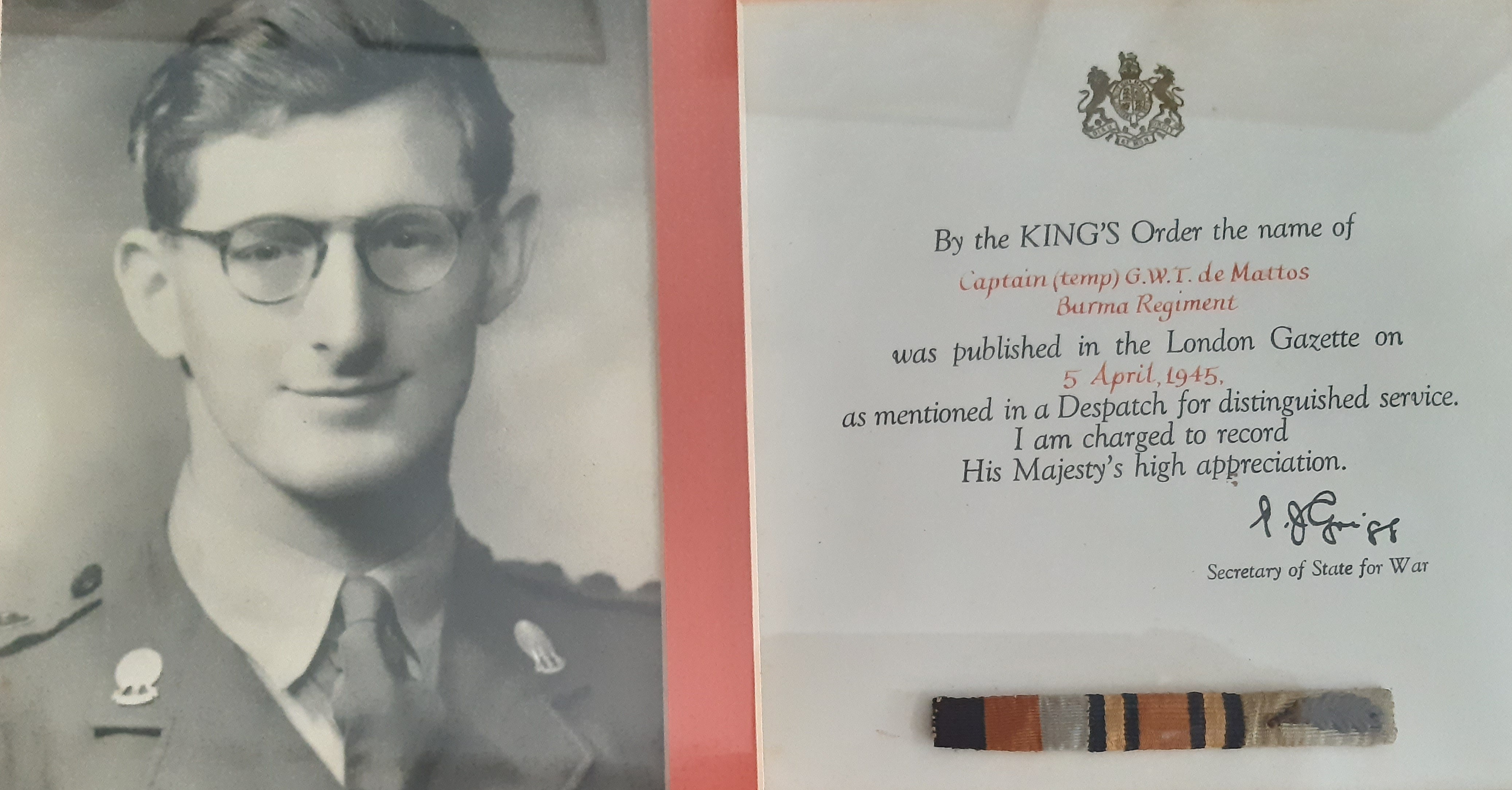
Photo courtesy of Paul de Mattos
Captain George William Theodore de Mattos: born 7 September 1916 in Gidea park, Essex, de Mattos attended Christ’s Hospital School before completing agricultural training. He went to Burma in 1936 where he worked at the Hsipaw Tung Oil Estate in Shan State. When the war started, he continued on the estate, his employer unable or unwilling to release him and other staff. After Rangoon fell, he and some colleagues took matters into their own hands and made for Army HQ. In a letter, de Mattos wrote that the Army ‘seemed quite anxious to have us’ and that they were ‘granted commissions in the space of three hours’. By the beginning of April, he had been sent south to the front line.
It was not long before he was driving back north to establish a base in the hills from which to fight the Japanese, but their advance was too swift and de Mattos ended up trekking out of Burma to China. From China he was flown to India where he joined the Chin levies on the Indo-Burmese border.
His personnel file indicates that he was requested for Operation Harlington, but it is not clear that he made it into the Karen Hills for this mission. He certainly served with SOE / Force 136 as he won a MiD. He was demobilised in 1946, and then went back to work in the Shan states until 1949 when the civil war forced him to leave the country. From Burma he went to Nyasaland (present day Malawi) to plant Tung Oil with the Colonial Development Corporation. In the ’50s, he was farming in Kenya until 1965 when he went to South Africa, settling in Kwa Zulu Natal where he farmed until passing away on Boxing Day 1990.

Major Arthur Du Pre Denning: Born on 15 April 1909 in Birmingham, after attending the Merchant Taylor’s School, Denning became a bank Clerk for Baring Brothers. He joined the Home Guard in 1940, was a trooper in the RAC in 1942, and then became an officer cadet in January 1943. Denning joined SOE in September 1943; his parent regiment was the Hampshires.
Fluent in French having been schooled in Belgium for two years, Denning was parachuted into France as part of team Archibald. He won the Croix de Guerre for leading the Maquis in the Vosges area, taking on the SS, Tiger tanks and German para troopers to assist the advance of the US 35 Division. He was also awarded the MC.
From France, Denning was posted to the Far East where he joined the Burma Country Section. He took part in Operation Character in command of Walrus Red with Major Cockle and Sergeant Smith. Denning was in action so much that throughout his operation he was asking for ammunition drops which came by Beaufighter, Lysander and Dakota. For his work on Operation Character, Denning was recommended for the DSO, for which he was gazetted on 7 November 1946.
Not a bad record for a man who ‘Doesn’t wish to be operational’, which was possibly because he was married and had two children, Mary and John, born in 1932 and 1934 respectively.
Personnel file: HS 9/418/4

Captain Harry Marcel Despaigne: born 3 May 1917, Despaigne was ‘destined for electrical engineering’ until the war interrupted things. He joined SOE in December 1941, and his training reports speak of a man who would do well in the field individually. His first operation, from 17 July 1942 to 12 June 1943, was on the Spindle circuit. His second operation on the Detective circuit ran from 17 September to 21 July 1944. He was awarded the MC for his work in France, particularly his second mission, as part of the ‘Black Mountain Commando’:


Despaigne volunteered for further service in the Far East, eventually parachuting into Burma on 28 April 1945 as part of Operation Nation, team Dog, joining Jed team Panda who were already in the field (Major Boiteaux, Captain Planell and Sgt. Siddall). The Panda team received the Gurkhas dropped on Elephant Point in 1945, part of the plan to reoccupy Rangoon.
Personnel file: HS 9/427/9

Photo courtesy of Major Dewanjea’s sons, Shivaji, Amitav & Partha. Post-war information below also courtesy of the Doctor’s sons.
Major Bhupesh Chandra Dewanjea: born 14 December 1920, Dewanjea was a doctor, recruited by SOE in July 1944. There is more about Dewanjea’s operational experience in this post ‘A Doctor on Special Operations’,but to include a brief biography here:
Dewanjea was trained as a physician at Rangoon University, and he was in that city when war with Japan started. Dewanjea was commissioned on 21 February 1942 as he retreated from Burma to India via Maymyo, Meiktila and Kalewa, attached to Number 1 Burma Field Ambulance. He was recruited into SOE / Force 136 in July 1944.
His first posting with Force 136 was to Camp Tweed as chief Medical Officer. Camp Tweed was a holding camp for SOE personnel, but it was ill-sited. It was in a malarial hot spot, and such was the rate of sickness that it was not long before the camp was closed down. By September 1944 Dewanjea is recorded as being in Calcutta at headquarters. In February, he completed parachute training at Jessore, and then he was dropped into Burma in March 1945 to join Hyena.
After the war, Dr. Dewanjea continued in the Army until a medical board discharged him in 1953 due to injuries sustained from parachuting. On retirement from the Army, Dewanjea continued as a doctor in both Burma and India, and was a very prominent Free Mason. Dr . Dewanjea was healthy and cheerful (except for his knee) and finally left us for the Grand Lodge above on 22 March 2017.
Personnel file: HS 9/429/3
London Gazette: Commission 1942, Promotion 1943
Link to video made by Major Dewanjea’s family.
Lance Naik Dum Hpya Tang: Born in 1914, Dum Hpya Tang was a Kachin who served with 10 Burif. He was recruited by SOE either in March 1944 or January 1945 according to the query on his record. Parachute trained a Jessore, Dum Hpya Tang was deployed on Operation Heavy, team Lynx from 28 March to 19 October 1945.
Major Pennell wrote: ‘Excellent – should have been promoted to the rank of Havildar.’

Captain Albert Anthony Dumont: Born in London on 4 January 1921, Dumont had a Belgian father and French mother. He was recruited for F Section, but since he was only recruited to SOE in June 1944, by the time he finished his training it seems he was not needed in France. His instructors noted his intelligence and individualism in 1944, judging him fit for operations.
In November 1944 he left for the Far East. Dumont ended up parachuting into Burma on 30 March 1945, where he served under Lt.Col. Peacock on Operation Character, Otter, White. He was withdrawn from the operation on 1 October 1945.
Personnel file: HS 9/457/4

Picture Credit: James and Valerie Edgar
Sgt. James Edgar: born in Pietersburg (N. Transvaal) on 21 May 1920. Sgt. Edgar’s Scottish father had served in second Boer war and remained in South Africa in Government service.
In 1927, when Edgar was 7, the family left for the UK. He volunteered for the army in August 1940. After three months in the Gordon Highlanders he was transferred to the Intelligence Corps (perhaps because of his language skills, French and German).
He was in Field Security Police, which meant he trained with would be agents for French Section, as well as conducting Norwegians to the Shetland Islands for ‘Shetland Bus’.
As part of 62 Commando he trained at Anderson Manor in Dorset. With Small Scale Raiding Force in Sep\Oct 1942, Edgar took part in two raids to the Channel Islands, Burhou (Branford) and Sark (Basalt, notorious as several German prisoners were shot when tied up).
After W/T training he was part of the ‘Tilleul’ (Lime Tree) circuit, which parachuted into the Haute-Vienne area of France on 9 July 1944.
After the liberation of Limoges he returned to the U.K and volunteered for Burma. He parachuted into Burma on 27 April 1945 as part of the Nation Operation, and was designated team Giraffe. His Jedburgh team was
- Major M.C. McAdam
- 2/Lt. H.M. Moore
- Sgt. J. Edgar (W/T)
- U San Tin
Back in Ceylon (in hospital with dysentery) he volunteered for peace keeping in Sumatra. He was demobilised at the end of 1946.
After the war, Edgar qualified as a vet in Edinburgh. After several years in practise, he moved to Perth, Western Australia, to the Dept of Agriculture.
Sgt. Edgar was Mentioned in Despatches and received the Croix de Guerre for service in France.
Sgt Edgar’s PF is not open as he is 99 years old, still living in Perth.
For more on F Section and the details of the Tilleul team, see HERE
Captain William Edward Evans: DOB 6 December 1898. Evans lied about his age and joined the army on 23 October 1914; he was just 15 years old. He served in the Royal Engineers, 27 Division, in France, Salonika and Egypt. Evans worked in Burma as an engineer from about 1935, with Steel Bros. initially.
In August 1941 he was commissioned and in September joined the Oriental Mission. Evans trained at STS 101 in Singapore during November 1941 before taking command of No.1 zone in Burma, responsible for an area covering the Thai border.
Evans trekked out of Burma in 1942, and was taken ill with malaria. He was discharged from SOE on 30 September 1942.
Personnel file: HS 9/490/4

Major Dennis Ford: Major Ford was born in Monk Sherborne, Hampshire, on 12 February 1919. After attending the Queen Mary’s School in Basingstoke, Ford joined the Army and served in the ranks from 10 March 1938 until being granted an emergency commission on 9 March 1940. Before joining SOE in May 1943, Ford saw active service in France 1939-40, Crete 1941 and in the first Burma campaign as part of the British Military Mission to China.
After joining SOE, Ford was sent back to the UK for training. His personnel file contains many of the reports from the various Special Training Schools where he completed instruction. From the UK he was sent to Ceylon as an instructor in 1944. In 1945 he was parachuted into Burma on Operation Character as part of team Mongoose in charge of Red area. He is recorded as being Jed team 17, serving with Captain Williams and Sergeant Dallow. During this operation, Ford won the MC:

Personnel file: HS 9/526/5
Ford’s report on his part in Operation Character: HS 7/106
Major Richard Ellis Forrester: born in Darjeeling in 1908, Forrester was the first officer in charge of the Burma Country Section (BCS) of SOE’s India Mission between July 1942 and February 1943. He was transferred from BCS to become Economic Intelligence officer at SEAC headquarters. He was replaced by Captain (later Lt.Col) Ritchie Gardiner, who remained in the post until the end of the war. In his P/F, Forrester is described as ‘Energetic and intelligent. Rather apt to jump to extremes and to change his mind.’
Personnel file: HS 9/527/4

Captain Joseph Ernest Fournier: born 23 October 1918 in New Brunswick, Canada, Fournier was a miner and diamond driller in civilian life. He joined the Royal Canadian Signals on 3 April 1942 and his reports suggest ‘steady’ and ‘satisfactory’ progress in his W/T training. He joined SOE in June 1944 and was commissioned in October 1944, after having been on a mission in the Alps as a W/T sergeant. He was part of the Union Mission, joining Incidence in the Savoy area to help on an escape route, from 12 August to 6 October 1944. Fournier was MiD for his work on this mission.
Fournier then shipped out to the Far East where he joined Burma Country Section. He was part of Operation Character, team Hyena, from 2 April to 25 October 1945. His report on exfiltration from Burma:
A competent and hardworking signals officer. Later he had to be used purely as an infantryman a task in which he took much pleasure.
Personnel file: HS 9/767/1

Major Anthony Harold Bevington Franklin: Major Franklin was born in London on 25 March 1916. He loved to ride horses and was quite a Thespian. Before the war, he worked in the London Stock Exchange, a job to which he returned in 1946.
Franklin was posted to India in 1940 to 5 Mahrattas, spending much of the war in Belgaum running the initial training for new Indian recruits. Looking to find some action, he was recruited into SOE, turning down a month’s leave in the UK to do so.
Having joined SOE in February 1945, Major Franklin went to Ceylon to gain an understanding of the training and purpose of Force 136 before going into Burma as GSO II. His role was liaison officer between XIV Army and SOE, serving at SOE’s Tactical HQ.
Personnel file: HS 9/539/5
A wonderful tribute to their father has been written by his daughters, privately published. It is based on Major Franklin’s diaries, starting in 1934.
Sudhir Ghosh: Indian agent sent into Burma on Operation Mahout. For more, see ‘Mahout 2: The Frailty of Special Operations’.
Captain Abdul Wahab Ghows: a Malay born in Perak on 30 January 1921, Ghows had experience as a journalist and with the Ministry of Information in India. He was recruited to SOE in June 1944 to work with the Indian Field Broadcasting Units (IFBUs). He was posted to the IFBU training camp at Fagu before deploying in the Arakan with No.3 Forward Propaganda Unit in February 1945. He was descibed in his June 1945 report as full of ‘remarkable energy and keenness, very intelligent and hard working.’ He finished working for SOE on 8 November 1945.
Personnel file: HS 9/578/6
Sergeant Donald Gibbs: born 30 July 1917, Gibbs worked for London County Council from 1934 until July 1940, when he was called up. He served in the Royal Armoured Corps until 1943 when SOE picked him up. His MI5 trace came back with the news that he was ‘suspected of subversive activities in his unit.’ He was considered an ‘ardent Communist’ and placed under observation, but those observations revealed ‘no evidence’ of subversive actions: [i]n his unit he is regarded as a colourless individual and rather a nonentity.’ Nonetheless, he was to be returned to unit in November 1943.
Owing to an administrative error, however, Gibbs remained at ME65 where he became ‘an expert W/T operator’. The MI5 trace result was considered ‘minor’ by 1944, and Gibbs was sent into France as part of Jedburgh team John. After France, Gibbs went out to the Far East and parachuted into Burma on 28 March 1945 as part of Operation Character, serving in the Walrus area.
Personnel file: HS 9/579/6
Major John Atkinson Gibson: Born 12 June 1912, went to Rugby school. Worked for Barclays Bank from 1930-34, and then in Singapore from December 1934. Gibson was fluent in Malay, Urdu and French as well as speaking Burmese.
Gibson was recruited by SOE in 1943 and first went on operations as part of ‘P Force’. P Force was led by Edgar Peacock, working in front of 20 Division on the Chindwin front. Gibson was wounded in both legs, both arms and his left buttock when a booby trap went off, but he recovered to go on two further operations in Burma codenamed Rendezvous and Burglar, team Hippo.
After Burma, newly promoted Major Gibson parachuted into Malaya, for which he was recommended for an MC.
Personnel file: HS 9/580/4
Havildar Gin Za Cin: Gin Za Cin was recruited by SOE on 1 August 1943 by Major Hobbs. He was working as an interpreter, earning Rs 90 per week. He was convinced to go to India believing he would not suffer a loss of income, but he was persuaded to take Rs40 p/m in line with other recruits. He was apparently not very happy about this, and at the same time was worried about his family, particularly his mum. His brother and father were serving with the Chin Levies.
Gin Za Cin is remarkable for having been on four SOE / Force 136 operations during which his operational pay was Rs300 p/m. His four operations were all over Burma: two were in Arakan (now known as Rakhine state), one was in Kokang (Operation Spiers) and his fourth was with Operation Character as part of team Hyena. His operations in Arakan / Rakhine were really important foundational jobs, particularly as Hound which enabled Lt.Col. Carew to get established.
Two reports about Gin Za Gin:
- ‘very enthusiastic, but at times inclined to get excited and rush things.’
- ‘keen and intelligent in his work beyond the call of duty.’
Havildar Gin Za Lang: Gin Za Lang was a Chin from the Tiddim area. He was a Burma Army signaller, and was deployed under Lt.Col. Crosby on Operation Dilwyn, team Squirrel.

Captain Alan Leslie Goldsmith: Born in Whitton near Ipswich on 16 August 1916, Goldsmith was a Chartered Surveyor working for Westminster City Council by the time the war started in 1939. Commissioned into the Royal Engineers in 1942, Goldsmith was posted to Burma Country Section of Force 136 on 12 May 1945.
Captain Goldsmith was on board Dakota ‘J for Jig’ on 7 September when it crashed on a supply run to Operation Character. Also on board were:
Lt.Col. Wiggington and Kennedy
2/Lt. Little
Sergeants Goodwin and Sowden .
Sowden and (then Sgt) Little had both served on Operation Character, team Hyena Red.
There were a further 11 personnel on the Dakota. All died. Major Bourne of Operation Character gave evidence at the court of inquiry into the crash:


The son of Lt.Col. Wiggington, Gavin Wiggington, published ‘Wig’s Secret War‘ in May 2017.
Personnel file: HS 9597/4
Frontier Myanmar, December 2016 article
Sergeant S.H. Goodwin: Sgt. Goodwin was on board the Dakota ‘J’ for ‘Jig’ which crashed in the Karen Hills on 7 September 1944. See entry for Cpt. Goldsmith, above.
Goodwin’s PF does not have a lot in it, and on the front it has ‘DOB not known’. His parent unit was the Royal Engineers. Will add more here when/if found.

Personnel file: HS 9/600/8

Captain Kenneth Ernest Green: born 16 September 1914, before the was Green was employed by King Island Estates Ltd as a rubber planter on an island near Mergui in lower Burma. He was commissioned in the Army of Burma Reserve of Officers (ABRO) on 21 October 1941. He attended AA training in Singapore and Karachi, although he is also recorded as being in Burma Intelligence.
During the first Burma campaign he served with 2 Light Anti-Aircraft Regiment, and was then picked up by SOE in March 1943. After SOE training, Green was launched on Operation Corton from 31 January to 14 October 1944. This mission was landed by submarine on Elphinstone Island to watch Japanese shipping. After extraction, Green was ill for a period of time before taking an appointment as a staff captain with Force 136 in India during 1945.
His employers were very keen to have him back at work on the rubber plantation in 1945, and asked for his release in May as he was the ‘only European with any practical experience’ to get the business up and running again.
Personnel file: HS 9/616/2
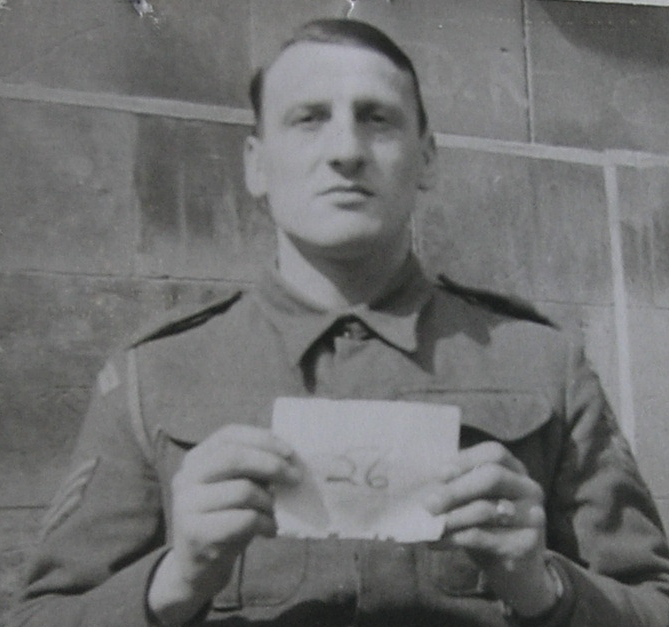
Sergeant Eric John Grinham: born 1 June 1918 in Stoke, Grinham’s employment before the war included shop assistant and police constable. He joined the Royal Armoured Corps, and was picked up by SOE in late October 1943. He was part of Jedburgh team Stanley, parachuted into the Haute Marne area of France on 31 August 1944. He then volunteered for service in the Far East, parachuting into Burma as part of Operation Manual in the Arakan, team Mouse from 25 January to 21 April 1945. For more on Mouse, see HERE.
Personnel file: HS 9/624/3
Gum Man: A Kachin from Myitkyina District who joined SOE in October 1943 aged 22. Presumably deployed on Operation Dilwyn.
Sunil Datta Gupta: An Indian Agent parachuted into Burma as Mahout 1. For more, see ‘Mahout 1: An Indian Agent in Burma’.
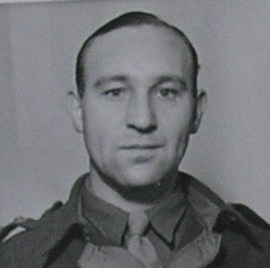
Major Harold Hall: Born 12 August 1913 in Burton-On-Trent, Hall was recruited into SOE in July 1943. He had previously been commissioned into the Sherwood Foresters before transferring to the Royal Armoured Corps. He apparently ‘tried every possible way’ to get active service, and SOE quickly assessed him as ‘From all accounts, an excellent man for operations’. So it proved.
Hall led Jedburgh team ‘Loch’ in France in August 1944, for which he was MID and awarded the Croix de Guerre. From France, Hall volunteered for service in the Far East. He was parachuted into Burma in April 1945 where he won his Military Cross on Operation Nutshell / Tiger.
Personnel file: HS 9/646/2
Captain R.R. Hamilton: served on Operation Spiers.
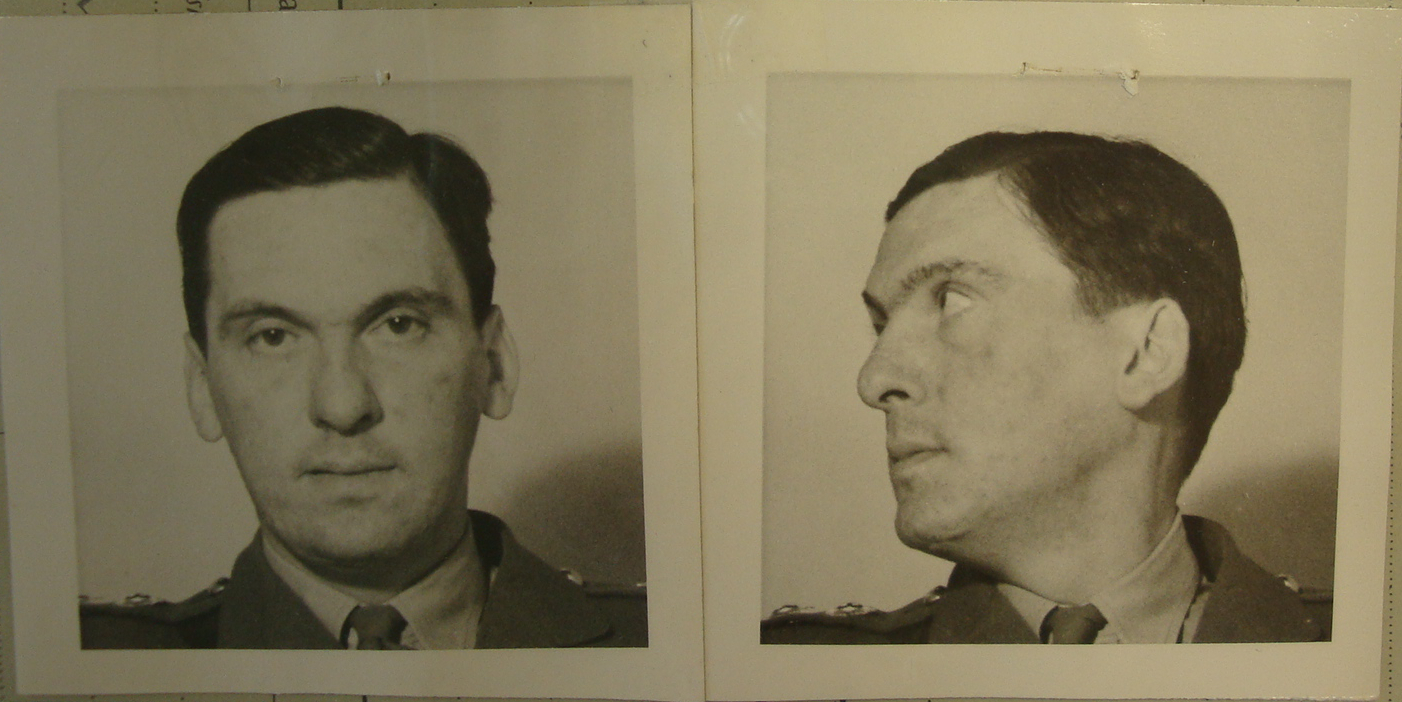
Captain Basil Sheridan Hamilton-Temple-Blackwood, 4th Marquis of Dufferin: The Marquis was killed in action in Burma on 25 March 1945. He was serving as officer commanding No.2 Indian Field Broadcasting Unit (IFBU). The IFBUs were forward propaganda units who set up loud speakers within ear-shot of the Japanese, attempting to coax them into surrendering by broadcasting to them in Japanese. Lord Dufferin was hit in the chest by Japanese fire, probably through the lung and heart. Attempts to recover his body were unsuccessful, and it was thought that the Japanese buried him.
Captain Hamilton-Temple-Blackwood was born on 6 April 1909, and educated at Eton and Oxford. Before the war, he had served as Under Secretary of State for the Colonies, 1937 to 1940. He was commissioned in the Royal Horse Guards in 1940 and then he joined SOE in September 1944. He left the UK for India in October 1944.
See @psywarorg‘s website HERE for more on SOE’s propaganda units.
For more on the Marquis and his service in Burma, see this article in ‘Standpoint‘.

Poppy photo from Flower Meaning
Personnel file: HS 9/454/9
Lance Naik Han Tin: Han Tin was a Burman born in Maymyo in 1919. He was in the Burma Sappers and Miners, recruited into SOE in October 1944. After training he was deployed on Operation Character, team Mongoose, serving under Major Lucas who reported that he was ‘reliable and conscientious’ as well as ‘Rather shy – but a first class man. Not a leader.’
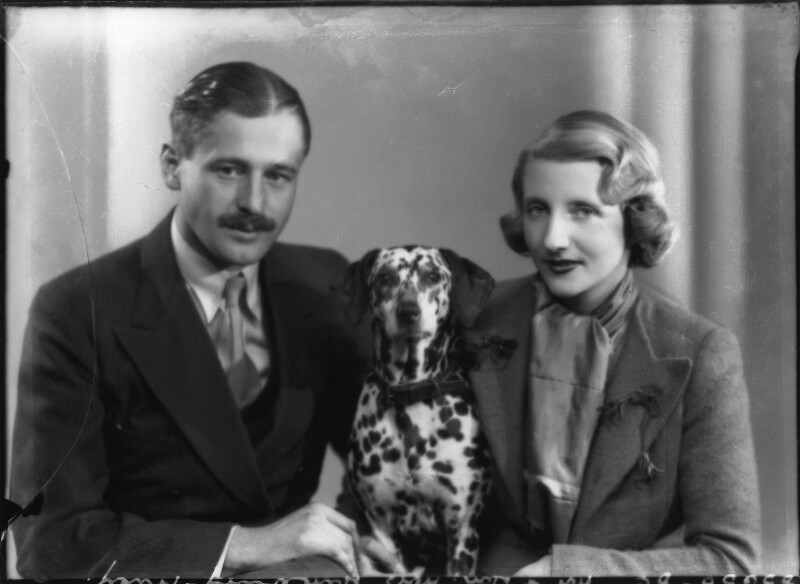
Photo reproduced under Creative Commons License from National Portrait Gallery: Hanbury-Tracy and his wife, Hon. Blanche Mary Hanbury Tracy and their dog in 1937.
Captain Ninian John Frederick Hanbury-Tracy: born in Edinburgh on 7 December 1910, Hanbury-Tracy was Assistant District Commissioner in the Sudan Political Service during 1933-1934 and was then part of the Royal Geographical Society’s expedition to Tibet in 1935-7. He then spent 1938-39 in the Andes on a botanical expedition before signing up in October 1939. From November to March 1940 here attended officer training and was commissioned into the Scots Guards with whom he saw home service until July 1941 when he was invalided out of the army.
The Indian Army re-commissioned him in February 1944, and by June he was employed as Field Staff in Burma and operational from January to April 1945. By the end of the war, he was acting as liaison officer between Force 136 and 20 Indian Division in Saigon.
Personnel file: HS 9/1480/6
Family details on The Peerage
Further biographic details from Anne Troelstra, ‘Bibliography of Natural History Travel Narratives’

Major Hugh Jocelyn Hardwick: born 3 January 1901 in Newquay, Cornwall, Hardwick worked as a tea planter from 1 January 1926, and at some point he was in the USA for three years ‘working for living’. He joined SOE in July 1942, and was sent to Kohima’s Special Weapons Training School immediately for demolitions training.
Hardwick served with the first Indian Field Broadcasting Unit in Arakan between February and May 1943, and again with 15 Corps from February to May 1944. He was awarded the MC for action against the enemy in 1944. One of his first reports, written by Lt.Col. Steer describes him thus:
‘Loyal, impulsive, attractively simple, always eager to get things done in the most straight-forward manner. Fiery temper. He is a very good polo player & first class golfer, so gets on well with regular Army type.’
He went on to command No.3 FPU during 1945.
Personnel file: HS 9/662/4
Captain Eric Jeffery Harrison: Capt. Harrison was in the RAMC, and appears to have been operational in both Malaya and Burma. He was obviously well regarded as a competent officer on operations, as his 4 page file includes the citation for an MBE pictured below. In Burma, he served on Operation Character with the Walrus team.

Personnel file: HS 9/668/6
Captain George Lloyd Harvey: born in Canada, Harvey’s file has ‘dob not known’ on the front, but a recommenation for promotion has him as 36 years old in 1945. He joined SOE retaining his Canadian Army origin as Intelligence Corps. He completed a Japanese language course in Vancouver and joined Force 136 to take command of the Language Team of the Politcal Warfare Broadcasting Unit and was posted to Rangoon in July 1945.
Personnel file: HS 9/672/1
Lieutenant Walter John Hatton: Hatton served in the Great War as a Private in the RAMC in the Dardanelles and Egypt before serving in the Royal Tank Corps in France until 1918. He finished the war as a Sergeant Instructor. He went on to become Battalion Sergeant-Major in the the Shanghai Volunteers.
When SOE found Hatton in the middle of 1941, he was working for the Asiatic Petroleum Company. He was 43 years old in 1941 when he joined SOE, and commissioned Lieutenant on 6 November 1941. He was trained at STS 101, the Oriental Mission’s guerrilla school in Singapore before being posted to Lashio in Burma where he ‘organise[d] the depot there for the Antipodes Mission to China.’
After Burma was invaded in 1942, Hatton attempted to escape to India with Captain W.D. Reeve. Reeve made it, but Hatton died on 16 June 1942 ‘owing to exhaustion and heart trouble, aggravated by under-feeding.’
‘Hatton was a capable man; useful in and out of an office; handy with weapons, and a machine-gun expert.’
Personnel file: HS 9/674/7
Naik Hay Bay, also spelt He Be: Hay Bay was a Karen from the Toungoo area, apparently born in 1928, but this is almost certainly incorrect. He was recruited by SOE on 17 October 1942 (14yrs old?) to be trained as a W/T operator. He completed signals training at Meerut in November 1942, demolitions and fieldcraft at Poona in January 1943, and then parachute training at Chaklala the same month.
Hay Bay was dropped into Burma with Saw Ba Gyaw in February 1943 as part of Operation Harlington. When Captain Nimmo was successfully dropped much later in the year, it is noted that he was Nimmo’s W/T operator. In February 1944, the Japanese attacked Nimmo’s camp. Hay Bay was able to escape, but after four days on the run he gave himself up.
On Hay Bay’s record, it is written that he was taken to Rangoon by the Japanese where he was sentenced to death with Seagrim: ‘Beheaded Rangoon Gaol 2/9/44’. If the DOB is accurate, he was just 16 years old.


Major John Duncan Halliday Hedley: born 22 December 1907, Hedley was educated at Eton and Cambridge before sailing for Burma in 1930. He was employed as a Commercial Assistant with the Bombay Burma Trading Corporation, but joined the Army soon after war was declared in 1939. He served in 4 Burma Rifles during the first Burma campaign and later took part in the second Chindit mission in 1944. Evacuated from Burma wounded, he joined SOE in July 1944.
For the rest of 1944 he trained SOE personnel in India, and then went operational himself as team Bison from January to March 1945. On 1 May, he parachuted into Burma as part of one of the SOE teams that was supporting Operation Dracula, the seaborne invasion of Burma. After a short liaison visit to London in June 1945, he returned to India where he was struck off the strength of Force 136 to join 207 Military Mission.
Hedley wrote a memoir:

Here’s his recommendation for a DSO:

Personnel file: HS 9/687/1
Captain Hemphill: medical officer (MO) with Operation Character, team Otter.
Major Denis Clive Herring: Herring was born 6 December 1916 in Parkstone, Dorset. He attended the Hailey Prep School for boys (demolished in 1973) and Queens College in Taunton before RAF College at Cranwell. He worked for the Bombay Burmah Trading Company from 1937, and was fluent in Kachin and Burmese. He was commissioned into the Army of Burma Reserve of Officers (ABRO) and served in the Burma Rifles from 1939.
Herring, inevitably nicknamed ‘Fish’, served in the first Burma campaign, was on both Chindit campaigns (winning an MC), before joining SOE in October 1944. In his own words:
‘After usual courses & numerous disappointments finally went into the field to join HEAVY (WOLF) in Feb. 45. Left the field in July ’45.’
He was MiD for his work on Operation Heavy.
Personnel file: HS 9/699/6
More on Herring’s Chindit role here
Jemadar Hka Li: A Kachin recruited in January 1943. Had served in 1 Burif.
Havildar Hkang Htang: Hkang Htang was a Kachin born in 1923 in the Lashio area. He was a ‘2nd Class Army trained W.T. Op.’ who was recruited by Major Shan Lone on 4 January 1943. After completing paramilitary and parachute training, Hkang Htang was dropped into Burma on 23 March 1943 in the Mogaung area as a W/T operator for Zau June.
In April 1943, elements of the first Chindit operation contacted Hkang Htang, and he was able to report that he was fit, but that his W/T didn’t work. He left the field in October 1944, attended a parachute refresher course and was dropped back on Operation Dilwyn on 28 December 1944 until 26 April as team Badger. In May 1945 he parachuted into Burma for a third time, on Operation Character where he joined Otter, remaining behind the lines until 18 October 1945.
Hkyet Nawng: A Kachin, born in 1914 in Myitkyina District. Recruited by SOE in October 1943 age 29.
Havildar Hla Maung: Hla Maung was a cultivator from Mawlaik District until recruited by (then) Major Peacock during P Force patrols on the Chindwin front. Hla Maung, a Burman, was trained in India and Ceylon and then dropped into Burma on Operation Character, team Otter. He was in the field from 23 February to 25 October 1945. Peacock wrote:
‘A very fine type of Burman who has done splendid work in several actions against the Japs.’
Lance Naik Hla Maung: Born in 1921 in the Tharawaady area, Hla Maung was a jeweller in civilian life. After training as a W/T operator, Hla Maung completed parachute training in March 1945, but he was deployed on Operation Character by Lysander on 11 July 1945. After serving with Mongoose, he was transferred to Giraffe on 5 October, where he ‘continued to give every satisfaction’ as a W/T operator.
Hla Shein: A Shan Burman from Myitkyina District, Hla Shein was a cultivator until recruited by SOE on 1 June 1944 aged 27. Presumably Operation Dilwyn.
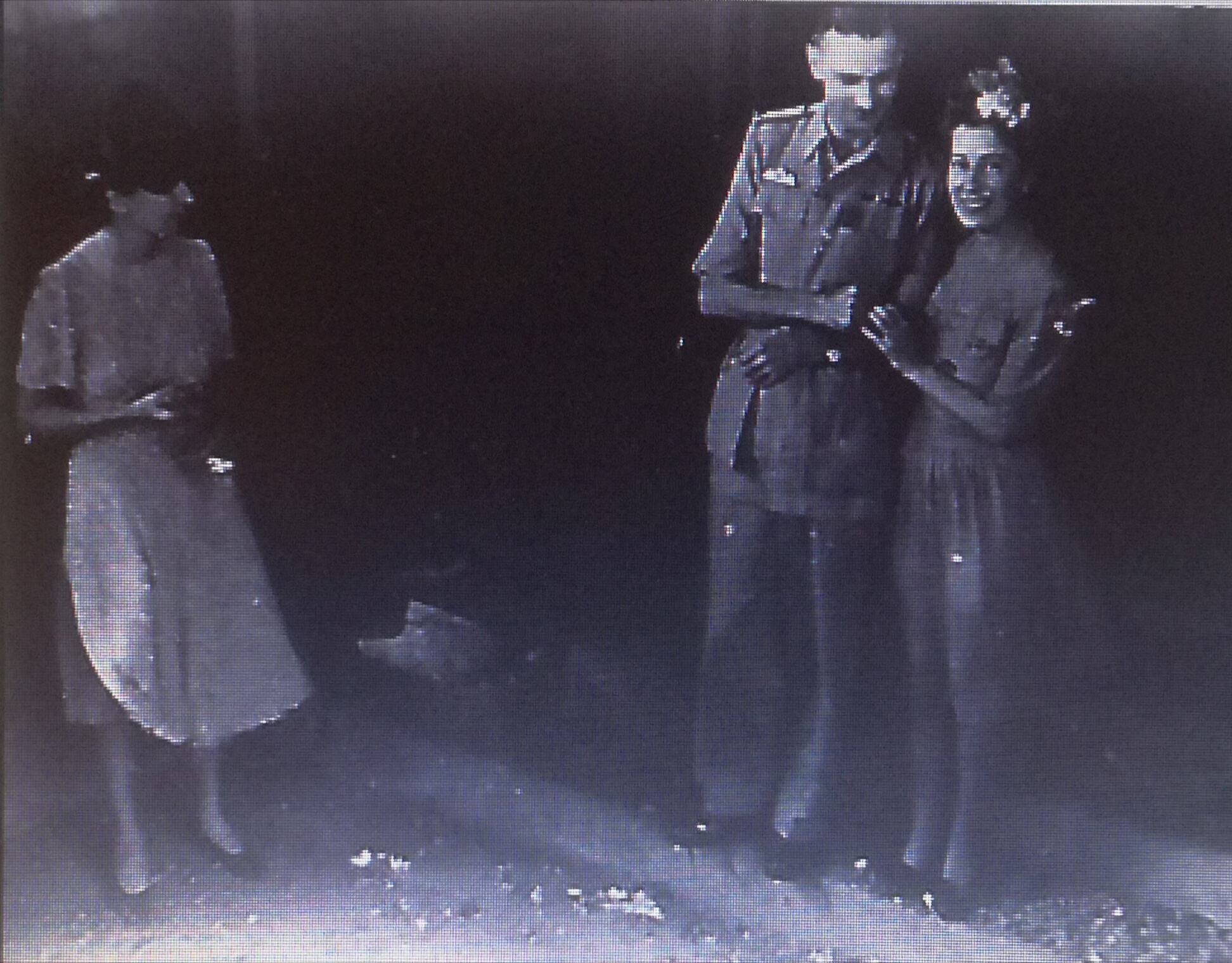
Joyce & Tom Hobbs on the steps of Rangoon Cathedral, photograph courtesy of Fergus Hobbs, their son.
Mrs Joyce Hobbs, nee Taylor: Born in London on 8 February 1917, Joyce Taylor attended Glyn Road School in Hackney 1921-28 and then North Hackney Central School from 1929-34. She worked as a secretary from leaving school, and was picked up by SOE from a Solicitors’ firm in late 1943. She expressed a desire to go overseas and so she left for India on 22 January 1944. On her SOE form she is described as 5”8 (actually 5″3) with brown hair and grey eyes, and single. She could ride and cycle, and type 75 words per minute.
She worked as a secretary for Burma Country Section (BCS) and was posted to Burma on what looks like 6 July 1945 (the hole punch is on the date!) until 16 July 1945 (just ten days?).
The war found her love, and she married Major Hobbs of Siam Country Section (SCS) on 25 (actually 20) September 1945.

She is recorded as being in Bangkok working for SCS from 26 September 1945. Her husband, Tom, also worked for SOE, in Siam. Here’s his obituary.
Joyce returned to the UK in December 1945.
Personnel file: HS 9/718/1
Tom Hobbs PF: HS 9/717/8

Lt.Col. Ernest Hugo Meggeson Hood: Born in Burnby, Yorkshire, on 27 August 1915, Hood attended Wellington College where he completed officer training in 1933. After study at Cambridge, he was then employed as Games Master and Assistant School Master at St. Dunstan’s School in Somerset from May 1937 to August 1939. Having been given a Supplementary Reserve Officer’s (SRO) commission in February 1937, Hood was posted to the Somerset Light Infantry in November 1939.
Hood applied to join SOE in 1943. During Jedburgh training in early 1944, he was classified ‘D’ – in other words, bottom grading. Potential was seen in Hood elsewhere because this classification prompted a letter to be sent recommending that he ‘be retained in training’ and Hood to be informed that he received a notification ‘sent in error due to a confusion of names.’
After operations in the Balkans were called off, Hood volunteered for operations in France. On 18 August he parachuted into France as part of Jedburgh team Paul in the Cote d’Or region. He contributed to the liberation of Dijon, and for his six weeks in France was MiD and awarded the Croix de Guerre. Hood then volunteered for operations in the Far East, and he was shipped out to India in November 1944.
After training at Ceylon, Hood was part of three operations in Burma. In January 1945 he parachuted into the Northern Shan States on Operation Dilwyn, team Cheetah. In March 1945, he dropped as part of Operation Nation, team Zebra, and then he went on to Operation Character in the Mongoose area. For his work in Burma, Hood was awarded an immediate DSO. He returned to Calcutta from operations on 4 December 1945.
Personnel file: HS 9/739/3

Sergeant Ivor Alfred Hooker: born 27 November 1923, Hooker came from Bristol. His employment during 1939 – 1941 was as a laboratory assistant before joining the Royal Armoured Corps. He was picked up by SOE in August 1943 and spent four months at STS 54. Hooker’s first operation was to France from 11 August 1944 until September as Jed team ‘Aubrey‘ in the Seine et Marne area. He then volunteered for further servce in the Far East where his second mission was to Burma. He was deployed on 27 January until 3 April 1945 as part of Operation Manual, team Fox.
Captain J.W. Houseman: Operation Character, team Hyena. Captain Houseman was designated Jed Team 32, who parachuted into Burma on 24 April 1945. The team consisted of Major Nevill, Captain Thibault and Sergeant Mason.
On 26 April, they carried out their first ambush, after which the Hyena area commander, Lt.Col. Howell, ordered the team to establish Hyena Purple. The north part of Purple was under Houseman’s command. In his Purple report, Neville wrote that Houseman had never done this kind of warfare before, and had to lead untrained men against large parties of Japs, doing ‘an absolutely first-class job.’
Major William Arthur Howe: born 2 February 1912 in Ilford, Essex, Howe worked for the Anglo-Burma Rice Company from November 1931. He was commissioned Army of Burma Reserve Officer (ABRO) on 15 March 1942. He took fought with Karen guerrillas in the first Burma campaign before marching out to India. His exploits are well covered in the book Flight by Elephant.
Officially taken on the strength of SOE in September 1942, it was not long before Howe was back in Burma. From July 1943 until April 1944 he was based at Fort Hertz, from where he sent back fortnightly reports on SOE work with the Kachin, and information about the progress of OSS operations. From April 1944, he was SOE liaison officer with the Chindits, going behind the lines with Morris Force. Post Operation Thursday, Howe went on Operation Dilwyn, the success Force 136 mission to the Kachin in northern Burma. From May 1945, he was liaison officer with 33 Corps.
In a rather lengthy citation, Howe was recommended for the OBE in recognition of his work with SOE / Force 136. He was awarded the Military Cross:

Howe stayed on in Burma after the war, eventually returning to the UK in about 1950. He died in 2005 aged 93.
Personnel File: HS 9/752/2
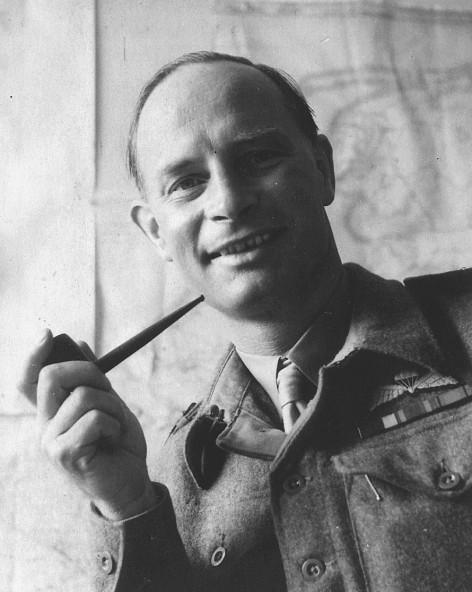
Lt.Col. Hugh Howell, photo courtesy of his son
Lt.Col. Hugh Warton Howell: Howell was born in Abbottabad on 4 October 1904. Before joining the army in 1940, he was working for the Kailan Mining Company in Tientsin, China. He was commissioned into the King George V’s Own Lancers, and was a Chindit before joining SOE in September 1944.
Howell was described by SOE as ‘A somewhat fiery character who I think would do well in an operational capacity.’ He was subsequently placed in command of Hyena area of Operation Character, for which he was awarded the DSO.
Personnel file: HS 9/752/5
Hpau de Brang: A Kachin from the Myitkyina District, Hpau de Brang joined SOE on 1 March 1943 aged 32.
Naik Hpau Jung La: Born 10 November 1916, Hpau Jung La is recorded as being ex Burma Army Signals. He joined SOE’s Operation Spiers in the field on 15 August 1944. He came out to India from Spiers on 2 October 1944, and after completing training was deployed on Dilwyn on 27 January until 22 September 1945. Lt.Col. Crosby wrote:
‘Very good disciplinarian, as well as a good scrapper.’
Hpau Lu Yaw: A Kachin who joined SOE age 19. No further details.
Naik Hpau Yu Gam: Hpau Yu Gam joined the Burma Frontier Force in 1937, age 19, which makes his DOB 1918 rather than 1921 as recorded. He was a W/T operator. In 1942, he remained in Burma rather than retreat to India. He was recruited in the field by SOE on 16 September 1944. After arriving in Calcutta in October, Hpau Yu Gam completed parachute instruction at Chaklala and paramilitary training at the Eastern Warfare School.
On 20 February 1945 he was deployed on Operation Heavy, team Wolf, remaining in the field until 16 October. Major Pennell reported that Hpau Yu Gam was ‘Excellent – Possess [sic] initiative and is thoroughly trustworthy – would make a good regular soldier.’
Naik Hpaw Myang La: Born in 1909, Hpaw Myang La was a Kachin who was recruited by SOE in March 1944. After parachute training at Jessore during March-April, Hpaw Myang La was deployed on Operation Heavy, team Wolf, from 6 April to 19 October 1945.
‘Trustworthy and reliable, good on patrol work.’
Hrang Aung, alias Johnny: A Chin who had been a signaller in the Burma Frontier Force. Deployed on Operation Spiers 5 May to 10 September 1944 with Htang Kong.
Signalman Hsi Tai: Hsi Tai was born in 1924. He was a Karen from the Bassein area of Burma. He was recruited by SOE on 17 October 1942. In the first months of 1943, Hsi Tai completed a W/T course, as well as his paramilitary and parachute courses. He was part of the team that was supposed to be dropped after Ba Gyaw in February on Operation Harlington, but for various reasons the teams which included Majors Nimmo and McCrindle were not successfully deployed until October and December 1943 respectively.
After parachuting into Burma in December with McCrindle, Hsi Tai was McCrindle’s W/T operator until the Japanese attacked their camp. Hsi Tai and his friend, Saw Aaron, were able to escape into the jungle where they hid for some months, looked after by friendly Karen villagers. In February 1945, Hsi Tai joined team Hyena of Operation Character, although he was ill with malaria by this time. He remained in the field with Hyena until approximately 18 September 1945.
Htait Tin Aung, alias Maung Gale: A Burman from the Arakan region, specifically Akyab, Htait Tin Aung was recruited into SOE on 4 August 1944 after he reported to V Force at Ruma. In October and November he completed parachute training at both Chaklala and Jessore, unusually.
Also unusually, the following is recorded: Htait Tin Aung was ‘slightly pro-British’ therefore his Burmese friends did not consider him an ‘entirely suitable companion’. The record continues: ‘Consequently, he will probably be sent back alone, after special training, to commit a nice murder, for which he has shown a marked preference’.
If he did go back alone and commit a nice murder is not recorded, but Htait Tin Aung was parachuted into Arakan as part of Billet, team Hound from November 1944 to February 1945, and then as team Zebra from 31 March 1945. Major Hood, Zebra’s officer commanding, wrote that Htait Tin Aung ‘Was a great disappointment.’
Htang Kong: A Chin who had been a signaller in the Burma Frontier Force. Deployed on Operation Spiers 5 May to 10 September 1944 with Hrang Aung.

Htin Nu Kaung: A Kachin cultivator from Myitkyina District born in 1908, Htin Nu Kaung apparently joined SOE on 1 June 1944. Another record, where his name is spelt Tin Nu Kaung – which verifies it is the same man by Army Number 1037 – has him recruited in ‘summer 1943’ and born in 1907. The record has his signature spelling his name with an ‘H’.
He was trained and deployed as Operation Nutshell team Antelope in March 1945, but he landed the wrong side of the River Salween and ambushed by the Japanese. He fled north and ended up with Operation Character’s Walrus team from June until the end of the war.

Major Arthur John Hunter: Hunter was born in Selangor, Malaya 30 June 1912. From 1933 to 1942, he was employed as a rubber planter by Scottish Malayan Estates Ltd. He served with the Malay Volunteer Forces for nine years, and after the war with Japan began he fought on the retreat down to Singapore.
After Singapore fell, Hunter escaped by fishing boat and made safe landing in Ceylon after a month in Java. He was then trained in guerrilla warfare in Saugor, India, but the O/C, Le Seeleur wrote a poor report on his performance. It was recognised that Hunter had ‘plenty of courage and determination, but [that he] may be somewhat lacking in brains and foresight.’ This does not seem to have been taken too seriously by other officers though, and was put down to his ‘extreme boisterousness’.
Although earmarked for Malayan operations, Hunter was loaned to Burma Country Section. He was parachuted into the Kokang area of Burma, near the Chinese border, on an operation code-named Spiers. Between May 1944 and January 1945, Hunter proved ‘An excellent operational officer’ and won an MBE for his part in this operation.
After Burma, there was a short period of leave in the UK before Hunter was dropped on Operation Galvanise in Malaya. Again performing admirably, Hunter was recommended for the MC. Not bad for a man ‘lacking brains and foresight’ and described as a ‘Hislop type in appearance’ with an ‘unmilitary manner’!
Personnel file: HS 9/766/4
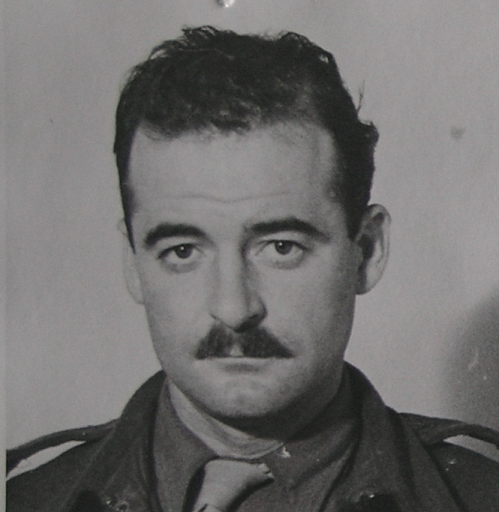
Major Cameron Bentley Hunter: born Montreal, Canada, 19 April 1916, Hunter joined the Army in 1939. He served with the Royal Artillery in a Light Anti-Aircraft unit, and was commissioned in July 1942. From December 1940 until April 1944, he was in the Middle East.
It would seem SOE took him on in July 1944, and a first operation was into France from 12 August until about 6 October. Hunter was second-in-command of a British Military Mission in Savoy, where he won the MC for his leadership and fighting with the Maquis from 15 August.
After France, Hunter went out to the Far East where he deployed in Burma with Operation Dilwyn, team Bear, from 5 March 1945. He was again recommended for the MC, and was duly awarded the Bar for his MC won in France:

Personnel file: HS 9/767/1
In Dau Chan: A Kachin recruited in July 1944 age 28, In Dau Chan was from the Lashio area.
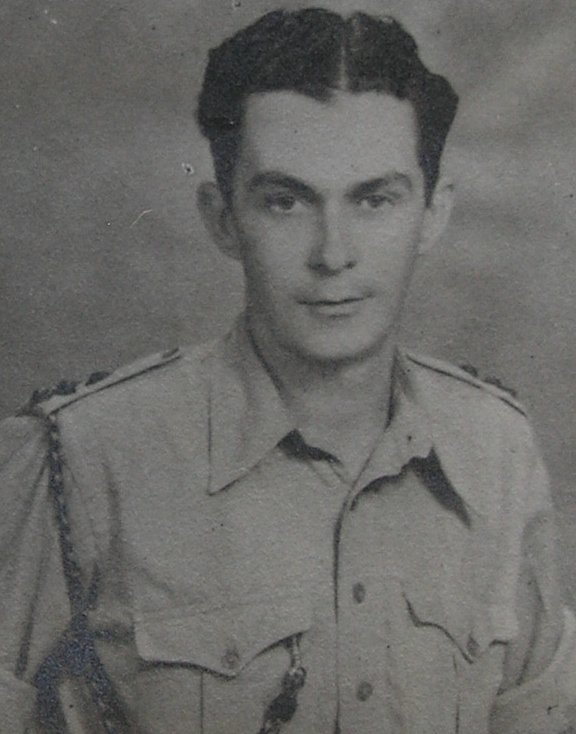
Major Donald Arthur Thomas James: born 21 October 1918 in Bombay, James completed a four year structural engineering apprenticeship in 1939. He was fluent in Hindustani and Gurkhali, with good Urdu and a working knowledge of Marathi. He received an emergency commision into 7th Gurkha Rifles in December 1940, with whom he was stationed in the Punjab until May 1941. After five months on the North West Frontier Province, he returned to the Punjab in December 1941 before being sent to Rangoon. At the end of January 1942 he was sent to Bangalore to fill an instructor vacancy, and he remained at the OCTU until July 1943 when he joined SOE.
With SOE, James played an ‘invaluable’ part in the establishment of the Indian Field Broadcasting Units (IFBUs) from mid 1943, despite reorts describing him as ‘A bit young’ and ‘inclined to irritate people’. Despite this, he is also described as ‘socially popular’ and ‘very capable at training men’. He remained employed with SOE until January 1946.
Personnel file: HS 9/787/2
_____________________________________

Photo Credit: The excellent Chindit Chasing website, where there is a whole page about Harold’s time with the Chindits. See Chinditslongcloth1943
Captain Harold Douglas James: born Bombay 2 September 1923, James was educated at the Bishop’s High School in Poona. He was fluent in Gurkhali and Urdu. He was commissioned into the 8th Gurkha Rifles in October 1942 and served on the first Chindit operation in 1943 with 3/2 Gurkhas. He won the MC with the Chindits.
From July to December 1943 he was with 3/6 Gurkhas, part of 77 Indian Infantry Brigade. Back with 8th Gurkhas from January 1944, James completed a company weapons course during march and April 1944 at Saugor. In May 1944, he was promoted to Temporary Captain and made a patrol officer with the Indian Field Broadcasting UNits (IFBUs) having joined SOE.
Posted to No.3 FPU (Field Propaganda Unit), James was in command of a patrol unit and served in the Arakan.
A confidential report for the half year eding June 1945 said he was an ‘efficient infantry officer’, with his command of languages making him ‘valuable with Indian troops.’ He apparetly had a ‘somewhat negative personality but [was] conscientious and hardworking.’
Personnel file: HS 9/787/4
Major Henry Morrison James: born 4 July 1915, James was schooled in Derbyshire before reading Tropical Agriculture in Trinidad from 1932 to 1936. He then worked for the colonial service until the war started. James served with the Cyprus Regiment, gaining his commission on 8 March 1940. He saw action in the Western Desert between August 1940 and March 1941, for which he was MiD. He was part of the ill-fated Greek and Crete campaigns before going back to the Western Desert between June 1941 and August 1942.
After joining SOE, completing parachute and paramilitary training, he was dropped into the Peloponnesus region of Greece from August until October 1943. He raided the Argos aerodrome, blowing up five aircraft. He then commanded Operation Staircase from June 1944, a joint operation with eleven Americans. After this, he volunteered for the Far East, leaving in August 1944. James won the MC for his work with Force 133.
On 23 January 1945, Major James was deployed on Operation Manual, team Rhino, in the Arakan region of Burma.
Personnel file: HS 9/787/5
Subedar Jangma Naw: Jangma Naw was a Kachin born in 1909 in Bhamo District. He joined the Burma Rifles in 1928, serving in A Company, 2 Burif. He was an early recruit to SOE, joining the original Oriental Mission in January 1942.
Sergeant George Jenkins: George Jenkins was born and lived in Toxteth, Liverpool 8. In 1940 he joined No. 8 (Guards) commando. No 8 Commando were one of the units selected to be sent to the Middle East as part of Layforce in February 1941. He remained with No 8 Commando, around the area of Tobruk, until they were disbanded in August 1941. When the unit was disbanded he joined the Special Operations Executive, specialising in demolitions. In July 1943 he was infiltrated by parachute into Albania as part of Force 399. He, and Major D. de C Smiley, undertook the task of blowing the Gjoles Bridge in April 1944, for which he was awarded the MIlitary Medal. After returning from Albania, he joined Force 136 in Burma (Operation Character, Team Otter) on 22 August 1945. Upon his return from Burma he returned to Toxteth, Liverpool 8.
Information and photo supplied by George’s Great Nephew, Dave Jenkins.
No personel file exits for Sgt Jenkins.
Major Leonard John Bowyer Johnson: born 23 November 1917 in Southampton, Johnson was Chief Instructor at Fagu training camp. Fagu was the base of the Indian Field Broadcasting Units (IFBU). It is not clear whether he served in Burma with SOE, which he joined in August 1944, but having volunteered for India and transferring to the Recce Corps he definitely served in the country at some point. Originally commissioned in 1938, before the Recce Corps, Johnson had been in the Somerset Light Infantry and 1st Gurkha Rifles. He was described as ‘a hardworking officer who has done much to prepare IFBU teams for the field.’
Personnel file: HS 9/803/3
Kai Do Pau: A Chin who served in 2 Burif according to CWGC, Kai Do Pau was deployed on Operation Label, team Rat on 22 January 1945. He was killed in an ambush on 8 February when what was left of the team tried to escape back to British lines. He was with Havildar Lian Za Khai’s escape party. Both British officers in command of this operation were also killed (Captain Meredith and Major Smyth).
Lance Naik Kan Aye Maung: Kan Aye Maung was a Karen from Myaungmya in the Delta area of southern Burma. Born in 1922, he joined the Burma Rifles in 1940, serving in 2 Burif. Between June 1942 and December 1943, he was in the Chin Hills on the Indo-Burmese border. He was recruited by SOE in October 1943, and was working in the Chindwin area between March and May 1944. He was most likely with P Force during this time.
Kan Aye Maung was parachute trained in November 1944, and then deployed on Operation Bottom from 2 December to 31 January 1945. This operation was based in the Chin Hills with the aim of gathering intelligence on the Pakkoku – Gangaw Road, and to harass the Japanese line of communication. The war diary has the date of 26 December for deployment of this operation.
Kan Aye Maung’s record shows that he was Returned to Unit (RTU’d) to the Burma Regiment Centre at Hoshiapur on 5 April 1945.
Honorary Lieutenant Kan Choke (also Kan Kyauk): Born about 1899, Kan Choke was a Pwo Karen who served in the Burma Rifles for most of his life. At the outbreak of the Second World War he held the rank of Subedar Major, which was the senior commissioned rank in the Indian Army for non-Europeans.
Kan Choke served with Captain Arthur Thompson (see below) in 1st Battalion Burma Rifles, and was therefore part of the fighting retreat down the Toungoo to Mawchi Road in 1942. In his book ‘Desperate Journey’, Thompson introduced Kan Choke as:
‘a grand old warrior […] who had risen to the peak of his profession and had more years of service than I care to remember. During the fighting he had been an inspiration to all ranks, and throughout the coming months he was to prove himself a great-hearted companion. He had been to England for the Coronation in 1937 and this country had no more devoted an admirer.’
After escaping to to India by August 1942, Kan Choke was officially recruited into SOE in November 1942. His training record shows that he received paramilitary instruction at the Eastern Warfare School (India) and parachute training in early 1943 at Chaklala. He then helped to train the Harlington team due to be parachuted into the Karen Hills to work with Major Seagrim.
In March 1945 he was parachuted into Burma on Operation Character as part of Lt.Col. Tulloch’s Walrus Special Group. Kan Choke was in charge of training 350 Karen levies, ‘a task which he carried out incredibly well’.
When the Japanese made a concerted attack on the Walrus headquarters at Dawrahku, Kan Choke ‘calmly stood amid mortar and LMG fire supervising and encouraging […] levies.’ For this, Kan Choke was awarded the Military Cross. He also won the Burma Gallantry Medal for his services with Force 136
There is no Personnel File for Kan Choke.
Many of the names appearing on this page, including Kan Choke’ MC, are awards to the men of SOE Burma.
Kan Hto: A Burman cultivator born in 1920, Kan Hto was recruited by Peacock’s P Force on 15 February 1944. After P Force was withdrawn, Kan Hto completed training in demolitions and jungle warfare, as well as parachute instruction. He was parachuted into Burma on 20 February 1945 as part of Operation Character, team Hyena. He remained in the field until 20 October. A short statement about Kan Hto says he ‘was present at many ACTIONS and AMBUSHES against the Jap.’
Havildar, possibly Jemadar Kan Tha: Kan Tha was a Burman born in Shwebo in 1910. He was serving with the Burma Sappers and Miners when he was recruited by SOE on 10 October 1944. On 26 March 1945 he was dropped into Burma as part of the Special Group for Operation Character, team Mongoose, serving under Major Lucas in area Blue.
In his role as interpreter and in charge of supply drops, Major Lucas described Kan Tha as ‘absolutely invaluable to me’, he ‘led his group of Sappers and Miners with outstanding success both in training and in Ops.’ Further, Lucas reported that he had ‘a large measure of wisdom and tact.’ Lucas wanted to make sure that Kan Tha received promotion to Jemadar which had been promised upon recruitment to SOE, but it is not known if he did. Kan Tha left the field on 10 October 1945.
Kareng La: A Kachin from Myitkyina District, recruited on 1 December 1942 aged 20.
Kareng Naw: A Kachin from Myitkyina District, recruited on 1 October 1943 aged 19.
Kareng Tu: Born in 1923 and recruited in the field during September 1944 by the Spiers team. Kareng Tu was brought out to India, arriving in Calcutta on 3 October. After completing training he was deployed under Major Pennell on Operation Heavy, team Wolf, area Red. In the field from 20 February until 16 October 1945, Pennell described Kareng Tu as ‘Trustworthy – patrol work excellent’.
Havildar Kaung Tan: A Kachin from Lashio District, Kaung Tan served with the Burma Signals before joining SOE.
Kare Tu: A Kachin recruited on 16 September 1944, aged 18.
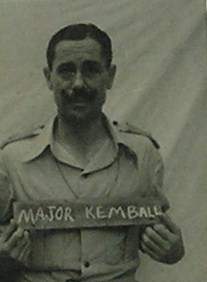
Major Arnold Vero Shaw Gerard Kemball: born 3 March 1906 in Rajputana, India, Kemball was schooled at Charter House and attended the Royal Military Academy at Woolwich in 1925-6. He was commissioned and spent three years in the Army.
It appears that Kemball then worked the next twelve years with the Kailan Mining Company in China, before starting war service in September 1941. It appears his wife remained in China as she is recorded as being in Weihsien concentration camp in China on his SOE Record of Service. Ron Bridges FEPOW website confirms both wife and daughter were interned in Weihsien.
Kemball joined SOE on 11 December 1942. He attended training at the Eastern Warfare School, India (EWS(I)), and was then an instructor until deployed on Operation Spiers. After a spell as Liaison Officer with IV Corps, he was then a Staff Officer (GSO II) with the HQ of Group A. From 25 January to 21 April 1945, he was deployed in Burma once again, this time with Operation Manual, team Mouse. He was ‘struck of strength’ (SOS) of Force 136 in February or March 1946. See here for more on that operation.
On one of his confidential officer reports it is written:
‘A cheerful and popular officer who is conscientious and capable except for occasional lapses when he goes on the spree.’
Personnel file: HS 9/827/8
Lt.Col. Edgar James Kennedy: Kennedy was another of the men killed when Dakota ‘J’ for Jig crashed in the Karen Hills in September 1945 when en route to Calcutta from Rangoon via dropping supplies to Operation Character.
Kennedy was born on 31 May 1901 in Layer-de-la-Haye near Colchester in Essex. His life was seemingly a full and varied one, based on the following:
1914 – 1916 – Royal Naval College
1916 – 1919 – Royal Navy (Bermuda, Middle East, India)
1919 – 1920 – Royal Air Force
1920 – 1922 – Special Enlistment in the Royal Signals
1922 – 1924 – Army and Royal Ulster Constabulary
1924 – 1928 – Merchant Navy (dates of 1925 – 1930 also offered in his file)
1927 – Army Reserve Royal Signals
1930 – 1936 – Doncaster Technical College, read Electrical Engineering
Employed by Western Electrical Company
1939 – 1942 – Royal Signals with 1st and 2nd Armies and later Training Battalion
1942 – 1945 – Special Operations Executive. OBE awarded for work with Force 399 in Cairo. Left Cairo October 1944 for some home leave before posting to India in November 1944. Commandant of ME 9, Force 136’s Signals training school.
Personnel File: HS 9/830/7
Jemadar Kha Li Maran: Kha Li Maran was a Kachin who joined the Burma Rifles in April 1937, aged 24. He fought in the first Burma campaign and then joined SOE on 20 January 1943. By March, he had completed para military and parachute training and was dropped into Burma on 23 March on Operation Dilwyn. This first stint of operational duty finished on 22 July 1943.
On 11 October 1943 he was returned to the field, still on Operation Dilwyn, and stayed in the jungle until 17 June 1944. For his efforts on Dilwyn, Kha Li Maran was awarded the Burma Gallantry Medal on 17 December 1943.
After a refresher parachute course at Chaklala, Kha Li Maran was dropped once again into Burma on 28 December 1944. This operation was still Dilwyn, but in an area slightly further east of his previous area of operations, and code-named Squirrel. He remained in the field until 28 September 1945.
Major Shan Lone described Kha Li Maran as ‘Brave and tough. Security minded. Reliable. Not very intelligent. Good asset.’ Lt. Col. Crosby described him as a ‘First class man in a scrap. A rough, fighting type.’
There is no personnel file for Kha Li Maran. Information from his Training Card.
Lance Naik Subdar Khan: Subdar Khan was an Indian policeman in Myingyan area of Burma. It seems he retreated from Burma in 1942, and was then recruited by SOE on 1 February 1943. He was trained during 1943 and then dropped into Burma by parachute on 13 October 1943 as Operation Mahout. See blog post HERE.
Havildar Khawng Dau: A Kachin born in 1922, Khawng Dau joined the 1st Battalion the Burma Rifles in January 1940. After fighting in the first Burma campaign, he stayed in Burma from May 1942. He was recruited by Captain Kumje Tawng, but the chronology on his record doesn’t quite make sense. It mentions he was ‘Dilwyn area’ January to May 1945, recruited in Calcutta on 7 March 1945, and deployed on Operation Heavy team Lynx from 28 March to 19 October 1945. On 3 November 1945, Major Shaw wrote that Khawng Dau was a ‘[s]teady hardworking and loyal N.C.O.
Khin Zaw: A Burman born in 1918, Khin Zaw was a student recruited by Major Battersby in calcutta during January 1944. After completing training at Jessore and the School of Eastern Interpreters (SEI) at Barrackpore, Khin Zaw was parachuted into Burma as an agent on the 30 March 1944, remaining in the field until 20 July 1945. His operation was code-named Rabbit and his drop zone was east of Thaton. Since Rabbit was part of the Nation series of operations, it is likely that the dates recorded are inaccurate and that he was recruited and deployed in 1945, not 1944.
Lance Naik Khual Ko Zam: Khual Ko Zam, a Chin, was deployed on Operation Label team Rat on 22 January 1945. He was part of Jemadar Chin Pau’s party which escaped to Allied lines by 28 March.
Lance Naik Khual Koon: A Chin who was deployed with Label, team Rat on 22 January 1945. Khual Koon was killed on 8 February when his party was ambushed trying to escape to Allied lines: ‘L/Nk. KHAUL KOON was shot through the head.’
King Li Sheng: Very few details for King Li Sheng. Employed by SOE as an interpreter for Operation Spiers. This operation was to the Kokang area of Burma. King Li Sheng spent 18 days in the field (23/8/44 – 10/9/44), and then apparently ‘RESIGNED’. He was paid off on 30 September 1944 in Kunming.
Thakin Ko Ko Gyi, alias Ye Nyunt: Ko Ko Gyi was a Burman nationalist, hence the word Thakin before his name. He was born in 1918, the son of a merchant. Ko Ko Gyi was contacted in December 1944 by a Force 136 agent whose mission was code-named Pedantic. Pedantic had been tasked with contacting Ko Ko Gyi in the town of Shwegu because it was known that he was ‘anti-Japanese but not necessarily pro-British’, meaning he might be receptive to a message from Thakin Thein Pe. Thein Pe had trekked out to India in 1942, hoping the British could be convinced to work with him and other nationalists who were already disillusioned with the Japanese.
Ko Ko Gyi decided to go back to India with Pedantic where he was, presumably, parachute trained before being dropped into the Mandalay area with Tin Shwe as part of Operation Grain, Elephant. Successfully infiltrated on 2 January 1945, team Elephant was tasked with getting the Burma National Army and the Anti-Fascist Organisation to turn on the Japanese (or at least not fight the British) in the Mandalay area, thus facilitating the capture of the city by XIV Army. Team Elephant was successful; the Army overran the agents by 15 March 1945, and took Mandalay by 20 March.
There is no personnel file for Ko Ko Gyi.
Jemadar Kolu Ban: Kolu Ban was a Chin born in Haka in 1917. He joined the Burma Army Signals in February 1939 so by the time SOE recruited him in India in October 1942, he had over two years experience as a W/T operator.
From January to July 1943, Kolu Ban completed SOE signals training at Meerut, as well as demolitions, fieldcraft, weapons, principles of intelligence, and parachute training preparatory to deployment on Operation Eyemouth. Since this operation was cancelled, he went trekking in Darjeeling with a W/T, completed yet more training at Meerut, and then went testing a midget W/T in the Imphal area. He was then posted to Tamu on the Chindwin front where he served under (then) Captain Peacock. On 8 September he was found guilty and charged with ‘drunkenness’, but received a ‘[v]erbal reprimand only on account of previous good record.’
On 6 June 1944, Kolu Ban was deployed on Operation Heavy, team Wolf, remaining in the field until 5 March 1945 when he came out on leave. He returned to Wolf from 6 April 1945 until 18 October 1945. Kolu Ban was recommended for MiD for his work on this operation.
Major Pennell: ‘Has done extremely good work, both as W/T operator and also as a leader of outposts. But off duty he spoils this by heavy drinking.’
Kuan: Recruited as an interpreter for Operation Spiers. Only the name ‘Kuan’ features on the record. Most likely Chinese.
Naik Kum Bu Gaung: Kum Bu Gaung was a Kachin born on 1 February 1928 according to his training card. He was recruited ‘in the field’ in October 1943 as an agent for work on Operation Dilwyn. He was extracted from Burma in June 1944 to complete training in India before being parachuted back into Northern Burma on the next phase of Dilwyn operations, serving with teams Squirrel and Bear. His time on this operation lasted eight months from January to September, and it was during this time that he was promoted twice, up to Naik, by age of 17 (if his DOB is correct).
Lt.Col Crosby wrote of Kum Bu Gaung: ‘Recommended for the BGM. First class little chap, absolutely mad on scrapping. Very reliable.’
Naik Kum Jaung: Kum Jaung was a Kachin, born on 1 June 1927. If this is an accurate DOB, he was recruited by SOE just after his 16th birthday on 1 October 1943. He was 5′ 0″ tall and shoes were a size 6.
He was recruited in the field by Major Shan Lone as an ‘Agent’, and remained in the field until 20 June 1944. Extracted to India for training, Kum Jaung completed parachute and paramilitary courses between October and December 1944 before dropping into Burma to continue Dilwyn operations with team Bear. This phase of operations lasted from 27 January to 22 September 1945.
During August 1945, Kum Jaung was shot in the side, but continued fighting ‘kill[ing] 3 Japs with his Carbine.’ Hospitalised in Loilem, Kum Jaung rejoined his team once recovered. He was Mentioned In Dispatches (MiD) for his efforts.
Lance Naik Kum Je La: Kum Je La was a Kachin, date of birth 6 January 1923. He was recruited in the field on 15 August 1944 to be an ‘Agent’ by the Spiers team in the Kokang area of Burma. His next of kin is recorded as his brother, Kum Je Tu, with his father added in pen later: Kum Je Yaw, Loilem, Kutkai, N.Hsenwi.
After leaving Operation Spiers in October, in November 1944 he completed parachute instruction, and by December he had finished the Paramilitary course run at Eastern Warfare School, India (EWS(I). Kum Je La then parachuted into Burma on 27 January 1945 with Lt.Col. Crosby as part of Operation Dilwyn, team Bear. Crosby described him as ‘A good tough bloke’ followed by ‘For action only.’

Picture Credit: John Wright, Q&C Militaria
Captain Kumje Tawng Wah: A sizeable entry exists for Captain Kumje Tawng Wah here. There are some differences in details, such as DOB September 1914 versus 1924 on one National Archives record and 1918 on another. It is also quoted that he parachuted into Burma 14 times, but 3 is the more likely number.
Kumje Tawng Wah is recorded as joining SOE on 3 December 1942. In January and February 1943 he completed Paramilitary and parachute training in India. He was one of SOE’s first men back into Burma, parachuting into the Kachin Hills on Operation Dilwyn on 23 February 1943. He remained in the field until 21 June 1944, when most of the Dilwyn personnel were extracted due to fractious relations with the OSS. It was during this period of operations that he assisted Dahforce, a Chindit mission.
In September 1944, he attended a refresher parachute course and returned to operations on 28 November 1944, again as part of Dilwyn, in charge of team Monkey. They landed in the middle of a battle between Kachin and Chinese forces. Extracted on 7 March 1945, Kumje Tawng Wah parachuted into the Southern Shan States as part of Operation Heavy, team Lynx on 28 March 1945, remaining operational until 19 October 1945.
Awarded the Burma Gallantry Medal and the Military Cross.
Personnel file: HS 9/868/8
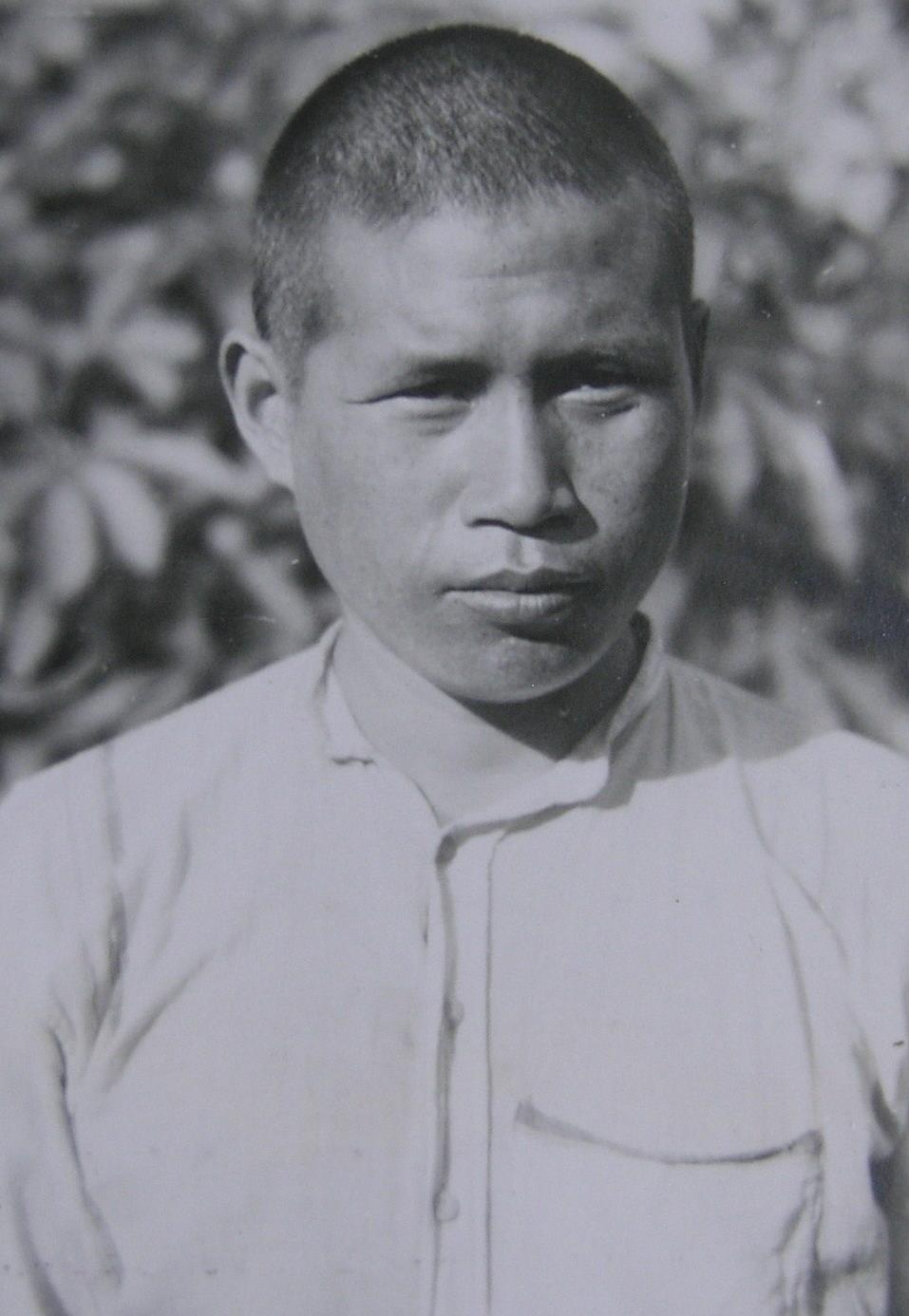
Kya Aye: Kya Aye was a Shan Burman from the Myitkyina district. He was recruited by SOE on 1 June 1944, age 36. In civilian life he was a cultivator.
Jemadar Kyaing Galay: Born 1 March 1914, Kyaing Galay was a Sgaw Karen who served in the Burma Military Police from 1934. Recruited into SOE on 20 January 1943, Kyaing Galay completed three operations with Force 136. His first was Dilwyn, from 5 March 1944 to 20 June 1944; on 25 November 1944 he was parachuted into Burma on Operation Rendezvous, until 14 January 1945; lastly, a third parachute deployment on Operation Burglar on the night of 25 January put him in the field until 13 May 1945. He was posted to the Burma Regimental Centre, Hoshiapur, on 17 July 1945.
Havildar Kyaw Hain: A Burman born in Minya in 1926, Kyaw Hain would have been seventeen when he joined SOE in 1943. He was recruited by Lt.Col. Peacock, and first participated in patrols with P Force before completing training in India and Ceylon. On 23 February 1945, Kyaw Hain parachuted into Burma, continuing to serve under Peacock on Operation Character, team Otter. Peacock wrote:
‘Fully trained, and a good demolitionist. A Burman. Good type. Served in many actions against the Japs.’
Kyaw Hla: Parachuted into Burma on 20 March 1945 on Operation Nutshell, team Antelope. Major Abbey, officer commanding wrote:
‘Entered the field with me in March and was separated on the 2nd April. Moved north with MAUNG MU and his party who states that a few days after leaving me they bumped into some Japs. A few shots were exchanged after which they discovered the [sic] KYAW HLA was missing. There is every likely hood that he was killed. Very quiet and not very intelligent.’

Lance Naik Kyaw Hoe: A cultivator born in 1922, Kyaw Hoe was a Burman from the Chindwin area. He was recruited by Kan Choke on 1 June 1944. After training in India and Ceylon, Kyaw Doe was parachuted into Burma on 24 February serving under Major Poles in the Ferret area of Operation Character. He remained in the field until 22 October 1945.
Kyaw Myint: Recruited by Lt.Col. Peacock on 15 February 1944 during P Force patrols, Kyaw Myint was a cultivator from the Upper Chindwin area. Kyaw Myint completed parachute and demolitions training prior to being dropped into Burma on 20 February 1945 as part of the Hyena team of Operation Character. Major Turrall wrote:
‘Parachuted in BLIND at PYAGAWPU. Had v. greatly increased command at landing, namely it fell to him to help train recruited levies that for HYENA – later becoming HYENA RED – amounted to 795. Was present at many ACTIONS and AMBUSHES, against the Jap. Fought on in MAY and JUNE etc in monsoon rain, leeches, no cape, no ground sheets, no hammock, no milk, sugar tea, no boots: and this uncomplainingly. Exfiltrated from “field” to RANGOON 20 OCT 45.’
Kyaw Ohn: A Burman born in Moulmein in 1921, Kyaw Ohn had completed seven years Army service by 1945. He was recruited by SOE in October 1944 from the Burma Sappers and Miners. After training at Chaklala and ME 25, Kyaw Ohn parachuted into Burma on 24 March 1945. He was part of Operation Character, team Walrus until 22 October 1945. Unusually, his record suggests he was debriefed. Kyaw Ohn apparently had ‘no criticism of treatment in the field or suggestion to make. Would like to join the SURVEY Dept in MOULMEIN’.
Kyaw Seine: A Shan-Burman cultivator from Katha District, Kyaw Seine completed training at Chaklala and ME 25 in Ceylon between August and December 1944. He then parachuted into southern Burma as part of the Nutshell, Antelope team. In the field from 20 March to 5 October 1945, Major Abbey reported that he had ‘[o]n one or two occasions proved himself to be brave.’ He was also, apparently, ‘inclined to be lazy.’
Major Kyaw Thu: A Karen schoolmaster in civilian life, Kyaw Thu was born in Bassein on 16 December 1907. Kyaw Thu seems to have had an interesting war, serving with the North Kachin Levies for nearly two years from late 1942 to late 1944; next he served with the OSS from November 1944 to July 1945; SOE recruited him in July 1945 and he was sent into Operation Character to take over command of Otter White from F/Lt. Breen, until 23 October 1945.

Havildar Kyaw Yin: Recruited by SOE on 1 March 1943, Kyaw Yin was approximately 19 years old when he completed demolitions, fieldcraft and weapon training courses at Poona. From mid to late 1943, Kyaw Yin was in the Tamu area, and then part of P Force on the Chindwin Front. During 1944, he completed more training preparatory to parachuting into Burma on Operation Character as part of Major Poles’ Ferret Special Group. He was in the field from 24 February to 22 October 1945. Recommended for an award for bravery, Major Poles wrote:
‘Not very quick witted, but has proved himself capable and brave. His individual coolness and courage in action is known throughout these hills.’
Lt.Col. Peacock wrote:
‘Slow and not very bright, but definitely brave and will stay put and stand a lot of knocking about. A very likeable boy.’
Awarded the Burma Gallantry Medal (BGM)
Kyaw Zaw, alias Maung San Oung: Recruited in the Arakan in August 1944, Kyaw Zaw was sent back behind the lines within sixteen days. He was one of the early Billet agents, paired with Tun Gyaw to go and train others in anti-Japanese propaganda activities.
La Hpai Shwang Kyn: A Kachin born in 1918, La Hpai Shwang Kyn was in the Burma Rifles before being recruited in the field by SOE during June 1943. He was given ‘elementary W.T. instruction’ at Fort Hertz, remaining in this northern area of Burma until December 1943 when he was brought out to India for more Signals instruction. After completing parachute training, he was then dropped into Burma on 28 November as part of Operation Dilwyn, team Monkey. By 16 December he is recorded as suffering from Beri Beri, and was paid off in the field on 28 February 1945. It is not clear if discharge was due to illness, though he was described as ‘not physically fit’ on 5 March ‘45.

La Htaung Tu: A Kachin cultivator recruited on 1 June 1944, aged 30.
Havildar Major La Maung Tu: Born on 7 June 1921, La Maung Tu was in the Burma Rifles (3 and 1 Battalions) from 1939 before joining SOE’s Spiers operation in the field during September 1944. By November 1944 he was in India completing a paramilitary course before deployment on Operation Dilwyn with team Bear on 27 January 1945. He remained in the field until 22 September 1945. His commanding officer, Lt. Col. Crosby, wrote:
‘Extremely good man. Very reliable, either at administration or in action. A really good type of soldier in every way.’
La Pai Shawng: A Kachin schoolmaster from Bhamo District, recruited by SOE on 7 June 1943 aged 24.
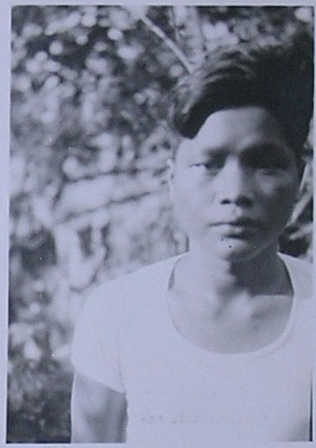
La Phaik Tan: A Kachin cultivator from Myitkyina District recruited by SOE on 1 June 1944 aged 20.
Jemadar La Sham Naw: Born 1915 but joined 5 Battalion Burma Rifles 1 March 1930. La Sham Naw’s record is also confused with dates of deployment, it seems, as his date of recruitment to SOE was corrected so it is undecipherable apart from the year, 1945; apparently on Operation Dilwyn from January to March 1945, parachute trained in March, and then dropped into the Southern Shan States on Operation Heavy, team Lynx from 28 March to 29 October 1945. The comment about him from Major Shaw: ‘Very unintelligent N.C.O. but works hard and is loyal.’
La Shawng Gam: Apparently aged just 13 when recruited on 1 March 1944. A Kachin from Myitkyina District.
Havildar La Shi Gam: A Kachin born on 3 October 1911, La Shi Gam was recruited in the field by Dilwyn personnel in June 1944. He was a forester in civilian life. Along with most of the Dilwyn men, La Shi Gam was extracted from the field on 20 June 1944, and sent on training courses in India. In October, he completed parachute training at Chaklala, followed by paramilitary training in November to December at the Eastern Warfare School, India (EWS(I)).
On 27 January 1945, La Shi Gam was parachuted into Burma as part of Operation Dilwyn as part of team Bear. Her remained in the field until 22 September 1945. His commanding officer, Lt.Col. Crosby wrote of La Shi Gam:
‘Excellent man. Very steady. Did extremely well. Ran the WANHAT show at the end of August and did very well there. Recommended for the BGM [Burma Gallantry Medal].’
La Shi Gam was awarded the BGM for his actions when fifty Japanese, ‘although they had heard of the surrender’, infiltrated past Force 136 positions in Wanhat to attack a reserve section in a house ‘at almost point blank range’. Havildar La Shi Gam ‘managed to extricate his party with the loss of only one killed and left five Jap dead on the ground. The main body then arrived [another 100 Japanese] but Havildar La SHI GAM with 30 men, 10 of whom were wounded, some fairly seriously, maintained his force in the area, constantly harassing the Jap positions for three days before withdrawing, bringing with him all his wounded and recovering a certain amount of kit lost at the first encounter. By that time he had killed 30 Japs and wounded many more.’
Jemadar La Shi Hkang: Born in 1908, La Shi Hkang was in the 3 Burif before joining SOE on 7 March 1945 in Calcutta. He was parachute trained at Jessore before going on Operation Heavy, team Lynx to help train recruits in the field.
Lance Naik La Shi La: La Shi La was in the Burma Frontier Force in the Lashio area. He was recruited by SOE in the field on 16 September 1944. La Shi La was deployed on Operation Heavy, team Wolf from 20 February to 19 October 1945. Described as a ‘Good type’ who was good on patrol, ‘But wouldn’t accept a position of responsibility.’
Havildar La Shi Naw: La Shi Naw was born on 6 October 1906. He is recorded as having been able to speak five languages – English, Kachin, Burmese, Shan and Yunnannese. In 1930, he enlisted in the Burma Rifles, and if he fought during 1942, he must have stayed in Burma when the country was evacuated. He was recruited by the Spiers team in August 1944 and went on to serve on Operation Dilwyn from 27 January 1945.
Lance Naik La Shi Yaw: Born 6 January 1925, La Shi Yaw was recruited in the field by Operation Spiers in August 1944. At the conclusion of Spiers in late September, he was extracted to India where he completed training in November and December. On 27 January 1945, he parachuted into Burma with Lt.Col. Crosby’s party on Operation Dilwyn. Crosby wrote, after acknowledging his youth, that he ‘[d]id very well in scraps and patrolling.’
Naik La Tawng: At just 4’10” and 19 years old when recruited, La Tawng was described as a ‘[v]ery good man’ and [v]ery good in action.’ He was brought on to SOE’s strength by Major Shan Lone in the field during October 1943, working with the Operation Dilwyn team until June 1944. Similar to other Kachin recruited in the field, La Tawng was extracted to India where he completed parachute and paramilitary instruction preparatory to redeployment on Dilwyn on 27 January 1945 with team Bear.
Havildar La Thaw La: La Thaw La was a kachin born 5 November 1918. He joined the Burma Rifles in 1935, and fought in the first Burma campaign of 1942. Remaining in Burma ill with malaria, La Thaw La served withthe North Kachin Levies from December 1942 until July 1943 when SOE recruited him. After a month’s W/T training at Fort Hertz, La Thaw La was sent to India for further W/T instruction in December 1943. On 24 April 1944 he was returned to Calcutta, ‘[r]ejected as unsuitable’ as a W/T operator. After parachute and paramilitary training, La Thaw La was dropped into Burma on Operation Dilwyn, team Bear, on 27 January 1945.
La Thaw La served as 2i/c to Capt. Beamish, who was impressed by his reliability and courage. Lt.Col. Crosby supported Beamish’s recommendation for the Burma Gallantry Medal (BGM); ‘First-class man in action.’
It seems he was awarded the BGM: London Gazette
Havildar La Ung Gam: Born 6 June 1920 or 1921, La Ung Gam served in the Burma Frontier Force from 1939. He was recruited by Major Shan Lone in April 1944 and after training in India was parachuted back into Burma on 27 January 1945 on Operation Dilwyn, team Bear. Lt.Col. Crosby wrote that he was one of the most pleasant men in the team, [e]xtremely likeable, always cheerful. Very good in every way.’
La Wawm: Kachin. Religion ‘Xian’.
Jemadar Labya Gam: Born in 1913, Labya Gam was a Kachin who served with 3 Battalion the Burma Rifles before the war. He was recruited into SOE by Captain Kumje Tawng in Calcutta on 7 March 1945. He completed parachute training at Jessore that same month before joining Operation Heavy, team Lynx as an instructor from 28 March to 29 October 1945. Opinion on his abilities seem to conflict. An unknown officer wrote ‘[h]e has great powers of command’ while Major Shaw wrote: ‘An unfortunate N.C.O. although he worked hard his energies were usually completely misdirected.’
- Note ‘Labya’ could be ‘La Bya’. It is recorded both ways on the record below, but Labya Tang signed his name ‘Labya’.
Havildar Labya Tang: A Kachin born in 1915, Labya Tang was in the Burma Frontier Force before the war. He was recruited into SOE by Captain Kumje Tawng from the Kachin Levies in March 1945. After parachute training at Jessore, Labya Tang was deployed on Operation Heavy, team Wolf from 6 April to 16 October 1945. Major Pennell reported that he was ‘[g]ood, thorough and trustworthy but lacks initiative.’
Labya Yaw: A Kachin from Bhamo District, Labya Yaw was 27 when he was recruited by SOE in March 1943.
Ladai Gam: A Kachin from Myitkyina District, Ladai Gam was 24 when he joined SOE on 1 October 1943.
- Note ‘Ladai’ could be spelled ‘La Dai’ as it is recorded for his father this latter way.
Lance Naik Lahpai Naw: Lahpai Naw served with the Burma Fronter Force in the Bhamo area. He was recruited into SOE on 1 June 1943, and recorded as killed in action 15 April 1944.
Lance Naik Lamai Gam (alias Lapmai Gam): A Kachin born in Bhamo in 1919, Lamai Gam was a driver with the Burma Frontier Force (joined March 1941) before being recruited by Major Manford on 16 September 1944. Lamai Gam completed parachute and paramilitary training before being dropped into Burma on 20 February to work with the Wolf team of Operation Heavy. He remained in the field until 16 October 1945. Major Pennell wrote ‘average, not too intelligent but trustworthy.’
- ‘Lamai’ could be spelled ‘La Mai’. This is how he signed his own record.
Naik Lamai Gam: A Kachin born 5 June 1925, Lamai Gam served in the Burma Frontier Force before being recruited in the field by the Spiers team in August 1944. After training in India, Lamai Gam parachuted into Burma on 27 January 1945 serving with team Bear of Operation Dilwyn. Lt. Col. Crosby reported: ‘first class lad. Very steady, rather quiet. A good N.C.O.’
Havildar Major Lamai Naw: Unusually, this record has been redacted and the copy which replaces the original is not of great quality so the only clue as to the reason for the redaction is difficult to read.
Lamai Naw was born in March 1912 and enlisted in the Burma Frontier Force in May 1932. He remained in Burma in May 1942, and was later recruited by the Spiers team in September 1944. On 27 January he was deployed with Lt. Col. Crosby on Operation Dilwyn. Crosby wrote: ‘Went in as Hav/Major. [undecipherable] & not reliable. Sent out on 6.7.45 NOT to be returned. He was [undecipherable] failure [undecipherable] of the [undecipherable].
Lance Naik Lamai Naw: Born 1923, Lamai Naw joined the Burma Frontier Force in 1941 and remained in Burma after the withdrawal in 1942. Recruited by SOE in September 1944 in the field, presumably by Spiers based on other records. After training, Lamai Naw parachuted into Burma as part of team Wolf of Operation Heavy on 20 February 1945.
Lamai Yaw: A Kachin born in 1923, Lamai Yaw joined the Burma Frontier Force in 1941. He was recruited in the field by SOE, presumably by Spiers similar to other Kachin recorded above. After training, Lamai Yaw parachuted into Burma as part of team Wolf of Operation Heavy on 20 February 1945. ‘Good on patrol’ reported Major Pennell.
Naik Laman Naw: A Kachin born August 1925. Laman Naw joined SOE in October 1944 in Poona (India). After training in India and Ceylon between October and December 1945, Laman Naw completed two operations. His first, from 31 January to 3 April 1945 was Operation Bison, an intelligence mission under the command of Major Hedley. His second from 1 May to 20 October was Operation Character, team Otter where he worked with Major Nimmo. Nimmo reported: ‘A young and very intelligent N.C.O, hard working and with a good knowledge of jungle warfare. With further tng [training] should make a good G.C.O.’
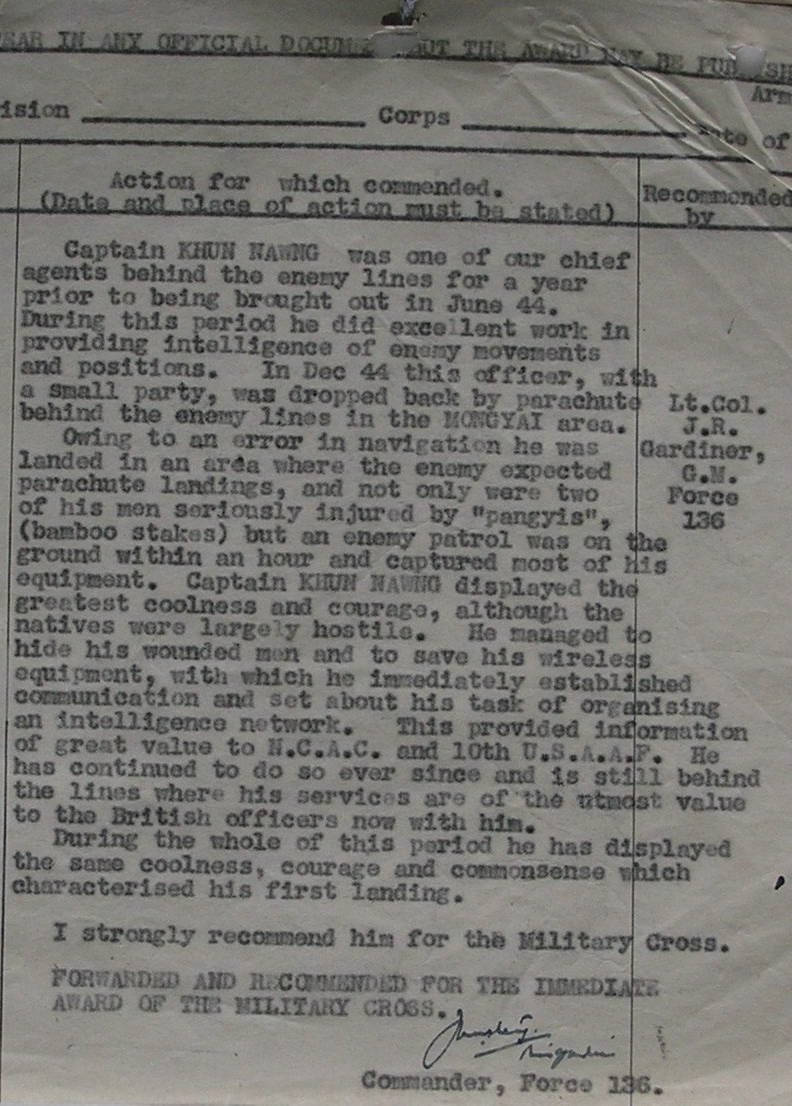
Captain Laphai Hkun (also on file as Khun) Nawng: Born on 15 January 1907 in the Bhamo District of Burma, Captain Nawng earned a BSc and was Kachin Inspector of Schools before the war. Granted a commission so that he had the appropriate status for his operational role, Captain Nawng was parachuted into Burma on 28 December 1944 on Operation Dilwyn, in charge of group Squirrel. He was exfiltrated on 22 September 1945, nearly nine months later.
As his recommendation for an MC describes, Nawng’s team missed their DZ and were put in immediate danger, prompting another officer to write ‘his conduct could hardly have been bettered by any of our officers’ – this after he had been suspected of being a Japanese agent and described as ‘not very promising in appearance’.
Nawng was allowed to keep his temporary rank of Captain, this recommendation stating that he was a ‘[t]horoughly competent oficer in every way and an excellent leader of men.’
Personnel File: HS 9/1088/2
Lau Teng: Not a lot of details for this man. ‘Date and place of Birth’ and ‘Race’ are amongst many of the unfilled gaps on his training card. All it reveals is that he was recruited as a cook for Operation Spiers. He went on operations on 5 February 1944 and was evacuated on 10 August 1944. For more on Spiers, see my book.
Law Poo: Law Poo was a Lahu, ‘Operational Role: Servant’. There is not much on his record, but it reveals he was ‘with Capt. Evans’ Levies at the battle of MONG PAWK.’ He was part of Operation Hainton from 27 February 1944, but ‘sacked as useless’ in July 1945:
‘LAW POO is my boy. He speaks a little Chinese. He is a good chap and should accompany Capt. Turnbull and be returned to NORFU if his services are no longer required.’
Naik Lazum Hka Hku: Lazum Hka Hku was a Kachin from the Bhamo area born in 1919. He joined the Burma Frontier Force in June 1938, and was recruited by SOE on 1 January 1944.
Jemadar Lazum Hting Nan: Lazum Hting Nan joined 1 Burif in 1933. After fighting in the first Burma campaign, he remained in Burma and was recruited in the field by SOE in October 1943. He arrived in Calcutta on 26 October and after training was dropped into Burma on 20 February 1945 with Major Cope to serve on Operation Heavy, team Wolf, area Red.
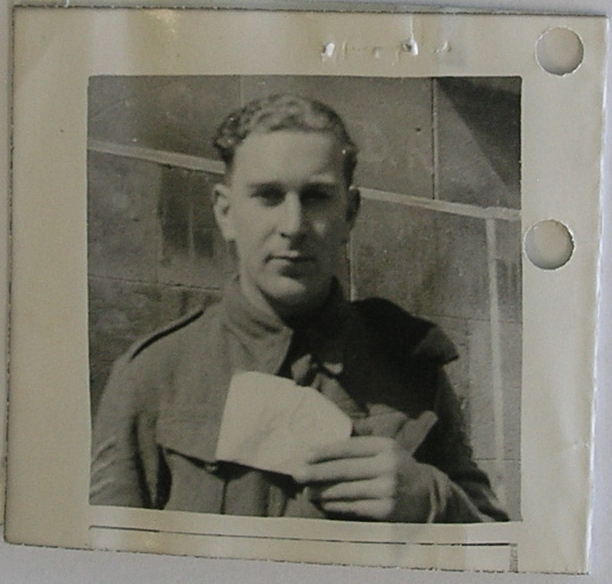
Sgt. Roger Anthony Leney: Born on 4 May 1923, Sgt. Leney was dropped into France as the W/T operator for Jedburgh team Jeremy. For his efforts in France he was MiD and awarded the Croix de Guerre. He was later awarded the Military Medal for his work on Operation Character, Mongoose White.
Sgt. Leney’s son @SimonLeney
Personnel file: HS 9/912/1
Leong Wee Chye: Served as a Medical Orderly on Operation Spiers from 5 February 1944.
Major Philip Vivian Lewes: Major Lewes was born in Staines on 24 June 1916. He worked as an electrical engineer from 1934, joining the Burma Oil Company from January 1938. He was heavyweight boxing champion in Burma for three years running (1938-40) and runner up in the All India boxing championship 1940.
Commissioned into the Army of Burma Reserve of Officers (ABRO) in 1940, Lewes excelled in Signals training and went on to serve through the first Burma campaign as O/C 1 Burma Brigade Signals.
Between August 1942 and June 1944 he was O/C of 3 & 1 company of 26 Division signals. He joined SOE in December 1944. On 24 March 1945, Lewes parachuted into Burma as part of the Walrus team of Operation Character. His parachute was not big enough for his weight, and a heavy landing resulted in a broken foot. Despite this, Lewes remained in the field, and his ‘Battle Casualty’ notice was only reported to India at the end of October 1945, when he was still in the field.
Personnel file: HS 9/919/4
Li Fu Tsai: Li Fu Tsai was a Chinese agent, known as a Panda, who had previously been a shop keeper in Rangoon. Recruited in Calcutta on 16 September 1943, Li Fu Tsai was in the first batch of Chinese to be trained as agents as agreed with the Nationalist Government. After a full year of training, Li Fu Tsai was dropped into the Grain area of Operation Billet in central Burma. His team, codenamed Elephant, was dropped on 2 January 1945, and overun by XIV Army by 23 March when he left the field. Li Fu Tsai was paid off and ‘sent back to China’ on 12 June 1945.
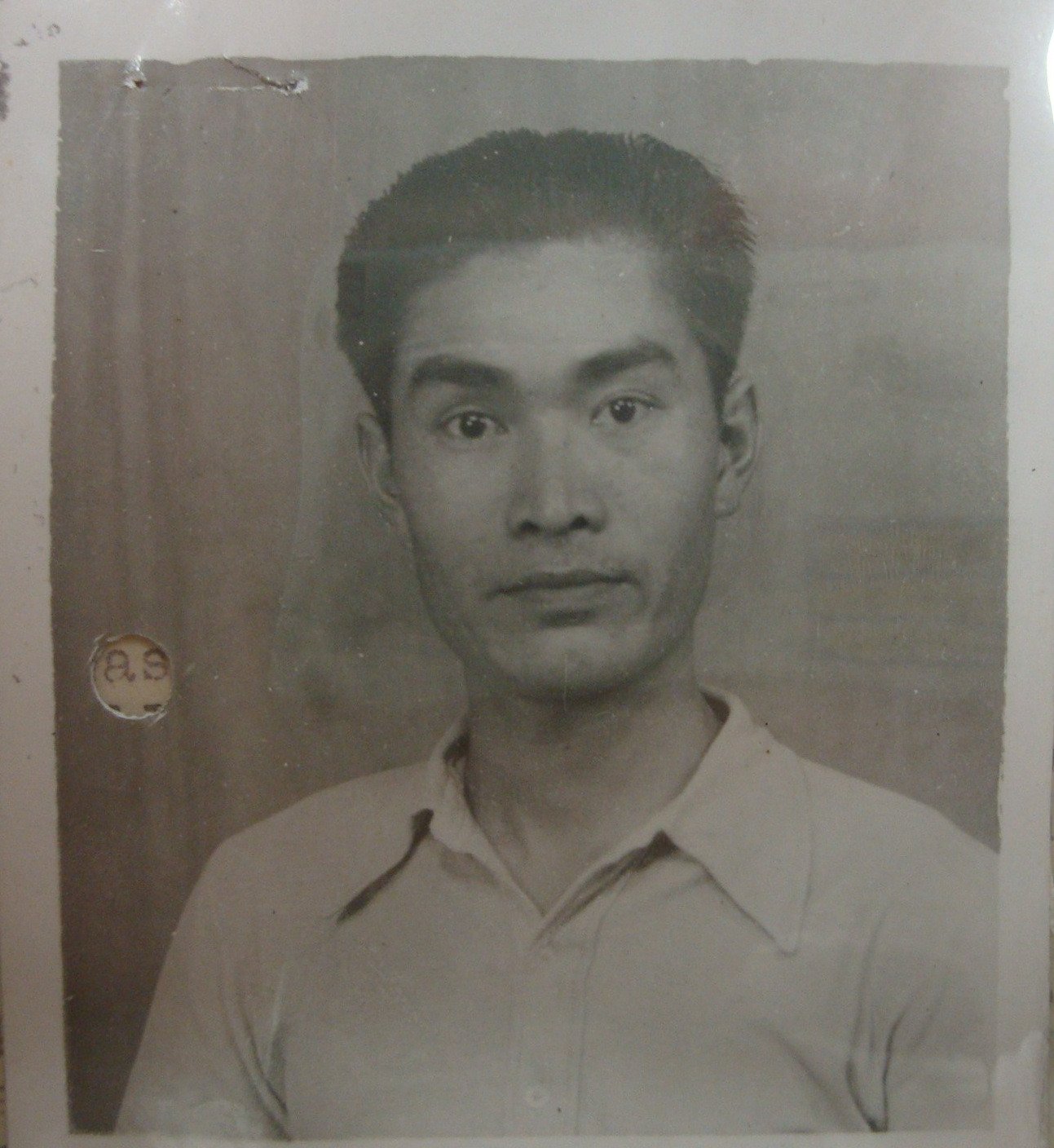
Photo: TNA HS 1/6
Li Jui: Li Jui was a Chinese agent who was parachuted into Burma on 29 June 1944. Chinese agents were code-named ‘Pandas’ by India Mission. Li Jui’s operation was Hensingham. He was tasked with making his way to Mandalay to find out about the possibility of Chinese resistance to the Japanese occupation, to collect intelligence about conditions in the Mandalay area, and to ‘recce a route from MANDALAY to CHINA for the infiltration and exfiltration of agents.’
After quite an adventure, Li Jui made it back to Allied lines on 22 January 1945. For the full story, please see blog my post.
Li Jui has no personnel file.
Li Wing: Went into the field as cook for Operation Hainton (later Heavy, team Wolf) on 27 February 1944. Remained in the field until January 1945 when he was sent back to Chungking.
Havildar Lian Za Khai: Parachuted into Burma as part of team Rat on 22 January 1945. Consisting mostly of Chin personnel, the group was compromised, and both British officers killed. Lian Za Khai managed to get back through the lines in early March with three others.
Second Lieutenant Samuel M. Little: born 24 June 1918, Little joined the Gordon Highlanders in July 1939. There are no clues in his personnel file about where the war took him between 1939 and 1945. He achieved the rank of Sergeant and due to his ‘outstanding qualities of leadership he was commissioned with effect from 1 April 1945. He was in the field on Operation Character serving with Hyena group from February 1945 until August or early September. He was on Dakota ‘J’ for Jig which crashed in the Karen Hills on 7 September. He died with at least five others: Lt.Cols. Wiggington and Kennedy; Capt. Goldsmith; Sgts. Goodwin and Sowden.

Poppy photo from Flower Meaning
Personnel file: HS 9/929/2
Liu Chang Tsai, alias Liu Chan: One of the original group of Pandas, Chinese nationalists to be trained by SOE in agreement with the Kuomintang. Liu Chang Tsai will have trained with Li Jui and Fu Tsai. Liu Chang Tsai was born in 1919 and worked as a Paddy Broker’s Assistant in civilian life. He is recorded as having spent three years at a Military Academy before going to India. After a year of SOE training, Liu Chang Tsai was dropped into the Arakan with Burmese nationalists as part of the Billet operations, team Lion, on 3 December 1944. He was the W/T operator.
Captain Charles Richard Livingston: born 14 November 1922 in Umtali, Southern Rhodesia, Livingston studied Engineering at the University of Cape Town in 1939-40. He joined the Union Defence Force in South Africa, and was seconded to the British Army serving with the Royal Artillery in 1942-3. He joined SOE in September 1943. With a commission in the Royal Engineers from December, Livingston was then trained in Palestine and deployed in Greece from 2 March 1944. He joined the Geoffrey mission, and remained in the field until November.
On leave in Southern Rhodesia, it was recommended that he join Force 136 in India. He joined Operation Nation on 9 April, with Major Rubenstein, Sergeant Brown, Sein Maung and Thein Aung. Codenamed Chimp, this team operated in the Toungoo area and are crdited in Livingston’s recommendation for an MC as having killed 800 Japanese with the help of 200 locally raised guerillas.

Personnel file: HS 9/929/7
London Gazette: Promotion
Lo Kwang To: Interpreter for the Spiers team, in the Kokang region. Went into the field on 5 January 1944 until 7 June 1944.
Lo So Hung: In the same party as Lo Kwang To, above, Lo So Hung was a W/T operator for the Spiers team. He remained in the field until May, and was ‘[d]ismissed as of 18 August.’
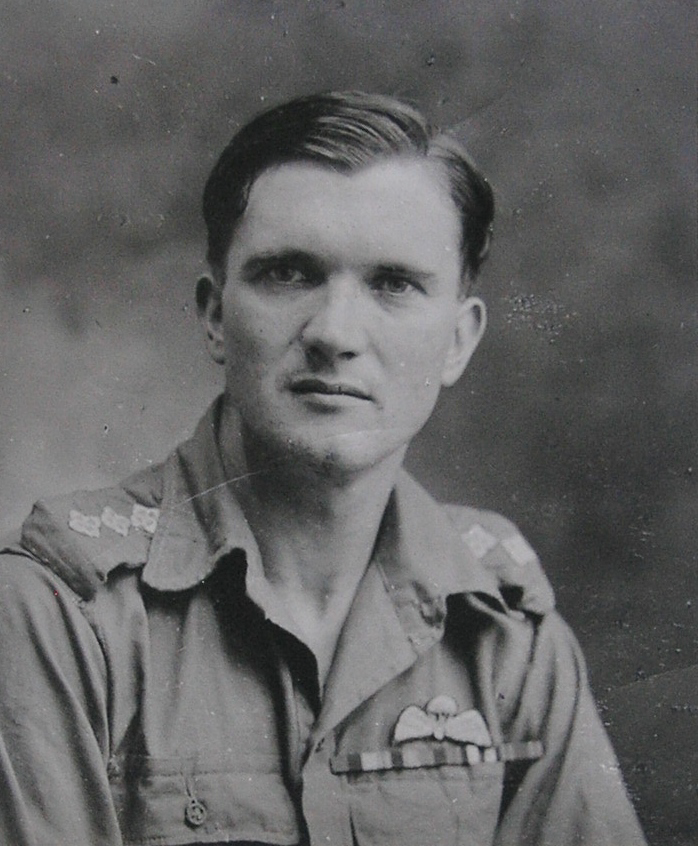
Captain David McNaught Lockie: born 30 January 1920 in South Norwood, London, and educated at Magdalen, Oxford. Lockie’s father was born on Akyab Island, Burma, in 1871.
Lockie went to Sandhurst November 1940 – Feb 1941, joining the 9Bn Yorks & Lancs Regiment in March. He served with his regiment in Egypt, North Africa and Sicily and then as liaison officer to 3 French Parachute Bn from January to May 1944. In June 1944, he joined SOE.
Between June and October 1944 he was W/T trained to go into France, but was too late for ops due to liberation. He therefore went to the Far East as a Jedburgh on 13 February 1945, was trained at ME25 in Ceylon and finally deployed as Operation Tiger in Tenasserim, Southern Burma, from 25 April. He was withdrawn from the field on 24 October 1945.
Personnel file: HS 9/933/1

Sgt. Loosmore, picture credit SFRH
Sergeant Robert Glyn Loosmore: Sgt Loosmore was born in Bridge-End, Wales, on 3 March 1923. Like many other W/T sergeants, Loosmore was recruited into SOE from the Royal Armoured Corps in 1943.
Loosmore won the MM and CdG for his work in France, where he parachuted into the Haute-Vienne area on the night of 11 July 1944. The two officers of his Jed team, Major Parkinson and Lt. Vermeulen/Vermerler were seriously wounded on landing, and by his ‘outstanding and exceptional behaviour’, Loosmore saved them from being captured by the Germans who raided the farmhouse in which they were hiding. Both officers were later evacuated, but Loosmore elected to stay in France. He worked with the French Resistance for the next two months. During his time in France, Loosmore had the codename of ‘Lundy‘, and he worked with teams Andy and Ivor.
After France, Loosmore went to Burma. He was parachuted into Operation Character on 31 March 1945 and was part of Mongoose Blue, for which he was Mentioned in Dispatches (MiD). In his opinion, SOE achieved considerably more in Burma than the Jed teams had in France (see reels 3&4 of IWM interview provided below).
Unpublished manuscript. Loosmore, Glyn. A Postscript to Arthur’s Brown’s ‘The Jedburgh’s’
Personnel file: HS 9/939/2
Military Medal Gazette
Copy of Times obituary
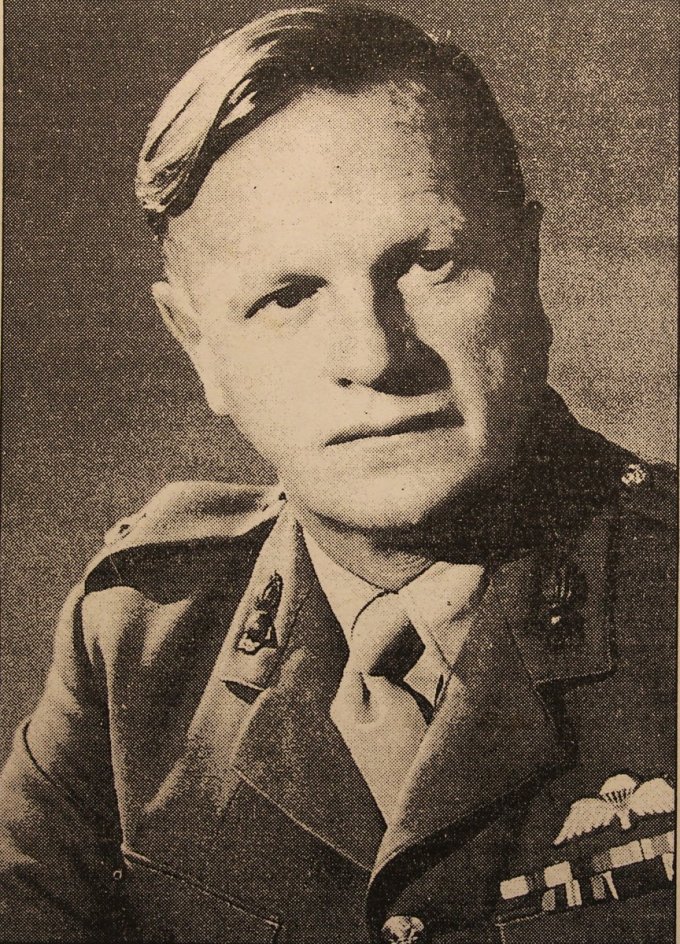
Major Percival Verney Lovett-Campbell: Born on the Isle of Skye on 6 September 1912, Lovett-Campbell worked in Burma from 1934 until 1940. He was employed by the firm Steel Brothers, a forestry business. After being commissioned into a territorial Royal Artillery unit, Lovett-Campbell was posted to East Africa where he served in Kenya, Abyssinia and Somaliland against the Italians. From there he went to fight the Pathans in Waziristan. Described as ‘extremely fit and tough’, he joined the Burma section of SOE in December 1942. It seems he could give the Russian ‘mad monk’ Rasputin a run for his money in the category of difficult to kill:

While on Operation Dilwyn with SOE in 1944, a booby trap went off injuring Lovett-Campbell: he lost half a thumb and a finger from his left hand, and was also hurt in the thigh and eyes. These injuries were sustained while on operations in support of Dahforce, which was part of Wingate’s second Chindit operation. He was awarded an MC for his work on this operation. Later, from 25 January to 1 May 1945, he led operation Burglar, team Hippo. This operation was unable to achieve much and evidently frustrated Lovatt-Campbell judging by his post operation report.
Personnel file: HS 9/261/5
Obituary (which appears to have at least two incorrect dates)

Naik Lu Pe, alias Maung tha Pe: A Burman cultivator from the Upper Chindwin area who was recruited by Lt.Col. Peacock on 27 February 1943 and served as Peacock’s escort. After exfiltration to India, Lu Pe completed parachute and demolitions training before going back to Burma to serve under Major Poles on team Ferret of Operation Character. Poles wrote of Lu Pe: ‘Not outstanding. Needs keeping up to the mark.’
Lu Thein: Lu Thein was a Burman born about 1923. He joined SOE in 1943 and was trained in demolitions in Ceylon and parachute trained at Jessore. He was dropped into Burma as part of part of Operation Nutshell, team Antelope, on 20 March 1945, but he did not stay with this mission long because he was ambushed by the Japs when crossing a chaung on 2 April and then appears to have got lost in the confusion. He was ‘picked up by’ Operation Character’s Walrus team in June and stayed with Tulloch’s group until the end of operations.
Lu Thin: A Shan-Burman from Myitkyina District. Formerly a cultivator, he joined SOE on 1 June 1944 aged 20. More than likely recruited by Dilwyn personnel.
Major John Ponsonby Lucas: born 3 March 1903 in Harpenden, Lucas attended the Bedford School from 1911-1921. He then a Zoology degree at Cambridge, graduating with 1st Class Honours. He seems to have several job between finishing university in 1924 and joining the Army in March 1941 from a reserved occupation. Part of his work was ’12 years research on camouflage and colour’ and ‘8 year experimental work in Laboratory in photography, especially in colour and infra red work.’
He joined the Royal Artillery in a Heavy Anti-Aircraft role before completing OCTU at Shrivenham. Volunteering for the RIASC, he was picked up by SOE in 1943 and became an instructor. He eventually ended up in command of the Blue area of Operation Character, team Mongoose. His personnel file shows that there was some controversy over his actions during this operation, with names redacted from correspondence discussing three sergeants from the Mongoose Blue team who complained about him. The accusations were dropped, and Lucas was awarded the MC for his part in the demolitions which led to this:

Personnel file: HS 9/947/5
Lui Li Sheng: A Chinese interpreter who served with the Spiers team from 23 August to 6 September. He apparently ‘resigned’ and was paid off on 30 September 1944.
Subedar Lum Yang: Also spelt Lu Myang on his record, a Kachin who completed a recruit’s test in 1929. It is not clear what unit he joined, but he is noted as having taken part in suppressing the Burma rebellion of 1930-2 and the first Burma campaign in 1942. There is nothing on his SOE service, as the usual training card is missing.
Lun Cung Nung: Born in 1925, Lun Cung Nung was a Chin who served as W/T operator for Label’s team Rat from 22 January to 28 March 1945. After the team was compromised, Lun Cung Nung escaped with Jemadar Chin Pau’s party. On interrogation, it is recorded that when his party was attacked he was ‘so tightly wrapped round by his loonggyi [sic] and blankets that he was one of the last to get away.’
Lun Za Mang: A Chin who was part of Operation Label’s team Rat. This Special Group was parachuted into Burma on 22 January 1945, but were compromised and ran to safety after their British officers were killed. Lun Za Mang was part of Havildar Lian Za Khai’s party, picked up in early March by advancing British forces.

A super picture of A Group, OSS. Major Maddox is in the centre. Picture credit: The Anglo Burmese Library
Major Patrick Reginald Maddox: Maddox was an Anglo-Burmese, born 1 November 1913 in Burma. Maddox was an early recruit to SOE’s Oriental Mission after being granted an emergency Army in Burma Reserve of Officers (ABRO) commission in November 1941. He was trained at STS 101 in Singapore and deployed in Burma in time for the Japanese invasion.

After escaping from southern Burma by boat, Maddox was part of the team who blew up the bridges north of Myitkyina which prevented the Japanese from occupying northern Burma.
Maddox was then ‘loaned’ to OSS, and was parachuted into Burma as part of the first American mission. This tale is told in John Beamish’s Burma Drop and Troy Sacquety’s The OSS in Burma.
After the war, Maddox joined Number 16 War Crimes Investigation Team.
Personnel file: HS 9/974/2
Captain Frances Terence Maginn: born 25 February 1917, Maginn belonged to 16 Punjabs. He was flown in to Burma to join Operation Character, Team Hyena, on 22 August 1945, after the end of hostilities.
‘He has done much useful work reporting political intelligence and feeding the populace in the area East of the Salween R. A good type of officer who would do well in govt. or civil employ anywhere in the Far East.’
It appears that after the war Frances went to work in East Africa as a Forest Officer.
Mahkaw La: A Kachin police constable from the Myitkyina District, Mahkaw La joined SOE in October 1943 aged 27.
Havildar Mahkaw La: Mahkaw La was a Kachin who joined the Burma Frontier Force in November 1932 aged 18. He was from the Bhamo District. He joined SOE on 1 January 1944.
Naik Manam La: Born on 6 June 1944, Manam La had been in the Burma Military Police before joining SOE. He was recruited in the field by Major Zau June in July 1944, and after training in India in November and December, he was parachuted into Burma as part of team Bear on Operation Dilwyn. Lt.Col. Crosby wrote: ‘A really good man. Very tough (enormous shoulders and very thickset). Always used on active jobs. Was NCO in charge of 3” mortar squad for a time. Very popular with the others.’

Major Manford, courtesy of Peter Rogers, Commando Veteran’s Website Also pictured HERE
Major Francis Stanley Manford: Born in Newcastle on 22 December 1910, Manford joined the Durham Light Infantry before becoming a Commando. For two years he was Troop Leader of No.5 Commando, but by 1942 he still had no operational experience because his missions kept getting cancelled. He joined 204 Mission to get operational, and consequently missed the invasion of Madagascar.
When SOE caught up with him, Manford was attached to 77 Brigade – the Chindits – as an instructor. On 20 November 1942, SOE applied for his services, describing his situation ‘more or less at a loose end’. Successful in adding him to their strength, Manford was sent into Burma on Operation Spiers in early 1944.
When Spiers was pulled out of Burma, Manford went on leave in Jashipore, India. It was there that he took his own life, shooting himself in the head with his Colt .45 in the early hours of 30 November 1944. An inquest found that he was ‘unsound of mind’ due to a bout of malaria.
He left behind a wife and child.

Personnel file: HS 9/982/1
Commando Veterans: No.5 Commando
Mang Za Suan: A Chin who was part of Operation Label, team Rat, deployed on 22 January 1945 until 28 March. Escaped with Jemadar Chin Pau after the team was compromised.
Maran Gam: A Kachin born in 1925, Maran Gam was recruited in the field in September 1944 by the Spiers team. After training in India, Maran Gam was parachuted into Burma on Operation Heavy, team Wolf, with Major Cope. He was in the field from 20 February to 19 October 1945. Major Pennell wrote: ‘Trustworthy. Possesses initiative but will not accept responsibility. Patrol work good.’
Maran Tu: A Kachin born in 1922, Maran Tu was recruited by Major Manford during Operation Spiers in September 1944. After parachute training in India, Maran Tu was deployed on Operation Heavy, team Wolf from 20 February to 19 October 1945. Major Pennell reported that he was trustworthy and good on patrol, ‘but lacks initiative.’ Major Cope reported that he was ‘lazy’.
Maran Zau Neng: A Kachin recruited at age 25.

Captain Godfrey Marchant: born 24 September 1910, Marchant read agriculture at university before going out to Argentina to work in the farming industry. Inn 1939, he joined the Army, and was granted an emergency commission on 1 November 1940. It was about this time that he joined SOE, first being posted to STS XVII as an accompanying officer and instructor with Spanish Section from 11 December. He was later placed in charge of Spanish Section at STS 42 in August 1941.
After approximately a year working in West Africa as a courier, Marchant was Consular Agent in Fernando Po for Nigerian Labour Matters. He left Accra for the UK in October 1943. Before going to India in early 1945, he won an MC for his work behind the lines in France, and went to Italy where he was ready for a mission which was eventually cancelled.
Captain Marchant was due to jump into Burma as part of Operation Nation, team Hart, but his aircraft crashed on take off at Jessore on 1 April 1945. The rest of his team, Sergeant Colvin and Captain Vickery, along with all the 357 Squadron aircrew all lost their lives.

Personnel file: HS 9/987/5

Major John Jenner Marchant: born 24 January 1920 in Blackheath, London, Marchant joined SOE in late 1943. Before the war, Marchant was educated at Aldenham School, where he attended OTC and toured Germany in 1936 with the Hockey team. On leaving school, Marchant joined the TA (Queen’s Victoria Rifles) and worked as a bank clerk before officer training in 1939-40. Commissioned into the Wiltshire Regiment, from December 1940 to November 1943 he was with the Auxiliary Units, the secret ‘Home Guard’ set up to prosecute a guerrilla war against any German invasion.
Marchant was recruited by SOE to become an instructor, which he was until 1944 when he went operational in France from July to September. He was part of Operation Felix, with Sergeant Colvin (see above). After France, Marchant was deployed on two operation in Burma. The first was Operation Bison, with Major Hedley (see above); the second was in the Otter area of Operation Character.
Personnel file: HS 9/987/6
Marip Yaw: A Kachin born in 1925, Marip Yaw was recruited in September 1944 and retrurned to Burma on Operation Heavy, team Wolf from 20 February to 19 October 1945. He would have been deployed with Maran Tu above, and Major Cope. Marip Yaw was, like Maran Tu, described as trustworthy and good on patrol, but ‘lacks initiative.’
Captain Joseph Marlam: Marlam was an Anglo-Indian born in Mogok, Burma on 29 July 1914. He was a Mechanical Engineer, employed before the war as a Government Transport Officer in Lashio. He spoke English, Burmese and Hindustani, and was employed by SOE, initially, as an interpreter at the training school in Ceylon, ME25.
It was recommended in late 1944 that the interpreters at ME25 become operational after satisfactory training. Marlam completed training, was commissioned, and was parachuted into Burma as Major Turrall’s 2i/c for the Hyena area of Operation Character. Marlam was in the field from February to October 1945. He was described by Turrall as ‘most intelligent’ and having ‘rendered first class service’. Apparently as happy and competent with a W/T set as a weapon, he gained recognition for his use of the cordtex grenade ambush. For his actions in ambushing Japanese, Marlam won the Military Cross. ‘A very brave and competent soldier who knew his work.’
Personnel file: HS 9/991/4
Subedar Major Maru Gam: Maru Gam joined the Burma Rifles in 1930. At the end of the first Burma campaign, he remained in the country. He was recruited by SOE’s Dilwyn team on 1 June 1944, and remained on operations until October. After paramilitary and parachute training in India, he was deployed back to the Kachin Hills on Operation Dilwyn with team Gazelle from 28 December to 26 April 1945. He then joined Operation Character from 8 May until 18 October 1945, serving with Captain Vivian’s Otter team.
Maru Gam had already won the Burma Gallantry Medal in the first Burma campaign, but while with SOE he was again to display conspicuous bravery. This from Major Shan Lone’s report:
‘The highlight of the first phase of the operation was the unearthing of the whole disposition of the Jap 56th Div in North Hsenwi.. I sent out a recce party under Subedar MARU GAM to Jap Div H.Q. MARU GAM disguised himself and bribed his way along with Chin coolies, to 200yds of the 56 Div H.Q. He remained in the area 11/2 days, working as a coolie and he unearthed the whole dispositions of 56th Div. The vital info he obtained was rushed up to USA MARS Task Force, and proved to be of first class intelligence.’
Recommendation for BGM: WO 373/30/234
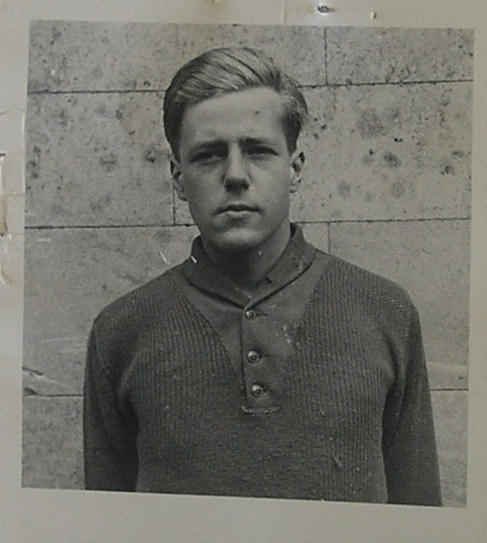
Sergeant George William Mason: Born 19 December 1922 in Streatham, Mason was serving as a Trooper in the 27 Lancers when SOE picked him up in October 1943. He trained as a Jedburgh and was deployed to Holland as part of team Daniel II. He was in Holland from 1 – 29 September 1944, and was MiD. Daniel was one of the SOE teams in support of Operation Market Garden, see HERE for more guidance.
Upon return to the UK, he volunteered for more operations in the Far East. Once in the Far East, the accounts department tracked him down to ME25 to ask him for a statement of expenses, to help try and account for 5000 Guilders that the team had been given.
Mason deployed into Burma on Operation Character and served with the Hyena team under Lt.Col. Howell.
Personnel file: HS 9/999/6
Captain Maran Gam: Maran Gam was a Kachin, born 6 August 1907. He joined the Burma Rifles on 4 June 1925. From 1928-1932 he served in Perak, Malaya, and in 1937 he was cosen to represent the Burma Rifles at the coronation of King George VI. He was fluent in Kachin, Urdu, Shan, English, Burmese and Chinese. After servig in the first Burma campaign, he was attached to the Civil Affairs Service, working on the Indo-Burmese border in the Tiddim area. When the CAS no longer needed him, SOE’s Forward Propaganda Units were deperate for Burmese speakers and snatched him up before Z Force could make a claim on him. Promoted to Captain specifically for operations with Force 136 in Burma, he went into the field with No.2 FPU in support of 33 Corps from January to July 1945.
Personnel file: HS 9/558/3

Maung Aik: A Shan cultivator recruited on 1 June 1944, aged 22.
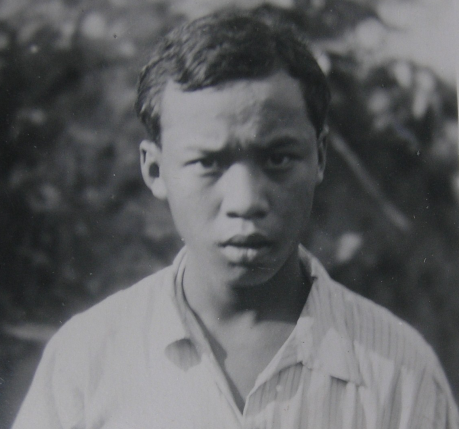
Maung Aik Kya: A Shan cultivator from the Nam San District, Maung Aik Kya was recruited on 1 June 1944.
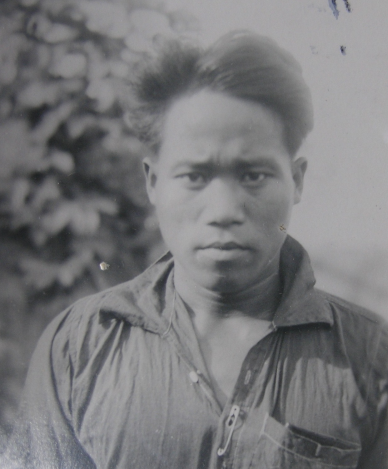
Maung Aung Shein: A Shan Burman cultivator from Myitkyina District recruited by SOE on 1 June 1944 aged 35.

Maung Aung Tha: A Shan Burman cultivator from the Myitkyina District recruited on 1 June 1944, aged 36. Maung Aung Tha is recorded as having had three daughters and a son.
Maung Aung Ya: A Burman from the Upper Chindwin area who was a tailor in civilian life, Maung Aung Ya was recruited in December 1943 by Major Peacock. Maung Aung Ya worked with P Force until 25 May 1944. He was born in 1919.
Havildar Maung Ba Aye: A Burman born in 1924, Maung Ba Aye was originally a cultivator. He was recruited by Major Peacock in the Chindwin area on 5 January 1944. After serving with P Force, Maung Ba Aye was parachuted into Burma on 20 February with Major Turrall as part of one of Operation Character’s Special Groups. He was with the Hyena team (Red area) where he trained the new recruits for patrols in the Karen Hills. Major Turrall wrote:
‘BA AYE my BEST Section Commander was shot in the hand: and duly lost to me, in April, by evacuation. He is a grand fellow, full of good humour, and eccentricity, and outstandingly brave.’
Maung Ba Khin: A Burman cultivator born in 1908, from Sonnan in the Upper Chindwin area, recruited by Major Peacock on 15 February 1944. Recorded as being on [a]tive service in Burma’ until 25 May 1944.
Maung Ba Khine: A Burman cultivator from Minyar in the Upper Chindwin area. Recruited by Major Peacock on 15 February 1944 and employed until 25 May on Chindwin operations.

Naik Maung Ba Kyaw Galay (also Gaw Gale & Ba Gyaw Glay: A Burman cultivator born in 1926, Maung Ba Kyaw Galay was from Man Naw village where he was recruited by Major Peacock. When Chindwin patrols were withdrawn, Maung Ba Kyaw Galay went to India and Ceylon where he completed training prior to deployment on Operation Character. Part of the Ferret team under Major Poles from 24 February to 22 October 1945, Maung Ba Kyaw Galay was ‘[a]n exceptionally keen and reliable N.C.O.’ He was recommended for an award ‘for individual bravery and devotion to duty between the 16 and 19 July 1945.’ No record of the award is noted on his record.
Maung Ba Kywe: A Burman cultivator from the Upper Chindwin area recruited on 5 January 1944 aged 23. Active service with P Force until 25 May 1944.
Havildar Maung Ba Kywe: A Burman born in Pakoku District in 1918, Maung Ba Kywe was recruited into SOE from the Burma Sappers and Miners on 10 October 1944. After training in India and Ceylon, Maung Ba Kywe was deployed on Operation Character as part of the Walrus Special Group under the command of Lt.Col. Tulloch from 24 March to 22 October 1945. Described as ‘intelligent and hard working’, his application to join the police after the war was supported.
Maung Ba Nyun: A Burman cultivator born in 1925 from Man Naw village, Maung Ba Nyun was recruited by Major Peacock on 5 January 1944. When P Force was withdrawn, Maung Ba Nyun went too, completing training in India and Ceylon. He was deployed on Operation Character from 20 February to 20 October, serving with the Hyena team. Major Turrall wrote the following of Maung Ba Nyun:
‘Dead accurate shooting 11 March 1945, withheld to almost the bayonet point on CHAWIDO hill. This coolness contributed largely to the break up of Jap entry on this occasion into Hyena position, and so contributed to the enemy supposing us trained troops IN STRENGTH, and the Jap signalling Rangoon for reinforcements’.
Two more incidences of ‘[o]utstanding coolness’ saw Maung Ba Nyun recommended for the Military Medal.
Maung Ba Pe: A Burman cultivator from the Upper Chindwin, Maung Ba Pe is recorded as serving from 14 December 1943 to 25 May 1944 with P Force.

Maung Ba Thaung: A Shan-Burman from Inlay village in Myitkyina District. Recruited by SOE in the field on 1 June 1944.
Maung Ba Thein: A Burman cultivator recruited by Major Peacock on 23 November 1943. When P Force was withdrawn Maung Ba Thein went to India and Ceylon for training. He was then deployed on Operation Character with the Hyena Special Group from February to October 1945.
‘Was present at many ACTIONS and AMBUSHES, against the Jap. Fought on in MAY and JUNE etc in monsoon rain, leeches, no cape, no ground sheets, no hammock, no milk, sugar, tea, no boots: and this uncomplainingly.’
Maung Ba Thein, alias Maung Gyi and Maung Kyi: Born in 1924 and from Mandalay, Maung Ba Thein spoke Japanese and had served in the Burma Defence Army as an AA gunner. He was recruited ‘from E.C.D.C.’ on 1 October 1944, but I have no idea what ECDC was (yet!). It also noted that he worked ‘in I.F. before war’, but what was I.F.?
On 27 October 1944, Maung Ba Thein was parachuted into Burma as a Billet with two Chinese of Operation Wakering. Maung Ba Thein returned on 23 February 1945, but the two Wakering personnel, Chang Shen and Chen Chuan, both died when their parachutes failed.
Maung Ba Thein completed his work in Rangoon and ended up working with Elephant in the Mandalay area.
Maung Ba Thein: A Burman cultivator from Malu village in the Upper Chindwin area. Maung Ba Thein was recruited on 5 January 1944 aged 26. He served until 25 May 1944.
Maung Ba Tun: A Burman ‘FARMER’ from the Upper Chindwin recruited on 15 February 1944 aged 28.

Maung Ba U: A Burman cultivator born in 1912 and from the Myitkyina area, Maung Ba U was recruited on 1 June 1944. He completed a filter course in India to assess suitability for SOE operations before parachute training and paramilitary training in Ceylon. Maung Ba U was deployed on Operation Rendezvous from 16 December 1944 to 14 January 1945.
Maung Chit Htoo: A Burman cultivator from the Mawlaik District, Maung Chit Htoo was recruited by P Force on 15 February 1944 aged 33.
Maung Hla: Maung Hla was born in 1914 and was recruited into SOE from the Burma Sappers and Miners. Between October 1944 and March 1945 he was trained at Poona, Belgaum, Rawalpindi and at ME25 in Ceylon. On 26 March he parachuted into Burma with Major Lucas as part of the Mongoose team of Operation Character. He remained in the field until 2 November 1945. Major Lucas wrote: ‘[h]as a very difficult and uncertain temperament. Can work extremely hard and willingly. Not entirely trustworthy – and rather undisciplined.’ Maung Hla ‘did not go into action’, he was a ‘rear link man’.

Maung Hmi: A Burman born in 1919, Maung Hmi was recruited by SOE on 1 June 1944 in the Katha area of northern Burma. He completed a filter course before parachute instruction at Chaklala and collective team training in Ceylon during September – November 1944. On 25 November 1944 he was parachuted into Burma on Operation Rendezvous. This mission was complete by 14 January and on 25 January he was again dropped behind the lines on for Operation Burglar until 1 March. He was paid off in the field and allowed to go home.
Havildar Maung Htin: A Burman cultivator recruited by Major Peacock in January 1943 in Tamu, Upper Chindwin. After P Force ops, Maung Htin completed demolitions and parachute training before deploying on Operation Nutshell with team Antelope on 20 March 1945. He transferred to Tiger in May 1945, and remained in the field until 25 October 1945. Major Abbey reported that he was a ‘good worker, but [had] an unfortunate manner and did not get on with the other men.’
Maung Kan Gyi: A Burman cultivator from the Mawlaik district, recruited at age 20 on 1 June 1944. Recorded as just 4”7 tall, and ‘Rt eye is blind’.
Maung Kan Htu: A Burman cultivator from the Upper CHindwin area, recruited on 15 February 1944 aged 20.
Maung Kan Shin: A Burman recruited on 15 February 1944 in the Upper Chindwin area. On P Force patrols until 25 May 1944, and then parachute trained in India before completing collective training in Ceylon preparatory to deployment on Operation Ramrose, team Rhino on 23 January 1943.
Maung Khant: A Burman cultivator from Mawlaik District recruited on 1 June 1944 aged 35.

Maung Khin: A Shan born in 1910, Maung Kin was recruited in Assam in ‘Summer ‘43’. He completed demolitions and parachute training and was then dropped into Burma as part of Nutshell, team Antelope on 20 March 1945. Captain McLeod wrote on his record that he was ‘dropped the wrong side of the Salween or wandered into Siam on Jap attack – Picked up by Walrus in May ‘45 – and remained with them until they came out.’
Major Abbey wrote that Maung Khin was separated from his party on 2 April. He was ‘[m]iddle aged, quiet and serious. Hard working and intelligent.’

Maung Kyan: A Shan from Myitkyina District, Maung Kyan was recruited aged 24.

Maung Kyauk Sein: A Shan Burman from the Myitkyina District, Maung Kyauk Sein was recruited on 1 June 1944 and his occupation is recorded as ‘petty trader’. He was born in 1916.
Maung Kyaw Hein: Maung Kyaw Hein was a Burman cultivator from the Upper Chindwin, employed by SOE from 15 February 1944 age 18.

Maung Kyaw Hla: A Shan cultivator from Thibaw District, Maung Kyaw Hla was born in 1920 and recruited to SOE in June 1944.
Maung Kyaw Myin: A Burman cultivator from the Upper Chindwin, recruited 15 February 1944, age 19.
Maung Kyaw Myint: A Burman cultivator from the Upper Chindwin, recruited 15 February 1944, age 18.
Lance Naik Maung Kyaw Yin: A Burman serving in the Burma Sappers and Miners, Maung Kyaw Yin was recruited in October 1944 by Major Hedley. He completed collective training before deploying as Walrus Special Group for Operation Character on 24 March 1945. He remained in the field until 22 October, serving under Major Campbell who wrote: ‘An efficient, smart and reliable soldier. Suitable for employment which he would like to take up, i.e. the Police Force.’
Havildar Maung Kyi Shein: A Burman born in 1919, Maung Kyi Shein joined the army in November 1938. Before joining SOE in October 1944, he was a Chindit, taking part in Operation Thursday. After SOE training, he was deployed on Operation Nutshell from 11 August 1945. Major Beaumont-Nesbitt described Maung Kyi Shein as ‘a most superior type of man, with a charming personality.’
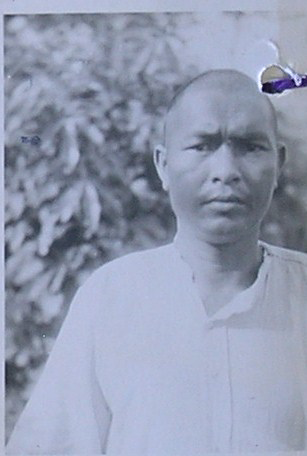
Maung Lu Dan: A 45 year old Shan Burman cultivator from the Myitkyina district, Maung Lu Dan joined SOE on 15 June 1944.
Maung Lu Pe: A 38 year old Burman cultivator from the Upper Chindwin area, Maung Lu Pe served with P Force from 15 February to 25 May 1944.

Lance Naik Maung Lu Wa: A Burman cultivator who served with P Force from December 1943, then aged 27. After parachute training at Chaklala in August 1944 and demolitions training in Ceylon, Maung Lu Wa was parachuted into Burma as part of the Ferret Special Group under Major Poles. He was in the field from 24 February to 22 October 1945.
Lt.Col. Peacock reported that he was a ‘[g]ood demolitionist. Temperamental, and not too reliable. Usually very cheerful, energetic and willing, but apt to get the sulks.’ Major Poles agreed that he was temperamental, adding that he was a ‘timid creature whose rotund person is not built for jungle work in hill country.’
Naik Maung Maung: Born in Mandalay in 1916, Maung Maung was a Burman who enlisted in the Army in 1939. During 1941-2 he is recorded as being in Bangalore on a carpentry course, but by 1943 he was training with the Chindits prior to deployment on Operation Thursday. He was recruited by Major Hedley in October 1944 and employed as W/T operator for Major Campbell on Operation Character, team Walrus. Campbell described him as ‘extremely willing and hard working’ as well as ‘reliable and conscientious’. It is noted that he wanted to join the Forestry Service upon discharge from the Army.
Lance Naik Maung Maung: A Karen from the Taungoo area, Maung Maung was recruited by Major Peacock and served with SOE from 21 September 1943. He was promoted to Lance Naik in October after attending a demolitions course, and then went on to patrol with P Force in the Upper Chindwin area.
Jemadar Maung Maung Than: A Karen born in Henzada in 1918, in civilian life Maung maung Than was a Customs Officer. He was recruited by Captain Baldwin in Rangoon at the beginning of August 1945, promoted to Jemadar, and by the 10 August he was delivered by Lysander to Mongoose Gold of Operation Character to work with Captain Sturgess in the Papun area. His training card has ‘No training’ written in the section entitled ‘Training History’.
Major Hood wrote that Maung Maung Than was ‘very keen to get to grips with the Japs’ but that ‘an abrupt and rather bullying manner […] did not make him popular’. Maung Maung Than returned home to Insein after 19 October 1945.
Maung Ming Thang: A Chin who was parachuted into Burma on 22 January 1945 as part of team Rat. After the team was compromised and its British officers killed, Maung Ming Thang escaped back to Allied lines with Havildar Lian Za Khai.

Maung Moe: A Shan-Kadu cultivator from the Myitkyina District, Maung Moe was 32 when he joined SOE on 1 June 1944.
Havildar Maung Myein: Maung Myein was a Burman born in Mandalay in 1921. He joined the Army in 1938, and was with the Burma Sappers and Miners when he was recruited by Major Hedley for SOE in October 1944. After parachute, para military, jungle and demolitions training, Maung Myein parachuted into Burma as part of Lt.Col. Tulloch’s Walrus Special Group of Operation Character. He was in the field from 24 March to 22 October 1945.
Major Campbell described Maung Myein as ‘[a] very intelligent N.C.O. Very cheerful and popular with all. A good soldier. […] My best N.C.O.’
Maung Nauk Paw: A Burman cultivator from the Mawlaik district born in 1918, Maung Nauk Paw joined SOE in June 1944.
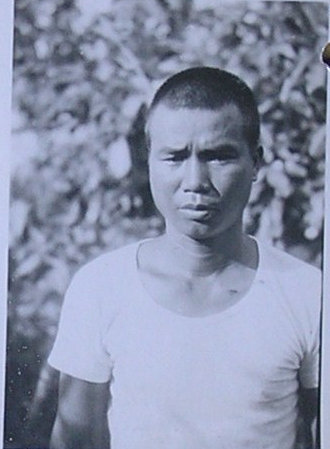
Maung Ngwe Bon: A Shan Burman cultivator from the Myitkyina district who joined SOE when aged 34.
Maung Nyein Maung: To read about Maung Nyein Maung’s contribution to the war, click HERE.
An Indo Burman, also known as Nirmal Chandra Mukerji. He served as a clerk in the Indian Army Corps of Clerks. Born 10 April 1899, educated to degree level, and recruited by SOE on 17 July 1944.
Maung Nyein Tin:
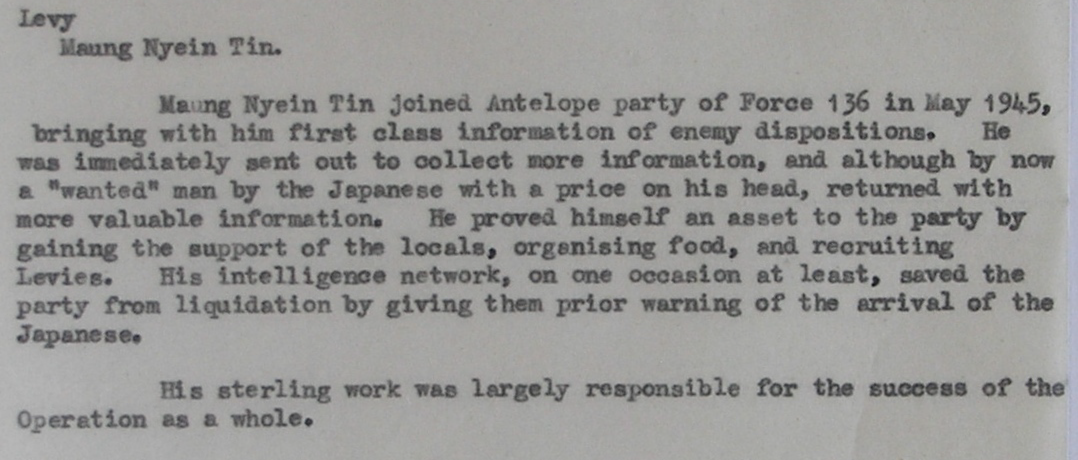
Maung Nyo: Maung Nyo was a Karen, born in 1922. He worked in the timber business before the war. He was recruited by V Force from Burma Army Signals in April 1945, and after parachute instruction at Jessore in May, jumped into Burma where his V Force party was attached to Character’s Hyena team. He returned to Rangoon in November 1945
Jemadar Maung (also Myang) Nyung Dawt: A Kachin born in 1904, Maung Nyung Dawt was in 4th Battalion the Burma Rifles before being recruited into SOE on 7 March 1945. Six days later he was at Jessore for parachute training before being dropped into Burma on 6 April with Captain McIntosh. He served under Major Pennell on Operation Heavy, team Wolf, until 16 October 1945.
Maung Nyunt: A Karen born in 1922, Maung Nyunt was a Burma Military Policeman before joining SOE on 10 October 1944. Between October and March 1945, Maung Nyunt was trained with his Special Group in order to be deployed on Operation Character, team Mongoose, on 26 March 1945. He remained in the field until 2 November, and was recommended for the MM or BGM by Captain Clark ‘for his good work on ambushes’. Major Lucas wrote: ‘An extremely powerful and absolutely reliable soldier under all circumstances. No great imagination, but absolutely loyal and well disciplined. Thoroughly courageous in coup de main would make an excellent N.C.O.’
Maung Phoe Mhee: A Shan Burman Cultivator from district, recruited on 1 June 1944, age 30. He was just 4’ 10”.

Maung Pho Oo: A 25 year old Burman farmer from the Upper Chindwin when recruited by SOE on 14 December 1943, Maung Pho Oo served with Major Peacock’s P Force until May 1944.

Maung Po Chit: A Shan Burman cultivator from Myitkyina district, Maung Po Chit joined SOE on 1 June 1944, age 30.

Maung Po Hla: A Shan Burman cultivator from Myitkyina district, Maung Po Hla joined SOE on 1 June 1944, age 36.
Naik Maung Po Kyaw: A Burman cultivator, Maung Po Kyaw was originally recruited by Major Peacock for P Force patrols on 5 January 1944. When P Force was withdrawn due to the Japanese attack on India, Maung Po Kyaw went too and was trained in India and Ceylon. He deployed into Burma on 23 February 1945 as part of the original Otter team of Operation Character. Now Lt.Col., Peacock wrote on 3 November 1945: ‘A P.Force man. A Burman. A good demolitionist. Fully trained. Served in many actions against the Japs. A nice boy, very willing, brave and level headed.’
Havildar Maung Po Kyi: A Burman cultivator originally recruited in February 1944, age 30, for P Force. Maung Po Kyi was later trained in India and Ceylon and deployed in February 1945 as part of the original Otter team of Operation Character. Lt.Col., Peacock wrote: ‘A P. Force man. A Burman. One of my best leaders. Very brave, energetic and keen. He did splendid work against the Japs on the Mawchi road distinguishing himself on several occasions. His death by an accidental gunshot wound was most regrettable.’
Maung Po Myint: A Burman cultivator aged 35 when recruited by P Force on 15 February 1944.
Maung Po Nyan: A Burman cultivator aged 29 when recruited by P Force on 15 February 1944.
Maung Po Pe: A Burman cultivator aged 19 when recruited by P Force on 5 January 1944. Maung Po Pe was withdrawn to India after P Force patrols finished and trained as part of the Hyena Special Group of Operation Character which deployed in February 1945. He remained in the field until 20 October 1945. Major Turrall wrote on 1 November 1945: ‘Parachuted in BLIND 20 FEB 45 at PYAGAWPU. Was present at many ACTIONS and AMBUSHES against the Jap.’
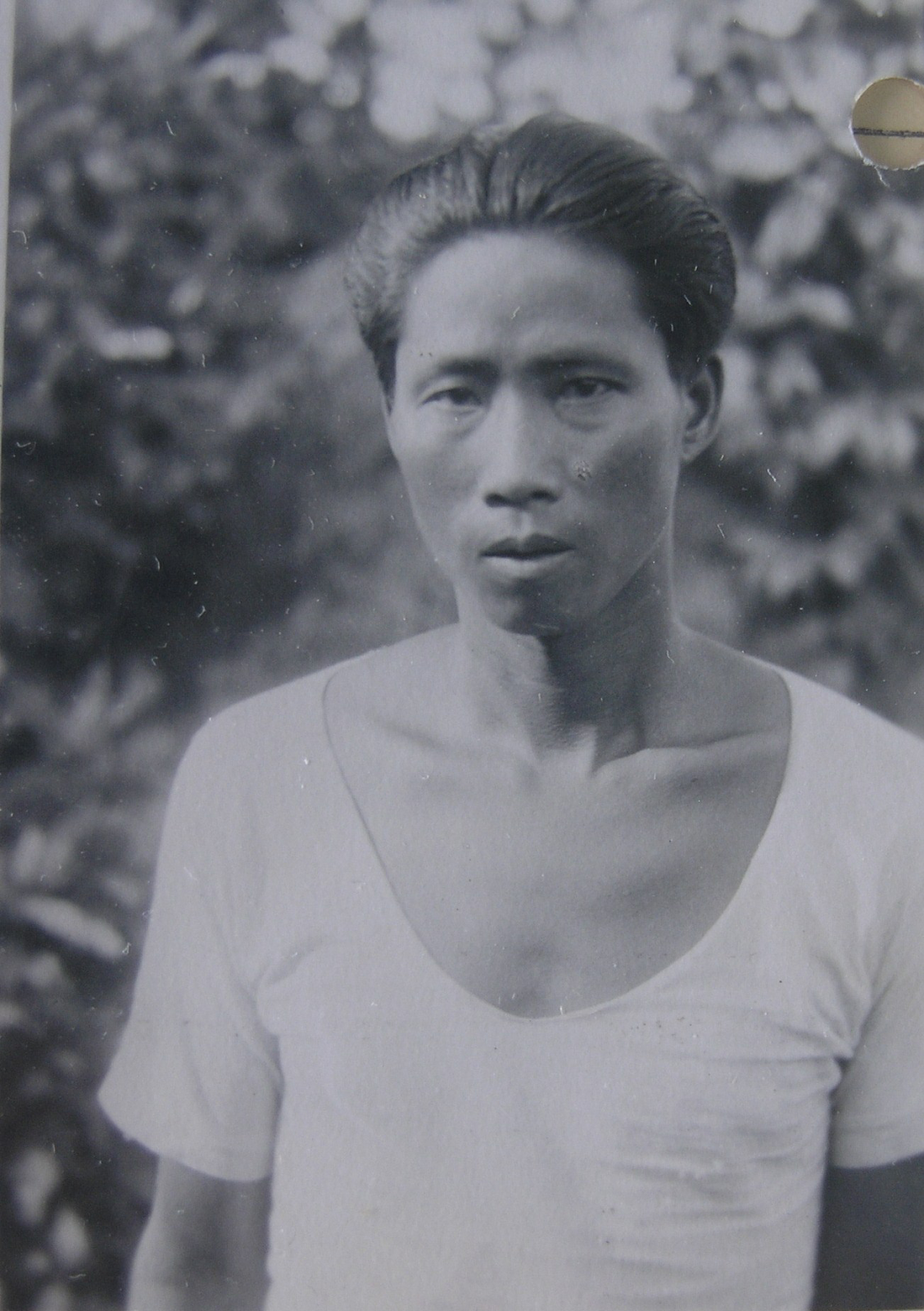
Maung Po Sein: A Shan Burman cultivator from the Katha district, Maung Po Sein was recruited on 1 June 1944, age 28.
Maung Po Sein: A Burman cultivator from the Upper Chindwin recruited by Major Peacock on 17 November 1943, age 23. Maung Po Sein was trained in Ceylon and India with the Hyena Special Group of Operation Character, deployed on 20 February 1945. By ‘Promotions’ on his file it says ‘Officer’s Mess servant’, but a note from Major Turrall indicates that he trained many of the 795 recruits for Hyena Red area, and that he was ‘present at many ACTIONS and AMBUSHES against the Jap.’ He remained in the field until 20 October 1945.
Jemadar Maung Po Sein: A Burman cultivator from the Upper Chindwin recruited by Major Peacock on 17 November 1943, age 22. Maung Po Sein was trained in Ceylon and India with the Otter Special Group of Operation Character, deployed on 23 February 1945. Lt.Col. Peacock recommended Maung Po Sein for the Burma Gallantry Medal for his actions on the Mawchi road, during which he lost an eye ‘while personally destroying enemy truck with Gammon grenade.’ Peacock described him as ‘[o]ne of our bravest men’ and ‘[t]he Karens liked him very well, and he made a very good leader.’
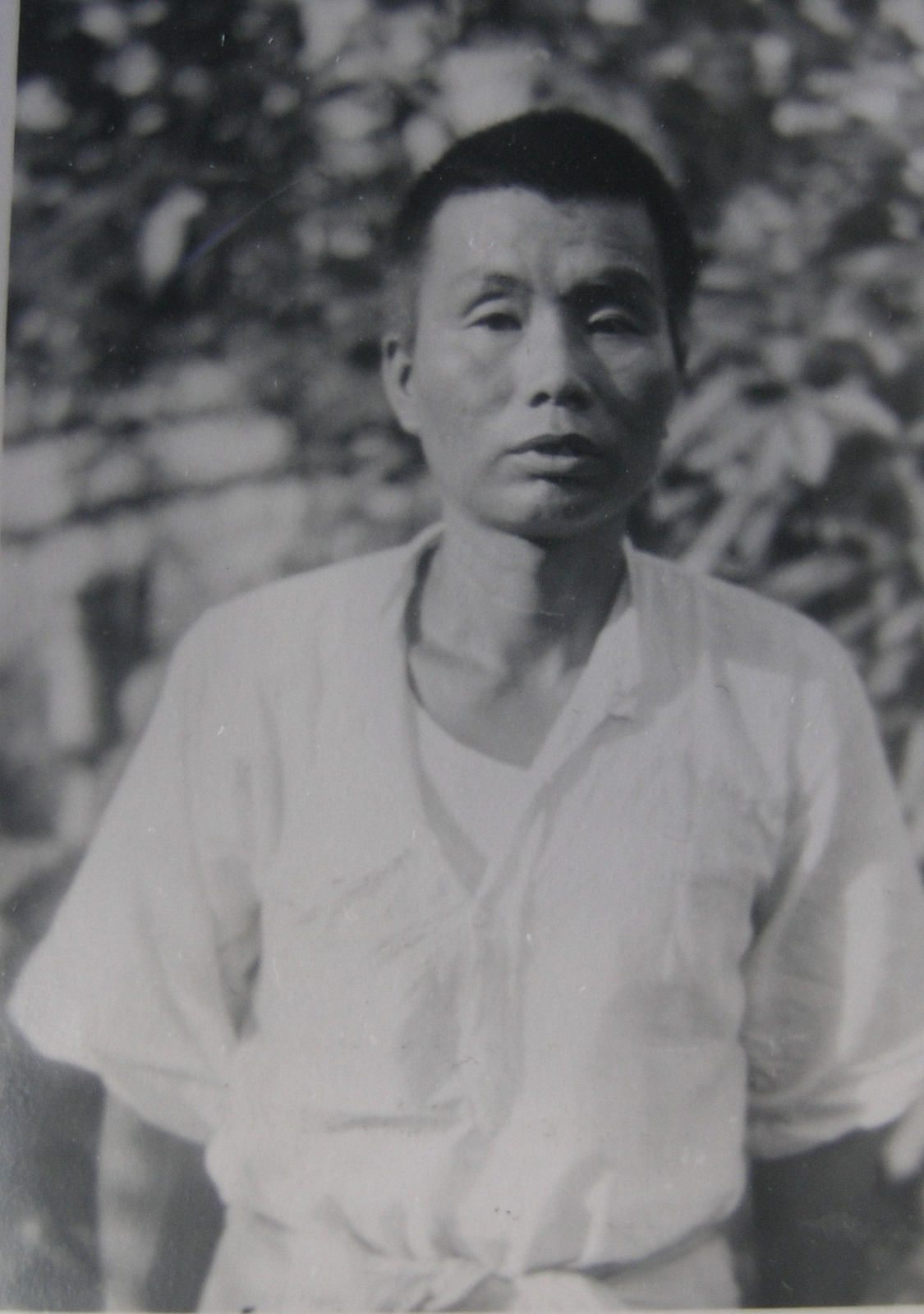
Maung Po Zonei: A Burman born in 1912 from the Myitkyina district, Maung Po Zonei joined Force 136 on 1 June 1944. He was sent out to India where he passed a filter course before parachute instruction and collective training in Ceylon. On 16 December 1944, Maung Po Zonei was deployed on Operation Rendezvous II, remaining in the field until 14 January 1945. He was ‘struck off strength’ from 31 May 1945.

Maung Po Zonei: A Burman born in 1911 from the Myitkyina district, Maung Po Zonei joined Force 136 on 1 June 1944. He was sent out to India where he passed a filter course before parachute instruction and collective training in Ceylon. On 16 December 1944, Maung Po Zonei was deployed on Operation Rendezvous II with Maung Po Zonei (above). After Rendezvous, this Maung Po Zonei completed a second operation, parachuting into Burma as part of Burglar, team Hippo, on 25 January. This operation remained behind the lines until 1 May 1945. Maung Po Zonei was paid off in the field on 12 May, with an extra month’s pay.
Maung Pun Kywe: A Burman farmer from the Upper Chindwin area recruited by P Force on 15 February 1945, aged 29. Served until at least 25 May on patrols on the Chindwin front.

Naik Maung Sa Kyai: Born in 1917, Maung Sa Kyai was recruited on Christmas eve, 1943. He served with P Force on the Chindwin front before withdrawing to India for further training as part of the Ferret Special Group under the command of Major Poles. In the field from 24 February to 22 October 1945, Naik Maung Sa Kyai proved a ‘good and thoroughly staunch N.C.O. [He was] in several actions and is brave and reliable.’
Lance Naik Maung San Din: Born in 1925, Maung San Din was 19 years old when he joined SOE on Christmas eve 1943. He was serving with the Kin Scouts before Major Peacock took him for P Force. Withdrawn from Chindwin patrols in May 1944, Maung San Din went to India and Ceylon for collective training before deploying on Rendezvous II in December 1944, and Burglar, team Hippo from 25 January to 1 May 1945. Unlike Maung Po Zonei above, he was not paid off in the field but ‘returned Calcutta 13.5.45.’
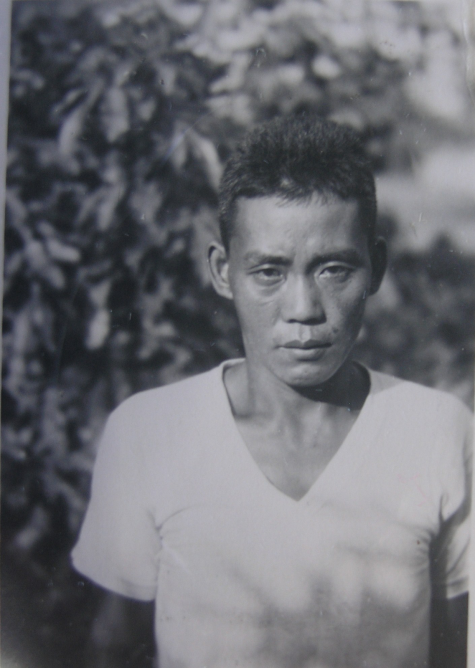
Maung San Htwe: A Shan Burman cultivator from Myitkyina district, recruited on 1 June 1944, aged 28.

Naik Maung San Kyi: Born in 1927, Maung San Kyi was 17 when recruited on 5 January 1944 by Major Peacock. He was withdrawn with P Force to India and Ceylon where he was trained as part of the Ferret Special Group under the command of Major Poles. Deployed on 24 February, Maung San Kyi, latterly a teenage farmer, remained on operations until 22 October 1945. Major Poles wrote: ‘Very keen fighter – brave and reliable – always cheerful in spite of any adverse circumstance.’
Maung San Mya: A Burman cultivator born in 1909, Maung San Mya was from the Mawlaik district and recruited on 1 June 1944.
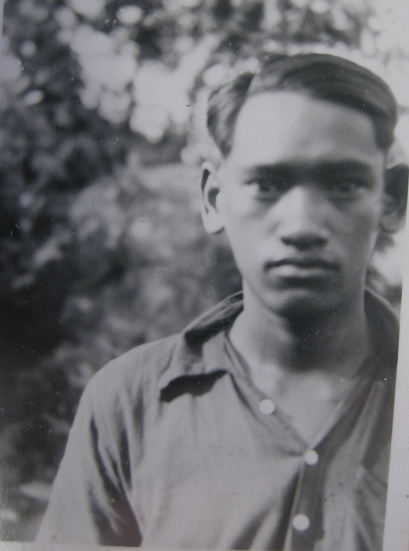
Maung San Win: A Shan Burman cultivator from the Shwebo District, Maung San Win was 25 years old when recruited on 1 June 1944.
Jemadar Maung Saw Lwin: Before Army service, Maung Saw Lwin was a supervisor for BISN & Co. Ltd (British India Steam Navigation Company). It is not clear when he joined the Burma Army Service Corps, but his first promotion to L/Naik is recorded as November 1940. Maung Saw Lwin was made up to Jemadar in March 1942, during the first Burma campaign. It appears that he joined SOE on 6 August 1944, but there is no indication of which operations he may have participated with. It is recorded, however, that on 27 June 1944 in Calcutta, he was charged with ‘[d]isobeying a lawful order of his C.O.’ for which he was ‘reprimanded’ and charged 23 Rupees.
Havildar Maung Shein: A Shan cultivator recruited by Major Peacock in 1944, Maung Shein was trained in India and Ceylon as part of the Hyena Special Group. He dropped into Burma on 20 February 1945 under the command of Major Turrall and remained in the field until 20 October 1945. Writing on 22 October, Major Turrall reported:

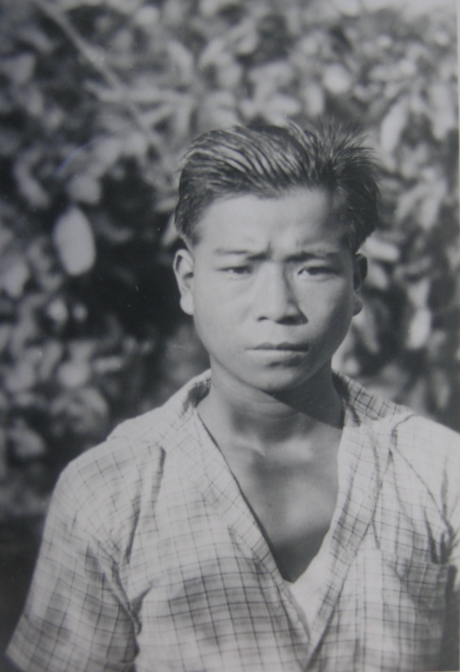
Maung Shin: A Shan cultivator from Myitkyina district, Maung Shin joined SOE on 1 June 1944 aged 20.
Maung Shwe: Maung Shwe was born in 1909 and came to SOE from the Burma Sappers and Miners in October 1944. He was trained as part of Lt.Col. Tulloch’s Walrus Special Group, and was dropped into Burma on 24 March 1945. Major Campell reported on 1 November 1945 that Maung Shwe was ‘[h]ard working and an efficient soldier. Honest and trustworthy. Intelligent. A first class cook. I would recommend him for any future employment.’ Maung Shwe wanted to join the Forestry Department.
Maung Sin: A Shan Burman cultivator from the Myitkyina district, Maung Sin was 36 when he joined SOE on 1 June 1944.
Maung Soe Nyun: Maung Soe Nyun was a Burman cultivator from the Upper Chindwin area who joined SOE on 14 December 1943, aged 27. He was with P Force until May 1944.
Maung Su: Maung Su was recruited in to SOE in October 1944 from the Burma Sappers and Miners. He was trained in India and Ceylon as part of the Walrus Special Group of Operation Character. He was parachuted into Burma on 24 March and remained in the field until 22 October 1945. After ten years in the Army, and seven months in the jungle, his only complaint was that he had not been promoted. He wanted to join the police after the war. Major Campbell wrote that he ‘would make a good N.C.O.’ and deserved promotion, and that Maung Su would be ‘the ideal man for the police.’
Lance Naik Maung Taein Pe: Often, as is the case here, there is just a single page which records the following:
‘Regtl. No. P45676
Rank: Lance Naik
Name: Maung Taein Pe
Father’s Name: Tha Thu
Religion: Bhuddist [sic]
Class: Burmese
Promotions: Lance Naik 17 February 1944 Authority: Major Peacock

Maung Tay Naung: A Shan Burman cultivator from Myitkyina district, Maung Tay Naung was recruited on 1 June 1944, aged 35.
Havildar Maung Tha Din: Born 1915, Maung Tha Din was recruited by P Force.
P Force was an SOE / Force 136 mission led by (then) Major Peacock in the area to the front of 20 Division on the Imphal front. See my book for more on the importance of this work to future Force 136 operations in Burma.
Extracted to India, Maung Tha Din completed parachute training at Chaklala and then went to Ceylon for jungle training preparatory to being dropped into Burma on Operation Character on 23 February 1945. He served under Peacock on the Otter part of the operation. He finished operations on 25 October 1945.
Contrary to what is, perhaps, a common perception, many Burmans like Maung Tha Din formed the nucleus of Special Groups on Operation Character, demonstrating that Karen and Burman fought the Japanese together – and that Character was not only a Karen operation.
Peacock described Maung Tha Din:
‘Burman. Good demolitionist. Fully trained. Not much to look at [he is recorded as being 5″4]. Quiet and unassuming, but very keen and willing. Did splendid work against the Japs on the road.’ The ‘road’ was the Toungoo to Mawchi road.
No PF for Maung Tha Din exists.
Maung Tha Hline: A Burman cultivator from the Upper Chindwin who was recruited on 5 January 1944, aged 18, by Major Peacock.

Maung Tha Khin: A Shan Burman cultivator from Myitkyina district who was recruited on 1 June 1944, aged 25.
Havildar Maung Tha Pe (P.45650): Maung Tha Pe, born 1919, was a Burman cultivator from the Upper Chindwin who is recorded as being recruited on 27 February 1943.
After service with P Force, Maung Tha Pe completed parachute instruction at Chaklala before going on to Ceylon for jungle training. He parachuted back into Burma on 23 February 1945 to serve with the Otter team of Operation Character. On 4 November 1945, Lt. Col. Peacock wrote: ‘Very quiet and unassuming, not much to look at but brave, and has been in actions against the Jap on and off the road.’
Naik Maung Tha Pe (P.45694): Born in 1923, this Maung Tha Pe’s record got mixed up with Maung Tha Pe above, but was corrected so that reports were (hopefully) written about the right man. This Maung Tha Pe was recruited on 5 January 1944, but like his comrade in arms, was trained in India and Ceylon preparaory to serving with Otter team. Peacock’s report for his Naik was somewhat different to his Havildar’s: ‘Brave and energetic in action, but a little waster outside, liable to get drunk at odd times.’
Maung Tha Shein: A Burman cultivator from the Upper Chindwin area, recruited aged 18 by Major Peacock on 15 February 1944. Served with P Force until May 1944.
Maung Tha Win: A Burman from Mawlaik district recruited on 17 November 1943, aged 32. Served with P Force until May 1944.

Maung Than Pe: A Shan Burman from Myitkyina District recruited on 1 June 1944, aged 25.
Maung Tha Zan: A Burman from Mawlaik district recruited on 5 January 1944, aged 27. Patrolled with P Force until May 1944. Maung Tha Zan still seems to have been employed by SOE by July 1944 when he was ‘reprimanded’ for ‘Conduct to prejudice good order and discipline. Improperly dressed on sentry duty.’
Lance Naik Maung Thein: Served with the Burma Sappers & Miners. Deployed on Operation Dilwyn, team Squirrel, under Lt.Col. Crosby.
Lance Naik Maung Tin: A Burman cultivator from the Upper Chindwin recruited by Major Peacock on 17 November 1943, aged 26. Served with P Force until May 1944.
Maung Tin (R1045): A Shan Burman cultivator from Myitkyina district recruited on 1 June 1944, aged 35.

Maung Tin (R1019): A Shan Burman cultivator from Myitkyina district recruited on 1 June 1944, aged 42

Maung Tun Khine: A Shan Burman cultivator from Myitkyina district recruited on 1 June 1944, aged 34.
Maung Tun Kywe: A Burman from the Upper Chindwin who was initially recruited for P Force patrols, Maung Tun Kywe was then trained in India and Ceylon for further operations. He was deployed on Operation Character, team Hyena, on 20 February 1945. Major Turrall reported that he helped train many levies, was in action against the Japanese on many occasions, and that he never complained.
Maung Tun Nyan: A Burman cultivator from the Upper Chindwin recruited on 15 February 1944, aged 19. Served with P Force until June 1944.

Jemadar Maung Tun Sein: Initially recruited for P Force in January 1944, Maung Tun Sein was extracted from the Chindwin area to India for further training. He parachuted into Burma with Major Poles on 24 February 1945 to serve in the Ferret Special Group of Operation Character. Major Poles described him as ‘[a] most excellent officer, very brave and dependable, with the capacity to command. Level headed and clear thinking.’

Naik Maung Tun Shein: A Burman cultivator recruited in January 1944, aged 18. Maung Tun Shein was trained in India and Ceylon preparatory to dropping into Burma with Major Poles as part of the Ferret Special Group of Operation Character. Major Poles described him as ‘[a]n extremely fine young N.C.O. Staunch, hard working and reliable.’
Lance Naik Maung Tun Wa: A Burman born in 1904 from the Upper Chindwin who served with P Force before completing collective training in India and Ceylon. Maung Tun Wa parachuted into Burma as part of Operation Ramrose, team Rhino, on 22 January 1945. He landed in a tree and sprained his ankle, thereby being unable to walk for several weeks, he looked after the Q side of the operation. Major James wrote that Maung Tun Wa was ‘an honest old warrior but handicapped by age and failing eyesight.’
Maung Tun Win: A Burman recruited on 5 January 1944 in the Upper Chindwin area for P Force, aged 20.
Maung Tun Yon: A Burman cultivator from Mawlaik district recruited on 15 February 1944 for P Force, aged 18.
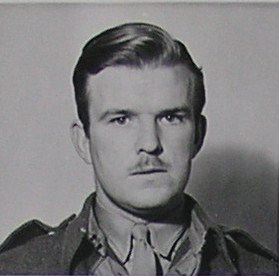
Major Menotti Garibaldi McAdam: born 20 July 1919 in Glasgow, McAdam was training to become a chartered accountant when the war started. He joined the infantry on 3 September 1939, was commissioned on 9 March 1940, and was in the Royal Armoured Corps from 1 December to 28 March 1943. He then joined SOE and was posted to Force 133.
With Force 133, McAdam was trained in Palestine before dropping into Greece on 17 May 1943. With Greece liberated, he was extracted to Cairo on 19 November 1944. He won the MC and a MiD for his work in Greece. In Cairo, he was admitted to hospital with malaria. After a short period in the UK, McAdam left for India on 15 March 1945. Joining Force 136, McAdam was dropped into Burma on Operation Nation with 2/Lt. H.M. Moore, Sgt. J. Edgar, and U San Tin as team Giraffe.
From Burma, McAdam went to Malaya, where he worked with the guerrillas but he ‘complained of forgetfulness, nervousness, and inability to do his work.’ Extracted to Singapore, McAdam used his service revolver to attempt suicide. He shot himself in the head, but appears to have survived, as a note says he is ‘not in a fit state to attend a court of inquiry’. His personnel file contains witness statements which claim he was recovering well and that the MO did not expect him to attempt to take his own life. It was the MO’s opinion that the work he had been engaged on had ‘contributed to his mental state’.
Major Rowan McCombe: born 10 August 1907 in Rathfrilan, Ireland, McCombe was in the RAMC. He joined SOE in January 1943 and was sent to India as medical officer for the guerrilla training unit. For reasons unknown he was taken off strength of Force 136 in April 1944, but he was evidently taken back on because he was deployed into Burma on Operation Heavy with team Wolf from 15 August 1945.
Personnel file: HS 9/956/3
London Gazette: Promotion Nov 1939
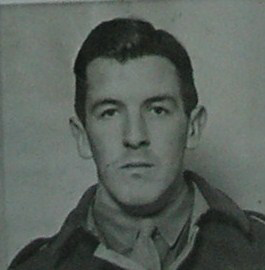
Major Denis Cecil McCoull: McCoull was born on 7 April 1918 in Wylam-on-Tyne in the north of England. He was educated at Sherborne Prep School and Epsom College between 1928 and 1935, and then went to work for W H Smith & Son Ltd. He was commissioned in the 4 Royal Tank Regiment, TA, on 13 June 1937. Until 1943, McCoull appears to have remained in the UK, going to the Middle East in June 1943. After a month in theatre, he was picked up by SOE.
With SOE, McCoull served with Force 133 from July 1943 to January 1945. After paramilitary and parachute training in Palestine, he was 2i/c of No.2 area in the Thessaly region of Greece from September 1943 to November 1944 serving under Major Power.
From 18 March 1945, he served with Force 136. He was dropped into Burma on 27 April 1945, serving with Capt. Mirehouse and Sgt. Bailey on Operation Nation, team Cow in the Bilin area. The team did well until the Japanese made a concerted push against the Nation teams in lower Burma, and Cow was forced north, joining the Mongoose area of Operation Character.
Personnel file: HS 9/692/1
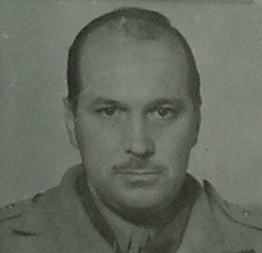
Major Jack McFarlane: born 5 August 1913 in Sunderland, McFarlane was in the Shanghai Police for six years before the war. He joined the 11 Sikhs in 1939, and saw service in Burma during 1942 as liaison officer with the Chinese Expeditionary Force. For his work in the first Burma campaign he was MiD and awarded the Chinese Order of Land, Sea And Air. After joining SOE he was trained from March to August 1944, and it would appear that he went on Operation Spiers from August 1944. In January 1945 it was recommended that he go home to the UK to recover from malaria, Scrub Typhus and Tick Fever. Meanwhile, his sister was interned in Shanghai by the Japanese.
Personel file: HS 9/959/7
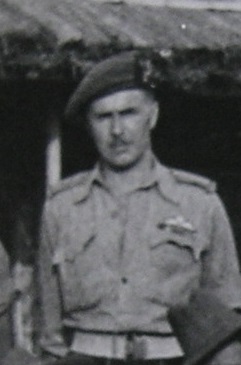
Major Macleod, clipped from photograph at top of page: TNA HS 7/107
Major John Macleod: Macleod was a research scientist before the war, having completed his education up to PhD level. His first years of the war were spent as Chief Instructor of a Home Guard battalion until joining the regular Army in January 1943. Commissioned into the Seaforths, by November 1943, Macleod, at 37 years old, was employed as an instructor by SOE.
Many of the training school’s reports about Macleod’s character would make pretty grim reading for him, for example ‘is only of average intelligence’ and ‘regarded as something of a joke’, but he was also described as ‘fearless’ and ‘suited for active work’.
Sent out to instruct at ME 25 in Ceylon in mid 1944, Macleod was parachuted into Burma in February 1945 as part of Operation Character team Otter. On about 26 March he was shot through the shoulder by the enemy, and was described as ‘seriously wounded.’ Nonetheless, he remained in the field until exfiltrated on 29 July. Lt.Col. Peacock described Macleod as having shown a ‘splendid example of fortitude and devotion to duty.’
Personnel file: HS 9/968/2
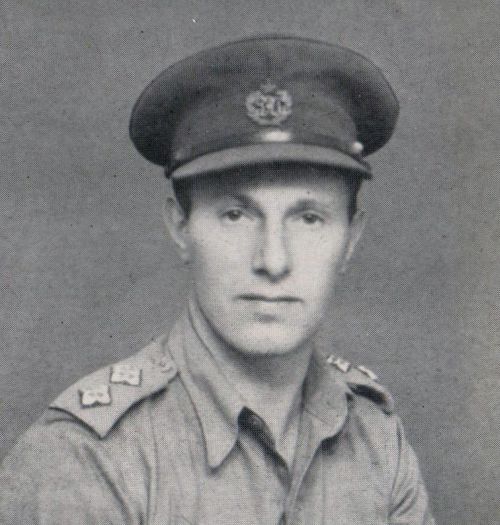
Picture credit: The Soldier’s Burden
Captain Eric John McCrindle: McCrindle was commissioned as Army of Burma Reserve Officers (ABRO), number 441. He was born in Purley, Surrey on 16 March 1912.
McCrindle joined SOE in September 1942, and was flown into Karenni in December 1943 as part of Operation Harlington. Operation Harlington was the name given to the operation to raise the Karens before it became (the now more well known) Operation Character in 1945.
McCrindle joined Seagrim and Captain Jimmy Nimmo (Nimmo having been successfully dropped in October 1943). The three officers set themselves up in the jungle with W/T and were sending back intelligence from Burma until February 1944, when it all stations went off air.
It was eventually reported by Saw Jolly of SIS that that the Japanese had attacked McCrindle’s camp and he was ‘killed instantly being shot through the head, private parts and leg.’
Captain Nimmo was also killed, but Major Seagrim managed to escape. A cover story was used until 1945:

One of the few Force 136 officers to die in battle. In memoriam:

Personnel file: HS 9/957/1
Scottish Herald article, 1989

Captain Alistair Miller McNab: born 1 August 1908, McNab was educated at King William’s College from 1923 to 1928. He then worked selling cotton goods in Java until 1931 before joining an advertising agency until 1934 and becoming Secretary of the Travel and Industrial Development Association until December 1940. He joined the Highland Light Infantry until an MI5 trace on 28 November 1941 led him to SOE.
Between the end of 1941 and leaving for India on 26 September 1943, McNab attended training courses with a view to becoming an instructor. His SOE school reports are mixed with one describing him as ‘exceptionally smart’ and another stating he was ‘only of average intelligence’. He was posted to ME25, the SOE training school in Ceylon, but despite his file indicating that he would attend an intelligence course in Karachi in April 1944, other Burma files reveal that he went operational for most of 1944. He was part of Operation Corton, see my post HERE for details.
After Corton, in December 1944, it appears that McNab ‘requested repatriation’, and since the head of Burma Country Section, Lt.Col. Gardiner was ‘not certain’ that he was ‘of a satisfactory operational type’ with any ‘special qualifications for Burma, it was proposed that he kept him for ‘odd jobs’ until a decision on what to do with him was reached. There is consequently a gap between December 1944 and February 1946 when McNab was struck off strength of Force 136. Presumably he wasn’t kept doing ‘odd jobs’ for over a year!
Personnel file: HS 9/970/5 (incorrectly spelt ‘McNabb’)
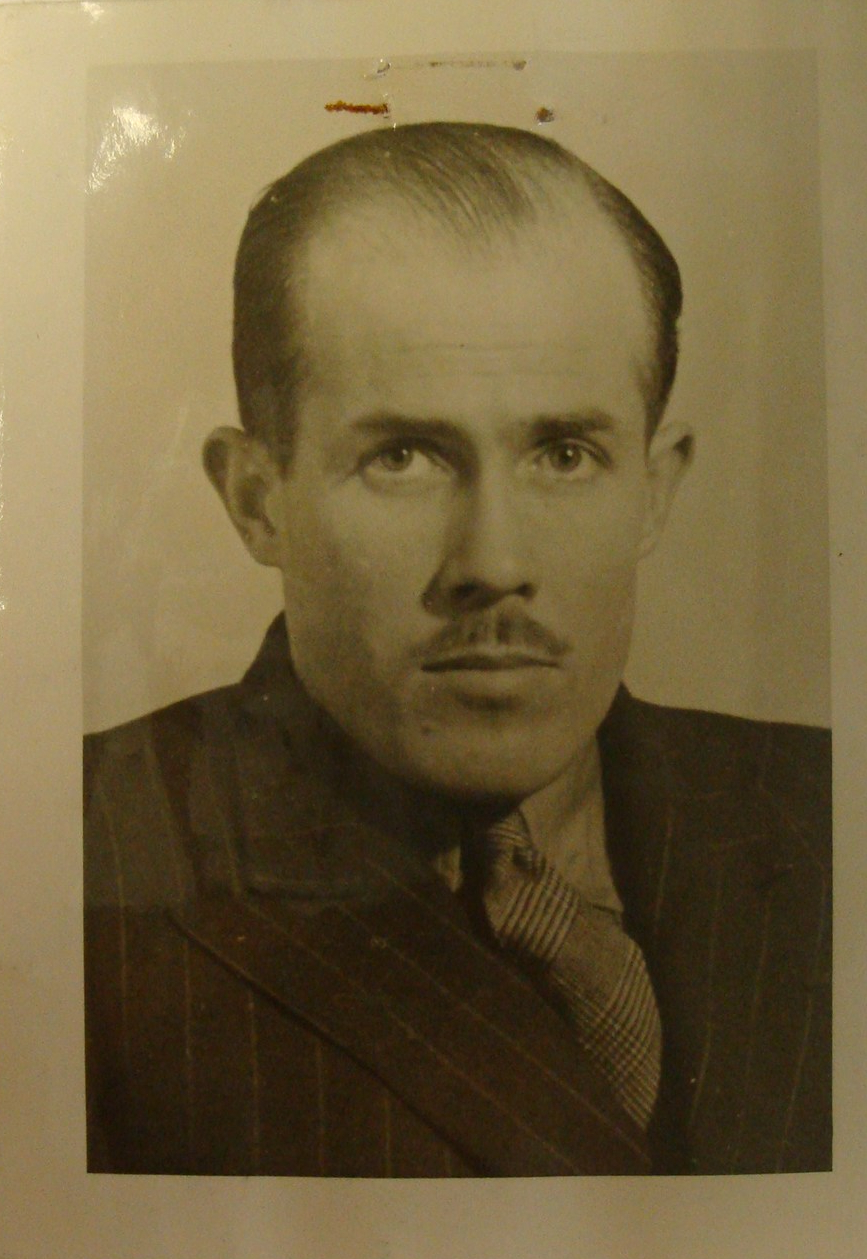
Captain Ronald John Meredith: Born in Chile on 3 April 1913, Captain Meredith is one of the few officers who was killed in action in Burma. He left Chile in 1940 to join the Army in the UK. From July 1940 to February 1941 he served in the ranks with the Royal Scots. From February to May 1941 he completed officer training and was then commissioned into the Lancashire Fusiliers. Before volunteering for war service, Meredith was employed as a company secretary, and had served two years ‘in Anti-revolutionary Militia’ in Chile.
An MI 5 trace shows that Meredith was picked up by SOE in July 1941, initially to be employed as an instructor. Meredith went on operations in January 1945 as part of Operation Label team Rat. He was killed on 26 January when the Japanese attacked the monastery where the team was hiding up. Lt.Col. Maddox investigated the death of Meredith in January 1946, and reported that:
‘The British party scattered, leaving all they had, and it was then that Capt. Meredith was believed wounded and later found dead in a sitting position leaning against a clump of bamboo about 100 yards North West of the monastery. The villagers found him with an empty carbine in his hand and a shot through his forehead.’

Poppy photo from Flower Meaning
Personnel file: HS 9/1022/5
Major Pierre Charles Meunier: a French Canadian born 9 October 1917, Meunier joined SOE at the end of 1943. His training reports show that his instructors were sceptical of using him on operations due to security concerns, and thought he was only interested in promotions and decorations. He went on to complete two operations in France. The first deployed pre-D-Day, from 10 April to 11 August 1944, in the Bordeaux area. It was the Aristide circuit. The second deployed on 31 August until 30 September in the Massif Central.
Meunier then went to the Far East where he was deployed on 30 March 1945 as Jackal of Operation Nation. He was one of five Jed teams to be deployed that night to ensure that the Burmese nationalists would cooperate with the advancing Allied Army. For this operation with Force 136, Meunier was MiD.
Personnel file: HS 9/1026/4
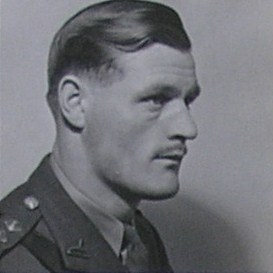
Major Frederick Stanley Milner: Born on 26 March 1916, Milner attended the Duke of York’s Royal Military School from 1927 – 1934. On leaving school at 18, Milner joined the Wiltshire Regiment, with whom he served in Palestine (1936-7) during the Arab Revolt.
In 1939, Milner went to France, returning via Boulogne in 1940. Attending OCTU, Milner was commissioned into the Dorests in December 1940, and promptly recruited by SOE as an instructor.
While instructing at STS 4 in 1941, Milner was injured when a grenade splinter lodged in his neck. The Royal Surrey Hospital returned him to duty without removing it! Later, at STS 103 in Canada, Milner suffered second degree burns when the ‘Silent Soldier’ grenade thrower he was demonstrating spontaneously ignited.
After a spell in North Africa and Corsica during 1943 – where he ‘worked well with Americans’ – Milner was posted to India where he joined the Burma Country Section of Force 136.
On 26 March 1945, his 29th birthday, Milner was dropped into Burma on Operation Character where he was in charge of station Mongoose, area White. On this operation, Milner was recommended for the Military Cross twice, the second time for immediate award. This was for his work during the Battle of the Breakout in July-August 1945, when his Karen guerrillas inflicted an estimated 300 casualties upon the Japanese who were trying to cross the Shwegyin Chaung. He was described as ‘A brilliant and fearless leader’ who was respected by ‘all the Karens.’
Personnel File: HS 9/1038/6

Captain John Newton Seymour Allen-Mirehouse: born 9 December 1915 in Taunton, Somerset, Mirehouse was educated at Eton 1928-1933. From 1934-36 he served as a reservist wth the Wesh Guards, and then he joined the Welch Regiment as a regular in 1936. From 1936 until the war, he served in Britain and Northern Ireland.
Apart from some training between December 1941 and joining SOE in June 1943, his file does not give away much of what he was up to. He was picked up by SOE to be an instructor, which he was at STS 45 Danish Section for eight months or so. He left the UK for India on 15 March 1945 and appears to have been dropped into Burma in April 1945 as Jedburgh team Cow on Operation Nation.
Both Allen and Mirehouse are gentry names from Pembrokeshire. See more here: Allen
Personnel file: HS 9/1040/3

Captain Donald Haydn Thurston Mollison: born 3 February 1916 in Kamakura, Japan, Mollison served in France with the BEF in 1940 and then spent almost two years in the UK before going out to India in May 1942. He was commissioned in November 1942 and his parent regiment upon joining SOE is recorded as the 8 Punjabs. After completing an Intelligence course in Karachi, he joined SOE in October 1943 serving with 201 IFBU attached to 17 Division during the battles of Imphal and Kohima.
From July 1944 he was sent to Canada to recruit Japanese speaking Canadians, but due to political obstructions it took much longer than expected and he didn’t return to India until July 1945. During this time, his position as GSOIII had been fulfilled by Captain Henderson. There was considerable animosity in India towards Mollinson for being gone for so long and not receiving any communication from him, but his file makes it clear that there had been communication with London and the four month delay in being able to recruit was not his fault (didn’t they know there was a war on!).

With thanks to Andrew Marshall for finding this article
And this Obituary
Personnel file: HS 9/1047/1

Captain John Cook Montague: On 17 January 1944, MI5 ran a trace on John Cook Montague, born 20 June 1913 in Manchester. Montague came back ‘clean’, but he had already been through SOE training in Haifa, Palestine between August and October 1943.
Montague’s PF is probably one of the most detailed, revealing an extensive war record, serving in Finland, Sweden, Egypt, Iraq, Syria, Lebanon, Palestine, Algeria, France, Ceylon and Burma. In 1939, Montague was refused entry into the British services because he worked as a transport manager, which was a reserved occupation. Enlistment in a Volunteer Company for Finland was not restricted, so issued with British Battle Dress, a short Lee Enfield and Great Coat, off he went to Finland. Montague returned to the UK via Sweden in November 1941. Since ‘I no longer had any “occupation”, I was accepted’ into the Royal Armoured Corps at Tidworth in December 1941.
Picked up for officer training in April 1942, by December that year Montague was at sea en route to the Middle East where he served with 45 RTR, 4 RTC and 2 RTR between January and July 1943. He then joined SOE and was trained in Palestine, completed Jedburgh training in the UK, and was sent out to Algiers preparatory to operations in France. In France, Montague fought with the Resistance, winning the Croix de Guerre and being MiD. He was operating in the L’Ardeche region of France between 28 June and 26 September 1944.
After a short time in the UK, Montague was shipped out to Ceylon for jungle training at ME25 in Ceylon before being dropped into Burma as part of Operation Character, serving as part of Otter. As commander of sub area Green, he was responsible for guerrilla operations against the Japanese on the Toungoo to Mawchi road, described as ‘continuous’, from 23 April to 16 August 1945. He was withdrawn from Character on 24 October 1945 having been deployed on 23 February. Lt.Col. Peacock described Montague as ‘one of my best officers’, and he was awarded the MC for his work in Burma. Part of his recommendation reads: ‘On the numerous occasions in which he has been in action he has always shown gallantry and powers of leadership worthy of high commendation’.
The Major in charge of the Jedburgh board had reported:
‘A dour determined man, who is mad keen for action. Rather taciturn, and does not stand out as a leader. He would make a very excellent and trustworthy 2i/c.’
It was noted elsewhere in his Jed reports that he had ‘Rather a grim appearance on first sight’ which, it was thought, would compromise his leadership ability.
In another report: ‘He is a bad influence on the others and I strongly recommend his removal.’
Personnel file: HS 9/1052/6
S/Lt. H.M. Moore: served with Major M.C. McAdam, Sgt. J. Edgar and U San Tin on Operation Nation, Jed team Giraffe from 27 April 1945.
Corporal John Muir: born 18 April 1919, in Motherwell, Scotland, Muir was a shipping clerk in peace time. He was taken on by SOE as a W/T operator just after his 23rd birthday, in 1942. He left for India in June 1942.
In the book Kelly’s Burma Campaign, the author, Desmond Kelly, reproduces a letter from his father to his mother dated November 1942:
‘I have the Oriental Mission wireless set in the area now, and the corporal in charge – in return for small kindnesses such as the loan of some crockery, etc. – has offered on the Q.T. [quiet] to put through any private messages I wish to send to their agency at Calcutta whence he could arrange with a friend of his there to have them sent on by telegraph.’
The corporal referred to is most likely Muir, as there was only one SOE run W/T in the hills at this time.
Muir was MiD for his work in the Chin Hills during 1943, his W/T being ‘the only means of communication between 4 Corps H.Q. and forward Army units.’
Personnel file: HS 9/1072/10

Photo credit: TNA, HS 9/502/5
Colonel Paul Hector Munro-Faure: Munro-Faure was born in Switzerland on 1 September 1894. He married in 1922 and had two sons, born 1924 and 1925. He is recorded as first being commissioned in 1912 on the Special Reserve with 4 Battalion the Sherwood Foresters. He served in France with the 1st and 2nd battalions in 1915-16, and then in East Africa 1917-18 with the King’s African Rifles. From 1919 to 1941, Munro-Faure was employed by the Asiatic Petroleum Company in China. He was recalled to the Army in May 1941, and served in the Maymyo Bush Warfare School from July to December of that year. During 1942 until June 1943, Munro-Faure trained guerrillas in Eastern China as part of 204 China Mission.
He joined SOE on 17 June 1943 with the rank of Lt.Col and was sent to Kunming in China as a Military Liaison Officer working out of the His Britannic Majesty’s Consulate. His task was to ‘establish cordial relations with the Chinese Army’ in order to establish routes into Burma for SOE agents. He was also tasked with assisting the Myosa of Kokang by training and arming his men. A final task was to establish guerrilla training facilities for work in Burma. His area of operations was to be the Lashio – Bhamo area of Burma, and the Lashio – Mandalay railway. The operation was code-named Spiers.
Munro-Faure left SOE in August 1944 and asked for home leave as he had been away six years. Granted home leave after a few months kicking his heels in India, he was posted to a holding battalion in Nottinghamshire. A letter intercepted by the censors reveals that he wanted to go back to China, where he had been training guerrillas before joining SOE.
Personnel file: HS 9/502/5
Behind the Frontlines in Burma, by PH Munro-Faure
For more on 204 Mission, see Kieth Stevens, ‘A Token Operation’ (journal access required).
Mwi Phu Yawng: A Kachin from Myitkyina district recruited on 1 October 1943, aged 25.
Mya Maung : A Karen born in 1915, Mya Maung was recruited in Mandalay on 17 October 1942. He completed a week of training at Poona before going to Nazira (OSS base) for signals training. After parachute instruction at Chaklala in January 1943, Mya Maung was parachuted into Burma on 19 January on Operation Flimwell. There is a redacted page on his record which only reveals that he was interviewed in Calcutta on 25 September 1943 (actually 1945). See blog HERE
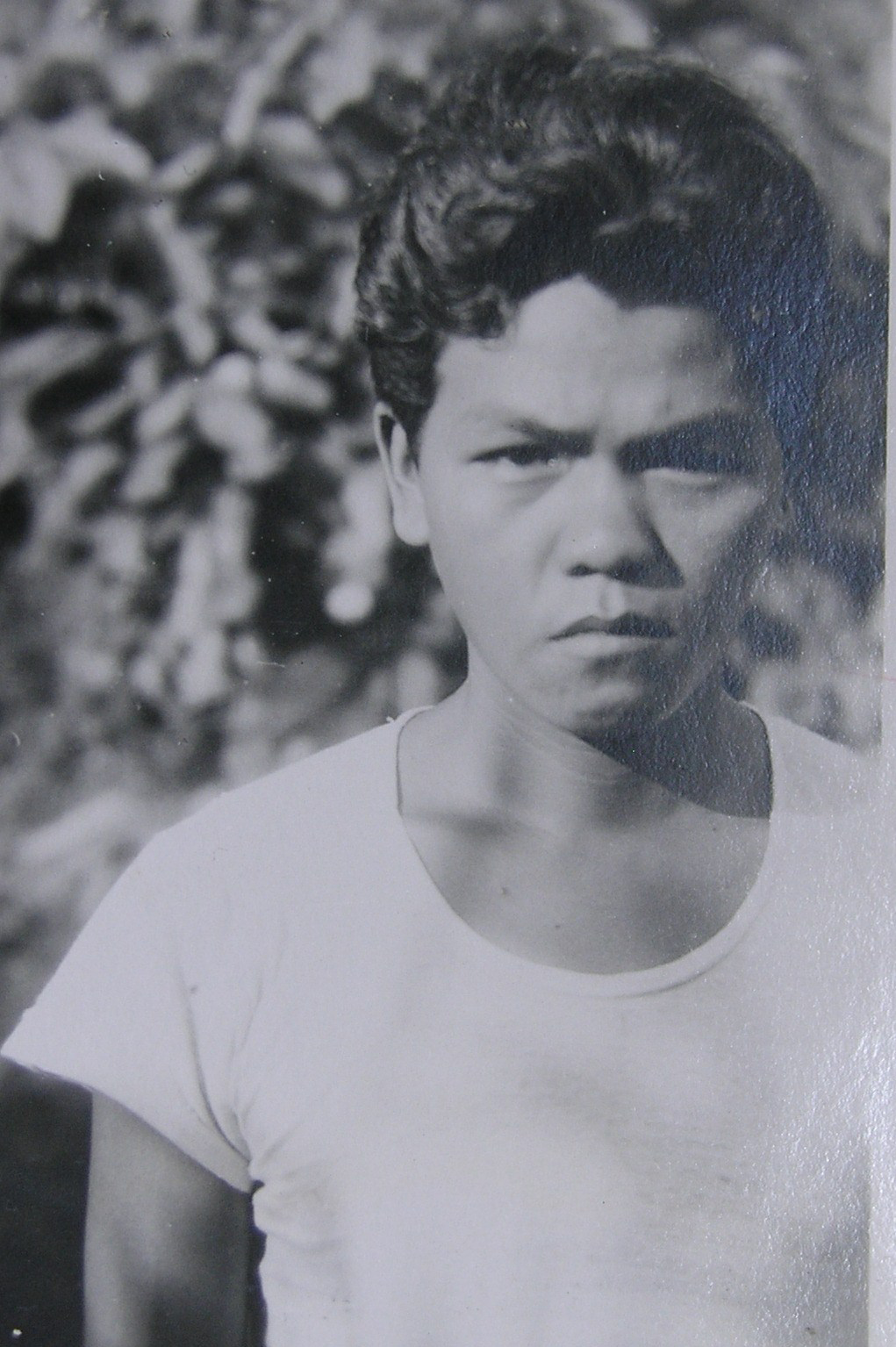
Mya Maung: A Shan Burman cultivator from Katha district recruited on 1 June 1944, aged 23.
Havildar N’dau Chan: Before joining SOE, N’dau Chan was in the Burma Frontier Force. He remained in Burma in 1942, so was recruited in the field in 1944 by Operation Spiers. After training in India, N’dau Chan was parachuted into Burma to serve with Lt.Col. Crosby on Operation Dilwyn, team Squirrel. Apart from being described as ‘[c]ompletely fearless’ and someone who ‘loves risks’, Crosby wrote:

Wounded in action in May 1945, N’dau Chan was evacuated to hospital by the OSS, and later he was awarded the Burma Gallantry Medal.
Lance Naik N’Dau Naw: A Kachin who served in the 4th Burma Rifles from 1 December 1939, N’Dau Naw was from Myitkyina district. He joined SOE in October 1943, aged 23.
Nawng Tau: A Kachin from Myitkyina district who joined SOE in October 1943, aged 25.
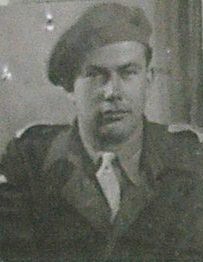
Major Ian Selby Nevill: Major Nevill was born in Nahoon, South Africa, on 19 December 1912. He was educated at Ampleforth College in Yorkshire 1924-29 before working as a Motor Trader.
Granted an emergency commission in the Intelligence Corps in May 1940, Nevill saw service in Libya as 2 I/C of 4th Battalion Libyan Arab Force before joining SOE. On 14 September he was parachuted into Greece where he organised the Andartes in guerrilla raids against the Germans. Evacuated ill in May 1944, he returned to the same area in August and remained in Greece until 17 December 1944. For his work in Greece, Nevill was recommended for a military MBE, but was awarded the MC.
Nevill then volunteered for service in the Far East, being described as ‘very anxious to go to India’. It appears that Nevill’s Greek service did not preclude him from being tested for suitability for work in the Far East. Here is the resulting report:
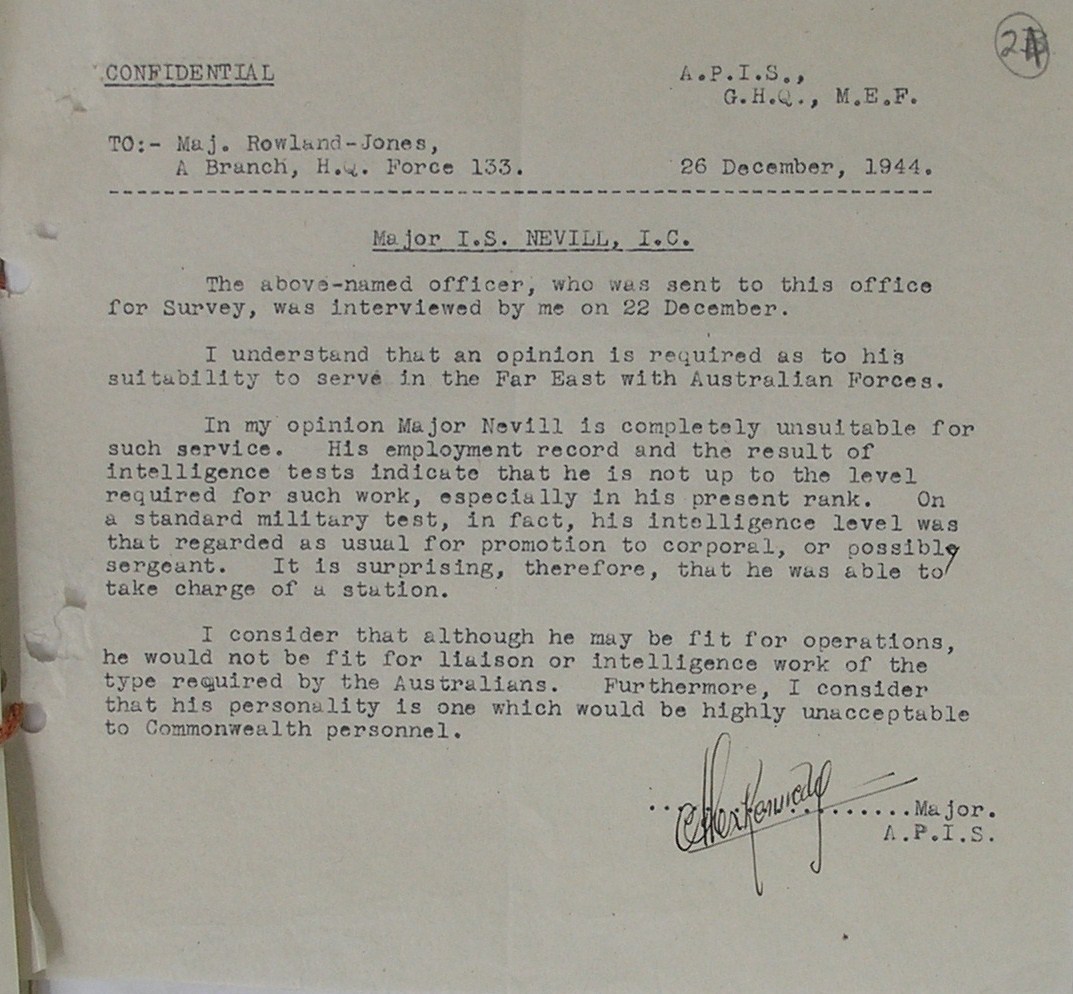
After a period of uncertainty in which Colonel Woodhouse of Greek section vouched for Nevill, he was posted to Burma Country Section of Force 136. Nevill was parachuted into Burma on 27 April 1945 on Operation Character as commander of Hyena Purple. He showed ‘consistent gallantry and devotion to duty of the highest order’, according to his recommendation for a DSO, leading Karen levies into action and accounting for 1533 Japanese in three months to August 1945.
Personnel file: HS 9/1094/4
Knight of the Royal Order of King George 1: London Gazette (For Greece)
Military Cross: London Gazette
Mr Newton Joseph: born 26 September 1920, Newton Joseph was the Indian son of a Baptist Reverend. He was in Rangoon studying Wireless Telegraphy at the Kamein Institute when the war started. He was recruited for his knowledge of radios almost immediately, and then selected to join SOE’s Oriental Mission. He continued to serve with SOE in a number of roles until the end of the war. From March 1942 to June 1943, he was responsible for a radio station in the Chin Hills. He was then a W/T instructor at ME 9 before joining the IFBUs. With the IFBUs he was posted to the Chindwin just in time for the Japanese advance on Imphal. He served throughout the Battle of Imphal, broadcasting to the enemy to try and get them to surrender.
On Christmas Day 1944, Newton Joseph was in the jeep accident which killed four men, including the IFBUs commanding officer, Lt.Col. Steer. Newton Joseph was lucky to survive, but as soon as he was recovered he advanced into Burma with the IFBUs until recalled to India in March 1945. He had been earmarked for participation in Operation Dracula, the seaborne invasion to recover Rangoon, but he never received orders to go. He subsequently got posted to Rangoon after it was bak in Allied hands, and ran station ASH, the all important W/T link between the Army and the Force 136 teams in the field. He claims this was ‘boring’, and having met Major Turrall of Operation Character, he asked if he could join him in the field. This was approved, so Newton Joseph served with Team Hyena of Operation Character until beyond the end of hostilities.
Despite three officer recommending him for a commission, Newton Joseph remained a civilian, but was awarded the British Empire Medal for his war.
Personnel file: HS 9/1098/2
Ngam Za Mang: Part of Operation Label, team Rat, which parachuted into Burma on 22 January 1945. After their two British officers were killed in an ambush, Ngam Za Mang made it back to British lines with Jemadar Chin Pau.
Ngun Khul: A Chin policeman in civilian life, Ngun Khul was recruited from the Chin Levies into SOE on 1 October 1943. During Chindwin patrols he was Captain Cope’s orderly. Captain Cope reported that he was brave and hardworking, so after parachute training at Chaklala, Ngun Khul completed two operations with SOE. On 2 December 1944 he was deployed on Operation Bottom until 31 January 1945. On 20 February he was dropped again, this time on Operation Heavy with team Wolf. Major Pennell reported that he did ‘excellent work on patrols.’

Major Jimmy Nimmo: Photo credit see BBC People’s War
Major James Russel Nimmo: Major Jimmy Nimmo was born in Falkirk, Scotland, on 26 June 1912. Jimmy Nimmo was shot dead by the Japanese when they attacked his hideout in February 1944. Nimmo had been parachuted into Burma in October 1943 as part of Operation Harlington, tasked with contacting Major Seagrim and the team of Karens who had been parachuted in the previous February.
Nimmo officially joined India Mission in November 1942, although he had been employed by the Oriental Mission prior to this. Nimmo retreated with Captain Thompson to Fort Hertz during the first Burma campaign. In his book, Desperate Journey, Thompson wrote: ‘Nimmo, a quiet young Scot who, more than anyone, was responsible for our eventual survival.’
Nimmo was awarded a DSO for his part in Operation Harlington.
Personnel file: HS 9/1104/5
More on the Nimmo family from the Falkirk Community Trust

Major William Nimmo: Bill Nimmo, younger brother of Jimmy Nimmo (above), was born 21 March 1918. War came while he was still a student, but he received an emergency commission on 2 September 1939 the day before war was declared. His regiment was the Argyll & Sutherland Highlanders.
Bill Nimmo served as a demolitions officer with the Chindits before joining SOE, winning the Military Cross for his part in Thursday. He then completed two operations with Force 136, the first of which was codenamed Bison where he served with Major John Hedley, 22 January to 3 April 1945. His second drop into Burma was to join Operation Character, team Otter, area Blue from 1 May 1945. His SOE file has a citation for a second MC for his work with SOE:

See Hedley’s Jungle Fighter
Personnel file: HS 9/1104/6
Obituary in Scotland Herald
Nun Wei: Nun Wei was dropped into Burma with team Dog on 24 April 1945. His Jed team consisted of Major Clowes, Major Chasse and Sergeant Cornick. Dog was part of the Nation operation, working with Burmese nationalists. The team met Nun Wei the day before the operation was launched, and they soon sent signals back reporting that they wanted to leave him in Pyapon as he was ‘utterly useless as an interpreter or anything else.’ Nun Wei was duly paid off on 7 May.
Nyo Tun, alias Khin Oo, Galahad, and Hla Maung: Arakanese, born Kyauktaw, 1913. Nyo Tun was brought to India in February 1944 by Tin Shwe after his first operation into occupied Burma. His father was a rice miller and land owner. His record describes him as ‘slightly anti British and very nationalistic’ as well as a ‘senior member of Thakin So’s [sic] anti-Jap party’. He was the nationalist leader for the Arakan region, described as ‘the man to whom all anti-Japanese Arakanese are looking to give them aid against their enemies.’ His interrogation report from March 1944 reveals that he avoided arrest at the start of the war by going into hiding. After the Japanese arrived he reappeared, and was attached to the Japanese General Staff as an adviser between May and August 1942. His British interrogators had ‘no doubt of [the] genuineness’ of the intelligence with which he and Tin Shwe returned to India in February 1944, so plans were made to return him to Rangoon with a W/T set. See blog post ‘Only Rohingya?’
Havildar Nyunt Yin: Nyunt Yin was a Sgaw Karen from Myaungmya in the delta region in southern Burma. He enlisted in the Burma Army Signals on 28 May 1941 and was a 3rd class W/T operator. He received specialist W/T training at Nazira in late 1942 (Nazira was the OSS base in India). Most of 1943 was spent training. Apart from paramilitary and parachute instruction, he trained with the Harlington team and the Flimwell team, but then went down with malaria. His record says he ‘[p]roceeded Chindwin Area’ in February, so he might have been with P Force for a few weeks.
In March 1944, he completed an advanced W/T operator course and then deployed on Operation Heavy from April 1944 to 5 February 1945. Two months later, he went back on Heavy with team Wolf, until 19 October 1945 (total of 16 months behind the lines).
Major Pennell reported: ‘Carried out Duties [sic] as W/T operator very efficiently under Difficult [sic] conditions.’
Havildar Ohn Pe: Ohn Pe was a Burman from the Maymyo area. He recruited by Major Hedley at Dehra Dun while serving with the Burma Sappers and Miners in October 1944. After completing training as a Special Group at Chaklala, Poona and in Ceylon, he was deployed under Lt.Col. Cromarty Tulloch as part of Operation Character’s team Walrus.
By 1945, Ohn Pe had served eight years in the Army. He was described as a ‘good and efficient N.C.O. Can accept responsibility and is trustworthy.’
On Za Gin: On Za Gin was a Chin who was deployed under Major Smyth on Operation Label, team Rat. He escaped back to Allied lines with Chin Pau’s party.
Pa Ah: A Sgaw Karen born in 1909, Pa Ah served eleven years in the Army before SOE picked him up in January 1943. By ‘Special Qualifications’ it is written: ‘Good jungle walla & should be most useful for contacting Seagrim.’ After training, in the early part of 1943, Pa Ah was dropped into Burma with Jimmy Nimmo on 12 October 1943. Pa Ah was arrested along with Seagrim and taken to Rangoon jail where he died in June 1944 from cholera.
Naik Pah Aye He: Born in 1922, Pah Aye He was a Sgaw Karen from the Papun area. He joined SOE on 21 April 1943. He is recorded as being in the Chindwin area from his recruitment until May 1944. Then, after parachute instruction and collective training in Ceylon, Pah Aye He completed two operations:
- Rendezvous II, 16 December 1944 – 14 January 1945
- Burglar, 26 January – 13 May 1945
Jemadar Pah Bise: Born in 1919, Pah Bise was a Karen from Papun district. His special qualification was a ‘knowledge of elephants’. He was recruited on 21 April 1943 to be one of Major Peacock’s escorts. After serving with P Force in the Chindwin area, Pah Bise was trained in India and Ceylon before deployment on Operation Character, team Otter, from 23 February 1945.
Peacock described him as ‘keen and willing and very brave, but not too bright.’
Pan Maung: A Burman in the Burma Sappers and Miners, Pan Maung joined SOE in October 1944. After training in India and Ceylon, Pan Maung was deployed on Operation Character, team Walrus from 24 March to 22 October 1945. Pan Maung was injured on landing so ‘never took part in any actions as a result.’ Nonetheless, Major Campbell described him as ‘a good soldier, smart and intelligent’, and recommended him for the post-war police force based in Toungoo.
Naik Pau Shi La: Pau Shi La was a Kachin born on 1 February 1912. He was recruited in the field on 1 march 1944 by Major Shan Lone for work as an agent with Operation Dilwyn.
Pau Shi La was extracted from Kachin lands on 20 June 1944, and taken to India where he was trained in paramilitary techniques and completed parachute training. He was then parachuted into Burma on 27 January 1945 with Lt. Col. Crosby as part of Operation Dilwyn, team Squirrel and later Bear. He was promoted to Lance Naik on 1 February, his 23rd birthday, and then to Naik on 8 March 1945.
Crosby described Pau Shi La as ‘very capable, very reliable’ and ‘very willing and likeable.’

Paw Luh: Paw Luh was a Chin and aged just 18 when he was recruited in the field by Captain Hope in August 1943. Paw Luh served with SOE/Force 136 for the next two years and 3 months, but he refused promotion.
Paw Luh was trained as a W/T operator, firstly at ME 9 in Meerut, and later in 1943 at Poona where he undertook more advanced training. His report for November 1943 after training at Poona described him as a ‘Pleasant youngster who could be turned into quite a competent W/T operator.’
It is not known what Paw Luh did between November 1943 and 22 January 1945 when he was sent on operations. Presumably he was parachute trained at some point to be deployed on Operation Label, team Rat. This operation was one of SOE’s disasters, Paw Luh was captured by the Japanese but managed to escape during a bombing. Having made it back to British lines, within nine days Paw Luh was deployed on Operation Character as part of team Ferret under Major Poles. This was considered ‘a pretty stout effort.’
Paw Luh remained on operations with Character until 22 October 1945. He was by this time described as a ‘first class W/T operator.’

Lt.Col. Edgar Henry William Peacock: Peacock’s PF provides his date of birth as 11 February 1898, but he was actually born five years earlier in 1893. He lied about his age to join the war effort. Born in Nagpur, India, Peacock worked for the Burma Forestry Service for sixteen years before going to farm in Southern Rhodesia.
In July 1940, Peacock served in the ranks of the Rhodesian Regiment and East African Engineers. He completed officer training on Kenya and was commissioned in October 1941. For his knowledge of Burma, Peacock was sent to India where he worked as an intelligence officer prior to joining SOE in November 1943. In a report dated November 1942, Peacock was described as being ‘capable of shouldering great responsibility’ and ‘very suitable […] for organising guerrilla warfare.’
He was first deployed by SOE on patrol work to the front of General Gracey’s 20 Division on the India/Burma border between November 1943 and May 1944. He was awarded an MC for this work on the Chindwin front, where he was in charge of what was known as P Force.
After retraining and briefing, Peacock was deployed on Operation Character as officer commanding team Otter. From February to September 1945, Peacock’s area of operations in the Karen Hills was the scene of successful guerrilla warfare for which he won a bar to his MC and a DSO.
Peacock’s wife, Geraldine published ‘Life of a Jungle Walla’ in 1958, which is well worth a read (if you can get your hands on it!).
More on Peacock and Op. Character online at The Soldier’s Burden
Lots in my book, SOE in Burma
Personnel file: HS 9/1158/1

Sgts Pearson (top) & Carver: Photo credit Sgt. Pearson’s son Andrew
Sergeant Leonard Pearson: There is no surviving SOE file for Sgt. Pearson (Royal Engineers), but he is recorded as parachuting into Burma with Major Poles as part of Operation Character, team Ferret. According to Poles, Pearson joined SOE in mid 1944 and then completed training in India and Ceylon.
Poles wrote that Sgt. Pearson was in charge of levies to the north of the Mawchi Road, and that ‘his group were constantly in action.’ Poles was clearly impressed by the gallantry of his ‘young NCO’:
‘Attacking convoys was Pearson’s major role, and action usually took place at close range; close enough to permit hand grenades being lobbed into open trucks amongst the infantry.’
Sgt. Pearson won the Military Medal for his part in Operation Character.
Major George Ernest Pennell: born 29 March 1913, Pennell joined the Royal Horse Artillery in September 1932. In 1936 he was posted to Sudan, and later cross posted to 25th Field Regiment, RA, in March 1939. In September 1939 he refused a commission for ‘personal reasons’, but in 1942 he was promoted Lieutenant. He was posted to the Middle East in January 1943, where he joined SOE in August that year.
From September 1943 to March 1944, he was trained in Palestine, Syria and Egypt, and was attached to Force 133’s Yugoslavian section. In April 1944, he joined Force 136’s Burma section, and was dropped into the Shan states in June on Operation Hainton. Operation Hainton was later re-designated Heavy, and by January 1945, Pennell was in charge of the Wolf team. On his SOE record Pennell wrote that he was in charge of 7 British Officers, 35 Indian personnel and 625 levies, responsible for an area covering 6000 square miles.
Personnel file: HS 9/1168/7
Promotion: London Gazette
MiD: London Gazette
Captain Mark Rickford Perfitt: born 15 May 1918 in Kitty Village, Demarara, British Guiana, Perfitt joined the Political Warfare section of SOE, serving with the Indian Field Broadcasting Units from November 1943. His parent regiment was the Royal Warwicks, but he came to SOE from V Force. He was promoted to Captain and put in charge of 201 IFBU in December 1943. It seems he suffered badly from malaria and had several spells in hospital resulting health issues and repatriation in July 1945. He may have been awarded an MC before joining SOE.
Personnel file: HS 9/1169/4
Rank: London Gazette 1949
Phau Jung La: A Kachin, Phau Jung La joined the 2nd Burma Rifles in March 1936 aged eighteen. He joined SOE in September 1944.

Major Basil Gordon Philips: born 5 December 1913 in Whitchurch, Philips was a rubber planter in Malaya from 1937. He was considered for SOE’s Oriental Mission as early as September 1941, shortly after an emergency commission into the 2 Punjab Regiment.
His record indicates that he escaped from Singapore via Java and Sumatra, ad that he spent the next year and a half training and acting as a conducting officer. His reports state that he was capable and efficient, but that his size meant that he was awkard with fieldcraft.
Before finally going operational with Malayan Country Section in June 1945 as Operation Humour, Philips was parachuted into Burma to take part in the Spiers operation in 1944.
Mentioned on p.47 of Rebecca Kenneison’s SOE in Malaya
Personnel file: HS 9/1182/6
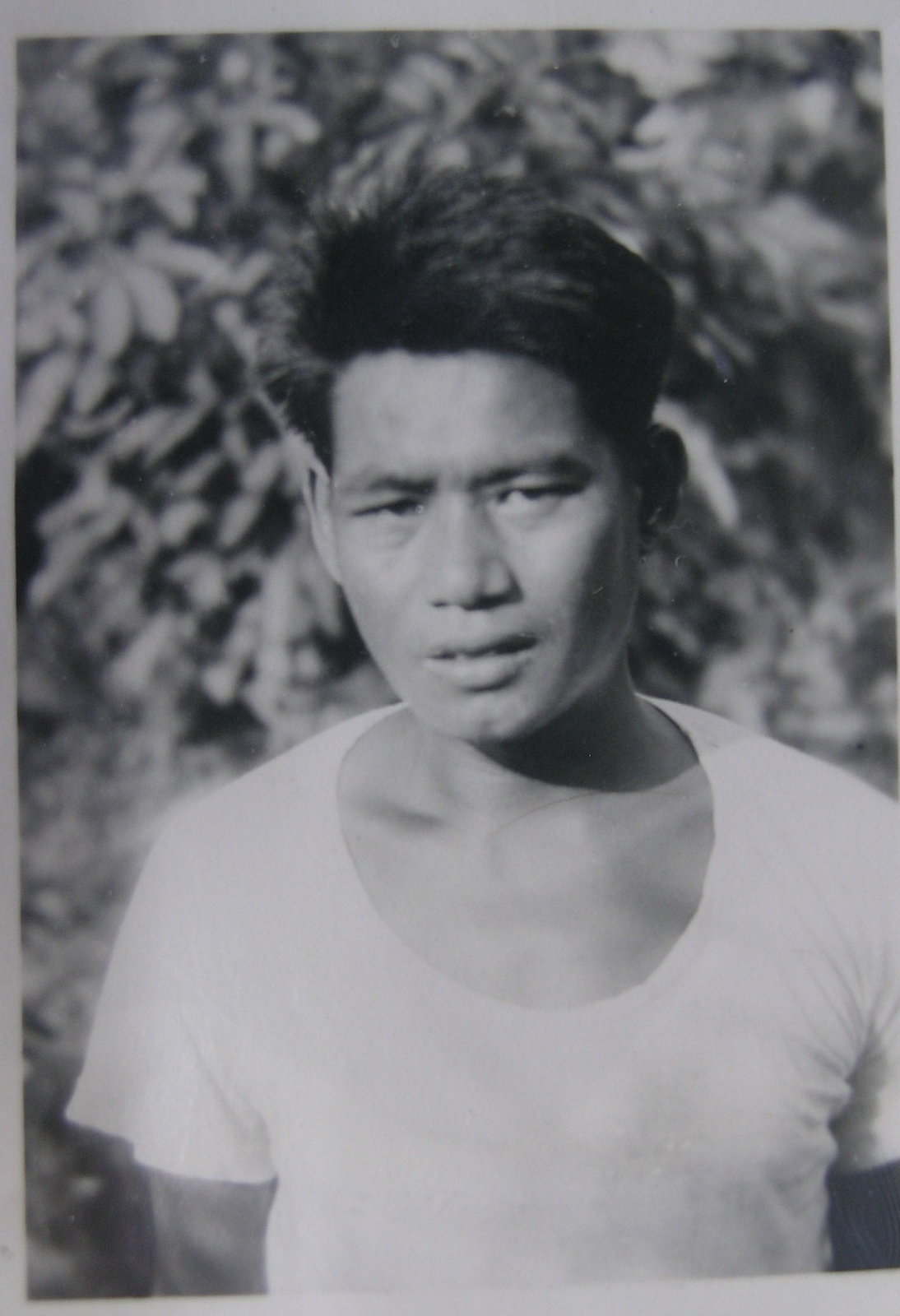
Pho Pa: A Shan Burman cultivator from the Myitkyina district, Pho Pa joined SOE on 1 June 1944. He was 25 years old.

Captain Joseph Philip Maurice Planel: born 23 July 1917, in Mauritius, Planel was medically discharged from the RAF before being joining SOE. His training reports suggest a principled and popular man, but shy and forgetful – apparently he left his W/T set in the cloakroom at King’s Cross station and only ‘realised his error when it was pointed out to him.’
Most of 1944 was spent training, and although attached to F Section he missed going into France. Posted to the Far East, Planel joined Operation Character, working with the Otter team in area Green. Lt.Col. Peacock wrote that although he did not see much of him, he understood that Planel had ‘performed his duties very well and keenly.’
Personnel file: HS 9/1193/4
Po Hla, alias Mon Yi: Po Hla was recruited into Force 136 in March 1944. He was a friend of Nyo Tun and Thein Pe. He had been working as a propaganda officer for the Arakan National Congress before this. After just 18 days employment, he was sent overland into Burma as part of the initial Billet operations. He was captured by the Japanese.
Naik Po Hla: A Karen cultivator from Bassein district who joined the Army in 1941. After the first Burma campaign of 1942, he was recruited for P Force patrols under Major Peacock from December 1943 to May 1944. A little note describes him as ‘unduly windy’.
Po Hmi: A Shan Burman cultivator from the Myitkyina district, Po Hmi was trained in Ceylon between August and December 1944. After parachute instruction in March 1945, he was dropped into Burma with Operation Nutshell, team Antelope. He remained in the field until 5 October 1945. Major Abbey described him as ‘a delightful fellow’ who was ‘always very helpful, loyal and cheerful.’
Po Kya: A Burman born in 1921, Po Kya was in the Burma Sappers and Miners. He was recruited by Major Hedley in October 1944, and after training was deployed with team Walrus of Operation Character. In 1945, after five years in the Army, he wanted to join the police force in Prome.
Major Campbell reported that Po Kya was an ‘[e]fficient and reliable soldier’ who would be suitable for the police in post-war Burma.
Po Net Kyaw: A Karen born in 1920, Po Net Kyaw was a Burma Sapper and Miner until recruited by Major Hedley in October 1944. Between recruitment and March 1945 when he was deployed into Burma as team Mongoose of Operation Character, Po Net Kyaw was trained in Poona, Belgaum, Rawalpindi and ME 25 in Ceylon.
Major Lucas reported: ‘Not an entirely satisfactory record. Not good in coup de main. A difficult temperament.’
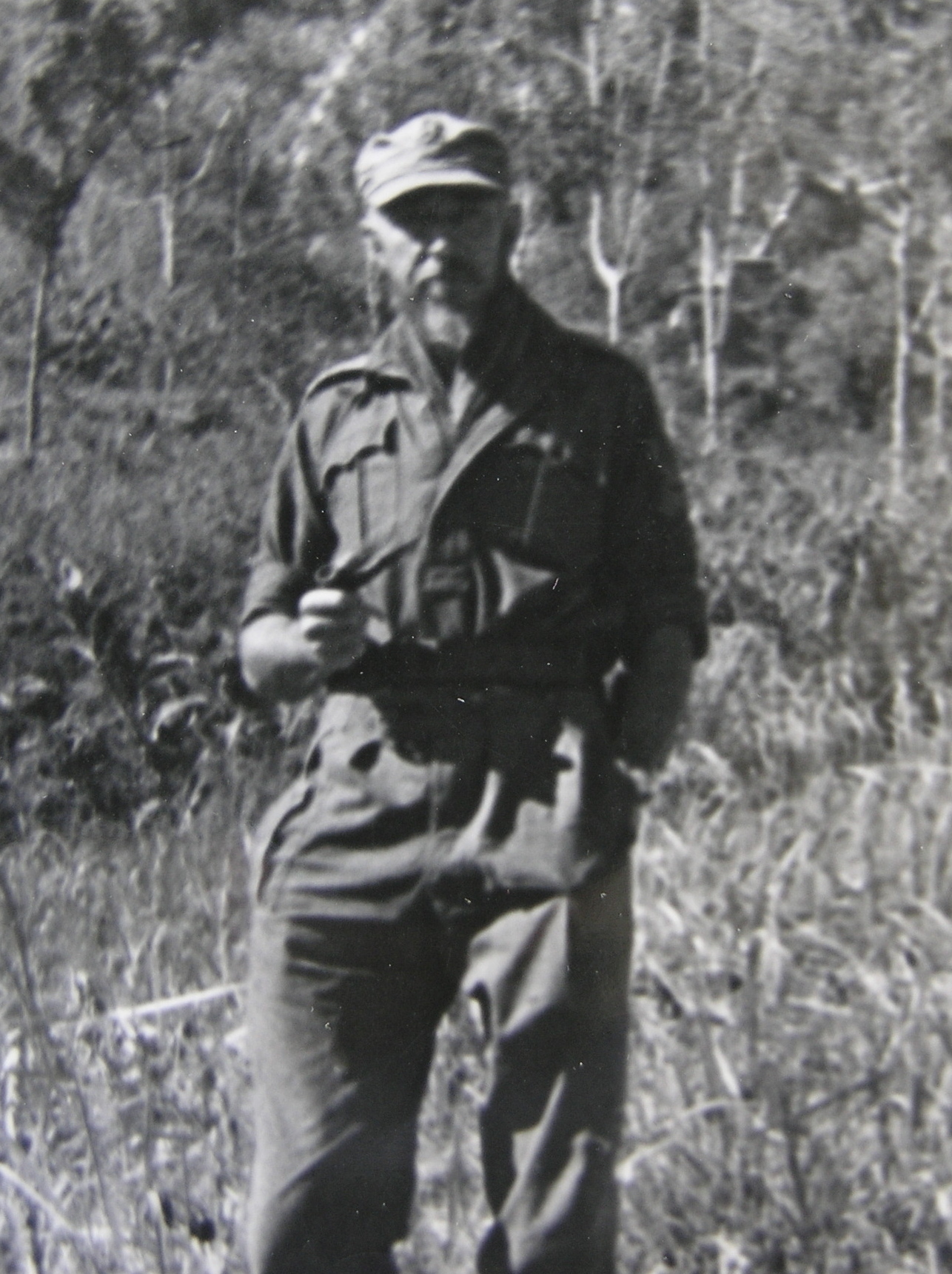

Photo credits: photo 1 adapted from The National Archives, HS 7/107
Photo 2 – portrait supplied courtesy of Dr. Steven Kippax
Major William Eustace Poles: Born on 19 June 1902 in Wentworth, Yorkshire, Major ‘Pixie’ Poles lived in Southern Rhodesia when war broke out. In 1941 he served as a platoon sergeant with the King’s African Rifles in the Abyssinian campaign before being awarded an emergency commission. He then served in 2 Battalion the Rhodesian Regiment.
Poles was recruited into SOE in April 1943. His first operational work with with Major Peacock in the Chindwin area of Burma, working to the front of 20 Division. The Chindwin patrols, known as P Force, were pulled out in 1944 as a result of the Japanese attack upon Imphal and Kohima.
After some time training in Ceylon at ME25, Poles was parachuted into Burma as officer commanding team Ferret of Operation Character. For his work in Burma, Poles was awarded the Military Cross:
‘This officer, who parachuted into the Central Karen area in Feb 45, has shown consistent gallantry and qualities of leadership worthy of high commendation. In spite of lack of supplies, he has kept the morale and fighting efficiency of his force of Levies at a high level. In July, with only 5 Levies, he stalked a party of 15 Japs, killing them all, and since Feb his force operating East of THANDAUNG has inflicted nearly 600 casualties on the enemy.’
Personnel file: HS 9/1198/7
Major David Henry Preston: born 9 February 1907 in Offenhm Worcestershire, Preston was officer commanding No.2 Field Propaganda Unit from 10 January 1945. He was described in his confidential report for June 1945 as ‘An outstanding IFBU field officer. Intelligent, active and devoted to duty. Sterling character and attractive personality.’
Commissioned into the Somerset Light Infantry in December 1940, Preston sailed for India in March 1941. He served on the North West Frontier Province with his battalion during 1942, as well as completing an Intelligence course in Karachi. He then served in the Arakan as Intelligence Officer before joining SOE and serving with the IFBU in both Arakan and at Imphal.
Personnel file: HS 9/1209/10
Ral Hmung: A Chin born in 1923, Ral Hmung was a W/T operator who had served with the Burma Frontier Force in the first Burma campaign. He was recruited into SOE in the Chin Hills in August 1943. After training for the rest of 1943 and into 1944. Ral Hmung deployed with Lt.Col. Crosby on Operation Dilwyn, team Squirrel, on 28 December 1944 until 22 September 1945.
Crosby wrote: ‘Very good operator. Very pleasant man, not a soldier.’
Rallian Thung: a Chin born in 1925, Rallian Thung joined SOE in August 1943. After training, he was dropped into Burma on Operation Hainton on 6 June 1944, remaining in the field until 16 October 1945. Operation Hainton became Operation Heavy, and Rallian Thung served with team Wolf.
Ram Dass: a Chin born in 1920, Ram Das was a telegraphist in the Burma post and telegraphs department before the war. He joined SOE in August 1943, completed W/T and paramilitary training, and was then deployed in the Arakan with Operation Billet in March 1944 as the W/T operator. He was captured by the Japanese in May, and they tried – unsuccessfully – to make him use the W/T set.
Sergeant Albert Redwood: Born on 28 April 1919, Redwood was in the Dorsets and served with 7 Commando. He was killed in Burma on 27 January 1945 while on Operation Ramrose, team Fox. Major Burke reported:
“On arrival at our RV in the scrub, Sgt. REDWOOD was missing. A search party went out under Major BURKE and REDWOOD’s body was found in the open. He had been shot at point blank range through the stomach with a large calibre weapon. He died instantly. This made it appear that B.T.A [Burma Traitor Army] was about who would quickly warn the Japs of our whereabouts. REDWOOD’s body was placed in as decent cover as was available….”

The Commando Prayer from the Commando Veterans’ Archive
Personnel file: HS 9/1239/7
Commando Veterans Archive entry for Sgt Redwood.
Major Randolph Wilson Reid: born 8 December 1909 in Glasgow, Reid was commissioned Army of Burma Reserve of Officers (ABRO). He was employed by McGregor’s the Forestry company, and fought in the first Burma campaign with the Burma Frontier Force.
He was employed by SOE from 1942 until 1946, when he joined the Civil Affairs Service (Burma) (CAS(B)). Reid was deployed on Operation Spiers during 1943-1944. He was MiD for his work with SOE.
Personnel file: HS 9/1243/7
London Gazette: Commission 1942
London Gazette: Death
Lieutenant Henry Bruce Renny: An Anglo-Burman, Henry Renny was born 14 September 1924 in Rangoon. He was granted an emergency commission on 12 February 1945 and within a month he was behind the lines on Operation Character as part of Walrus. He was made 2i/c of sub-group Skunk; his O/C was Major Alex Campbell.
Previous to his deployment on operations, Renny had been employed by Burma Country Section of SOE since October 1944 as a civilian interpreter. He was trained in Ceylon from January to March 1945.
Renny was promoted to Lieutenant in the field, and also recommended twice for the Military Cross, for which he was Gazetted in 1946:
‘On 24 August, 1945, at DAWRAKHU, 2/Lt. RENNY was commanding a platoon of Levies who were repulsing an attack by regular Japanese forces on the H.Q. of Operation WALRUS. In the middle of the action a Dakota dropped much needed ammunition between the two lines. Without a moments hesitation 2/Lt. RENNY collected a party of Levies and under heavy enemy fire led a charge with such skill and vigour that he was able to drive back the Japanese. He then consolidated his position and held off counter attacks until the stores had been collected. 2/Lt. RENNY showed great gallantry in this action and I recommend him strongly for the award of the Military Cross.’
Personnel file: HS 9/1247/1
TNA MC recommendation: WO 373/101/178
Lieutenant Thomas William Edward Renny: an Anglo-Burman, Renny was born in Rangoon on 18 September 1920. He was educated at St. Paul’s High School and Rangoon University. Initially employed as a civilian interpreter at ME25, after training in late 1944, he was commissioned on 12 February 1945. Twelve days later, he was deployed on Operation Character, serving under Major Poles on the Toungo – Mawchi Road where he was in charge of a platoon of guerrillas hitting the Japanese on the road.
On 8 February, Renny wrote a letter to a Miss C. Samuels, which was picked up by Indian censorship. He was extrememly lucky that he did not get in trouble for a ‘serious breach’ of the Official Secrets Act. It helped that he had proved himself in the field, and that technically he was a civilian when he wrote the letter. He was allowed to retain his commission and finally left SOE in late 1945 with hopes of joining the Burma Frontier Service.

Sergeant Herbert Maurice Roe: born 4 June 1917 in Ealing, London, Roe was a Ledger Clerk before the war. He joined SOE in May 1942. He was trained and joined F Section, parachuting into France on 9 July 1944. He was part of the Pedlar circuit where he took on W/T duties as well as training and ‘taking part in several actions’ with the resistance. He was recommended for the British Empire Medal, but awarded the MM instead in July 1945.
Roe then volunteered for service in the Far East, where he served on Operation Character from 24 March 1945. He was with the Hyena team, and is in many of the photographs included within John Bowen’s Undercover in the Jungle’, where his surname is spelt ‘Rowe’.
Personnel file: HS 9/1276/1
P.M. De Costa Roque: A Chinese orderly who was deployed with the Spiers team on 5 February 1944. The Spiers team operated in the Kokang area, and Roque stayed until September 1944, when most of the team withdrew. After this operation, he ‘was willing to serve anywhere including Macao’, but there is no further information to know if he did.
Sergeant James Clanaham Rork: born 21 June 1912 in Berwick-on-Tweed, Rork was in the Royal Corp of Signals, joining SOE in June 1944. Rork volunteered for service in the Far East, and served with Major Hood and Captain Craster on Operation Nation, as team Zebra.
Personnel file: HS 9/1280/7

Major Richard Arthur Rubinstein: Born in London on 29 August 1921, Rubinstein was just finishing school when war was declared in 1939. He was immediately mobilised having joined the TA in 1938, and served in the ranks until June 1941. Granted an emergency commission in the Royal Artillery, Rubinstein did not have any overseas service so applied to join SOE in November 1943.
One of the questions SOE asked recruits was for which war work they thought they were best suited. Rubinstein’s written response was that he would do whatever was asked of him, and that he was willing to do ‘any job where full advantage is taken of my health and youth.’
Fluent in French, Rubinstein trained as a Jedburgh for operations in France. One report from early 1944 described Rubinstein as a ‘Forthright type that people would have faith in’ continuing that he ‘can be trusted to do any job well.’ In the same report; ‘A first class officer in every way and is very popular with all nationalities.’
Another of the Jed Board reports (for all personnel) consists of a list of attributes which all have a ‘+ 0 -‘ after them. The only one circled with a minus for Rubinstein is ‘Stability of Temperament’, which was followed with ‘The great doubt about this man is whether his temperament will stand the strain of action.’
Going on to complete four operations with SOE, two in France and two in Burma indicates that this ‘great doubt’ was proved wrong. Rubinstein was awarded the Croix de Guerre, was MiD in August 1945 and also won the Military Cross for his work in Burma. In Burma, Rubinstein was deployed on Operation Dilwyn team Cheetah and then on the Nation part of Operation Billet. On this last operation, as team Chimp and later Reindeer, Rubinstein and his Burmese guerrillas managed to shoot up a Japanese party killing a Major General and several other officers and NCOs.
Personnel File: HS 91289/2 (Note incorrect spelling on catalogue ‘Rubenstein’)
IWM interview
For more on Rubinstein and British Jews fighting in the Second World War, see Martin Sugarman’s Fighting Back
Subedar Sadaw Gam Ba: Sadaw Gam Ba was a Kachin in the Burma Rifles who fought in the 1941-2 campaign, but remained in Burma after the japanese invasion. He was recruited in the field by SOE on 1 April 1944, joining Operation Dilwyn. Sadaw Gam Ba was extracted to India in October 1944, parachute trained, and then returned to Burma as part of Major Zau June’s team Badger from December 1944 to June 1945. He was described as a ‘very capable man.’
Havildar San Htoo: San Htoo was a Sgaw Karen born 26 March 1919. He spent a year training in India, from the filter course in January 1943 to W/T refresher course in January 1944. He completed jungle training at Rissum Camp (first time this camp name has been encountered). He was deployed on Operation Heavy, team Wolf from 24 April 1944 to 15 January 1945. It appears he was withdrawn for leave, and then returned to the field from 5 March to 30 July 1945. He was withdrawn this second time to be admitted to hospital.
San Htoo was recommended for a MiD on 30 August 1945.
Naik San Kun: Born on 13 October 1920, San Kun was a Burman who enlisted in the Burma Army in May 1938. During 1943, he was jungle trained for the second Chindit operation, but it is not clear if he went. It is possible, as he only joined SOE on 15 December 1944, and after W/T and parachute training he was deployed on Operation Nutshell on 11 August 1945.

San Tin: A Shan Burman cultivator from Mawlaik district who joined SOE on 1 June 1944, aged 24.
San Win: recorded as Burmese, recruited by Peacock on the Upper Chindwin in 1944. Presumably served with P Force initially, and then trained in late 1944 preparatory to deployment with the Hyena team from 20 February to 20 October 1945.
San Win was recommended for the Military Medal for his bravery during Operation Character:
‘Dead accurate shooting, 11 March 1945, withheld almost to bayonet point on CHAWIDO HILL. This coolness contributed largely to the break up of Jap entry on this occasion into Hyena position, and so contributed to the enemy supposing us trained troops IN STRENGTH and to Jap signalling Rangoon for reinforcements’
‘exceptional willingness and reliability to work on and operate Mills Cordtex ambushes.’ (see blog post HERE)
Saw Aaron: born in 1924, Saw Aaron was the nephew of Saw Archibald Kino. He served in the Burma Royal Naval Volunteer Reserve (RNVR) before SOE. In January and February 1943 he was trained at Poona and Chaklala, preparatory for deployment on Operation Harlington. When deployment to the Karen Hills proved abortive over the next few months, Saw Aaron went trekking with to keep the Harlington 2 party occupied, followed by signals training. He eventually parachuted into Burma on December 1943 with Capt. Eric McCrindle.
When their camp was attacked and McCrindle shot dead by the Japanese, Saw Aaron and Hsi Tai were able to escape and hide in the jungle, avoiding being captured and sent to Rangoon where their comrades were executed.
Jemadar Saw Accord: born on 16 April 1905, Saw Accord was in the Burma Rifles from at least January 1933 when he completed a gas course, but only joined SOE in April 1945. Within a fortnight of being recruited, Saw Accord parachuted into Burma as part of Operation Nutshell, team Tiger. He remained in the field until 25 October.
Saw Archibald Kino: a Karen, Kino was one of the first back into Burma after the retreat of 1942. He parachuted nto the Irrawaddy delta area with his W/T operator in January 1943. Their landing was a disaster and it wasn’t long before Kino was captured by the Japanese. See more detail in ‘Operation Flimwell: A first failure in Burma.’
Naik Saw Chit: a Karen from Insein district, Saw Chit is recorded as having joined SOE in March 1943 and then seen active service in Manipur during March and April 1944.
Lance Naik Saw Chit Han: recruited by SOE from the Western Chin Levies on 1 October 1943, Saw Chit Han was a Karen who had originally served with 4th Battalion Burma Rifles. He is recorded as serving in the Chindwin area from March to June 1944, before receiving parachute instruction at Jessore in November. On 2 December he dropped into Burma on Operation Bottom which lasted until 31 January 1945. On 5 April he was RTU’d to Burma Regimental Centre at Hoshiapur.
Jemadar Saw Daniel Byaw: a Karen born in 1920, Saw Daniel enlisted in the Burma Rifles in April 1941 and served in the 11th Battalion. It appears that Saw Daniel remained in Burma and SOE recruited him in Rangoon on 8 August 1945. On the 10 August he was flown by Lysander to Operation Character’s Mongoose team where he served in area Crimson until 15 October 1945. He was described as ‘very efficient’ as well as ‘very popular amongst the local Karens’.
Lieutenant Saw Dee Htoo: No training card and a brief PF, it is unclear whether Lt. Saw Dee Htoo saw service in Burma. He had served 25 years in the Army by 1943, and it was OSS’s Col. Eifler who requested his promotion to Lieutenant in 1943. He worked for the Americans at Nazira, Assam, at OSS’s Army Experimental Station. He had been employed by SOE since early 1943. On 4 July 1945 he was posted to 1st Battalion Karen Rifles.
Captain Saw Gam: Born on 10 May 1909, Saw Gam, like many Burmese Force 136 personnel, had an alias, Maung Tun. He served in 1st Burma Regiment and also in E Group. E Group was the organisation in Burma tasked with locating and assisting Allied Prisoners of War. As an officer with E Group, Saw Gam joined SOE’s Operation Heavy, Wolf in January 1945. Heavy’s area of operations was in the Southern Shan States, close to the Siamese border.
He was taken on the strength of SOE in March or April, and remained on Heavy with group Lynx until extraction on 29 October 1945.
‘This officer’s CO speaks very highly of his conduct in the field while serving with Operation Heavy (Lynx). I recommend that [he] be promoted to Captain w.e.f 1 April 1945.’ This was despite a previous report: ‘Not very intelligent but makes up for this by his energy and conscientiousness.’ He was also described as ‘Very loyal.’
In his personnel file, his desire to join the Kachin Rifles after the war is recorded.
Personnel file: HS 9/1318/7
Havildar Saw Ghaw: a Karen born in 1915(?), Saw Ghaw was in the Burma Military Police for 13 years, and evacuated to India in 1942. SOE recruited Saw Ghaw in April 1943, and after training he deployed on Operation Corton on 31 March until 14 October 1944. He then deployed again from April to October 1945 on Operation Nutshell, team Tiger.
Captain Green, Saw Ghaw’s commander on Corton, wrote that he ‘was an outstanding little fellow’ who was ‘extremely well trained and disciplined.’
Havildar Saw Hardy: a Karen born in 1921, Saw Hardy was in the Burma Sappers and Miners, but had also served in the Burma Military Police. He was recruited by Force 136 in October 1944. After training, he parachuted into Burma on 26 March 1945 to serve with Mongoose under the command of Major Lucas. He was described as ‘very reliable and enthusiastic’. He was responsible for training those recruited in the field.
Jemadar Saw Henry Tun: appear to have two sets of records, one filed as Saw Henry Tun, another under Tun, Henry. The Army Number provided is different, W/217 and W/849 respectively, but parent’s names and village match.
From the first set of records, the following can be gleaned: a Karen from Maymyo, Saw Henry Tun was seventeen years old when he joined the Army in March 1941. He appears to have served with SOE between January and May 1944.
From the second set of records, his date of birth is given as 12 January 1925, joining the Army in 1938 (13 years old!). His date of joining SOE was apparently October 1942, with W/T training at Meerut starting almost immediately. January to June 1943 were spent training, and November was spent with the Flimwell party at EWS(I). January to May 1944 was spent with P Force on Chindwin patrols, before collective training in Ceylon as part of the Otter Special Group.
Lt.Col. Peacock reported that he was a ‘first class wireless operator. Did splendid work throughout the operation at my HQ. Rather a wild lad outside, but brave and energetic and very hard working.’
Lance Naik Saw Hla Myaing: a Karen born in 1919, Saw Hla Myaing joined the Army in 1941. He retired to the Chin Hills in the 1942 campaign, where he joined SOE in October 1943. He proceeded on Operation Bottom on 2 December 1944, and then on Operation Character, team Otter from 8 May 1945.
Jemadar Saw Hla Sein: a Karen born in 1914, Saw Hla Sein joined the Burma Military Police in February 1941. After serving in the first Burma campaign, he joined SOE in January 1943. He proceeded on Operation Bottom on 2 December 1944, and then on Operation Character, team Otter from 8 May 1945.
Second Lieutenant Saw Johnnie: a Karen born in 1922, Saw Johnnie enlisted in the Oriental Mission’s Burma Levies in 1942 and completed training at the Bush Warfare School in Maymyo. Evacuated to the Shan States, Saw Johnnie was forced to remain due to malaria. He is recorded as being a cultivator during 1943 and 1944 until he was recruited in the field by Operation Hainton in September 1944. Operation Hainton later became Operation Heavy, and Saw Johnnie was with team Wolf.
Lance Naik Saw Joshua: a Karen born in 1922, Saw Joshua was in the Burma Signals from at least March 1940. In November 1943, he was parachute trained with an ISLD team and later parachuted into the Katha area from November 1944 to April 1945. He then transferred from ISLD to SOE and parachuted into Burma again, to serve with Operation Character’s team Mongoose. He remained in the field from 30 April to 17 November 1945. Major Hood wrote that he ‘was not a good operator, but tried very hard.’

Naik Saw Kyai Htai: a Karen born in 1921, Saw Kyai Htai enlisted in the Burma Army Service Corps in 1941 where he served as a driver. He joined SOE on 8 February 1943. After training for most of the rest of 1943, he completed parachute instruction and then became the W/T operator at a new camp called Camp Tweed. On 2 December 1944 he was deployed on Operation Bottom, and then from 18 April on Operation Character serving with team Otter.
Jemadar Saw Kyaing Galay: a Karen who served with the Burma Military Police, 2nd Rangoon Battalion, Saw Kyaing Galay served in the first Burma campaign. After evacuation to India, he served in the garrison battalion at Hoshiapur before joining SOE in January 1943. There is no record of what he did with SOE, the usual training record being absent. He appears to have won the Burma Gallantry Medal, see the Gazette.
Saw Kyaw Tun: a Karen born in 1918, Saw Kyaw Tun joined the Burma Rifles in 1940, serving with 7 Battalion. He joined SOE in October 1943 and served in the Chindwin area between March and May 1944. He was parachute trained and then deployed on Operation Bottom on 2 December 1944 until 31 January 1945. In February he then deployed on Operation Heavy with Majors Cope and Herring, serving with team Wolf.
Saw Kyaw Yin: a Karen who served as a driver from 1939. From Thataung district. No further details.
Saw Lu Thein AKA Pastor A.L. Myers: A Karen recruited in the field by Col. Howell of team Hyena on 28 March 1945, the pastor was promoted to Jemadar in July and served in the Orange area. He ceased operations on 13 November 1945.
Saw Mathew Takwalai: a Karen who served on Operation Character from April to September 1945. At one point, he had ‘sole command’ of 400 levies.
Naik Saw Maung Chit (Saw William): a Karen born in 1920, Saw Maung Chit was originally with the Burma Army Service Corps. he joined SOE in March 1943 and served in the Chindwin area between march and May 1944. On 16 December 1944 he was deployed with the Rendezvous team until 14 January 1945. He then parachuted into Burma on 25 January 1945 on Operation Burglar, which remained behind the lines until 1 May 1945.
Havildar Saw Maung Han: a Karen born in 1922, Saw Maung Han originally served with 3 Battalion Burma Rifles (also listed as 1 Battalion BMP on separate record). He joined SOE in January 1943. In training until May, he was on the Chindwin front from June to November 1943, and again from December into 1944. After refresher parachute training and collective training in Ceylon, Saw Maung Han was parachuted into Burma on Operation Dilwyn for 23 days in March before going back with the Chindits. He then deployed twice more into Burma with Operation Rendezvous and Burglar team Hippo.

Jemadar Saw Morlu Ku / Mawluku / Moluku: a Karen born in 1924, Saw Mawluku was a cultivator, with knowledge of elephants, before the war. He joined SOE in April 1943, recruited by Major Peacock. It appears that he served in the first Burma campaign, and that he certainly served with P Force, during which he helped rescue Captain Gibson. He was then collectively trained in Ceylon preparatory to going on Operation Character to serve with Major Poles’ Ferret team. He was dropped into Burma on 24 February 1945 and remained in the field until 22 October. He obviously impressed both Peacock and Poles:

Havildar Saw Morris: a Karen from Hanthawdi district, it appears Saw Morris joined the Army in 1931 aged 20. He participated in the first Burma campaign and was then recruited by Major Peacock in 1943 and patrolled the Chindwin front.
Subedar Saw Na Mu / Namu: Born in 1913 in Papun district, Na Mu was a Karen cultivator (he is recorded in other files as working for the Bombay Burmah Trading Company). He served in the first Burma campaign, for which he was awarded the Commander in Chief’s certificate for Gallantry. He joined SOE on 21 April 1943 and served in P Force. Extracted from the Chindwin, and after training in India and Ceylon, Na Mu parachuted into Burma on Operation Character to serve as one of Lt.Col. Peacock’s escort. Peacock wrote of Saw Na Mu:
My best patrol leader: a most excellent man who has been with me right through from the operations on the Chindwin where he obtained the C in C’s certificate for gallantry. Very tough, but very cool in action.’ Na Mu was recommended for the Military Cross.
Captain Saw Ohn Pe: a Karen born in 1901, Saw Ohn Pe had worked in forestry before the war and was awarded a government medal for his service in May 1922. He served with SIS from 1943 until joining SOE in April 1945. While with SIS, he was part of an intelligence patrol led by Major H.E. Castens in the Chindwin Valley from 15 February to 16 May 1943, and then he was dropped in Burma in February 1944 in the Bhamo/Katha area until April. On 20 April 1945 he joined the Mongoose team of Operation Character, where he was attached to Lt. Col. Critchley’s HQ staff. A very well regarded officer, who worked hard to wind down the operation during September and October 1945 and find the Karen jobs for peace time.
Havildar Saw Pa Daw: serving with Hyena Purple, Saw Pa Daw ‘displayed consistent good leadership over the period of operations and particular bravery when his section was attacked by 150 Japs whilst about to lay a charge. He took over the BREN, killed 11 Japs and extracted the section without loss of men or material.’ Recommended for the BGM, was awarded the MM.
London Gazette ‘Saw Padaw’
Naik Saw Pah Aye He: an ‘elephant rider’ from Papun district, Saw Pah Aye He joined SOE on 21 April 1943. Awarded the 1939-43 Star and recorded as being on active service in Burma from April 1943 until 25 May 1944 (patrolling in the Chindwin area).
Naik Saw Pah Bise: a Karen farmer from Papun district, Saw Pah Bise joined SOE on 21 April 1943, aged 24. He was part of Peacock’s P Force on the Chindwin Front.
Naik Saw Pan Aye:
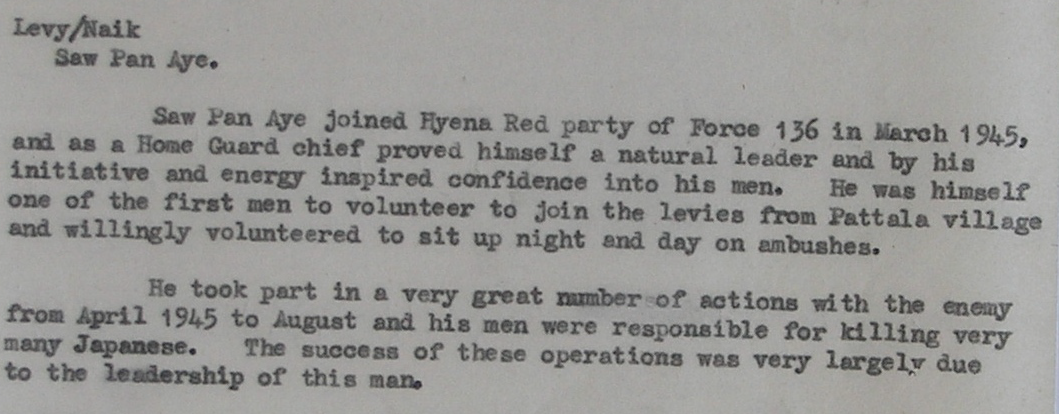
Saw Papi Martin: apparently born in 1927, Saw Papi Martin would have been just sixteen when he went to Meerut for Signals training in 1943. After paramilitary, parachute, and collective training during 1944, he completed an advanced Signals course before deploying into Burma, first on Operation Rendezvous from 16/12/44 to 14/1/45, and then on Operation Burglar, team Hippo from 25/1/45 to 13/5/45.
Naik Saw Pe: a Karen born in 1916, Saw Pe had previously been a game keeper in the Papun area, as well as having four years forestry work so he was considered to have a ‘[g]ood knowledge of jungle life’ when recruited by SOE in March 1943. Trained in April and March, Saw Pe did particularly well on his parachute course. He parachuted into Burma on 12 October 1943 with Captain Jimmy Nimmo on Operation Harlington. He was later captured and taken to Rangoon jail and executed.

Photo credit: R.Duckett, CWGC Rangoon Cemetery Nov. 2017
Lance Naik Saw Pe Tun: a Sgaw Karen born in 1923, Saw Pe Tun joined the Burma Army Service Corps in 1941. He joined SOE in July 1943 and was deployed on Operation Corton II from 5/6 April to 14 October 1944. His training report describes him as ‘quiet and unassuming’. For more on Operation Corton, see HERE.
Naik Saw Pla Paw: a Karen born in 1921, Saw Pla Paw joined SOE in April 1943. He was on Chindwin patrols before completing parachute instruction and collective training in Ceylon. He was then deployed on two operations into Burma. The first of these was Rendezvous from 16 December 1944 to 14 January 1945, and the second was Burglar from 25 January to 13 May 1945.
Havildar Saw Po Hla, AKA Saw Henry: a Karen born in 1911, and not to be confused with Lt. Saw Po Hla (below). Saw Po Hla was recruited at Hoshiapur on 1 March 1943. He had already served two years in the Army (although a record elsewhere indicates seven years in the army).
Most of March to November 1943 was spent training before proceeding to the Chindwin front in December. It is noted that he arrived in Imphal on 19 January 1944. The other record has slightly different accounts of his movements in 1943, placing him in the Tamu area from 6 June to the 6 November 1943. It agrees with a return to the Chindwin area inn December, but was then was back in Calcutta by early January 1944. There can’t be two Saw Henry’s born in 1911?
Apparently withdrawn from Operation Ampere, Saw Henry parachuted into Burma on 20 February 1945 to serve with the Hyena team of Operation Character. Major Turrell reported that he ‘[h]as done a lot of hard slogging, not over brilliantly, but uncomplainingly.’

Lt. Saw Po Hla, reproduced from Ian Morrison’s Grandfather Longlegs
Lieutenant Saw Po Hla: Saw Po Hla was born on 21 December 1914 in Myaungmya District, Southern Burma. He was granted a King’s Commission (KCO) on 18 February 1941 and served with 11 Burma Rifles (Burifs).
After the Japanese invasion in 1942, Lt. Saw Po Hla remained in Burma, and joined Major Seagrim in February 1943. He continued to work with Seagrim for the rest of the year. When the Japanese attacked the British officers (Nimmo, McCrindle and Seagrim) in February 1944, Saw Po Hla apparently led the Japanese to Seagrim’s hideout. This was because the Japanese had arrested him and tortured him.
In June 1945, Saw Po Hla was sent to Delhi’s Red Fort ‘erroneously‘ where he was held on suspicion of being ‘Black’, in other words a collaborator with the Japanese. By January 1946 he was still being held, despite ‘The question of B969’s guilt concerning betrayal of Major SEAGRIM is very far from having been proved.’
As far as Force 136 was concerned, Lt. Saw Po Hla was coerced by the Japanese and therefore a loyal subject. It was decided to consider him as employed by SOE from the time he joined Seagrim in 1943, and to pay him for the years that he served behind the lines in Burma.
Personnel file: HS 9/1318/9
Naik Saw Po Shan:

Lance Naik Saw Po Toke: a Karen from either Myaungmya District or the Chin Hills (his record conflicts), Saw Po Toke joined SOE on 1 April 1944, aged 20. He is noted as having seen active service in Assam from his appointment in April until 25 May 1944, while another part of his record details the Chindwin front. Since the Army number assigned is consistent, this indicates that it is the same Saw Po Toke.
After service in Assam/Chindwin area, Saw Po Toke was parachute trained at Chaklala and then sent to Ceylon for collective training. He was deployed on Operation Rendezvous on 16 December 1944, and Operation Burglar on 25 January 1945 until 15 May.
Saw Prince: a Karen from Thaton district, Saw Prince is recorded as having been a student prior to joining SOE on 28 March 1942, aged 18. Unusually, by ‘Period of engagement’, it has been written ‘duration of war and the year after’. Intriguingly, this is it.
Havildar Saw San Pe: A Karen born in 1921 (possibly 1920*), Saw San Pe was recruited on 21 April 1943. In civilian life, he is recorded as having been an ‘Elephant rider’ (and a cultivator*). After serving with P Force as one of Major Peacock’s escorts, Saw San Pe was parachute trained and then trained as a Special Group in Ceylon. He parachuted into Burma on 20 February as part of the Hyena team of Operation Character.
Major Turrall recommended that Saw San Pe be awarded a MiD and a retrospective promotion to Jemadar:
‘He was a first class section commander throughout, always behaving in an exemplary manner in the face of the enemy, doing an immense amount of ambush work.’
* There is another record for Saw San Pe with these alternative details.

Captain Saw Sankey: Saw Sankey was born on 12 February 1915. He was commissioned into 11 Battalion the Burma Rifles (Burifs) on 26 October 1941. Following the Japanese victory in Burma, Saw Sankey remained in Burma having been disbanded at Katha on 5 May 1942.
On 5 May 1945, he reported for duty in Rangoon and was taken on by Force 136. His personnel record states that he first joined team Llama, which was apparently part of Operation Character. It is also recorded that he was with team Giraffe of Operation Nation. Both of these postings were presumably quite short, as he is further recorded as joining Operation Character’s team Mongoose, area Blue, from 26 May to 1 November 1945.
He is described as ‘a first class officer’ who was ‘extremely loyal and keen’.
After the war he went on to co-found the Karen National Defence Organisation (KNDO) According to this website, he died on 12 August 1950 with Saw Ba U Gyi, fighting troops of the Union of Burma. See also Burma Library.
Personnel file: HS 9/1303/6
Havildar Saw Saya Ah To

Pastor Saw Saya Sha: from Kyigon village, Pastor Saw Saya Sha was recommended for a MiD ‘for continued good work and bravery in Capt. HOUSEMAN’S area.’
Subedar Saw Sein Lwin: Saw Sein Lwin, born 1910, was a Karen from Bassein who joined the Burma Rifles in February 1932. He served with 6 Battalion during the first Burma campaign, and after the retreat from Burma he joined the Chin Levies. Recruited by Captan Wilson in October 1943, after being granted a month’s leave, he was trained and then sent on Operation Hainton (later Heavy team Wolf) from 24 April 1944. He stayed in the field until January 1945, and then went back from March until 19 October 1945.
Major Pennell wrote: ‘Has done sterling work, and performed the Duties [sic] of a British officer – Has been strongly recommended for Promotion.
Recommended for Mention in Dispatches 30.8.45′
Saw Sein Maung: a Karen born in 1924, Saw Sein Maung joined the Burma Frontier Force in 1941. He retreated to India by May 1942, but was not recruited by SOE until 1 June 1944. His original role was as Captain Calvin Ogh’s orderly, but he completed parachute training and was deployed on Operation Bottom on 2 December 1944, and again on Operation Heavy, team Wolf, from 20 February 1945. Major Pennell was impressed with him:
‘Excellent type, can recommend this N.C.O. for any kind of work. Possesses intelligence and initiative.’
There is no record of rank attained – he is recorded as ‘Rfm’ (Rifleman).
Naik Saw Shwe: a Sgaw Karen from Maubin district, Saw Shwe joined the Burma Military Police in 1937 (2 Battalion Burifs). Recruited in Hoshiapur on 20 January 1943, Saw Shwe was sent to ME 9 for W/T training, then parachute instruction at Chaklala before going to Imphal in March and April 1944. He then completed advanced operator training in May 1944, was posted to Camp Tweed from June to November, and then did more advanced signalling at Meerut.
After being earmarked for Eyemouth, which never deployed, Saw Shwe was deployed on Operation Bottom on 2 December 1944, and then on Operation Heavy as the Lynx team’s W/T operator from 5 March to 29 October 1945.
Since he was promoted Naik in 1941, it’s perhaps surprising that he was only recommended for Havildar in October 1945: ‘A very good operator and no trouble at all.’
Havildar Saw Shwe Yin: joined Force 136 in the field in June 1945, serving with Hyena group of Operation Character. Major Neville reported that he ‘volunteered for all dangerous jobs and inspired others by his example.’ Awarded a MiD for his services.
Havildar Saw Si Lwin: a Karen who joined the Burma Military Police in 1931 aged 19, Saw Si Lwin was a Havildar by 1938. He apparently joined SOE’s Burma Country Section in September 1944, but is also recorded as serving in Assam from April to May 1944. Despite duplicate records, this is about the extent of information contained.
Jemadar Saw Stero: a Bwe Karen born in 1917, Saw Stero served with 1 Battalion, Burma Military Police, having joined up in September 1933. He joined SOE in January 1943 and completed paramilitary training with the Harlington team until March. He did not go in with Harlington, being deployed on Dilwyn instead from 5 March 1944 and working with Morris Force of the Chindits until 20 June 1944.
After collective training in Ceylon, Saw Stero was deployed on Operation Burglar from 26 January to 1 May 1945. Released to Hoshiapur regimental centre on 17 July 1945.
Subedar Saw Taw: joined Force 136 in the field on 24 March 1945. Prior to the war he had worked in the Department for Education. He served with Hyena group of Operation Character, where he recruited 162 mobile levies and 432 static levies in the Purple area. ‘In fact it coud be said that it was due entirely to the untiring energy and great local prestige of SAW TAW that there was always a far greater number of recruits asking for arms than there were arms available.’
Saw Taw ‘was always asking to be allowed to go and fight’ but he was ‘entirely responsible for ‘Q’ in all its aspects’ as well as liaison between the military and civilians, so he was too valuable to lose. Saw Taw was very largely seen as responsible for making Hyena Purple the success that it was. He was recommended for the MBE by Lt.Col. Howell for ‘devoted services’, whic he received.
Havildar Major Saw Taw Yeh: employed as a headmaster in civilian life in a Karen school in Tharawaddy, Saw Taw Yeh was recommended for a MiD due to his ‘leadership, organisation and work as interpreter.’
Havildar Saw Tha Dwe: a Karen who served with the Burma Frontier Force from 1934, Saw Tha Dwe was from Bassein district. He took part in the first Burma campaign, and was again in Burma in April to May 1944.
Jemadar Saw Tha Htoo: a Karen born in 1919, Saw Tha Htoo joined SOE in April 1943 and first saw action patrolling with P Force on the Chindwin front. When P Force was withdrawn, Saw Tha Htoo went for collective training and was deployed in Burma with Peacock’s Otter team. He was promoted to Jemadar in the field, where he ‘[d]id excellent work against the Japs’ and was apparently ‘[b]rave’.
Saw Than Sein (15516): a Karen born in 1919, Saw Than Sein was in the Burma Army Service Corps (BASC) during the first Burma campaign. He evacuated to the Chin Hills in 1942, where he joined the Chin Levies. He joined SOE from the levies in October 1943, served with P Force on the Chindwin front, and by March 1944 he was in Ceylon as cook for the Leopard party.
In November 1944 he completed parachute training at Chaklala and was deployed on Ooperation Bottom from 2 December. That operation finished on 26 January 1945. In April, he deployed again, joining Operation Character’s Mongoose team.
Saw Than Sein (P45671): a Sgaw Karen from the Kawkareik area, Than Sein was part of Operation Nutshell, team Antelope, from 20 March to 5 October 1945. His commanding officer, Major Abbey wrote:
‘Entered the field with me in March and stayed throughout the operation. Was of considerable help during the initial stages as I used him as my interpreter to the Karens through DAWSON.
From July, acted as my agent in Kawkareik and was very useful. As a result of his work his family were persecuted by the Japs and his brother in law was tortured and killed. Very intelligent, hard working and loyal.’
Saw Thet Tun: a Karen farmer from Bassein district, Saw Thet Tun is recorded as having joined the military in 1939, aged 18. He served in the first Burma campaign and was back in Burma in the Tamu area between July and November 1943. After a short spell in hospital ‘for general overhaul’ and inoculations, he was back inn the Chindwin area by December 1943. There is also mention of Burma ops from March to May 1944, although no indication of where or what operation.
Havildar Saw Tun Gyaw: a Sgaw Karen born 10 June 1915, Saw Tun Gyaw joined the Burma Rifles on 25 September 1936, serving with 2 Battalion. In 1943 he was part of Operation Longcloth, the first Chindit mission. He is recorded as receiving secret service training at Hazaribagh in September 1944, and then parachute training in November. He transferred from SIS to SOE in April 1945. With Force 136, he served with Operation Character, team Otter, deploying with Captain Vivian on 9 May until 25 October 1945.

Subedar Saw Tun Sein I, AKA Saw Dick, BBR/129: a Sgaw Karen born in 1911, inserted beside ‘Special qualifications’ is ’13 years in Army, Snall [sic] arms instructor; P.T. Instructor. Recruited in Calcutta for SOE on 1 April 1943, Saw Tun Sein seems to have completed more training than most, attending named places such as Siliguri and Rissum, which is rare.
Another rarity and curiosity, is the two references to ‘Flimwell Course’ during November 1943. Operation Flimwell went into Burma during January 1943, by parachute. He appears to have had some seaborne training, as it mentions he was ‘frightened of the sea.’ After this Flimwell Course, his record indicates that he was in the Chindwin area by December 1943. He then deployed on Operation Character with Ferret from 24 February to 22 October 1945.
Reports about Saw Tun Sein from both Peacock and Poles are complimentary, describing him as a ‘most excellent V.C.O. for training’ and ‘conscientious and hard working’, respectively.
Jemadar Saw Tun Shwe III (2763): a Sgaw Karen born in 1916, Saw Tun Shwe served in 2 Battalion, the Burma Military Police, from at least 1937. After joining SOE on 1 March 1943, most of the rest of the year was taken up with training before being posted to the Upper Chindwin between January and May 1944. After collective training in November 1944, he was deployed on Operation Rendezvous from 16 December to 14 January 1945. Eleven days later, he parachuted into Burma again on Burglar, remaining behind the lines until 1 May.
Lance Bombardier Saw Tun Shwe: a Pwo Karen born in 1922, Saw Tun Shwe served in an artillery unit before joining SOE in May 1943. He was parachute and W/T trained during 1944, and deployed on Hainton, later Heavy, from 1 November 1944 until 29 October 1945. His team was Calf. He was reported as being ‘very good’ and promotion to Havildar was recommended.
Lance Naik Saw Tun Talk: a Pwo Karen born in 1920, Saw Tun Talk served in the Burma Rifles and with ISLD before joining Force 136. He went into the field with Captain Vivian to join Otter from May to October 1945.
Jemadar Saw Wilson (14341): a Sgaw Karen born in 1920, Saw Wilson was in the 1 Battalion Burma Military Police before joining SOE on 20 January 1943. Most of 1943 was spent training, with early 1944 spent teaching W/T use to ‘FERRETS’.
From March to June 1944, he was deployed on Operation Dilwyn. In August he was sent to Ceylon for collective training preparatory to parachuting into Burma as part of Otter from 23 February to 25 October 1945. Peacock wrote very highly of him:
‘A very fine W.T. operator. Quiet and unassuming. Very hard working. Did splendid work with my HQ throughout the operation.’
Jemadar Saw Wilson Gyi: Saw Wilson was studying at Judson College when the Japanese invaded Burma. He was on the inter-college football team and part of the Military Training Corps for two years.
He joined Force 136 on 1 May 1945, serving under Major Poles on Operation Character, area Ferret. He served with Force 136 until 10 October 1945. Major Poles, in recommending him for a King’s Commission on 12 October 1945 wrote that he:
‘rendered exceptional services as a guerrilla leader. Has shown great keeness and ability. He realises the rare virtue of being able to write a clear and concise report.
He is cool and courageous in action.
Good personality and power of command.’
Havildar Saw Wilson Thet: a Sgaw Karen born in 1917, Saw Wilson Thet joined the Burma Army Service Corps in March 1942. He evacuated to India, where he was picked up by ISLD at Hoshiapur Regimental Centre. Three operations with ISLD are recorded:
- Jan to May 1943 in the Chindwin area
- Jan to Dec 1944 in the Bhamo area.
- Feb to April 1945 in the Katha area.
He transferred to Force 136 and was deployed to Mongoose with Captain Ohn Pe from 20 April to 17 November 1945. Major Hood described him as an ‘extremely efficient intelligence agent’.
Havildar Saw Ya Khin: a Karen born in 1918, Saw Ya Khin enlisted in the Burma Rifles in 1939, serving with 4 Battalion. He joined SOE on 1 October 1943 from the Chin Levies. He served on the Chindwin Front before receiving parachute instruction at Chaklala and deploying on Operation Bottom from 2 December 1944. On 20 February, he deployed again, this time with Operation Heavy, team Wolf. He was recommended for MiD for his work on this operation, where he was ‘good on patrols.’
Corporal Frederick Sawyer: Sawyer was born in North Bow, London, 7 July 1911. Before the war he was a clerk working in the London Chamber of Commerce. In April 1941 he was sent to Singapore as part of SOE’s Oriental Mission, employed as a clerk. Corporal Sawyer drowned on 12 June 1942 when attempting to escape to India from Burma:

Sawyer is mentioned a few times in the book Flight by Elephant (see SOE Burma bookshelf page on this website).
Personnel file: HS 9/1319/3

Poppy photo from Flower Meaning
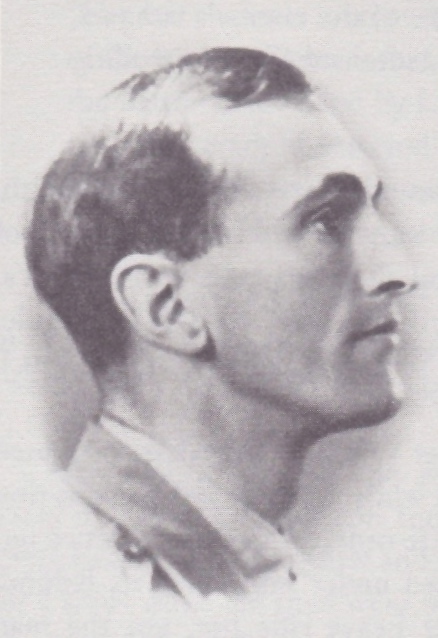
Major Hugh Seagrim: Probably the best known of all the men who served with SOE in Burma, Major Seagrim has become something of a legend. With two biographies as testament to his valour, this entry will be kept brief.
Seagrim was recruited by SOE’s Oriental Mission in January 1942, and very soon after he was driven to the Papun area to organise left behind parties to harass the Japanese invaders. The swift and decisive victory of the Japanese in Burma meant that Seagrim was soon left far behind the lines, where he chose to stay rather than try and catch up with the retreating British and Empire Army.
Eventually, in September 1944, the Japanese executed Seagrim with seven of his Karen comrades: Ba Gyaw, Saw Ah Din, Saw He Be, Saw Tun Lin, Saw Sunny, Saw Pe, and Saw Peter.
The two biographies are:
Grandfather Longlegs by Ian Morrison, 1947
Lost Warriors by Philip Davies, 2017
Personnel file: HS 9/1334/7 (Which says ‘DOB unknown’ (24/3/1909) and has an incorrect date of death).
Lots of internet hits on a ‘Hugh Seagrim’ search, but here’s three:
Sein Maung: a Burman born in 1924, Sein Maung joined SOE in October 1944. Between October and March 1945 he was trained, and deployed on 26 March as part of the Mongoose Special Group of Operation Character. Major Lucas reported that he was ‘Very intelligent, quick witted and alert. A good fighter with plenty of stamina and courage. An excellent linguist, with a knack of getting on with natives of all sorts. An extreme individualist – difficult to discipline – Temperamental – but probably the best of the bunch.’
Captain Sein Tun, alias Tunney: A Shan-Burman born on 11 November 1913, Sein Tun was an Army of Burma Reserve of Officer (ABRO 205). He was in the Burma Military Police 1935-37, but presumably must have retreated to India in 1942 for he is recorded as being recruited by SOE on 6 January 1943.
Within six days of being recruited, Sein Tun was training in Poona to go on Operation Eyemouth. This operation didn’t go ahead because of Operation Longcloth, the first Chindit operation. From June to September 1943, he is recorded as having joined Peacock in the Tamu area. In November he was conducting officer for a new Eyemouth Party before spending a month in the field as part of the Spiers operation in the Kokang area. It seems the commanding officer of Spiers, Lt.Col. Munro-Faure, returned Tun Sein for having ‘a lack of initiative and of interest in the operation.’
SOE / Force 136 got quite confused in 1944 between two Sein Tuns, this one and another, ABRO 565 of 2 Burif. SIS returned Sein Tun ABRO 565 to unit for security and financial reasons. The confusion led to one of the two men being forgotten about and left ‘kicking his heels’ in Calcutta for a month!
Captain Cyril Herbert Sell: Born 10 March 1908 in Wandsworth, London, Sell finished his schooling at sixteen and worked in shipping from 1924 to 1939. He joined the Army in August 1939 and was the rank of sergeant by the time he was selected for an Emergency Commission in 1943. Not long after completing OCTU, Sell was recruited by SOE and trained as a Jedburgh as he was fluent in French.
Sell led Jed. team Chrysler in France from August to October 1944, and then after a short period in the UK was shipped out to Ceylon. On 23 February 1945, Sell parachuted into Burma to serve on Operation Character in the Otter area. He remained in the field until 1st September, and was recommended for a Military Cross:

Personnel file: HS 9/1340/2
Signalman Dennis Alfred Richard Sexton: A very brief personnel file, and not having come across him in any operations, not much is known about Sexton. Born 28 April in 1923 in Peckham, Sexton joined SOE in December 1943 as a W/T operator. Trained at STS 54, Sexton evidently drowned in the Chindwin near Monywa on 17 April 1945, days short of his 22nd birthday.

Personnel File: HS9/1347/1
Naik Shang Hting Naw: a Kachin born in 1923, Shang Hting Naw had been a medical orderly at Rangoon hospital. He was recruited in the field in March 1945. He was then parachute trained at Jessore, to be deployed on Operation Heavy, team Wolf, from 6 April to 16 October 1945. He was dropped with Captain McIntosh plus nine others. Major Pennell reported that he was ‘very good, trustworthy – reliable and possesses initiative.’

Sergeant John Sharp: born 1 May 1923 in Merton Park, London, Sharp joined the Royal Armoured Corps and served with the Green Howards. He joined SOE and was operational in France from 10 June 1944 as part of team Isaac, operatinng the W/T. He was awarded the CdeG and a MiD.
After volunteering for more SOE work in the Far East, Sharp jumped into Burma twice with Lt.Col. Tom Carew. His first mission was in the Arakan as Camel, and the second was into central Burma as Weasel. Both ooperations involved working with Burmese nationalists of the Anti-Facsist Organisation (AFO) and Aung’s San Burma National Army. He was awarded the MM for his work in Burma.
For more on Sharp, see Keggie Carew’s ‘Dadland‘
Personnel file: HS 9/1350/1
Picture Credit: Personnel file (left) & Rod Bailey’s ‘The Wildest Province‘
Major John (Johnny) Kirkpatrick Hay Shaw: Shaw was born in Simla, India on 23 October 1916. Just before his 20th birthday, he was commissioned into the Royal Ulster Rifles, in August 1936.
Before joining SOE, Shaw served on the North West Frontier Province and North Africa. Joining SOE in late 1943, he attended paramilitary and parachute training in October of that year. The instructor’s report was, like many SOE reports about their students, not too kind. Apparently ‘A diminutive regular soldier’, Shaw in this officer’s opinion was ‘Not the personality usually expected of his rank’, but would be ‘An efficient officer so long as he does not have to do so much thinking.’
From May to November 1944, Shaw was on operations in Albania (see Bailey’s ‘The Wildest Province‘ for details) before being posted to the Far East. Before this, Shaw’s personnel file reveals that he was found guilty of losing secret documents in Taranto. Ironically, the officer signing off one of the documents about the loss of sensitive documents was one Major Leake.
From Albania, Shaw went to the Far East and parachuted into Burma in February 1945. Shaw was part of Operation Heavy (formerly Hainton), in Kengtung state, east of the Salween River. His recommendation for an MC states that he set up an intelligence network and raised 300 levies with whom he attacked the Japanese line of communication into Siam. Starved of air support and supplies, Shaw nonetheless carried out an efficient operation.
Shaw went on to serve in the Korean War where he won a DSO shortly before being killed on the Imjin River in April 1951. His son would have been nine years old.
Personnel file: HS 9/3151/5

Captain Ronald Charles Shearn: Born to a British father and French mother in Marseilles on 9 July 1924, Shearn and his family escaped to Oran after the defeat of France in 1940. He was a student in Algiers and later back in Marseilles before making his way to Britain by 17 January 1944. He had been accepted for service in the RAF when SOE picked him up. After interrogation established his bona fides, Shearn was trained at various SOE schools, where his finishing reports described him as ‘thoroughly 27 in outlook.’ The number ’27’ referred to France.
Training complete, Shearn was sent into France on 8 August 1944. His job, in the Dreux area, was to find up to 25 agents to make their way to Allied lines where they would report German dispositions. His alias for this operation was Rene Sarront. After this mission was successfully completed, Shearn was shipped out to the Far East. He was parachuted into Burma on 26 March 1945, joining Operation Heavy, team Lynx. He was killed in action leading an attack against twenty pro-Japanese Thai troops in Mongton Monastery. Shot in the wrist and stomach, he died of wounds on 4 May.

Poppy photo from Flower Meaning
Personnel file: HS 9/1351/10
Sergeant Shepherd: served on Operation Character, in the Hyena area.
Shwe Nyein: a Karen born 1919 in Myaungmya, Shwe Nyein was in the forestry service before joining 3 Burif. He was taken on by SOE on 6 March 1943 and proceeded to training from 10 March. He ended up being Major Noel Boyt’s driver.
Sim, Mr Stephen (Sim Kha Sun): a Chinese born in Singapore in 1918, Sim had been a medical student. He was recruited in Kunming in May 1943 to act as an interpreter on Operation Hainton. He left China on foot for the Hainton area of operations in February 1944, with a date of withdrawal recorded as 3 April 1945. After parachute training at Jessore in July 1945, he went back on to the operation, now renamed Heavy, on 15 August and stayed in the field until 19 October 1945.
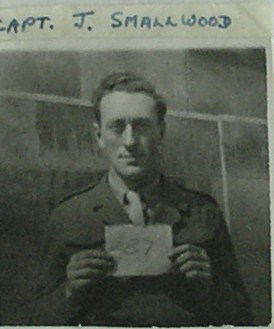
Major John Edward St. Clair Smallwood: born 24 April 1919 in Harrow, Smallwood attended Wellington College from 1932 – 1936, where he attended OTC. He was a trainee with Unilever when war broke out. He joined the Royal Armoured Corps, was granted an emergency commission in April 1940, and then saw service at home, including instructing at Sandhurst, until 1943 when he joined SOE.
He was sent to the Middle East, and parachute trained at Ramat David in the British mandate of Palestine during November 1943. The mission he was due to go on was cancelled so Smallwood returned to the UK and after more paramilitary training was dropped into France with team Citroen where he worked with the Maquis between August and October 1944. He was MiD for his work in France.
By December, he was en route to the Far East. After training in Ceylon, Smallwood parachuted into the Southern Shan States in March, remaining in the field until the end of October 1945. He was part of Operation Heavy, team Lynx.
Personnel file: HS 9/1375/1
London Gazette MiD August 1945
Smallwood also features in Rod Bailey’s ‘Forgotten Voices of the Secret War’

Sgt. Norman Arthur Smith: born 25 January 1924 in Bow, London, Smith was employed by SOE in 1943 as a W/T operator. On 28 August 1944, Smith was dropped into France where he was part of Jedburgh team Brian. He was MiD and awarded the Croix de Guerre for his work in France. He then volunteered for further service in the Far East, leaving in January 1945. Evidently he forgot to tell his mum, for there are letters from her asking of the whereabouts of her son in his file.
On 28 March 1945, Smith parachuted into Burma, joining Operation Character, team Walrus. He was in Red area, serving with Majors Denning and Cockle. Smith is mentioned many times in Sgt. Harry Verlander’s book (Verlander was also born in Bow).
Personnel file: HS 9/1382/3 *Note the NA link here gives Smith’s month of birth as June, not January.
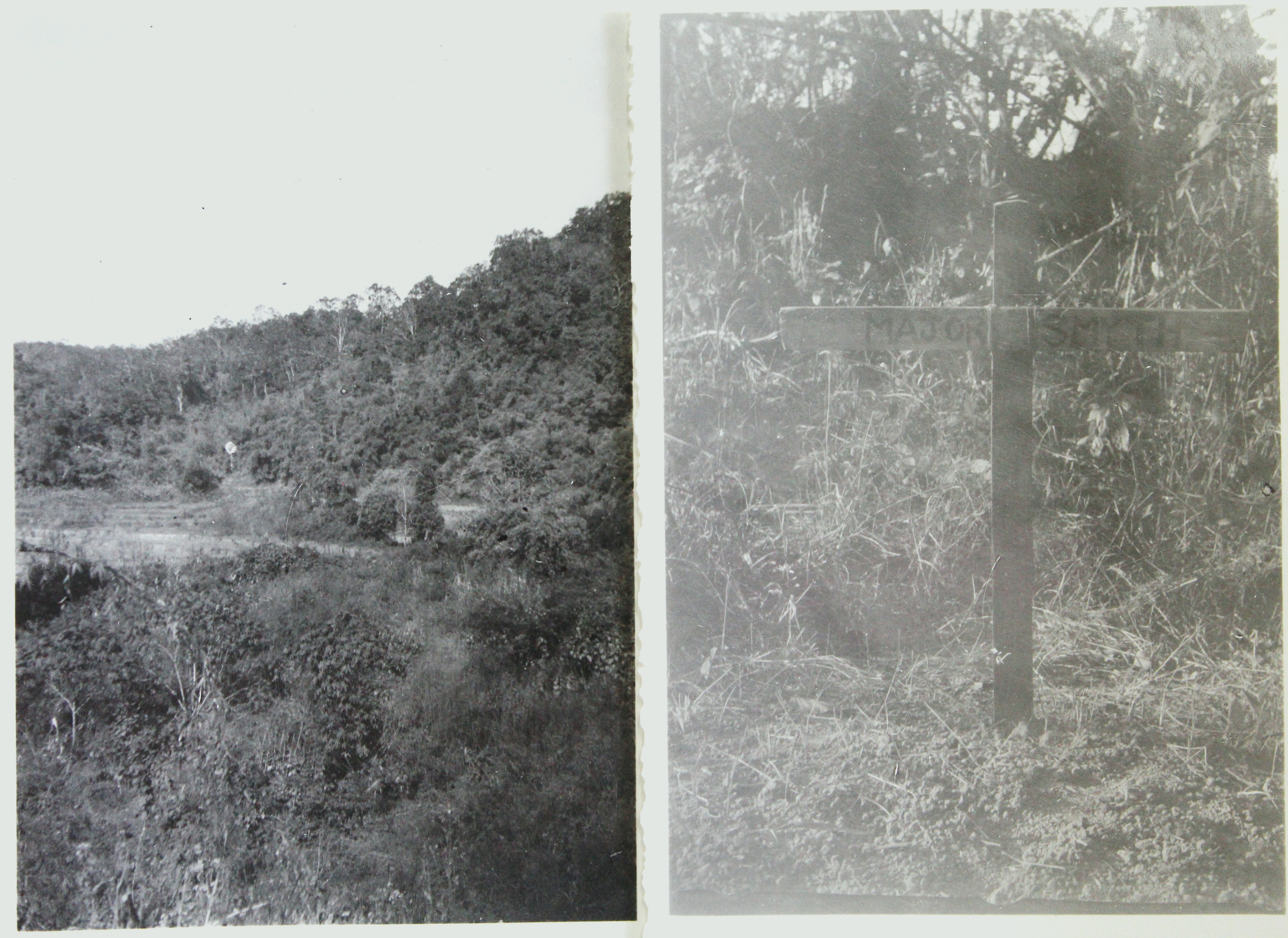
Major Smyth’s grave in 1946, before removal to Taukkyan Cemetery. From his SOE file.
Major James Brian Watt Smyth: Born on 6 August 1917, in County Kildare, Ireland, Smyth joined Force 136 in April 1944 as a staff captain. On 22 January 1945, he deployed on operations with a Chin Special Group of twenty men plus Captain Meredith as 2i/c. The operation was called Label, and they were team Rat.
The team was ambushed and scattered, having taken two casualties; Meredith was killed and Smyth wounded. According to the investigation of Major Maddox, Smyth was ambushed a further two times, and got shot through the chest twice on the second occasion on about 8 February. Maddox was able to locate Smyth’s grave and photographs of it were sent to Smyth’s mother, who was still hoping in 1946 that her son was missing.
Personnel file: HS 9/1386/2
Son Za Mang: a Chin with Operation Label, team Rat. Son Za Mang escaped with Chin Pau’s party after ambushes killed both the team’s British officers (Smyth and Meredith).
Sergeant Alfred Claude Brinton Sowden: Born in Truro, Cornwall on 12 March 1918, Sowden was a W/T sergeant who completed to operations as a Jedburgh. His first operation was in France where he deployed in civilian clothes to ‘an area thick with German troops and Gestapo.’ He was recommended for the British Empire Medal for his coolness under pressure, but was awarded the Military Medal in July 1945. Sowden was then posted to the Far East where he was sent into Burma on Operation Character with team Hyena from 20 February 1945.
On 7 September, Sowden was on the Dakota ‘J for Jig’ which went down in the Karen Hills killing all sixteen on board.
Personnel file: HS 9/1395/7

Poppy photo from Flower Meaning
Lieutenant Anthony Philip St. John: born 16 February 1924 in Moulmein, St. John was commissioned in the Army of Burma Reserve of Officers. His personnel file consists of just five sheets of paper, showing that he joined SOE in May 1945. He joined Operation Character’s Mongoose team in May as a Platoon Commander but proved to be ‘unpopular with the Karens’ which caused him to be exfiltrated in early July.
Personnel file: HS 9/801/1

Captain William (Bill) Oliver Steele: born 26 October 1921 in Islington, London, Steele joined the Lancashire Fusiliers a few months short of his 20th birthday. Until 1939, he was educated at the Stationers’ Company’s School in Hornsey, going on to work as a clerk for Middlesex County Council up to 1941.
In January 1944, he was picked up by SOE to become an instructor. His record shows his training reports for February to May 1944, after which he began instructing. He was described as ‘very hard working’ and ‘popular and respected amongst the students’.
On 10 December 1944, he left for the Far East. On 28 March, he dropped into Burma with Captain Wilson and Sgt. Gibbs as part of Operation Character, team Walrus, White area. He remained in the field until the end of October 1945, and was MiD.
Personnel file: HS 9/1410/4

Photo credit: Here
Lt.Col. George Lowther Steer: born 22 November 1909 in East London, South Africa, Steer was the architecht of SOE’s Indian Field Bradcasting Units (IFBU). Steer was an Oxford graduate and a journalist. He got invlved with propaganda in the Middle East before goiong to India, but to save duplication, much of his life has been written up here on the Intelligence Corps website.
Steer was killed in a jeep accident during the Christmas period, 1944. He had served in the Arakan and at Imphal in 1943 and 1944, pushing the concept of the IFBU so that by 1945 these units were attached to the Army’s divisions as they advanced into Burma during 1945. More on the IFBUs HERE
Personnel file: HS 9/1410/9
Jemadar Sum Lat Naw: a Kachin born in 1919, Sum Lat Naw joined the Burma Rifles in 1937. He joined SOE in April 1943, and trained with some of the Harlington team at EWS(I).. In June he went to Tamu, and then on to Fort Hertz until August when he returned to India to complete parachute training. He then parachuted into northern Burma on Operation Dilwyn on 11 October 1943, remaining in the field until 20 June 1944.
In November, he went into a new area for Operation Dilwyn with team Monkey until 7 March 1945. Three weeks later he dropped for a third time, joining team Lynx of Operation Heavy. Described as ‘Intelligent and hardworking.’
Havildar Sum Lut Gam (Hting Nan): a Kachin born in 1922, Sum Lut Gam was in the Burma Rifles and served in the first Burma campaign. He remained in Burma in 1942, and was recruited by SOE in the field during March 1944. Working with the Dilwyn team, Sum Lut Gam was extracted to India in October 1944, completed parachute training at Chaklala, and returned to Dilwyn on 28 November as part of Monkey. After extraction on 7 March, he was deployed on 6 April with Wolf for Operation Heavy.
Subedar Sum Lut La: a Kachin born in 1923, Sum Lut La was in 3 Battalion Burma Rifles. He stayed in Burma in 1942 and was recruited in the field in October 1943, joining Dilwyn. Extracted to India in October 1944, Sum Lut La was parachute trained and redeployed on Operation Dilwyn, team Squirrel, on 28 December. He was extracted for four weeks in June, and then returned to the field on 29 June until 28 September 1945.
Lt.Col. wrote highly of Sum Lut La, recommending him for the MC and a commission.
Jemadar Sum Lut Naw: a Kachin who served with 4 Battalion Burma Rifles, Sum Lut Naw joined SOE in April 1943. He was at Chaklala in September 1943, and presumably deployed on Dilwyn.
Havildar Sum Lut Tang: a Kachin born ‘about 1925’, Sum Lut Tang was in the Burma Rifles from 1940, and served in the first Burma campaign. He remained in Burma, and was recruited in the field by Shan Lone in April 1944. Extracted to India in October 1944, he completed parachute and paramilitary training before redeploying on a renewed Dilwyn, team Gazelle, on 28 December. After Dilwyn, Sum Lut Tang joined Ferret group on Operation Character from 8 May to 18 October 1945.

Captain Kirby Washington Sutton: born 4 October 1918 in Cardiff, before the war, Sutton was a journalist in Gloucester. He joined the Army in October 1939, serving in the ranks of the Royal Signals. He was commissioned in February 1944 and joined SOE the following September. He was interviewed in July 1944, and apparently he was keen to join after being told his ‘job combined that of a fighter, a propagandist, and a trafficker of merchandise in Burma’. He served with No.2 Forward Propaganda Unit, formerly known as the Indian Field Broadcasting Unit (IFBU). He was operational in Burma from February 1945.
Personnel file: HS 9/1430/7
Subedar Swan Do (also spelt Swando on his record): a Chin born in 1921 (possibly 1922), Swan Do joined the Burma Army Signals in February 1940. After the first Burma campaign, he joined SOE in October (possibly August) 1942 and went to Nazira and Meerut for W/T training before the end of the year. He joined Station G at Fort Hertz from March to October 1943. He then went overland to join Dilwyn until 20 June 1944. When most of Dilwyn were withdrawn in June, they completed parachute training preparatory to redeployment in a new area for Dilwyn, further east into Burma. Swan Do dropped on 28 December with Squirrel. Shan Lone described Swan Do as a ‘First class W.T. operator. Intelligent and hard working.’
Lt.Col. Crosby reported that he was a ‘first class operator, the best I have had anywhere’ and recommended him for the BGM and a commission. He was judged by ME 9 staff to be the best W/T operator in the field.
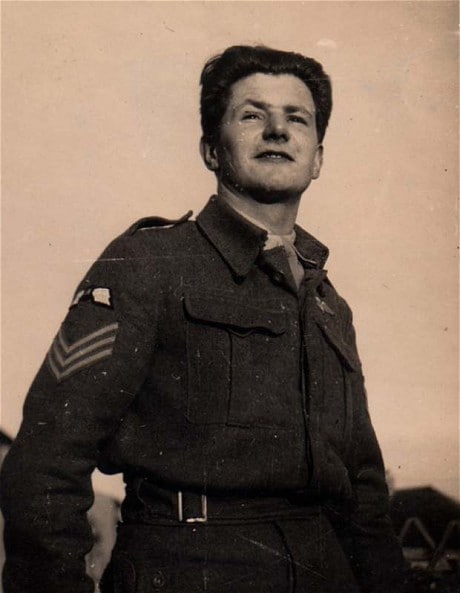
Picture Credit: Tack’s Telegraph Obituary, 2014
Sergeant Gordon Hugh Tack: On his 21st birthday – 21/11/1944 – Tack was on a troop carrier sailing through Suez en route to India. After completing a Jedburgh operation in France, he volunteered for more in the Far East because it was a ‘job I knew, same job as in France. I was quite good at it.’ Before SOE, Tack was in the Royal Armoured Corps.
Tack parachuted into Burma as team Pig, part of Operation Nation, tasked with working with nationalist Burmese. The two officers making up his Jed team were Major J.H. Cox and the monocle toting Major Reid who apparently ‘did not change his socks often’.
Team Pig was dropped to Major Carew’s team Weasel in March 1945, from whose reception they were to move to their area of operations south of Toungoo. They hitched a lift with on a bullock cart, but they suspect it was their driver who betrayed them to an Indian National Army unit, who surrounded them and ordered them to surrender. In his IWM interview, Tack recalls how he and his two officers stood shoulder to shoulder and ‘opened up’, escaping through the gap they created.
Tack then spent five nights on his own, drinking paddy water and travelling at night until he was reunited with his team. Slim’s XIV Army advanced so swiftly that his team was soon over run, so he said Pig was ‘not very satisfactory’ because they ‘didn’t do a great deal of good.’
Personnel file: HS 9/1438/7
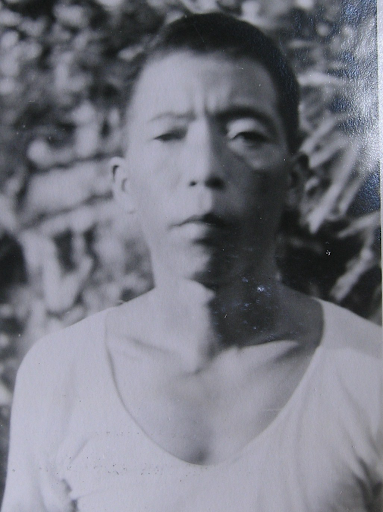
Tan Maung Naw I (R/1039): a Kachin cultivator from Myitkyina district, Tan Maung Naw I was aged 30 when recruited by SOE on 1 June 1944.
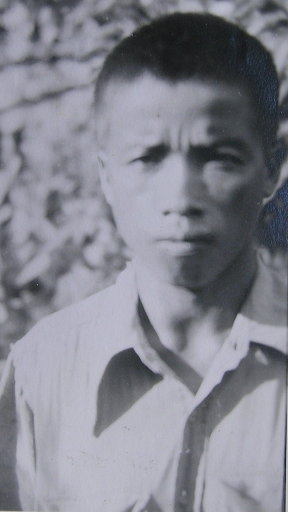
Tan Maung Naw II (R/1040): a Kachin cultivator from Myitkyina district, Tan Maung Naw I was aged 25 when recruited by SOE on 1 June 1944.
Tam Sang: a Chinese man with ‘Armourer’ beside his operational role & special qualification. Tam Sang was Part of the 6th party of Operation Spiers, travelling overland to the Kokang region from 14 May 1944. He left the field on 10 September the same year. He returned to Kunming barracks where he was put on ‘temparary [sic] duty’.

Original Picture Credit via ‘Legion‘, Canada’s Military History Magazine
Captain Leonard Jacques Taschereau: born on 15 August 1910, Taschereau was a French Canadian born in Saskatchewan. He was married and had two children by the time he joined SOE in late 1943. Taschereau had been a mechanic in the Canadian Air Force 1927-9, and he joined the Canadian Army, joining three commissioned brothers, in 1929. He attained the rank of Major, but after a fight with an adjutant, was demoted to Lieutenant. One of his SOE reports makes it clear that he joined SOE because he felt hard done by and wanted to get his rank back.
His first operation with SOE was into occupied France on 10 June 1944. He ‘carried out numerous guerrilla operations’ and was awarded the Military Cross for his work in the Foret de Soulaines area on the Diplomat circuit.
Taschereau then proceeded to the Far East where he completed as second operation in Burma from 7 April 1945. Serving under Lt.Col. Peacock as part of the Otter team of Operation Character, Taschereau was described as ‘a most energetic, gallant and valuable young officer.’
Personnel file: HS 9/1442/1
Tha Aung, alias Tin Maung: Tha Aung was an Arakanese who was recruited for initial Billet operations. He was recruited by Major Wemyss at Satpaung, where he was working as a clerk for CAS(B), on 1 April 1944. He went behind the lines as a guide, returning on 27 June 1944 with Hla Maung. He then worked as a storeman in India to keep him from being a security threat with his SOE knowledge.
Tha Aung (R1050): a Burman cultivator from Mawlaik district, Tha Aung was 22 years old when recruited on 1 June 1944.
Second Lieutenant Tha Gyaw: Tha Gyaw was born in 1914 in Myohaung, Arakan. He was recruited by Force 136 on 7 November 1944 and ended up playing a rather crucial role in the Billet series of operations.
Tha Gyaw was the leader of Hound, the party which was dropped into Arakan on 26 November 1944 to prepare for further parties which would assist XV Corp’s coming offensive. Hound received Lion (another all Burmese team) on 3 December, and then provided a reception for Camel, the party with Major Carew in charge, on 27 December. Tha Gyaw was of such assistance that on 7 February 1945 it was recommended that he be given an immediate commission. This was granted, but it seems he voluntarily relinquished it on 10 August 1945.
The success of these Arakanese operations led to the ‘green light’ for further Billet operations in central Burma, known as Nation.
Tha Gyaw II: Tha Gyaw II was a ‘close friend’ of Tha Gyaw I, above. Tha Gyaw II was born in 1920, and was an organiser for the Arakan Defence Force. He almost left for India with Thein Pe and Tin Shwe in 1942, but was struck down by dysentery. He went to Arakan from Rangoon in November 1944, and was taken to India for interrogation. He was later used with (promoted) Lt.Col. Carew, Captain Brown and Sergeant Sharpe on Operation Nation as part of team Weasel.
Havildar Tha Hling / Hlaing: a Burman farmer from the Tamu area, recruited by Major Peacock in May 1944. Tha Hling was trained in India before deploying to Burma on 23 February 1945 as part of Operation Character’s Otter team. In November 1945, Peacock wrote ‘A very good type. Did excellent work against the Japs on and off the road. Very popular with the Karens.’
Naik Tha Htoo: a Karen cultivator from Papun district, Tha Htoo joined SOE on 21 April 1943, aged 26. Recorded as being on active service from recruitment until 25 May 1944. Served with P Force.
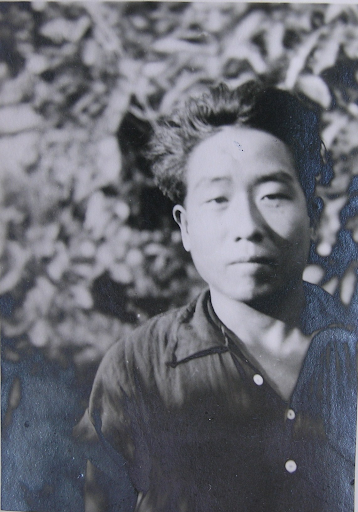
Tha Khan: Tha Khan was a Shan Burman cultivator from Myitkyina district who joined SOE on 1 June 1944, aged 23.
Tha Pe: a Burman cultivator from the Upper Chindwin area with both legs tattooed from the knee, Tha Pe was 23 years old when he joined SOE on 27 February 1943. It looks as if it has the word ‘executed’ written beside his father’s name. Served with P Force until March 1944.
Jemadar Than Kovai: recruited from the Burma Signals, Than Kovai was a Chin from Tiddim. He joined the Burma Rifles in around 1933, and retreated to India in 1942. He was further W/T trained at Nazira and Meerut, and was deployed overland from mFort Hertz on Operation Dilwyn from April 1943 until October 1944. Back in India, he completed parachute instruction and was dropped into Burma as the W/T operator for Dilwyn’s Gazelle area (28 December to 26 April 1945). Major Shan Lone described him as ‘Slow but very steady. Hard working and reliable.’

Naik Than Pe: a Burman cultivator born in 1920, Than Pe was recruited by Kan Choke on 1 June 1944. After training at Chaklala and ME25 in Ceylon, Than Pe was deployed as part of the Ferret Special Group of Operation Character. Major Poles, OC Ferret, wrote:
‘A young NCO who did not shine during training but who has developed into a brave and dependable NCO. Have never seen such marked change in a man in so short a time.’
Jemadar Than Shwe: a Burman born in 1914, Than Shwe joined SOE on 10 January 1943. He was parachute and W/T trained during January and February, before ‘trekking with W/T Daarjeeling area’, and then ging back to EWS(I) for more paramilitary training. From June to October 1943, he is recorded as being active on the Imphal and Chindwin front. In November 1943, he completed a refresher parachute course, and then W/T trained in Ceylon and at Meerut between March and September 1944. In September, there was an attempted infiltration overland to Rangoon via the Arakan, and when that failed he was dropped on 27 January 1945 as part of Operation Nation, codenamed Donkey.
Thang Chin Hang: a Chin who was deployed on Operation Label/Rat on 22 January 1945. After both commanding officers were killed, Thang Chin Hang escaped back to Allied lines with Havildar Lian Za Khai.
Thang Chin Pau: a Chin who was deployed on Operation Label/Rat on 22 January 1945. After both commanding officers were killed, Thang Chin Pau escaped back to Allied lines with Jemadar Chin Pau.
Thang Kung (Charlie): a Chin whose recorded DOB is probably wrong (25/9/24). He served in the BFF as a driver in the first Burma campaign, and retreated to the Chin Hills where he was recruited by Captain Hobbs. Between August 1943 and May 1944, he was W/T trained to advanced level, as well as completing courses at Chaklala and EWS(I). His first operation was Spiers, from 5 May to 21 October 1944. His second deployment was as Elk, later Yak, with Ye Tun, from 28 January to 30 July 1945. See blog post ‘The Problem with Charlie’
Thawng Dai Thang: a Chin who was deployed on Operation Label/Rat on 22 January 1945. After both commanding officers were killed, Thawng Dai Thang escaped back to Allied lines with Jemadar Chin Pau.
Havildar Thein Maung (R/1025): a Burman born in 1923, Thein Maung joined SOE in January 1943. He worked on the Chindwin front with P Force before collective training preparatory to deployment on Operation Character. He served with Otter from the start of the operation in February. Lt.Col. Peacock reported that he was a ‘very good boy’ who was ‘popular with the Karens, and a good leader.’
Thein Maung (11492): a Burman born in 1919, Thein Maung was recruited from the BUrma Sappers and Miners in October 1944. He completed collective training and was deployed on Operation Character as part of Major Lucas’ Mongoose Special Group. Lucas wrote:
‘Very strong and willing manual worker. An extremely hasty temper & difficult temperament. Not very good in coup de main.’
Thein Zaw: a Burman born in 1921, Thein Zaw was a member of the Anti-fascist Organisation (AFO). He was recruited in March 1945 and was deployed on 1 April as Zebra, part of Operation Nation. He was apparently given officer status but no rank is recorded. In a message back to India, Major Hood described Thein Zaw as a ‘genius’, possibly for the intelligence network he was able to quickly establish. On 25 April, it was reported that he had blood poisoning, and that a glucose tonic and Marmite were required. He recovered and later went to officer training for the Burma Navy, who rejected him.
Havildar Thet Tun: a Karen born in 1922, Thet Tun was recruited in March 1943. He was trained until June 1943 when he was deployed to Tamu in the Chin Hills. After a spell in hospital in Calcutta, probably leave, he proceeded to the Chindwin area on 14 December 1943. He later deployed on Operation Character with the Hyena group from February to October 1945. Major Turrall reported that he was ‘present at many ACTIONS and AMBUSHES’ but that he ‘was in the later stages a poor Section Commander’ who contributed little to morale.
Thet Wa: a Karen apparently born in 1925, Thet Wa joined SOE in January 1943. It is recorded that he was ex RAF A/C II of 224 Group. After training in early 1943, Thet Wa deployed with Captain Nimmo as W/T operator on 14 October on Operation Harlington.
Thet Wa was captured by the Japanese in March 1944 and taken to Rangoon. On 17 March 1945, when taken to the Karen Hills by the Japanese to act as an interpreter, he managed to escape and rejoin SOE, working with Hyena.
Thien Pe: a Shan Burman cultivator from Mawlaik district who was trained between August and December 1944, Thien Pe deployed on Operation Nutshell/Antelope from 20 March to 5 October 1945.
Major Abbey reported that he was ‘a very cheerful person and got on very well with the Karens. Intelligent, hard working and very loyal.’
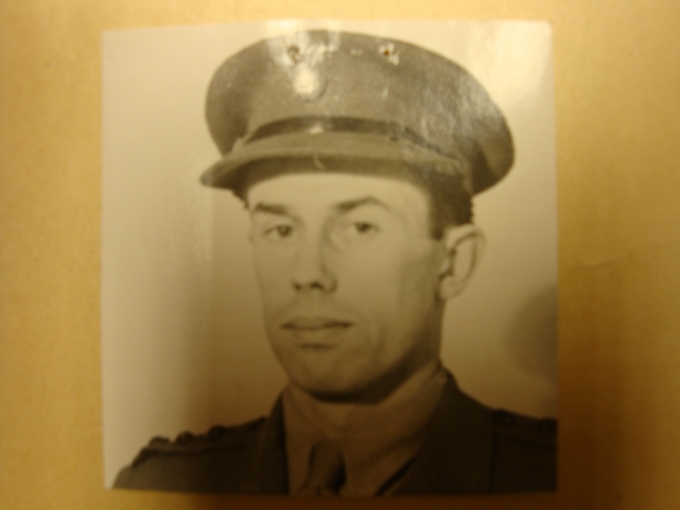
Captain Arthur Leonard Bell Thompson: A successful writer after the war under the pen name of Francis Clifford, Thompson was made an Army of Burma Reserve Officer (ABRO) on 8 December 1939. By 1 August 1940, he was company commander of 1/20 Burma Rifles (Burifs). In March 1942, after helping in the defence of Toungoo, he was ordered to take his company of Karens to join SOE officers and their levies on the the road leading from Toungoo into the Southern Shan States. For his part in obstructing the Japanese advance along this road, Thompson won the DSO:

Cut off by the Japanese advance, Thompson then led his men north to Fort Hertz, from where he was eventually flown out to India in August 1942. This escape from Burma is the subject of his book ‘Desperate Journey’.
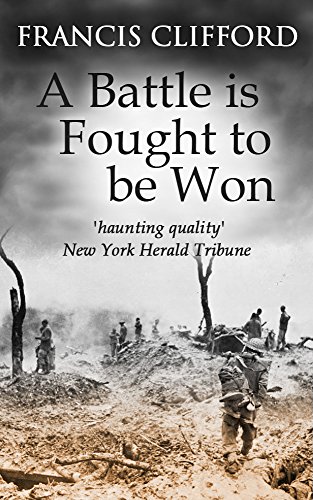
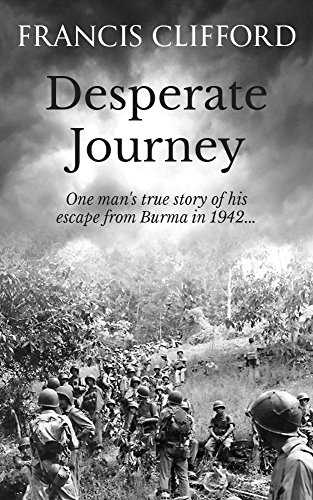
Personnel file: HS 9/1460/6
Tin Maung: a Burman W/T operator who deployed on Operation Corton on 5/6 pril 1944. He sent back the intelligence collected on the movement of Japanese shipping and aircraft. Captain Green reported:
‘Tin Maung is a pure Burman and we have always found it extremely difficult to trust pure natives, especially Burmese of his type, but I am pleased to report that his conduct and trustworthiness and ability is outstanding in every respect, and I strongly recommend him for the Military Medal.
For more on Corton, see ‘Monkey Nuts are Rotten’
Jemadar Tin Maung: Tin Maung ‘evacuated to India with the Burma Army’ and there was recruited into SOE. Tin Maung was dropped with Terrier of Operation Nation to operate the W/T. Tin Maung was recommended for the British Empire Medal for his work on this operation.
Tin Maung: a Burman deployed as an Interpreter on Operation Nation, team Panda. Dropped to Yak on 3 April 1945, it was quickly discovered that Tin Maung ‘could not speak sufficient English’ so he was described as ‘quite useless’.
Naik Tin Nu: a Karen born in 1921, Tin Nu was recruited in October 1944. Between recruitment and March 1945 he was attended paramilitary, jungle and parachute training, as well as collective training in Ceylon. He was deployed on 26 March, by parachute, serving with Mongoose until 2 November 1945. Major Lucas reported that he did ‘excellent work training levies’ but that he was not ‘particularly good as an N.C.O. in active ops.’
Lance Naik Tin Nyunt: a BUrman recruited in August 1943, Tin Nyunt was trained as a W/T operator and was first deployed in Arakan in September 1944 with Aung Din (see above). This short-lived first mission ended on 10 October, and after advanced W/T training Tin Nyunt was parachuted into Burma as Donkey. He died of malaria in the field on 18 May 1945.

Poppy photo from Flower Meaning
Jemadar Tin Tun: a Burman born in Mandalay in 1919, Tin Tun joined SOE with the Burma Sappers and Miners in October 1944. After parachute and paramilitary instruction, he was trained at ME 25, Ceylon, and then deployed with Walrus Special Group, Operation Character. By 1945, he had served six years in the Army and wanted to join the police. His commanding officer, Major Campbell wrote:
‘A very good G.C.O. Popular with all the men. Intelligent and trustworthy. He will make an excellent Police Officer.’

Major Aubrey Alwyn Edgar Trofimov: Trofimov was born in Manchester on 7 December 1921. His father was a Russian professor and his mother was British. At the outbreak of war, Trofimov was studying Architecture at university. He joined the Royal Artillery in September 1941.
Described as ‘a misfit for a gunner’, Trofimov was taken on by SOE. He won the Croix de Guerre for his exploits in France before being sent out to the Far East in November 1944.
On 20 February 1945, Trofimov parachuted into Burma on Operation Character. One of his reports describes him as having ‘plenty of guts’, which he apparently displayed as leader of Mongoose Green, winning the MC for his gallantry in April, and a MID in August. Trofimov was withdrawn from Character on 21 September 1945 after eight months in the jungle.
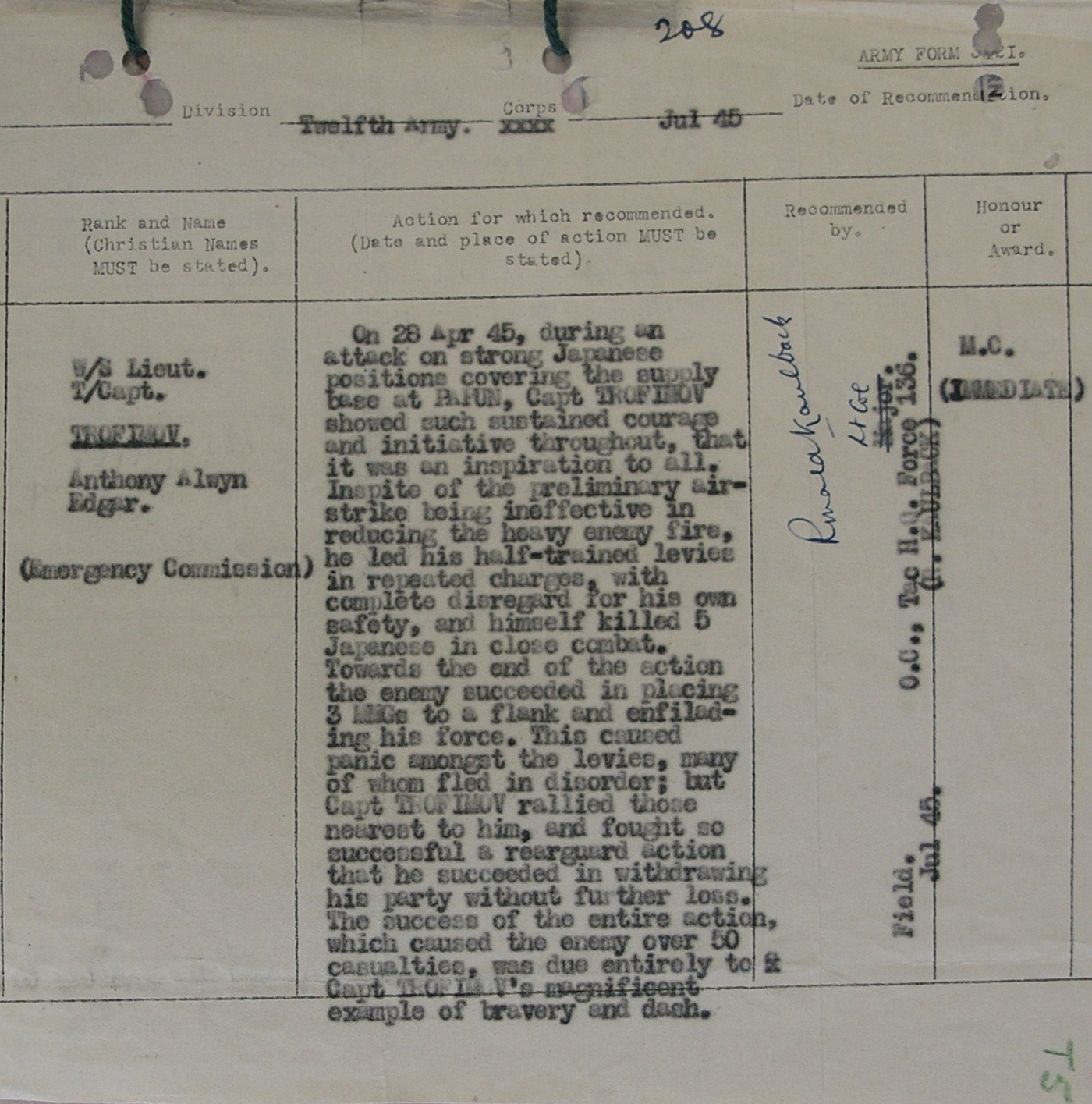
Personnel File: HS 9/1485/2
Guardian obituary
Times obituary
IWM interview
Captain Thomas John Troward: born 20 July 1917, educated at Rutlish School and Glasgow University, Troward was a signaller in the TA during the ’30s. Called up in 1939, he joined the Royal Armoured Corps, serving with 2nd & 6th Tanks until January 1941 when he was posted to 7 Armoured Division as liaison officer in the Middle East.
By 1943, he was SOE trained and operational in the Peloponessus from October to 30 January 1944. With the reorganisation of this Force 133 area he was posted to the Far East. There is a gap in hos record from March 1944 to March 1945, when he parachuted into Burma on Operation Character. He was part of the Walrus team where he served as signals officer.
Personnel file: HS 9/1487/5

Major Alfred Trutwein: an Anglo-Burman, Trutwein was born in Bassein, Lower Burma, on 9 October 1909. He attended St. Joseph’s Diocesan School and University College in Rangoon, where he read Law. He was working as a lawyer in Rangoon when war came.
Commissioned into 6 Rajputana Rifles in March 1943, by May he was being trained by SOE, attending an officers course, parachute course, sea landings and what appears to be training for Operation Flimwell II. He was then transferred to the Indian Field Broadcasting Unit (IFBU) and ended up in command of Operation Barge from November 1944 to February 1945. From May to June 1945, he is recorded as being on a ‘Mission to Rangoon’, but details of this mission, and its name, are yet to be discovered.
He left SOE in August 1945 to become part of the Civil Affairs Service (Burma), CAS(B).
Personnel file: HS 9/1432/4

Photo Credit: Family Collection
Lt.Col. John Cromarty Tulloch: born around 1896, Tulloch served in the Great War as well as in the inter-war period, as his medal ribbons show:

There are files dedicated to Tulloch in both the National Archives and the British Library. He was obviously a very colourful character, see for example Terrence O’Brien’s The Moonlight War. He has also been on the TV based on his post-war exploits.
Before going to Burma section of SOE’s Force 136, it is unclear what Tulloch did other than start WW2 in the Local Defence Volunteers, and service of some sort in Italy. He was trained in Ceylon, and dropped into Burma on 24 March 1945 in charge of Walrus team of Operation Character. He won the DSO for his work with Force 136 inn Burma.
He formed an affection for the Karens, and wanted to help them after the decolonisation of Burma, when the Karen were left under the control of the majority Burman/Bamar population. This led to quite a lot of controversy, and ultimately MI5 surveillance and a prison sentence, along with being stripped of his rank. Tulloch maintained that he was set up, but he was certainly involved in action which were contrary to HMG’s official policy regarding Burma after 1948.
Tulloch has no SOE Personnel File.
London Gazette (DSO)
London Gazette (Removed from Army 1952 ‘on conviction by the Civil Power’)
London Gazette (deprived of rank)
Tun Gyaw (also Kyaw), alias Tha Gyaw: a Burman from the Arakan, Tun Gyaw was involved in an early Billet operation in the Arakan from 20 August to November 1944. He then deployed twice by parachute on further Billet operations. The first was as part of Manual (Arakan) with the Lion team from 3 December 1944 to 1 February 1945. He was then trained in Ceylon before dropping with Weasel on 2 March 1945.
Havildar Tun Lin: a Karen born in 1917, Tun Lin parachuted into Burma in February 1943 as part of the four man Harlington team tasked with locating Major Seagrim. He had been recruited as a levy by the Oriental Mission in 1942, and escaped to India with Captain Nimmo. He was executed in Rangoon in September 1944, with Seagrim and six other Karen (Ba Gyaw, Saw Ah Din, Saw He Be, Saw Sunny, Saw Pe, and Saw Peter).
Naik Tun Nyan: a Burma from Mawlaik district who was recruited in February 1943, Tun Nyan patrolled with P Force before training in India and Ceylon. He deployed as part of the Otter Special Group on 23 February 1945, remaining in the field until October. Described as ‘brave and energetic’.
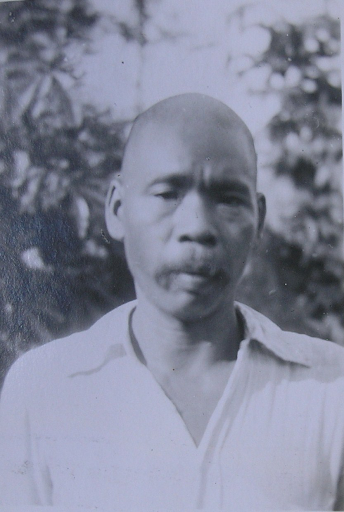
Tun Pa: a Shan Burman cultivator from Myitkyina district recruited on 1 June 1944, aged 45.
Tun Sein, alias Maung Thano and Nanda Mala: born around 1900 in Arakan, Tun Sein was a propaganda officer with the Arakan National Council. He was arrested under the Defence of Burma rules and imprisoned in India. He joined SOE from prison in March 1944. He is recorded as having been sent on the initial Billet operation on 31 March 1944, with Po Hla, Tha Aung, and Nyo Tun. He was captured by the Japanese who did not believe his cover story and taken to Rangoon and imprisoned there. After four and a half months, the Japanese released him to work as an interpreter. He eventually escaped and managed to report to Lt.Col. Wemyss on 9 July 1945.
Jemadar Tun Sein: Tun Sein’s date of birth is recorded as ‘not known’ within his one page personnel file. His unit was the Burma Sappers and Miners.
His one page is a redacted citation for an MBE, which he was awarded:
‘Jem. TUN SEIN was landed by parachute behind the enemy lines in the TOUNGOO area in Jan 45 to organise an intelligence network. On landing he and his party were discovered by the enemy but managed to evade them in spite of a most vigorous and widespread search. He immediately started organising his network and in spite of the search related above (which continued for some time) he daily reported Jap troop movements and dispositions in the SITTANG valley from Feb until the end of April. His intelligence network finally extended from PYINMANA in the North to PYU in the South.
The intelligence provided was of the greatest value to Army and the RAF which took full advantage of the targets provided by him. Jem. TUN SEIN finally organised and commanded a group of Burmese Guerrillas in a most efficient manner, inflicting, in a number of actions, heavy casualties on the enemy.’
Tun Sein was part of the Nation operation, team Terrier with Kan Nyunt and Tin Maung.
Personnel file: HS 9/1339/5
London Gazette: MBE
Jemadar Tun Sein (11634 and P45674): a Karen career soldier who joined the Army in June 1930, aged 18 or 19. He is recorded as serving with 1st Rangoon Battalion, Burma Military Police. He was involved in suppressing the Saya San rebellion in 1932, and served in the fist Burma campaign. After joining SOE he was part of P Force in March 1944.
Tun Sein: part of Operation Label, team Rat, Tun Sein apparently stayed behind to work for the Japanese after the two British officers in charge of the mission were killed by the Japanese, rather than escaping with Jemadar Chin Pau.
Tun Sein: a Karen born in 1922, recruited by SOE in Poona in October 1944. After training between October and December 1944, Tun Sein was part of Major Hedley’s Bison Special Group tasked with gathering intelligence in the Mandalay area. This operation ran from January to April 1945. Afterwards, he joined Otter and Ferret from May to October 1945. He is recorded as Karen, but referred to as Kachin in reports by officers he served with.
Lance Naik Tun Sein: a Burman born in 1925 in Meiktila, Tun Sein was in the Burma Sapers and Miners. He joined SOE in October 1944, attended collective training with Walrus Special Group in Ceylon, and then deployed on Operation Character from 24 March to 22 October 1945. Apparently fond of cars and wanted to join an MT unit of the army after the war.
Tun Shwe I: a Karen who joined the Burma Army Signals in October 1940 and worked at the permanent W/T station based in Maymyo. After retreating to India, Tun Shwe joined SOE in October 1942, and after training was parachuted into Burma as part of the initial Harlington team. After his arrest and incarceration in Rangoon, he apparently died in May 1944 from ‘malaria and paralysis.’

Poppy photo from Flower Meaning
Havildar Tun Win: a Burman born in 1914, Tun Win was a cultivator until recruited by Major Peacock in 1943 for P Force patrols. After training in India and Ceylon, Tun Win was deployed as part of the Otter Special Group from February to October 1945. He was ‘popular with the Karens.’
Tun Yin: a Karen who joined the army in 1941, Tun Yin served with No. 1 A.T. Company and took part in the first Burma campaign. He joined SOE in October 1943 after serving with the Chin Levies. Tun Yin deployed twice with Force 136, once as Operation Bottom from 1 December 1944 to 31 January 1945, and second from 29 April 1945 with Operation Nutshell, team Tiger . He transferred to Antelope in the field, ceasing operations on 5 October. Described as ‘intelligent and very loyal’, Tun Yin’s mother died as a result of Japanese brutality.
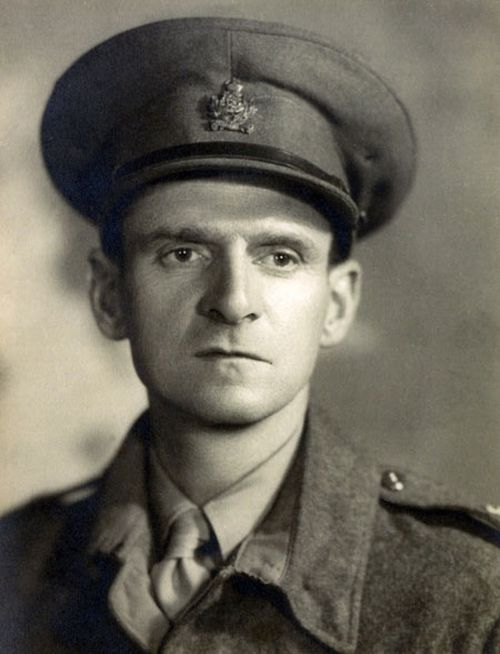
Major R.G. Turrall DSO, MC. Picture credit the Military Intelligence Museum
Major Rupert Guy Turrall: Another officer who appears to have lied about his age since there are two DOBs on record, Turrall’s PF reveals an interesting and very well travelled life. Born 27 October 1893 (not 1899) in Devon, Turrall attended Queen Elizabeth’s Grammar School before going on to Cambridge to study engineering in 1912-14. During the Great War, Turrall served with the Royal Engineers achieving the rank of Major commanding 99 Field Company. He saw action in Gallipoli with the New Zealand Division and then in the Balkans until 1919. He was twice MiD (1917 & 1919).
After the Great War, Turrall returned to Cambridge where he completed a Master’s degree in Astronomy and Geology. The inter-war period was spent working all around the world:

During the Second World War, Turrall served in Abyssinia where he won the MC and then on Crete. After serving with the Chindits, Turrall joined SOE / Force 136, parachuting into Burma on Operation Character as o/c team Hyena. Turrall was in the jungle from 20 February until 20 October 1945. He won the DSO for his work with Hyena. Twice wounded by grenades (Italian and Japanese), Turrall also decided to try and convince the Japanese that their emperor had surrendered on 15 August. He was held captive and slapped about a bit before escaping back to his guerrilla force (see Louis Allen, Burma, The Longest War pp540-3).
For DSO and MC citations, see the Military Intelligence Museum
Personnel file: HS 9/1493/8
U Bau Maung: a Burman who served with Operation Nation, team Cow, who was useful at collecting intelligence, but had little English.
U San Tint: a Burman who served with Operation Nation, team Giraffe, who was ‘most useful’ when he wasn’t ‘incapacitated by sprained ankle’.
Captain Van Kett: an Anglo-Burman born 29 May 1921, Van Kett is recorded as having joined the Oriental Mission on 7 September 1941 as a civilian W/T operator. He was evacuated from Fort Hertz to India in May 1942, and after refresher W/T training was sent to the Chin Hills. He was later parachute trained and joined Mongoose for collective training in Ceylon. Deployed on Operation Character from 26 March to 1 September 1945, when he joined Tactical HQ in Rangoon.

Sergeant Harry Arthur Verlander: born 27 December 1923, Verlander joined SOE from the Royal Armoured Corps. He served as a Jedburgh in France with team Harold from 16 July 1944, for which he was MiD and awarded the Croix de Guerre.
Almost posted to Holland, Verlander volunteered for the Far East and was duly shipped out there instead, where he ended up parachuting into Burma. He was part of Operation Character, serving in the Walrus area under Lt.Col. Tulloch.
Verlander’s PF does not give much else away, but he does in his memoir, ‘My War in SOE’:

Personnel file: HS 9/1528/7
Captain Peter Charles Henry Vickery: born in London on 19 December 1920, Captain Vickery was 24 when he died. Before joining SOE, he was serving with GHQ Liaison Regiment of the Royal Armoured Corps (RAC). He joined SOE as a Jedburgh in January 1944.
His personnel file lists him as being away (overseas) from the UK on the following dates:
- 20 September 1944 – 1 October 1944
- 3 October 1944 – 21 November 1944
- 28 November 1944 – ?
- Left for India 12 March 1945
It is not clear whether he was on operations for all of these absences, but a battle casualty report records that he received a shrapnel wound at Nijmejen, so presumably he was deployed in support of Operation Market Garden in September. His Jed team consisted of an American, Sergeant Beynon, and a Dutch Captain, Bestebrutje; they were codenamed Stanley.
Captain Vickery took off from Jessore on 1 April 1945 to parachute into Burma as team Hart of Operation Nation with Captain Marchant and Sergeant Colvin. The plane exploded on take off killing all on board. He is buried in Chittagong cemetery, India.


Poppy photo from Flower Meaning
Personnel file: HS 9/1532/5

Photo Credit: The National Archives, HS 7/107
Major Godfrey Hugh Vivian: born 17 August 1907 in Swansea, Vivian was specifically recruited by SOE from the Nigerian Colonial Service in early 1945, where he was an inspector of mines. Prior to Nigeria, he had worked in Burma between 1927 and 1934 at the Mawchi Mines.
By May 1945, he was serving on Operation Character under Lt.Col. Peacock, back in the Mawchi area. Peacock regarded him very highly, recommending him for promotion. Vivian secured that promotion to Major and remained in the field after the war ended to serve as a liaison officer with the Civil Affairs Service, Burma. The Nigerian Colonial Service were most eager for him to be returned to them, so it was recommended that he be fast-tracked back to Nigeria in mid 1946 after he finished in Burma.
Later rumours that Vivian was back in Burma assisting Karen ‘rebels’ against the Government of the Union of Burma were incorrect – he was still in Nigeria.
Personnel file: HS 9/1537/9
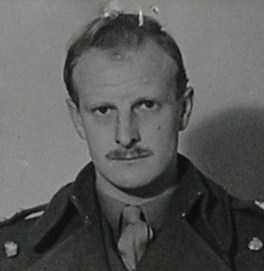
Major Harry Mann Wakelin: From Witham in Essex, where he was born on 19 December 1918, Major Wakelin had a ‘busy’ war. Granted an emergency commission on 15 June 1940, Wakelin was first sent to Egypt with his regiment, the Royal Horse Artillery:
Egypt:- Nov 1940 – February 1941
Greece:- Feb 1941 – April 1941
From 28 April until 20 May, Wakelin was a POW. He escaped.
20 May 1941 – 15 September 1941, at large in Greece as a guerrilla fighter.
Captured again on 15 September 1941, he then escaped again on 18 September 1943.
Wakelin escaped to Switzerland where he helped escapees as part of MI9.
Brought back to the UK, Wakelin joined SOE, and went on operations in France from 26 August to 18 September 1944 where he fought with the Maquis.
Shipped to India as a Jedburgh on 1 January 1945 after completing parachute training in the UK.
Burma:- 4 March – 28 September 1945 Operation Dilwyn – described as an ‘excellent officer’.
Personnel file: HS 9/1547/1

Photo from private papers
Richard Henry Wakefield: born in Mandalay on 10 November 1904, Wakefield was employed by SOE with civilian status in November 1943 as a conducting officer for Burma Country Section. He was MiD for his service.
RH Wakefield Mentioned in Despatches 7 Nov 46
RH Wakefield Force 136 Identity Card (India) 1943 2
Personnel file: HS 9/1546/6
Captain Jocelyn De Warrenne Waller: born 5 January 1921 in Beir, Ireland, the ‘Warenne’ part of his name seems to have caused some difficulty as there are at least four different spellings in his file! Educated at Marlborough College 1935-1938, Waller served in the ranks of the East Surrey Regiment from March 1940 until he was commissioned in December that year. From April to November 1941 he was with the motor platoon of 7 Battalion the Rifle Brigade, then with the training company until July 1942. After a spell as instructor at the divisional battle school, he returned as 2i/c of the training company until April 1943 when he joined SOE. He was taken on as an instructor at STS 42 and ME 75.
After training and instructing for a year, Waller’s first operation was into France on team Bernard from 20 August to 2 October 1944. He then shipped out to the Far East where he parachuted into Burma in late March 1945, remaining in the field until 2 September. He was part of Operation Nation, team Reindeer, with Major Britton and Sergeant Brierley. His record shows that during 1946, he was admitted to hospital suffering from a ‘nervous breakdown condition not serious’.
He was recommended for the MC for his work in Burma:
‘During the period under review, this officer, who parachuted into an area 20 miles S.E. of Toungoo on 27th March 1945, has shown organizing ability and gallantry of a high order. On arrival, he organized a most successful intelligence net in the PEGU Yomas, and later raised and trained a guerrilla force of 350 locals in the OKYPAT area. Although entirely cut off in the Japanese breakout from the PEGU Yomas, this force, led by Capt. WALLER in person, delayed the enemy for a week, which enabled the Army to claim over 1000 Japs killed when they finally relieved him. I recommend him strongly for an award of the Military Cross.’
Personnel file: HS 9/1553/5 (note another misspelling of ‘Warrenne’ on the catalogue)
Major Ian Roy Warren: born 21 June 1916 in Southport, Warren attended King James’s Grammar School in Knaresborough and then was a Municipal Accountant in civilian life. From 23 August 1939 to 19 December 1940 he served in the ranks of the Royal Artillery on home service, attaining the rank of Sergeant. He appears to have been in Sierra Leone from 5 January to 31 March 1942, receiving his commission during that time (5 April 1941). While in West Africa, Warren’s talents were recognised, evidenced by a letter stating that someone was ‘very anxious to obtain the services’ of 2/Lt Warren for SOE – which he joined in June 1942.
He was involved in Small Raiding with Station 62 until July 1943 when he went to station 61 as liaison officer. A report dated 17 April 1943 described Warren as having [p]lenty of courage and daring, and coolness in emergency.’ By August 1944, he was on his way to Ceylon, where he evidently proved this praise to be true:
‘During the period under review this officer has shown soldierly qualities of the highest order. During the absence in RANGOON of the Commander, he was O.C. Operation WALRUS and during that time not only withstood a sustained Japanese attack for five days and nights, but in a skilfully led counter-attack routed the enemy, causing over 200 casualties and capturing a field gun. I recommend him strongly for the Military Cross.’
Personnel file: HS 9/1559/4
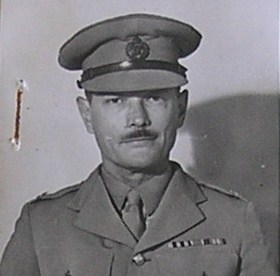
Lt.Col. Frederick Fleming Wemyss: Born 7 December 1897 in Burma, Wemyss served in France with the Royal Field Artillery during the Great War. He joined the Indian Police Force in 1936, serving in Burma where he was awarded the King’s Police Medal. He joined SOE in March 1942, and after a bit of an argument about where he would be best used, he ended up in the Political Warfare division of SOE, in charge of propaganda. After the war, he continued to serve in Burma until the Government of the Union of Burma brought him in for questioning in 1948 because they thought he might be assisting the Karen (he wasn’t).
Personnel file: HS 9/1576/4
RFA file: WO 374/73112
Edinburgh Gazette: King’s Police Medal for Gallantry
Captain Stanley Gilbert White: Born in Grantown on Spey, Scotland, on 6 June 1913, White worked for the Irrawaddy Flotilla Company for four years before the war. He left Burma for India with his pregnant wife in March 1942, where she gave birth to their daughter in July. Granted an Emergency Commission in August 1942, White served with a transport section of the Indian Engineers. SOE asked for him based on his knowledge of the Chindwin area and his fluency in Burmese. He served on the Chindwin front with Peacock’s P Force from December to March 1944. He was described as ‘a sensible and fairly tough little man.’
Personnel file: HS 9/1583/4

Captain John Philip Williams: Born in Treforest, Wales, on 12 February 1919, Williams was reading French, Economic Geography and History at Cambridge when he was called up in 1939. His parent unit was the Welch Regiment according to his reports from SOE training schools, but on his SOE application he says he joined the Welsh Guards with whom he served until officer training in 1943.
There is no mention of an operation in France before going to the Far East, but plenty of training reports for 1944 with lots of comments about his character. Williams wrote that he would be suited to becoming an instructor in SOE, but his training officers disagreed, writing that his ‘most unorthodox stance’ would make him an awkward weapons instructor, for example. Other comments opined that he was ‘good at all practical work’ but ‘Doesn’t shine so well when brainwork is involved.’ One report said that he was ‘lacking in cunning and subtlety.’ All agreed he was ‘athletic’ and ‘very fit’; he was also described as having ‘plenty of guts and a very pleasant personality.’
Williams was parachuted in to Burma on Operation Character in 1945. He was awarded the MC for ‘continuous bravery’, including:
‘when 500 Japanese entered his area he, with a small section of his men, deliberately allowed the Japanese to trail him for 4 days, and led them away from the area HQ’
Personnel file: HS 9/1598/1

Captain Frederick William Wilson: Born in Camberwell, London, 31 January 1922, Captain Wilson’s home address was Borden, Surrey. He worked as an Audit Clerk after finishing at his school, the Thames Valley County School in Twickenham. In April 1939, he joined the Territorial Army before joining the regular army in September 1939.
Wilson served in the ranks of the Royal Armoured Corps until July 1943 when he was commissioned. He saw service in North Africa and Italy before joining SOE in April 1944. He was trained at the SOE camp known as Massingham in North Africa before going on operations in France between August and November of 1944.
In December 1944, a confidential report described Wilson as ‘reasonably intelligent, though diffident in manner’ and recommended that he be ‘returned to duty’. Somehow, this was avoided and on 28 March 1945 Wilson parachuted into occupied Burma as part of Operation Character, team Walrus. He was in charge of sub-area White with Captain Steele and Sergeant Gibbs.
Wilson was in the field until 3 November 1945. He was awarded the MC, his recommendation stating that ‘he showed great gallantry, standing firm and rallying his men’ when outnumbered by Japanese forces attacking his HQ. He was just 23 years old.
Personnel file: HS 9/1604/7

Picture credit: BBC ‘People’s War’
Major Roy Wilfred Wilson: Born 16 September 1913 in Boxmoor, Hertfordshire, Wilson was a commercial artist before joining the Royal Irish Fusiliers on 1 June 1940. Between joining the Army and getting picked up by SOE in April 1944, Wilson was an infantry platoon commander and an instructor at 166 Officer Cadet Training Unit (OCTU). There is record of any war service overseas.
Wilson’s training reports from the various SOE schools paint the picture of a sociable officer, and one that could be a good instructor with practice: ‘conceited and obstinate. He has ability but not as much as he tries to make people think. He is pompous but a good mixer.’
After training, Wilson was recruited by Lt. Col. Musgrave for work in the Far East, where he was sent in November in 1944. Joining the Burma section of Force 136, Wilson was deployed on Operation Character, team Hyena, and was in charge of area Orange from 14 May to 25 August 1945 .
Wilson was awarded the Military cross for his work in Burma, although his file has no citation.
His daughter contributed to the BBC’s ‘People’s War’ HERE
Personnel file: HS 9/1607/3
Wong Fook Ming: employed as a Chinese interpreter for Operation Spiers from 23 August to 6 September 1944. Paid off on 30 September 1944.
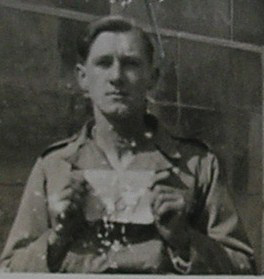
Sergeant Neville Wood: born 23 November 1923, Wood was serving with the Sherwood Foresters when SOE looked to employ him. He parachuted into France on 10 July 1944 as part of Jedburgh team Gilbert. He was MiD and awarded the Croix de Guerre for his work in France.
Wood then volunteered for more SOE work in the Far East, where he parachuted into Burma on 24 March 1945 as part of the Walrus team of Operation Character. He features quite frequently in Sgt. Harry Verlander’s memoir:

Personnel file: HS 9/1618/8

Captain Ivan Justin Woolf: born in France on 15 August 1923, Woolf had served aboard HMS St. George and as a radio operator in the Merchant Navy from April 1942 – April 1944. He joined SOE in April 1944 and spent the next four months in training before going on his first operation, in France, on 26 August 1944. He returned to the UK in October and was posted to the Far East leaving in January 1945. He parachuted into Burma in March 1945 as part of the Mongoose team of Operation Character.

Major Frederick Percy Wright: born 25 March 1913 in Rotheram, Wright joined the Duke of Wellington’s Regiment in 1933. He was posted to Malta from 1934-7, and was part of the Army swimming team in these years. There’s a gap in his record until posting to France on 12 September 1939 serving there ’till Dunkirk.’
Commissioned in June 1941, he then went to Bovington and qualified as a Tech AD3 before going to the Middle East. He joined SOE in February 1943, and after training in Palestine, went to Greece on operations. His personnel file, unusually, includes his report on his Greek mission. He was part of Shepshed and Alteration from June 1943 to January 1945. He was awarded a MiD and a military MBE for his work in Greece.
Wright then volunteered for the Far East. He parachuted into Burma in June or July (inconsistency in records) to join Operation Heavy, team Lynx, remaining in the field until October 1945.
Personnel file: HS 9/1623/4
Yang Yi: a Chinese born in 1919, Yang Yi was the W/T operator for Operation Grain, team Elephant. He was one of the agents supplied by the Nationalist Chinese government in September 1943. Much of 1944 was spent training at the various SOE schools, while deployment on operations was only 2 January to 23 March 1945, after which he was paid an extra two months wages and sent back to China.
Yao Ching: one of the agents supplied by the Nationalist Chinese government in September 1943. A shopkeeper in civilian life. Much of 1944 spent in training, after which Yao Ching was deployed with Lion into the Arakan on 3 December 1944.
Ye Aung (Ya Yong): An Arakanese deployed on Operation Manual, team Mouse.
‘Has considerable ability and was of great assistance throughout the operation. He definitely has the offensive spirit and when the Japs raided a base camp he ambushed and killed 20, having previously hidden all the stores. He appeared popular with the men. He was adversly [sic] affected and not unnaturally angry with the West African bestialities [sic] but he seemed to get over it, and his loyalty as part of ‘Mouse’ was ever in doubt.’
See blog post HERE.
Yeung Kamon: employed as a Chinese interpreter for Operation Spiers. He was deployed from 5 February 1944, but got ill and was evacuated. While ill in hospital and demanding to go to an American hospital, Major Cope reported that they confronted him the knowledge that ‘he was a major in the Chinese Army, and was just spying on us.’ He was then sent to a Chinese hospital, and never seen by the Spiers team again.
Ying Chai Wai: employed as an accountant and store keeper for Operation Spiers, Ying Chai Wai, was deloyed from August to September 1944. His record indicated he ‘Resigned’.
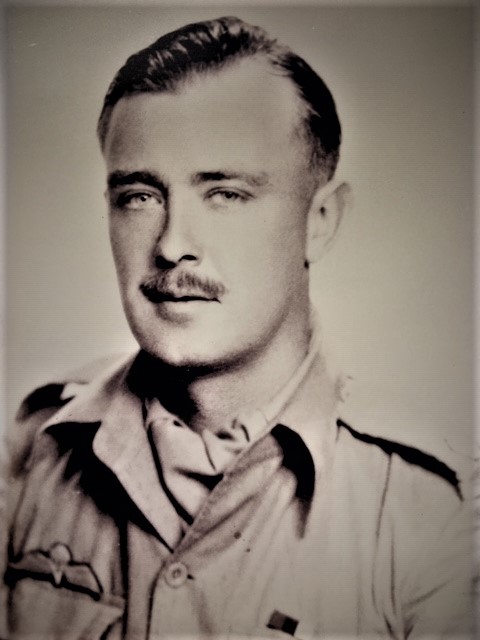
Photo Credit: Family Album
Major James Cecil Knight Young: born 3 May 1916 in County Cavan, Ireland, Young was commissioned on the supplementary reserve of officers of the East Lancashire Regiment in 1938. Although the London Gazette has details of transferring to the Argylls in 1941, family records indicate the Cheshire Regiment and the Black Watch between May 1940 and May 1941, with a spell on the Orkney Islands from June to November 1941. Young arrived in India by 10 April 1942.
Young joined Z Force which was attached to Force 136 in 1945. He parachuted into Burma in April, and served under Lt.Col. Peacock on Operation Character, team Otter. Peacock wrote very highly of Young, describing him, along with Major Saw Torry, as his right-hand man. Gazetted for an MC, Young’s file has a citation for a DSO based on his work with SOE in Burma:

Personnel file: HS 9/1632/4
London Gazette: (East Lancashire Regiment)
London Gazette (Argylls)
London Gazette (MC)
Young Shan: a redacted record indicating only that he was Chinese.
Za Hrang: a Chin born in 1927(?) who joined SOE in August 1943 (16 years old?). Trained as a W/T operator, Za Hrang was parchuted into the Dilwyn area of northern Burma as part of Monkey from 28 November 1944 to 7 March 1945. He then deployed on Operation Heavy with Lynx from 28 March to 16 October 1945.
Zau Hkawng: a Kachin born in 1922, recruited by Force 136 in October 1944. He was deployed, after training, as part of the Bison Special Group to collect intelligence in the Mandalay area. After Bison, he was parachuted into Burma with Major Nimmo, serving first with Mongoose and then Ferret from June. Major Poles reported:
‘Very keen soldier, but inclined to be unreliable and needs constant supervision.’
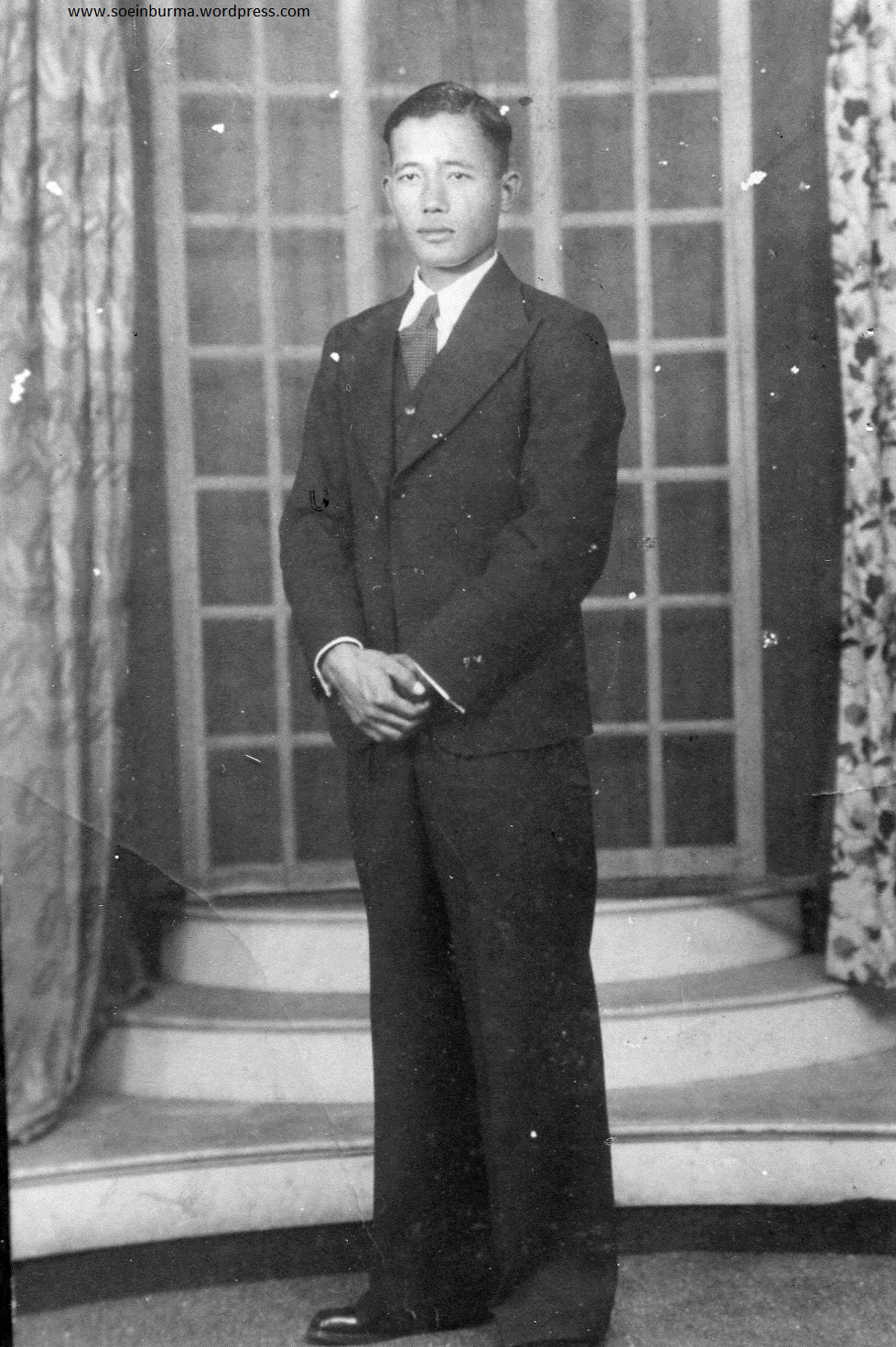
Major Zau June: Zau June was a Kachin who was commissioned before the war with Japan started. He was very well connected in the north of Burma, which made him ideal for SOE intelligence work. His brother, Shan Lone, was also a valuable Kachin for SOE; they were both part of Operation Dilwyn for over two years.
Zau June was born on 13 May 1917, and according to this website died at the young age of 34. When the Japanese invaded Burma, Lt. Zau June was employed as an intelligence officer (IO) by the army. Due to illness he was unable to retreat to the safety of China and so he remained behind the lines. SOE recruited him ‘in the field’ in October or November 1943. For the next year or so he provided intelligence as part of Operation Dilwyn. After a short spell of leave, Zau June completed parachute training at Chaklala in mid November 1944 before being parachuted back into Burma as officer commanding team Dilwyn Badger on 28 December 1944. He was awarded the Military Cross in January 1945.
Zau June’s personnel file was declassified in 2017. It mostly contains documents which show that the Brigade OC for whom Zau June was working in 1942 thought he deserted in the face of the Japanese invasion, and was looking for charges to be brought against him in 1945. SOE/Force 136 clearly exerted what influence they could to protect Zau June, a man who had provided ‘grade A’ intelligence for extended periods from behind the lines.
Personnel file: HS 9/1638/3
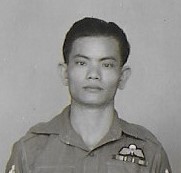
Havildar Zau La: a Kachin born in 1923 and recruited by Force 136 in October 1944. He was deployed, after training, as part of Major Hedley’s Bison Special Group to collect intelligence in the Mandalay area. After Bison, he was again parachuted into Burma with Major Nimmo, serving first with Operation Character’s Mongoose team, and then with Ferret from June. Major Poles, Ferret OC reported:
‘Thoroughly reliable N.C.O. proved himself in action under Capt Ansell at HAWLUDO 23 July 1945. Very efficient scout and adept in jungle warfare.’
Zau Lawn: a Kachin recruited in March 1944 aged 19.
Naik Zau Neng: a Kachin recruited in the field in July 1944 by Zau June, Zau Neng completed parachute training at Chaklala and then redeployed on Dilwyn as part of the Badger team on 28 November 1944.
Naik Zau Neng (8170): a Kachin who served in the Burma Frontier Force, Zau Neng joined Force 136 in January 1945. He completed parachute instruction and then deployed on Operation Heavy, team Lynx, as the W/T operator, from 28 March to 19 October 1945.
Lance Naik Zau Seng (W135): a Kachin born in 1922, Zau Seng was recruited from 2 Battalion the Burifs in March 1945. He was parachute trained at Jessore and jumped into Burma on Operation Heavy, part of Wolf.
Naik Zau Seng (11693): a Kachin born in 1922, Zau Seng joined the Burifs on 1 January 1940. He remained in Burma in 1942, and was recruited in the field by Spiers in August 1944. Brought out to India, he completed parachute training at Chaklala, he deployed on Operation Dilwyn with team Badger from 28 December 1944.
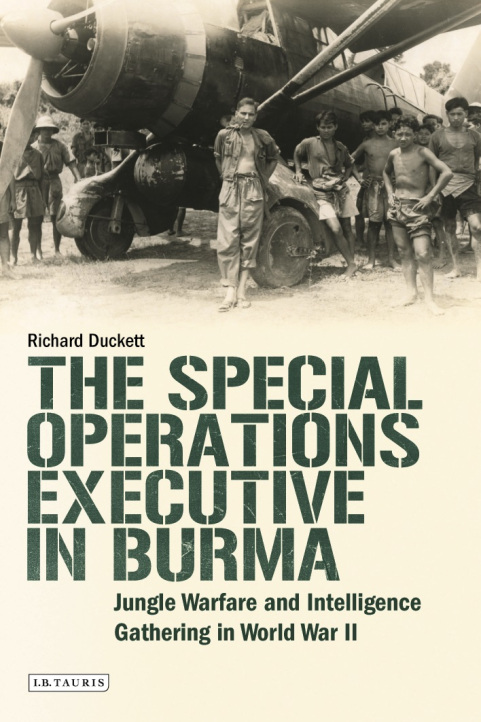
Appreciate this content?
Consider a donation to help cover website costs?
Thanks!
£1.00
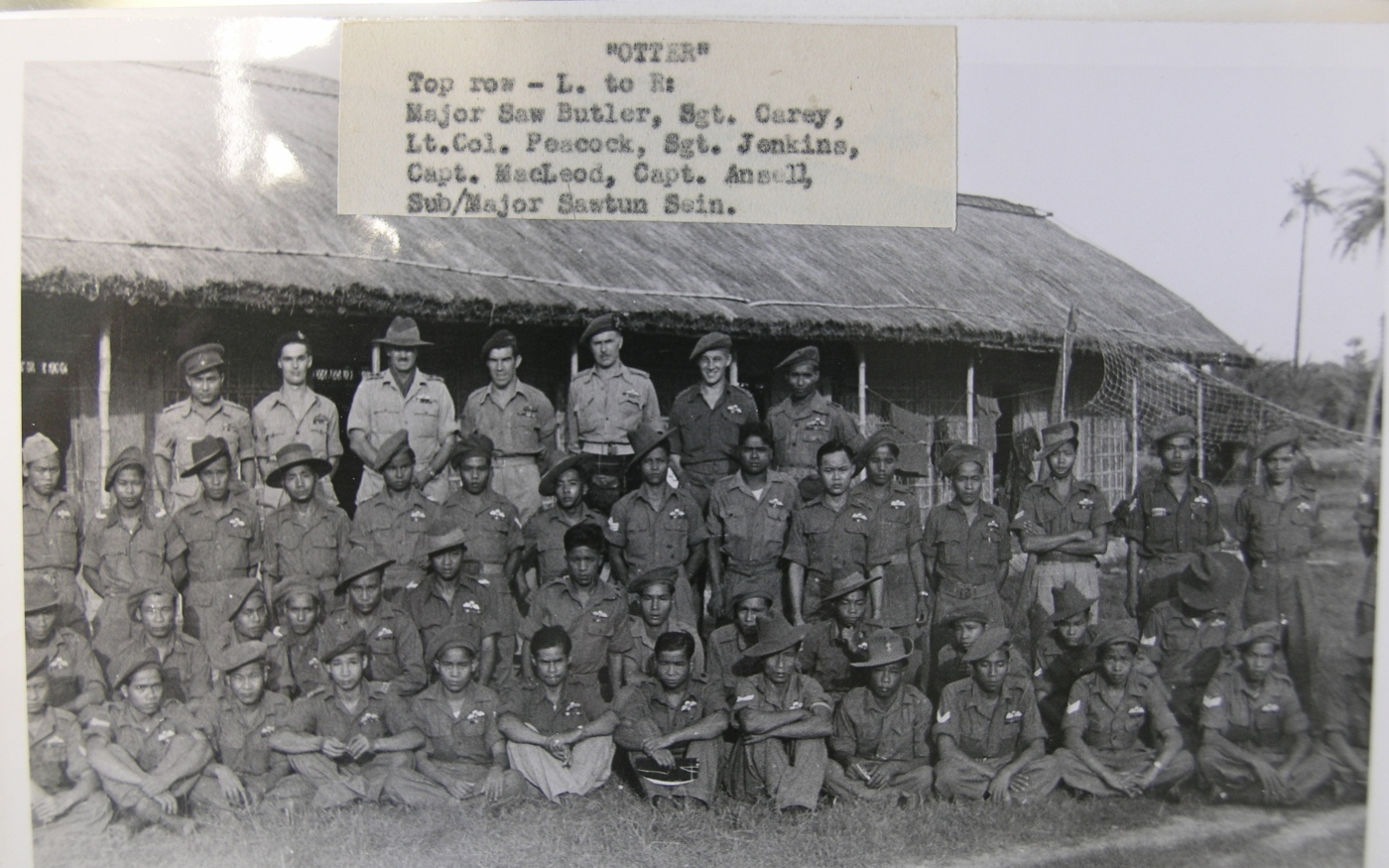
![Major John Gebhard [changed name to Bowen 1947] citation for Military Cross 10-3-46 Major John Gebhard [changed name to Bowen 1947] citation for Military Cross 10-3-46](https://soeinburma.files.wordpress.com/2019/07/major-john-gebhard-changed-name-to-bowen-1947-citation-for-military-cross-10-3-46.jpg?w=389&resize=389%2C518#038;h=518)












March 5, 2018 at 11:22 am
A great website! A rather detailed question – have you any refs to a a lot colonel Godfrey Henry Stebbing du Pontet having played an active role in SOE Far Eat? He has a SOE file stating destined for the FE. Thanks
LikeLike
March 5, 2018 at 8:19 pm
Hi Tim,
Thanks for the positive feedback. It helps make it worthwhile!
I don’t recognise the name for Burma. By SOE file do you mean his personnel file in the HS 9 series? Many of them don’t include the details of service in the Far East, which can be quite frustrating. I will see what I can find out, but pretty sure not Burma.
Rich
LikeLike
March 22, 2021 at 2:19 pm
Kenneth Murray, B Group, 101 Detachement, was parachuted behind enemy lines in Tounggyi, Burma, in Feb 1942 and later executed by the Japanese after villagers handed his group over when they landed. We have been researching the family’s history in Burma. Kenneth was one of eight children of Oscar Murray and Philomena Vrsalovic. His elder brother and sister served with the forces in Burma, so they were not with the family at the time Rangoon was invaded and they were the only ones in the family to survive the war as a result. The others: parents, grandfather and five younger siblings all died during the trek to India, trying to reach safety through the Hukawng Valley. Their names are recorded on the Anglo Burmese Library’s website, along with thousands of others.
LikeLike
May 12, 2018 at 2:08 am
Thanks for the info. Do you have anything on Captain George Rochfort Tregaskis of Kings African Rifles who served in Burma on and off with the SOE. He was killed in Burma on 6th June 1945 I have my grandfathers medals and condolences from King George, but I can’t find anything about him anywhere or if anyone knew him there. He’s buried at Rangoon Memorial. Thats all I know.
LikeLike
May 12, 2018 at 7:10 am
Hello Genie,
I have not come across the name Tregaskis in the SOE files, and a search for a personnel file returned no results.
Here is the link to the Rangoon Memorial. You will note a difference in date of death to the one you supplied: https://www.cwgc.org/find-war-dead/casualty/2527519/tregaskis,-george-rochfort/
The next best thing would be to check the KAR War Diaries. I don’t know your grandfather’s battalion, but records start with the 1st Battalion (1945) at WO 172/9477 http://discovery.nationalarchives.gov.uk/details/r/C953849
Best of luck!
Rich
LikeLike
September 22, 2019 at 2:33 pm
Genie
Greetings
George served with 7th (Uganda) KAR and he was killed on 15th February 1945. His Battalion was in the 28th (East African) Brigade that did more hard fighting than any other East African formation.
A book of mine is coming out next Spring covering, amongst several other things, the East African Forces in Burma and it contains this relevant paragraph:
“At dawn on 13th February the crossing of the Irrawaddy was simulated with machine gun, mortar and artillery fire and a smoke screen was laid; this deceived the Japanese who concentrated on the opposite river bank. The Japanese General on the west bank gathered his forces to defeat what he thought was 11th (East Africa) Division. A savage Japanese attack supported by a 75-mm gun was launched on 15th February against the 7 KAR position and a day of fierce defensive fighting followed that left 7 KAR badly shaken. ‘A’ Company was forced to withdraw from its trenches losing 24 all-ranks killed and 34 all-ranks wounded. On 18 February the 7 KAR survivors were withdrawn to defend the brigade administrative box and 71 (Somali) KAR took over their positions. 46 KAR was protecting the flanks by constant patrolling.”
It is likely that George died a gallant death in that battle. You can be proud of him.
Harry Fecitt
LikeLiked by 1 person
June 12, 2018 at 2:07 am
Per Saw Khin Maung, a man of this name also said to have enlisted in the 1st Burma Rifles in 1938, and served with Force 136, provided personal testimony that he served under Major Peacock – being awarded a decoration for gallantry at the battle of Thaw Thee Kho. He does not state he had been EC. But suspect these are one and the same man. Please get intouch
LikeLike
September 15, 2018 at 2:02 pm
Superb Website, Stick to the fantastic work. Many thanks!
LikeLike
September 24, 2018 at 12:59 pm
Do you have any information on my uncle Edmund Kenneth Buck, 13th Kings Liverpool Rifles. Burma Operation Longcloth & Thursday. 77th Indian Army Rifles, then 111th Indian Rifle Brigade. Then Believed to be one of two SAS regiments just formed. Repatriated Late 1943 early 1944. Thank you for bearing with me. Yours sincerely Ken Berry
LikeLike
September 24, 2018 at 7:13 pm
Dear Kenneth,
Thank you for your message.
As you can see my special interest is in the Special Operations Executive rather than the Chindits, so unfortunately the short answer is no. I have not seen the name in SOE files.
There are, however, a few directions I can point you in, if you haven’t exhausted them already.
Tony Redding’s War in the Wilderness is a thorough account of the Chindits, and worth a read even if you don’t find your uncle in there.
Get yourself on http://www.ww2talk.com where you will find some Chindit experts who are usually only too pleased to help.
Contact the Chindit Society – http://www.thechinditsociety.org.uk
http://www.chinditslongcloth1943.com is worth a look, but no hits for ‘Buck’
For SAS, contact page on http://www.sas-lrdg-roh.com might prove fruitful.
Good luck and happy hunting,
Rich
LikeLike
October 27, 2018 at 4:48 pm
thank yo so much. My Grt Uncle Jack Fleming was with the British mining companies with Karen mena and women. Under house arrest, the Japanese tortured his houseboy by tying him to a tree in the hot sun. End of war he drove down to Mandalay then to Singapore.
LikeLike
November 27, 2018 at 9:38 am
I applaud this extensive work – those who fell or fought and survived on the SOE battlefields in Burma can now be remembered with accuracy and precision because of your diligent and painstaking research. Please keep going forward with this project.
LikeLike
November 27, 2018 at 12:14 pm
Thank you for your kind words. It makes it all worthwhile. Still hours and hours of work ahead, but responses like yours spur me on. Thank you.
LikeLike
February 13, 2019 at 7:50 pm
I have a few details of an SOE operative in Burma who isn’t on your list
LikeLike
February 16, 2019 at 6:39 am
Hello Tony.
Who might that be?
Work in progress, with many names to go!
Thanks for messaging.
Rich
LikeLike
September 22, 2019 at 2:43 pm
Major Smith Dun’s MC citation states:
“Late in 1944 he was posted to 7 Division and with a selected party of Burma Intelligence Corps personnel successfully carried out a mission to keep the Karens and Burmans peaceful in the districts of the upper Irrawaddy Delta.”
Please, do any of your SOE files mention Smith Dun, a Burmese officer, or his mission into the upper Delta?
Please keep up the good work.
Harry Fecitt
LikeLike
September 22, 2019 at 4:21 pm
Hi Harry,
No mention in SOE files but I have ‘Memoirs of a Four Foot Colonel’ which has chapter 9 entitled ‘Posted to 7th Div’. Do you want photos? It’s three pages.
LikeLike
September 26, 2019 at 12:19 pm
Hi, just found the site and most impressed. Have you ever come across a Major W A Keith-Robinson who was with the Kings Own.
Thanks
Si
LikeLike
September 28, 2019 at 11:18 pm
Hi there! Thanks.
Not come across that name for SOE. Just did an archive search and while there was 27 hits for Robinson, none for Keith-Robinson.
LikeLike
September 30, 2019 at 1:11 pm
Thanks for the assistance though, greatly appreciated S
LikeLike
November 2, 2019 at 4:29 pm
My father mentions a FPW Harrison who was with the SOE in Burma and Malay. He was a planter in Perak, North Malaya and, after the war returned to Malaya and was killed during the Malayan Emergency. He is not listed above. Do you have any information?
LikeLike
November 2, 2019 at 5:45 pm
Hello Jeremy,
I have one Harrison on the page, but I don’t think I have come across the one you mention. I have just looked him up on the national archives catalogue and found a personnel file, so I hope to get back to you shortly once I have seen it.
LikeLike
November 4, 2019 at 6:28 pm
My husband, Patrick Ellam was with the Jedburgh group, first with Vic in Lyon and when he european part ended was sent to Burma until the war ended there. He never mentioned action in Burma. But saw much in Europe. He died three years ago, having forgotten much of his adventures. Dementia – such a cruel malady. Now so much is available to the public but too late for Patrick. I do know thar he loved his involvement. Loved the exciting life. He kept his vow to keep all secret for 50 years so I was told very little and fifty years after his service, he remembered little. je
LikeLiked by 2 people
November 5, 2019 at 8:06 am
. He kept his vow to keep all secret for 50 years As did my uncle.
LikeLike
November 10, 2019 at 11:45 pm
My father John George Pearson was Part of SOE. He fought in the jungles of Burma eradicating the Japanese who had turned to canniballism.
LikeLike
November 17, 2019 at 11:17 am
Hello Daniel. I have a Sgt Leonard Pearson but not come across your father. Do you have any further information (personal papers, rank) because my aim is to add all who served in Burma that I can find to this page. Your dad does not appear to have a file at Kew: https://discovery.nationalarchives.gov.uk/results/r?_q=hs+9+pearson
LikeLike
May 9, 2020 at 6:07 pm
Richard. Well Done both on your continuing efforts here and your book, which has explained much about the various agencies and their operations.
Jemadar Kha Li Maran: I cannot trace a BGM being awarded to him.
However, 6255 Naik HKALI (TNA REF WO 373/31/245) received a BGM on 13 January 1944. His citation reads:
No. 6255 Naik HKALI, Burma Army Service Corps, was dropped by parachute within enemy-occupied territory in Northern Burma on 23rd March 1943. Owing to the breakdown of his wireless set this non-commissioned officer (NCO) walked almost 200 miles to friendly territory to obtain the necessary replacement, arriving there on 8th July 1943. On the 11th October 1943, Naik HKALI was again dropped by parachute with a new wireless set, since when he has been contacted by his operational leader. This NCO has shown exemplary courage, determination and devotion to duty in the manner in which he has faced, and is now facing, extreme danger in order to assist his leader in rallying support and transmitting valuable military intelligence.
Recommended by Major M.S Cumming MBE and Colonel G.H Beyts MBE MC.
This looks like a DILWYN 1 award, and HKALI walked out of the jungle on 23 March 1945 – a similar date to Kha Li Maran.
Any Comments? Harry
LikeLike
May 17, 2020 at 7:24 am
Dear Harry,
Apologies for the time lapse in response to your query. A very busy week online teaching, and had enough of computers by the end of each day!
Anyhow, these two are one and the same man. The spelling of the names varies so much, it can get quite tricky. You are quite right in your assertion that it was Dilwyn. Do you want a copy of his training card? I thought we had corresponded by email but I can’t seem to find a contact for you.
Best wishes,
Rich
LikeLike
May 17, 2020 at 8:28 am
Richard. Thank you. Please send Hka Li’s card. Keep up the good work. Harry Fecitt
LikeLike
May 18, 2020 at 9:27 am
Can you use the ‘contact’ page so I can reply and send by email. I need to mess about with a large PDF. https://soeinburma.wordpress.com/contact/
LikeLike
May 10, 2020 at 2:31 pm
Thx for all this extensive work.
Has anyone heard about my grandfather- Capt Ram Chandra Mahanta? He was an SOE – got his file released from the archives in Kew last year. Not much info in it.
He finished as an instructor in Poona.
He had something to do with a Guerilla Warfare Manual which the Americans use.
LikeLike
May 17, 2020 at 7:09 am
Dear Mrinmoy,
I have not come across your grandfather so thanks for bringing him to my notice. Some of the medics who went on ops with SOE in Burma wrote a report, or there is a section on medical matters in the final reports of the commanding officers.
I will get copy of your grandfather’s file and see if I can get any leads. I will get back to you if I find anything, and add him to my page if he served in Burma.
Best wishes,
Rich
LikeLike
May 27, 2020 at 9:40 am
It turns out I saw your grandfather’s file in 2018, and already have a copy!
As personnel files go, it is very detailed and has a fabulous photograph. So far as I can see, He didn’t serve in Burma because he was too valuable as an instructor. Where it says he worked with MCS, this stands for Malay Country Section, so he was involved with MCS, not BCS (Burma Country Section).
His pre-war career is really interesting too.
LikeLike
May 11, 2020 at 7:44 am
My father Desmond Arthur Brown was in the Royal Signals in Burma, from 1939 to 1945. He was 17 when he enlisted. He lived in Fulham, Middlesex at the time. I am not sure of the sequence of events but he was initially on a boat to Singapore with his regiment. It capsized so they had to redirect. The rest of his regiment were captured so they ended up in Burma attached to a different regiment. I have many photographs and know he was with Frank Sterling (also. A signalman)) for the duration. I have the badge of the 14th division plus other medals. Can you advise me of how to progress with finding out more information. Thankyou
LikeLike
May 17, 2020 at 6:59 am
Dear Lynne,
Apologies for the time lapse in replying. It was a busy week remote teaching and I had no more capacity for screen time until now. The first thing to do is apply for your father’s service records here https://www.gov.uk/get-copy-military-service-records
The second thng you might like to do, while you wait for the records to arrive is join the Facebook Burma research page, if you haven’t already. Lots of lovely, helpful, knowledgeable folk on there, and every chance someone whose relative served with yours: https://www.facebook.com/groups/172219043329393/
Once you know your father’s unit, then you can look up war diaries at the National Archives. It might also be worth checking in with the Royal Signals Museum: https://www.royalsignalsmuseum.co.uk/
I hope this helps and good luck!
LikeLike
June 3, 2020 at 4:30 am
Richard, this is fascinating, My grandfather is Lt Col Frederick Wemyss. I did not know w of my grandfathers work in the SOE. Do you know any more of the detail for receiving the Kings Police Medal, (which we have), and about the Political Warfare Division.
LikeLike
June 6, 2020 at 1:25 pm
Hello Sally,
Thanks for your message. It is always good to make contact with families of the men on this page.
If you use the ‘contact’ page of the website, I will send me your email and I can send you your grandfather’s SOE file.
Best wishes,
Rich
LikeLike
June 18, 2020 at 6:13 pm
shouldn’t “Richie Gardner” actually be “John Ritchie Gardiner”?
LikeLike
June 20, 2020 at 1:54 pm
Hello Richard, good spot absolutly right.
Never seen him referred to as John, always Ritchie, and my mistake on spelling here. All corrected now. Thank you.
I have found it so frustrating having so many different spellings of names in the archives, and then I go and do it – for a name that is consistently spelled correctly!
LikeLike
June 20, 2020 at 3:08 pm
i’ve done some editing and been published myself, so i know the pitfalls. my sister read an article i wrote after it was published and caught a glaring error that i should have caught at least in the proofreading!! re: gardiner, “john” was his christian name, ritchie his middle and preferred name according to other sources.
LikeLike
June 20, 2020 at 3:57 pm
i just checked Cyril Herbert Sell’s file, HS 9/1340/2. it says he died on 1 october 1943. yet, as noted by your entry on this website, he was still alive and kicking in 1945. i notice sometimes you note when the official files are in error, so i thought i would bring this one up.
LikeLike
June 22, 2020 at 12:08 pm
Yes, another error on the cataloging – he clearly didn’t die in 1943. There is nothing in his file to point to where this error could have come from.
LikeLike
August 13, 2020 at 11:07 am
Hi do you have anything on George Ronald Rigarlsford. 2nd Battalion The Buffs India 1945 age 18
Many thanks Mark
LikeLike
August 14, 2020 at 9:09 pm
Hello Mark. Do you think there is an SOE connection? His name does not appear on an HS 9 file search, and is not one I have come across.
LikeLike
August 17, 2020 at 10:30 pm
Hi, I have a few tags that where created for a couple of these guys, Leney’s, whos tag I gaveto his son. Brierleys who I gave to Clive at the Carpetbaggers museum. All the tags I have all have a RAC connection, lots of these SOE enlistedmen came from the RAC as radio ops. Do you happen to have a list of the RAC enlistedmen with serial numbers that I can compare against my list of 36,500+ dogtags, to see if there are any more SOE guys here.
LikeLike
August 25, 2020 at 5:11 pm
Hello Dan,
I might be able to help with that. There is a list of Jeds who went out in a file somewhere, which has their regiment if not their army number.
LikeLike
October 21, 2020 at 8:47 pm
Dear Dan,
I May have have unearthed the source material for your next book . A Carrier Bag Containing Paperwork And A Spider Arm Band . Please Feel Free To Contact Me I Am Only In Sussex .
LikeLike
September 11, 2020 at 2:07 pm
hey, this is amazing, my great grandpa is Ian Abbey. I’ve been tying to find out more about what he did and the operations he took part in but haven’t been able to find out much about it.
LikeLike
February 12, 2022 at 1:54 pm
Hi Matthew, I’m researching you great grandfather at the moment. I attended Merrywood Grammar School in Bristol in the late 60’s and Ian Abbey was an English teacher there. As pupils, we never knew that he had a distinguished WWII history. He never spoke about it. We were sad to hear that he died in 2017. If you could supply further information on him, we would be very grateful. Best regards Colin
LikeLike
November 5, 2020 at 8:46 am
Note; I.F. on Maung Ba Thein’s file, stands for The Irrawaddy Flotila 🙂
LikeLike
February 8, 2021 at 12:30 am
Hi just wondering if you have any information on Joseph Clarke from Ireland who served in Burma during WW2 please, many thanks
LikeLike
February 19, 2021 at 3:37 pm
Hi Anne
Was he in SOE? I only know of one Clark in Force 136, and he wasn’t a Joseph.
LikeLike
April 5, 2021 at 10:18 pm
Hi
Family records suggest John Findlay MC , born in Rangoon and a rubber planter at Duinseik at the time of Japanese invasion, rejoined army , though over 40, walked out of burma into india, was initially a POW Commandant at Dehra Dun, but wangled a transfer to work with Force 136, though also did work for intelligence on rebuilding rubber production post war. Don’t see him on your list. Nothing in his letters home suggest he was actively back in burma, but post war discussions suggest he might have been involved in Indian base. Do you have any more info? Where should I look?
LikeLike
April 6, 2021 at 12:25 pm
A short spell with SOE in 1943 before going to the Civil Affairs Service. SOE had wanted him to help with rubber smuggling plans, but these came to nothing. SOE file is listed here: https://discovery.nationalarchives.gov.uk/details/r/C9718541
LikeLike
April 6, 2021 at 1:26 pm
Thankyou very much for this response
LikeLike
November 30, 2021 at 2:38 am
Hello all,
after any information or photos about 69th Anti-Tank Regiment, Royal Artillery (TA) which was coverted 69th Light Anti-Aircraft /Anti-Tank Regiment RA (TA) in Burma 1944.
My granddad served in Burma.
Name: “Neil Doogan” Rank: Serjeant, Service number:1451606 267 Bty, 69 Lt. A.A. Regt. Royal Artillery. From Reading Berkshire. Deceased in Burma 1944 11th April age 22.
We know his name is placed at the Rangoon Memorial.
Thanks Glen.
LikeLike
December 12, 2021 at 2:03 pm
This from Steve Rothwell who has this excellent website (though what follows is not on it!)
The 169th Anti-Tank Regiment was formed in 1939 as a duplicate of the 59th (Duke of Connaught’s-Hampshire) Anti-Tank Regiment, R.A. (T.A.) with the 273rd, 274th, 275th and 276th Batteries. During 1941, the 273rd and the 276th Batteries left to join other Regiments. In October 1941, the 285th joined from the 55th Anti-Tank Regiment and the 292nd Battery was formed and regimented to replace the transferred batteries.
The Regiment arrived in India on 23rd May 1942 and moved to Bangalore where it came under the command of the 19th Indian Infantry Division.
During July and August 11943, the Regiment was re-organised as the 69th Light Anti-Aircraft/Anti-Tank Regiment, R.A. (T.A.). It retained the 285th and 292nd Anti-Tank Batteries while the other two joined the 33rd L.A.A./ATk Regiment. The 69th Regiment received the 132nd and the 523rd L.A.A. Batteries from the 33rd Regiment. The new Regiment remained in Bangalore but now under the command of the 70th Infantry Division. From 30th September 1943, the Regiment served as an infantry group and on 18th October was amalgamated with the 51st Field Regiment, R.A. to form the 51st/69th Regiment, R.A. (T.A.) which in turn formed 51 and 69 Columns of the 16th Infantry Brigade – part of the famous ‘Chindits’.
The 51 and 69 Columns served with the 16th Infantry Brigade during the 2nd Chindit Expedition, beginning on 5th February 1944, when the Brigade began its long penetration march into Burma. Subsequently exhausted, the Brigade was flown out of Burma and returned to India by May 1944.
The 51st/69th Regiment lapsed into suspended animation and the 69th Anti-Tank Regiment was reformed from October 1944.
Gunner Doogan attested to the Territorial Army in 1938 and was re-posted to the light anti-aircraft artillery branch on 26th October 1942. As a sergeant, he was killed in action in Burma on 11th April 1944 at the age of 22. Although having lived in Glasgow at the time of his joining the Army, he was born in Longford, Ireland. The reference to the 267th Battery might be a mistake – it was the 276th Battery which formed part of the 69th Regiment.
LikeLike
December 6, 2021 at 1:42 am
Hello everyone,
do we have anything in writing or photo’s off any description of
the plane crash 11th April 1944 Aberdeen airstrip. 69th Anti-Tank Regiment, Royal Artillery (TA) which was coverted 69th Light Anti-Aircraft /Anti-Tank Regiment RA (TA) in Burma 1944. If this was the case the plane burst into flames after crashing into the hillside, I do have the names off around 12 men who passed away on the 11th April 1944.
LikeLike
December 11, 2021 at 11:26 am
Hi Glen,
Thanks for the messages but I wouldn’t be too hopeful of a response here because A) my site is Special Operations Executive (SOE) in Burma B) It does not get much use a a message board! But if you manage to start discussion and people can offer help, then that’s brilliant.
I just checked Jon Diamond’s ‘Stilwell & The Chindits: rare photographs from the archives’ and can’t see anything in there.
LikeLike
January 28, 2023 at 4:31 am
Sorry this is almost 14 months after the question was asked:
RAF Dakota (C-47) FL540 was the aircraft that crashed Tuesday 11 April 1944 at Aberdeen per “The Douglas DC-1/DC-2/DC-3, The First Seventy Years” by J.M. Gradidge. Air Britain Historians Ltd.
LikeLike
July 20, 2022 at 5:34 pm
Hi Dr. Duckett,
Whilst searching the web on SOE/OSS activities, I came across your PowerPoint presentation (SOE in Burma – Jungle Operations). I enjoyed it — good information, nice work.
I have a particular interest in the SOE, as I knew Patrick “Red” Maddox very well. I have been researching WW2 in Burma for over 40 years. I have written an in-depth article on his exploits with the SOE, prior to his being seconded to the OSS in early 1943.
This includes information on his training, blowing up the Bawdwin-Namtu mine that he was assigned to by Major Stevenson, his trek from Myitkyina to Ft. Hertz with and his subsequent trek to Kunming before flying back to Dinjan/Dibrugarh (Assam).
By the way, the two photos that you have on Pat Maddox are from his collection that I have copies of. I sent them to the Anglo Burmese Library some 10 years ago. Some of the individuals in the group photo are: Dennis Francis, Bunny Aganoor (he was killed by the Japanese/Burmese when dropped with “A Group”) and Col Carl Eifler (he’s disguised as the Sikh on the left of Pat Maddox in the photo).
I would be interested in corresponding with you. How do I accomplish this?
Sincerely,
John
LikeLike
September 20, 2022 at 6:34 am
Hi, absolutely fantastic website. Well done. Have you come across Major David William Rayner (he was initially with the Lancashire Fusiliers) her served in India, Burma and China. Many thanks Alexander.
LikeLike
October 2, 2022 at 11:31 am
Hello! Thanks for your message. I have not come across Major Rayner, and still haven’t having just checked the archives catalogue. Was he SOE?
LikeLike
November 10, 2022 at 6:46 pm
I have only just found your site. My parents were both SOE in Burma. They died in 1965. As children we had an inkling but they never talked about it. However, some of my father’s records were released by National Archives in 2007. He worked for Steel Brothers in Rangoon. According to his records he spoke Burmese, Siamese and Urdu. London Metropolitan Archives have the collection of letters [including 2 from my father] sent back by their staff around the world during the war as you will probably know. I have original letters from my father to my mother in 1942.
Does Prativa Lodge mean anything to you? My mother had something to do with it and I think, but not sure, it was a rest house in Darjeeling for SOE operatives.
Father was ABRO, BASC Burma regiment 1st Burma Campaign, then Staff Captain Burma Army HQ Simla 1942-44, 1944 GSI[k] and MEW, Force 136 and MEW until 1948.
LikeLike
November 13, 2022 at 5:32 pm
Hi Gilli, thanks for your comments. What were your parents’ names? Do I have them on the relevant pages?
I haven’t come across Prativa Lodge, that I can recall. You might be interested in the book ‘Calling to Mind’ by Harold Braund. It is a history of Steel Bros.
LikeLike
November 13, 2022 at 6:09 pm
Thanks for suggestion on Braund’s book. have ordered it. I have been on several occasions to look at the Steel Brothers newsletters 1939 -1947 and photographed relevant sections for my research. My parents were Arthur Alan Conway and Pamela Mary Conway. I couldn’t see them on your list but its very long and I was in a hurry! Would have to look again as think I recognised a few names as people they knew out there and back in the UK when I was a child. I have both parents records from Kew but I think some where held back in my father’s case. Father was officially signed up to SOE as from 1.2.44 as DAQMG [Quartermaster General]in Calcutta Sub Mission. Symbol B/B617 allotted. Have a copy of his Service within S.O.E. includes GS1[k], MEW and later M.E.81. Steve Rothwell very helpful to me a few years ago regarding these sections of S.O.E. I shall keep researching Prativa Lodge [there’s a chap in Canada who remembers it as a boy but I can’t find his correspondence!]. It must be something to do with S.O.E. as on my mother’s S.O.E. record that she was in charge of it 26th May 1945. A close friend is off on Tuesday to Assam & will have an expert WW2 local guide with her to take her to where her father fought at Kohima but hoping the guide might shed some light on Prativa Lodge.This is why I have reopened my own research to give her info for her trip.My father went back to Burma in 1945 to Burma Forest Dept [CAS B] but still Army.Mentioned meeting various SOE friends in a letter to my mother which I have somewhere.
best wishes
Gilli
LikeLike
August 13, 2023 at 9:40 am
What an amazingly interesting page! Could I please ask advice on how to look for information on my grandfather? We know he served in Burma (from Northern Ireland) and believe he was cook. His name was Ralph Faulkner and would very grateful for any path to continue our research. Our records show he was on sick from 9th Aug – 12th Sept 1944 and we would like to know if he would have been sent home or would he have remained in Burma at this time?
LikeLike
August 19, 2023 at 2:35 pm
Hello Melanie,
Obviously this website is dedicated to those who served in the Special Operations Executive, so I won’t have anything about him here. Your first step, if you haven’t already, is t apply for records from Army records in Glasgow: https://www.gov.uk/get-copy-military-records-of-service
Second, if you know his regiment, see if you can find the war diary in the National Archives https://discovery.nationalarchives.gov.uk/
Third – contact the regimental museum to see what they might have.
There is a very active Facebook group which is full of pople who had family serve in Burma. You could make some useful contacts on there.
Good luck and Happy Hunting!
LikeLike
September 23, 2023 at 3:52 pm
Rich
Greetings & please keep up the good work.
Is the Alexander Campbell on your “Men of SOE” list the same man as Major Alexander Pierre Georges Marcel CAMPBELL (333556) General List, who was gazetted for a MC in London Gazette 7 November 1946?
Harry Fecitt
LikeLike
September 24, 2023 at 10:22 am
Hello Harry!
It is indeed one and the same man!
LikeLike
September 24, 2023 at 3:29 pm
Thanks Rich,
That tidies up one award. I am compiling a list of all awards to SOE personnel, in and out of Burma, but my lack of access to personal files is a big stumbling block.
Best Regards Harry
LikeLike
September 24, 2023 at 3:34 pm
Just shared a doc with you. Not spam, to your email.
LikeLike